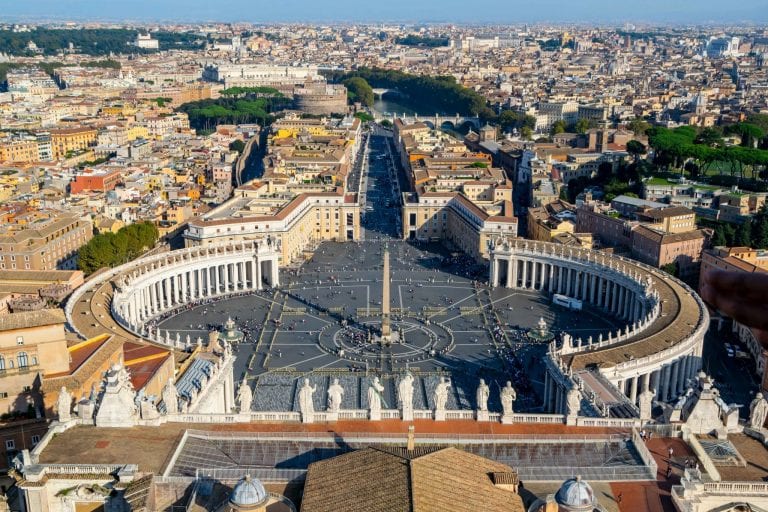

The Ultimate 4 Days in Rome Itinerary (+ Map & Tips!)
Dreaming of staring in awe at the Sistine Chapel, stepping inside the Colosseum, tossing a coin into the Trevi Fountain, and eating some of the best pasta of your life? If so–this 4 day Rome itinerary is for you!
The capital of Italy is an endlessly enchanting place, and one of our favorite cities in the world–and after spending 4 days in Rome, we think you’ll agree.
Home to incredible art, one of the most beloved cuisines on the planet, an endless number of neighborhoods to explore, and impressive history that has been folded into the very fabric of modern Rome–not to mention the fact that there’s literally another country nestled inside the city–it’s impossible to avoid finding something to love about Rome.
… That is, as long as you know where to look.
After many repeated trips to Rome (including 2 trips where we rented an apartment in Rome for an entire month), we have lots of advice to share–and luckily, a 4 day trip to Rome gives you quite a bit of time to work with!
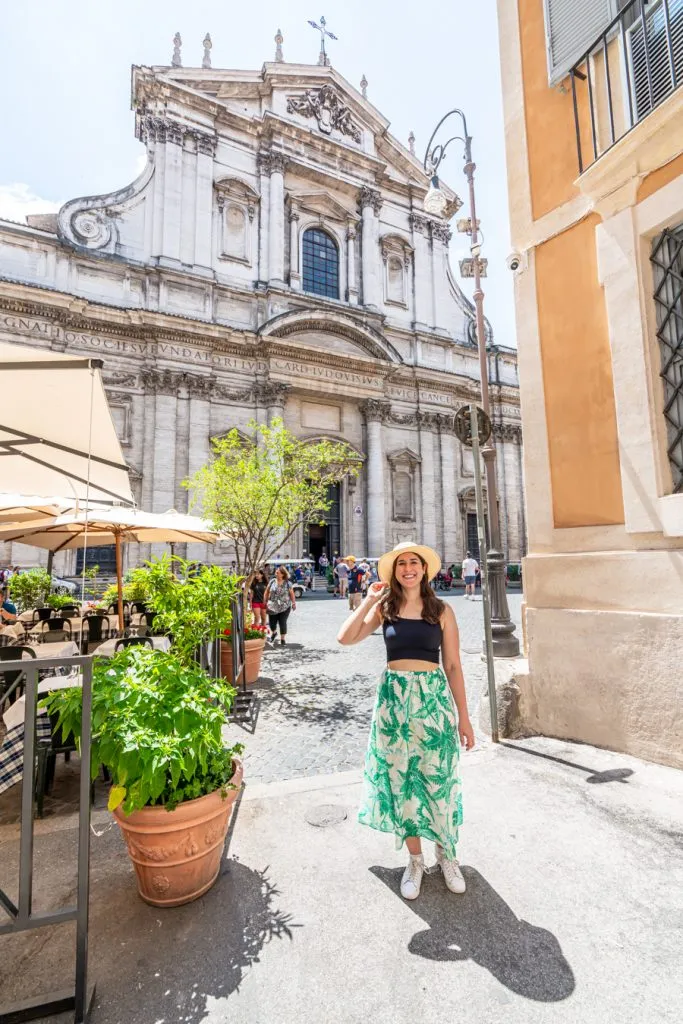
Some links in this post may be affiliate links. If you make a purchase through one of these links, we may earn a small commission at no extra cost to you. Please see our disclosure policy for more detail.
You’ll have the opportunity to see Rome’s iconic highlights and also weave in some more offbeat experiences, including some interesting under-the-radar spots that hide in plain sight.
This 4 day Rome itinerary winds its way through several neighborhoods and historical time periods, focusing on 1-2 geographic areas each day.
We’ve designed this itinerary for Rome in 4 days with a traveler taking their first trip to Rome in mind, but we hope even return visitors will find something new to love here!
(Also, thanks in part to the fact that I can’t always resist the temptation to point out nearby hidden gems and unique details, this is a very long Rome blog post! Feel free to use the table of contents below to navigate to the section you’re looking for.)
Table of Contents
How We Structured This Rome Itinerary
The perfect 4 day rome itinerary, where to stay for 4 days in rome, more than 4 days in rome.
- Getting Around During 4 Days in Rome, Italy
Safety Tips for Your Rome Itinerary
The best time to visit rome, what to pack for visiting rome, italy, map of your itinerary for rome, italy.
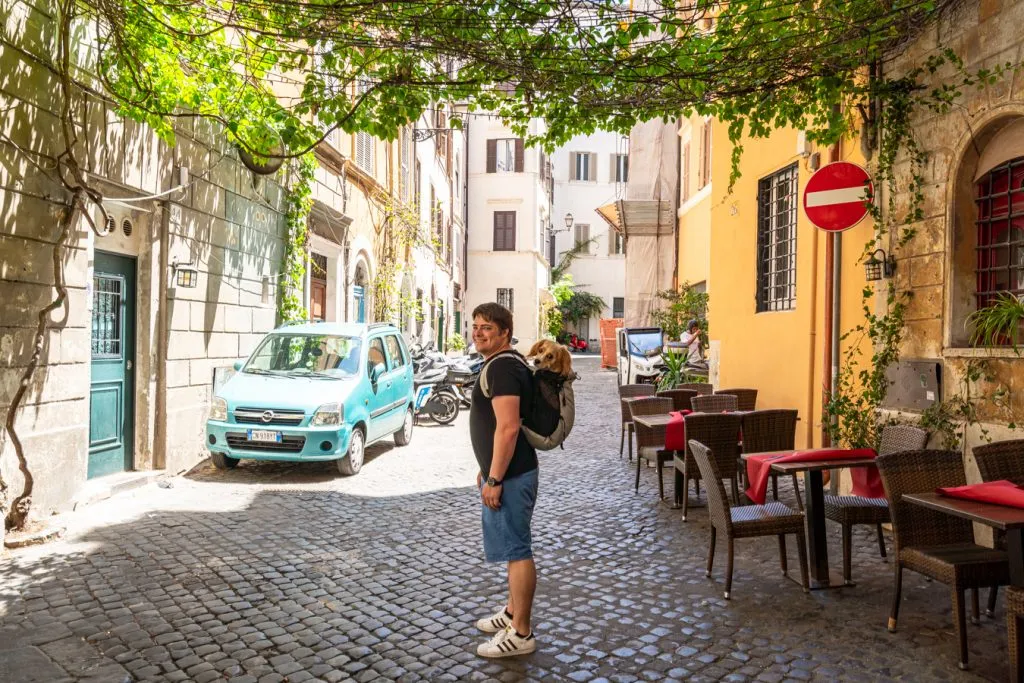
We’ve spent months playing tourist in Rome over the course of many, many trips–including twice where we stayed in town for a month straight!
We initially crafted this Rome itinerary after our first month-long stay in the city, and since then it has (like most of the other itineraries on Our Escape Clause ) been a living document, updated with each return visit to our favorite city.
From the best things to do in Rome to what attractions to skip, we’ve packed this travel guide with everything that we know about planning the perfect trip to Rome.
This itinerary is designed for first-time visitors to The Eternal City who are hoping to hit all the top attractions but also hope to see some of Rome’s many hidden gems too.
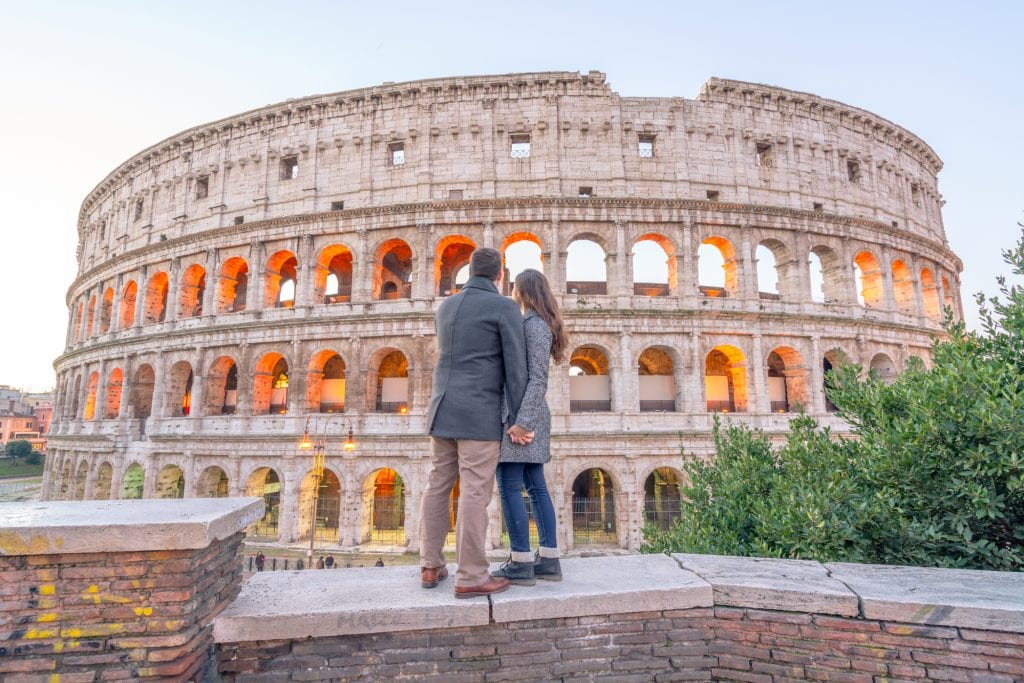
We’ve also included a downloadable map of each day’s route at the bottom of this blog post to help you navigate the city as you explore.
While 4 days in Rome is long enough that you could very reasonably take one day to enjoy one of the best day trips from Rome , there is simply no limit to the number of captivating things you can find within the city itself, and we’ve planned this itinerary with that in mind.
Once you finish this post, you may also want to check out our posts on what to eat in Rome , where to find the best views of Rome , and our top Rome travel tips !
If you’re interested in shorter Rome itineraries, we have 2-day and 1-day versions here on Our Escape Clause as well.
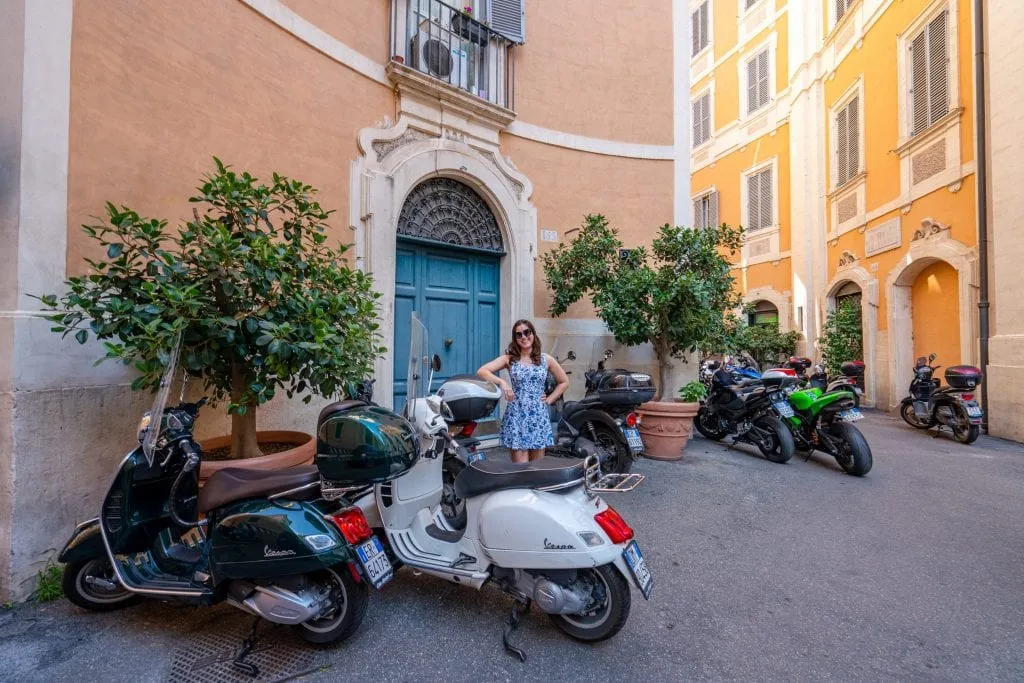
Day 1 in Rome: The Colosseum, Roman Forum, The Jewish Ghetto + Beyond
Start your trip to rome at the colosseum..
What better place to start your 4 days in Rome itinerary than at one of the most iconic sights in the world?
Step inside the Colosseum and marvel at the ancient history beating inside–but before you do, be sure to climb the steps on the north side of the Colosseum (turn left after exiting the Colosseo metro stop) and get those classic photos in front of the Colosseum’s exterior.
Before starting your day at the Colosseum, you’ll want to book tickets ahead of time to skip the (legendary) line.
With 4 days in Rome to work with, you may be willing to wait in what are often very long lines, but if you hate lines as much as we do, you’ll consider the small extra cost well worth it.
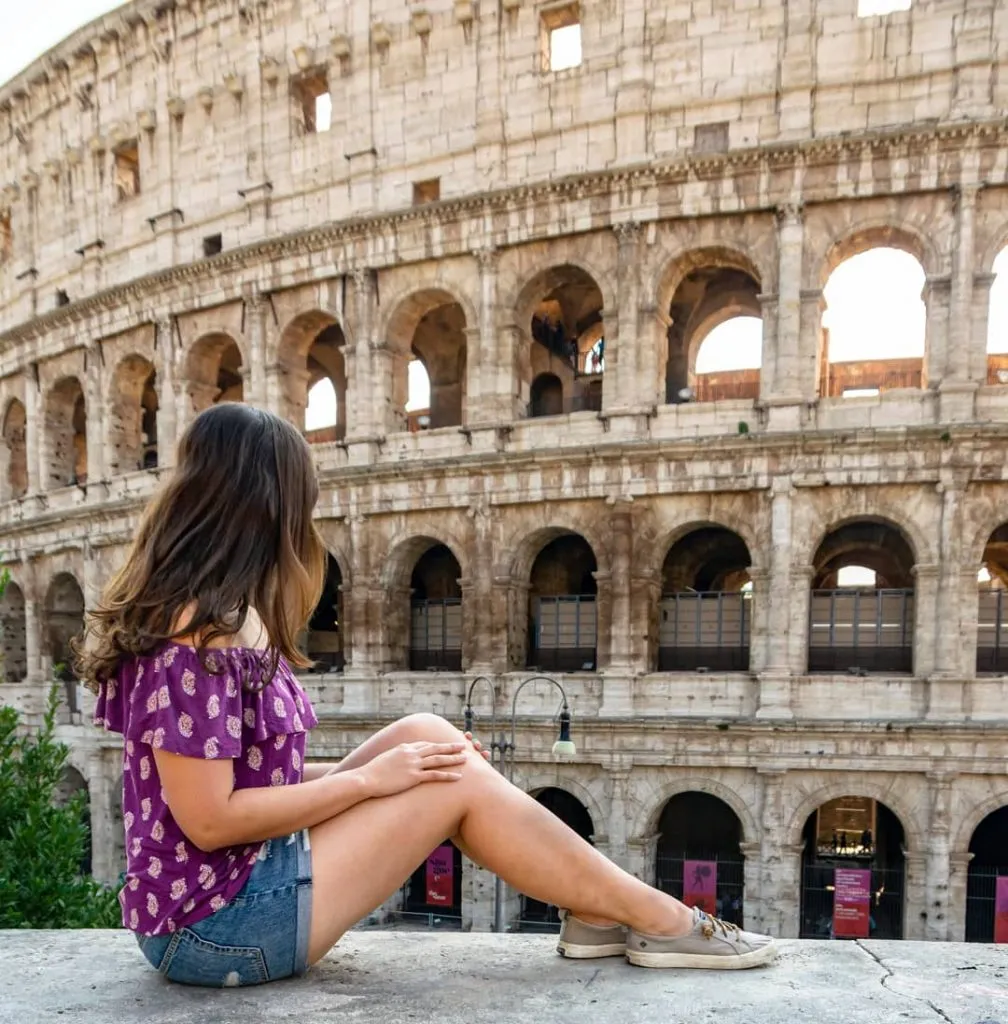
Trying to decide whether or not to take a guided tour?
Guided tours are typically sold as a package that includes the Colosseum, Roman Forum, and Palatine Hill.
Our personal take is that the tour of the Colosseum isn’t as necessary… but it’s absolutely worth it to have a guide for the Roman Forum and Palatine Hill, and therefore recommend signing up.
This is the tour we took and greatly enjoyed (though fair warning, our guide’s passion meant that the tour did run past its predicted time).
And, while we didn’t structure this itinerary for Rome this way, I do want to mention that we have also toured the Colosseum at night and loved it–if that’s something that appeals to you, you can easily adjust this itinerary to accommodate it ( this is the tour we loved ).
Book your tour of the Colosseum, Roman Forum, and Palatine Hill today! Prefer to explore independently? Grab your skip-the-line ticket now!
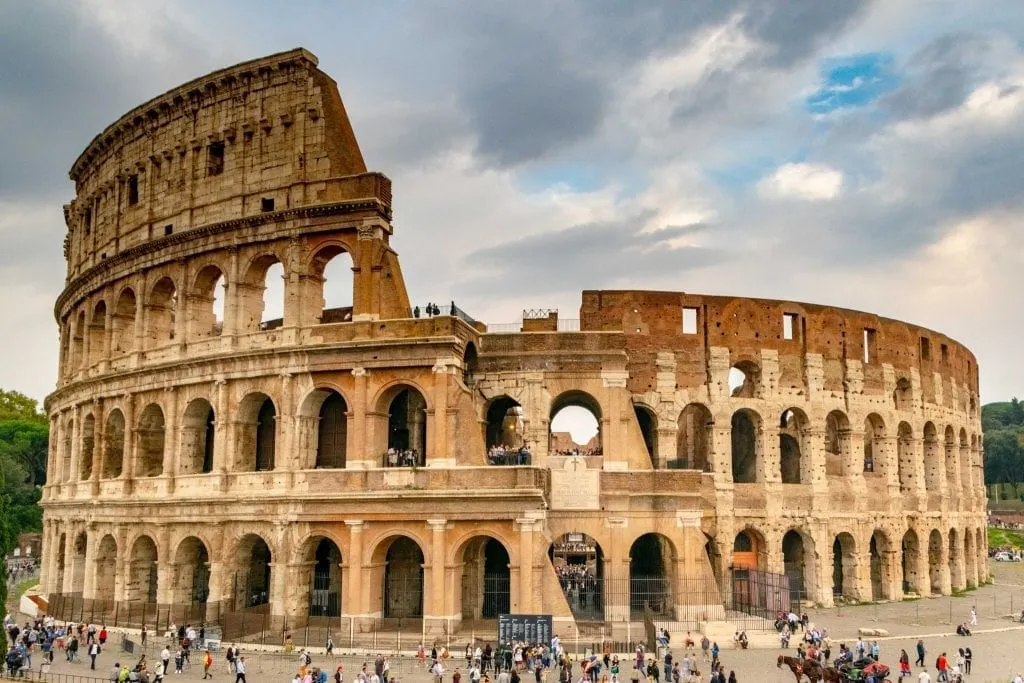
Head to the Roman Forum and Palatine Hill.
Less than a 5-minute walk from the Colosseum, depending on the entrance and exit used.
While the Colosseum is one impressive monument of Ancient Rome, the Roman Forum and Palatine Hill boast several!
From senate houses to public squares to palaces, these areas are archaeological and historical treasure troves.
They are absolutely best appreciated with a guide–I can’t even describe how much more we got out of our guided visit than our unguided ones, especially on the lower level of the Forum!
If all goes well, you should walk away in awe of both the depth and breadth of history in the Eternal City.
After touring the Roman Forum and Palatine Hill both with a guide and without, we strongly believe that the context given by a guide is well worth the price. We used and loved this tour –and while the Colosseum guide was less necessary, having the Colosseum skip-the-line portion and tour included definitely helped justify the cost! Book your guided tour of the Roman Forum and Palatine Hill today!
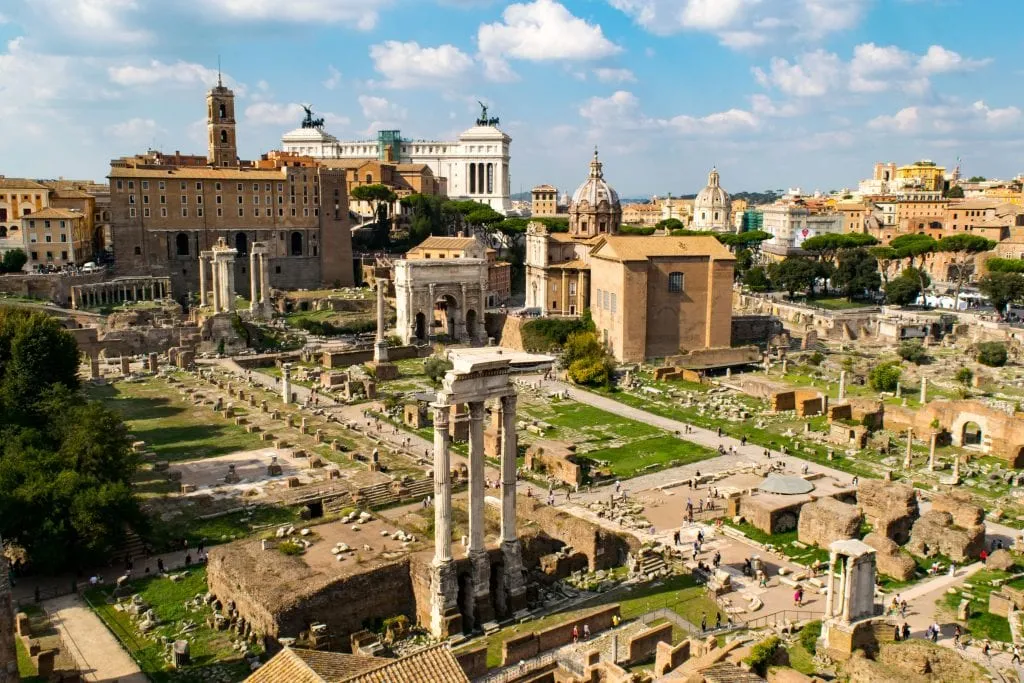
Check out the additional forums.
About a 10-minute walk from the Roman Forum, depending on the entrance and exit used.
Though the Roman Forum is the most popular to visit, it’s far from the only remaining forum of Ancient Rome visible in the city today.
The Imperial Forum, Forum of Augustus, Forum of Caesar, and more are all just a short walk away from the famous Roman Forum.
And, unlike the Roman Forum, all of the other ancient forums are free to enter.
Though visiting all the forums is probably a little much for all but a passionate Ancient Roman historian, be sure to at least slow down look enough to take a peek at one or two during your 4 days in Rome!
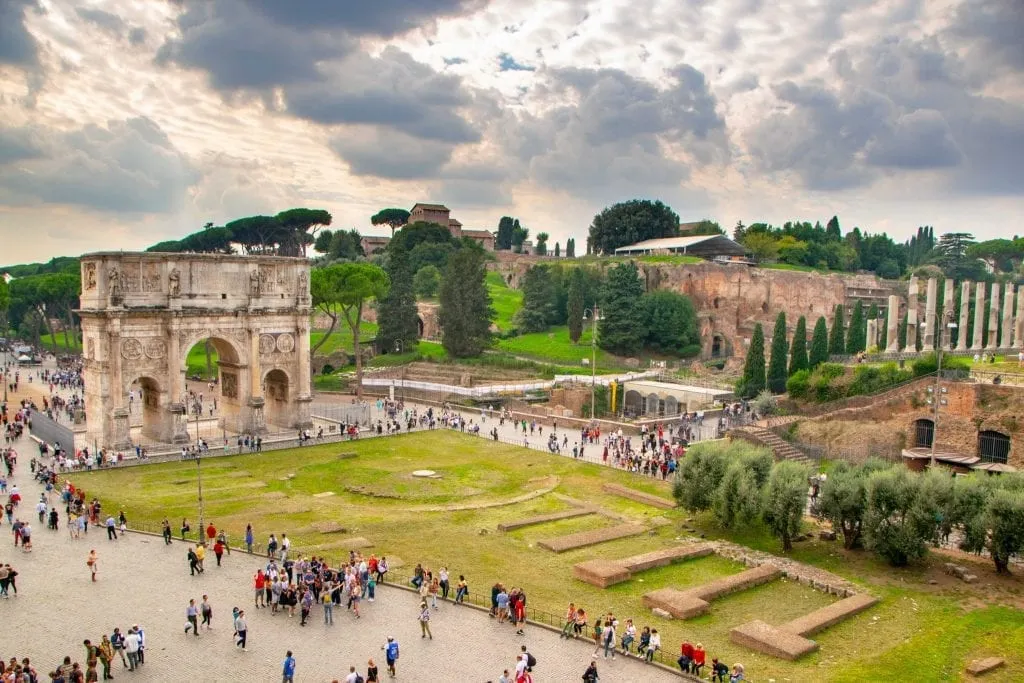
Stop by Piazza Venezia and Piazza del Campidoglio.
10-minute walk from the Forum of Augustus.
The Piazza del Campidoglio is one of my personal favorite piazzas in Rome .
Shaped into a perfect oval and surrounded by beautiful buildings, it is a peaceful place to relax for a moment and take in the fact that you’re in Rome.
If you stop by on a Saturday as we did during one of our trips to Rome, you’ll likely also have the chance to admire lots and lots of wedding parties!
The piazza’s beauty isn’t particularly surprising when you know who designed it: Michelangelo himself.
While we haven’t specifically included them on this 4 day Rome itinerary (sadly there’s not time for everything!), it’s worth pointing out that this is also where you’ll find the main section of the Capitoline Museums , which have an incredibly impressive collection of Ancient Roman statues, among other things.
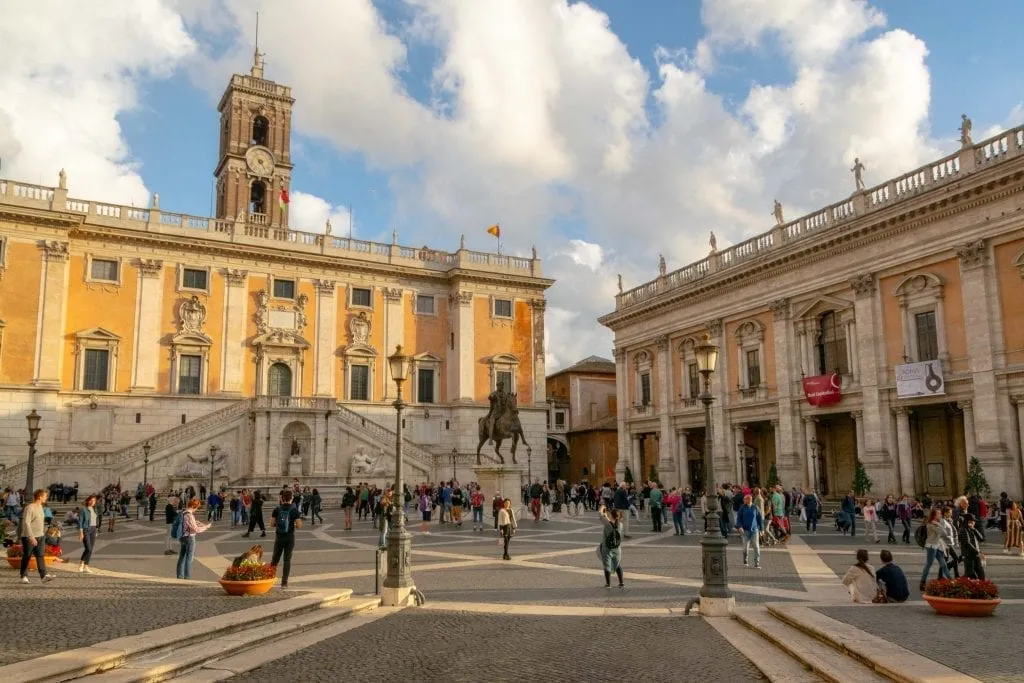
If you tend to prefer quieter museums, you can consider adding a visit here!
(In any other city, they’d be packed–but the Capitoline Museums have some legendary competition when it comes to museums in Rome to visit).
On your way to the Piazza del Campidoglio, you’ll also pass right by the Piazza Venezia, with the impressive Altar of the Fatherland (the enormous white building topped with chariots that is visible from just about every viewpoint in Rome) dwarfing everything around it.
Since you were just on Palatine Hill, climbing it isn’t necessary–but it is home to one of the best views of Rome if you’d like to see it for yourself!
The monument was built in honor of Victor Emmanuel II, the first king of unified Italy.
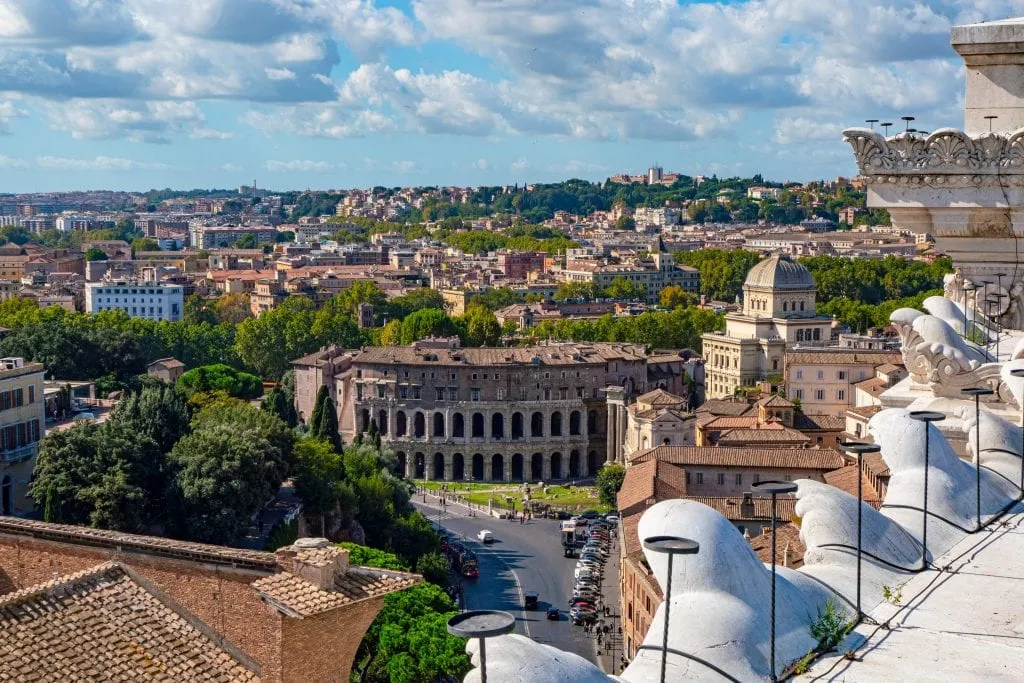
Pay a visit to the Campo de’Fiori.
14-minute walk from the Piazza del Campidoglio.
This market square may be touristy, but it’s also beautiful, bustling, and worth stopping by during your 4 days in Rome.
Markets are some of our favorite aspects of any city trip, and Rome is among the best of the best.
Of course, if you choose to purchase any Rome souvenirs or a meal at the market, you will pay a slight upcharge.
I f you’re particularly hungry, we did have tasty, if somewhat overpriced, pasta carbonara at (where else?) La Carbonara on the edge of the Campo de’Fiori.
If you’re looking for something more local, Da Sergio is just around the corner and a great option, but get there when they open, because it fills up ( Address: Vicolo delle Grotte, 27, 00186 Roma RM, Italy ).
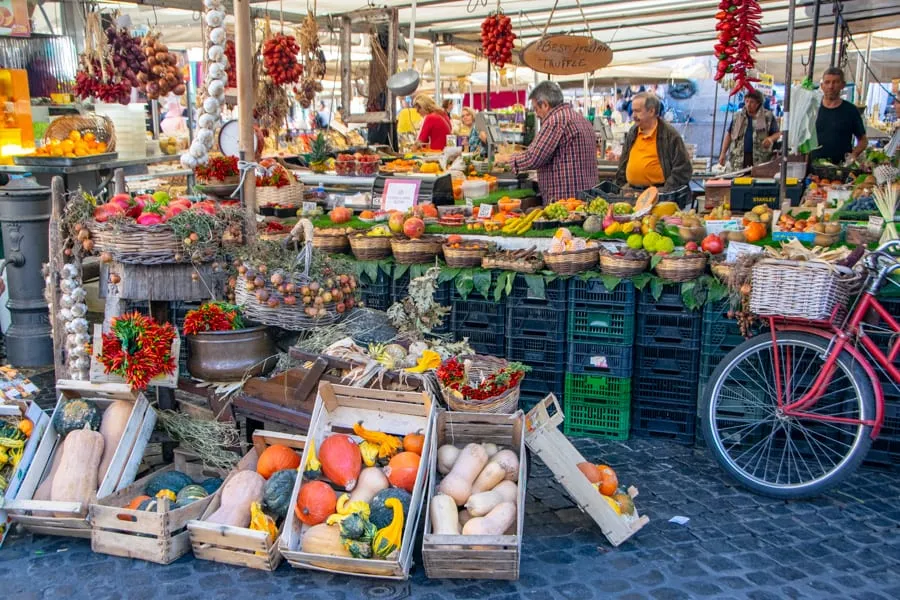
Visit the Largo di Torre Argentina.
7-minute walk from the Campo de’Fiori.
This set of ruins is home to two points of interest that are wildly different from each other: the place where Julius Caesar was assasinated, and a cat sanctuary.
The ruins are open-air, laid out in the center of the square, and are made up of the remains of several temples as well as part of Pompey’s Curia–the Roman Senate–where Julius Caesar perished just under 2,000 years ago.
As if that wasn’t enough of a reason to stop by during your 4 days in Rome, the archaeological site doubles as a cat sanctuary!
There’s an organization onsite that works to feed and care for them, and I can only imagine that they have a delightful life living in what is essentially the world’s most elaborate set of cat trees!
I’m sure it will come as no surprise to cat lovers that we’ve seen more than one cat perched on top of the remains of surprisingly tall columns.
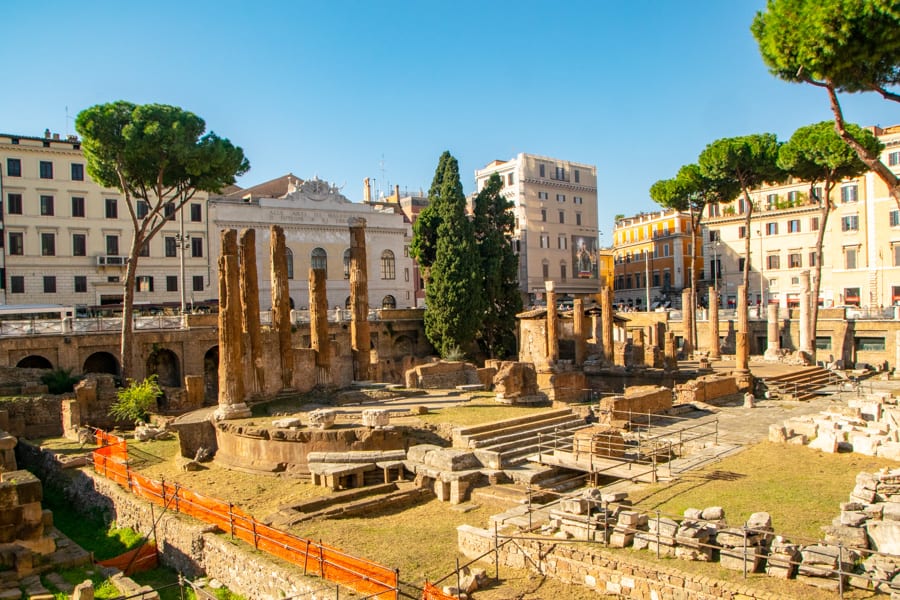
Explore the Jewish Ghetto.
About a 25-minute walk through the neighborhood, depending on how directly you travel.
Rome’s historic Jewish neighborhood is an incredibly peaceful place to get lost down the back streets.
Nestled against the Tiber, some of the smaller streets of the Jewish Quarter are quiet enough to almost forget that you’re within walking distance of the crowded madness of the Colosseum.
While you’re here, be sure to marvel at the exterior of the Great Synagogue, check out the Teatro Marcello (it looks a bit like a smaller Colosseum!), stop by the lovely Porticus of Octavia, and visit the charming Piazza Mattei with its adorable Turtle Fountain.
If you’re a fan of classic movies, channel your inner Audrey Hepburn with a visit to the Mouth of Truth (but fair warning, whether or not it’s worth visiting is a bit of a debate–all the better reason to find out for yourself, if you ask us!
And, of course, be sure to sample the fried artichokes that are synonymous with food in the Jewish Ghetto of Rome–even if you’re not a big vegetable fan, these are worth trying!
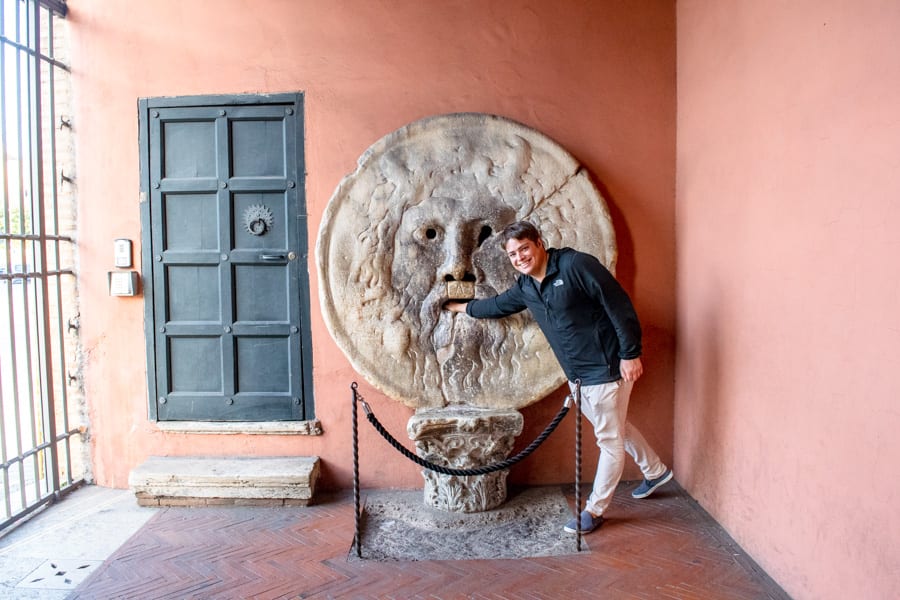
Hop over the Tiber River for a Trastevere food tour.
Trastevere is one of Rome’s most picturesque and beloved neighborhoods–and while this won’t be your last visit during your quest to see Rome in 4 days, it’s a good opportunity for a first (literal) taste.
We’re big fans of opening trips with food tours–off the top of my head, we’ve taken at least 6 in Italy alone–as they are not only a wonderful way to get to know a city, they also help you gain a lot of confidence with ordering local food!
We loved this food tour in Trastevere and can confirm that after taking it, you will walk away with a solid base knowledge for ordering food throughout the rest of your trip to Rome… and be extremely full.
From wine to cheese to Rome’s classic pastas to contorni (sides) to obligatory (incredible) gelato, every bite is a delight.
Book your Trastevere food tour today!
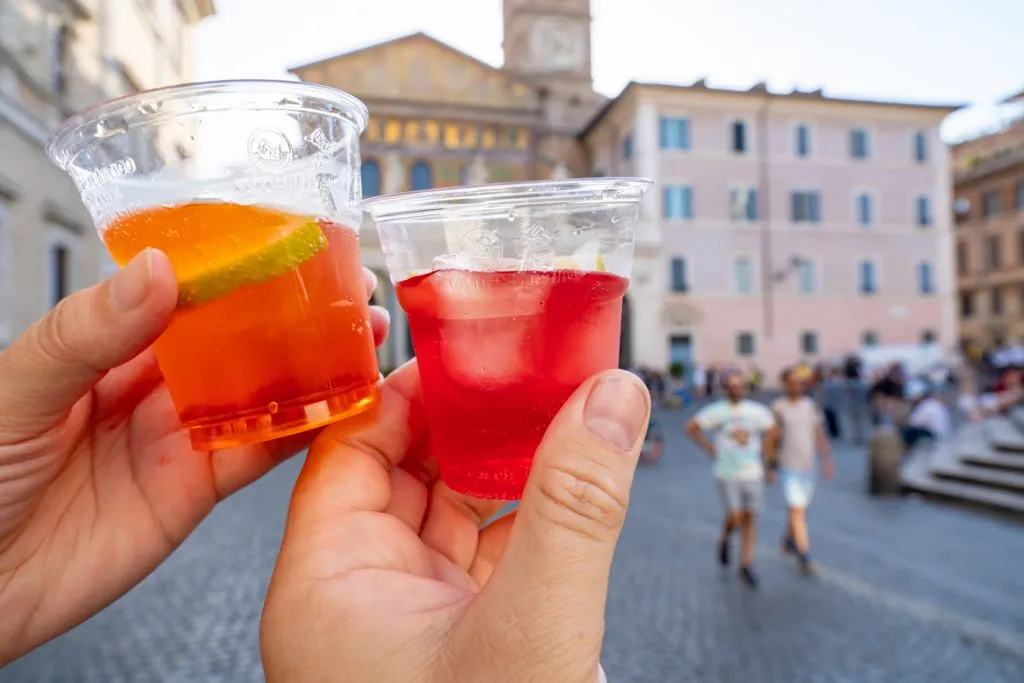
Day 2 in Rome: Centro Storico + Classic Rome Attractions
Start at the piazza del popolo..
The Piazza del Popolo is another one of my personal favorite piazzas in Rome, and is a great way to kick off the second day of your Rome itinerary!
You’ve probably heard the phrase that “all roads lead to Rome”–and specifically, they all led to Piazza del Popolo, which was once a traditional entrance point to the city.
Today, you’ll find the piazza filled with visitors, street performers, and of course, an obelisk.
The “twin churches” of Santa Maria in Montesanto and Santa Maria dei Miracoli that stand at one end of the piazza are beautiful, of course–but it’s the comparatively plain exterior of the Basilica of Santa Maria del Popolo on the other side of the piazza that art lovers should keep an eye out for, because it’s home to 2 Caravaggio paintings.
After exploring the Piazza del Popolo, be sure to climb up to Pincio Terrace for some beautiful views over the piazza and Rome itself !
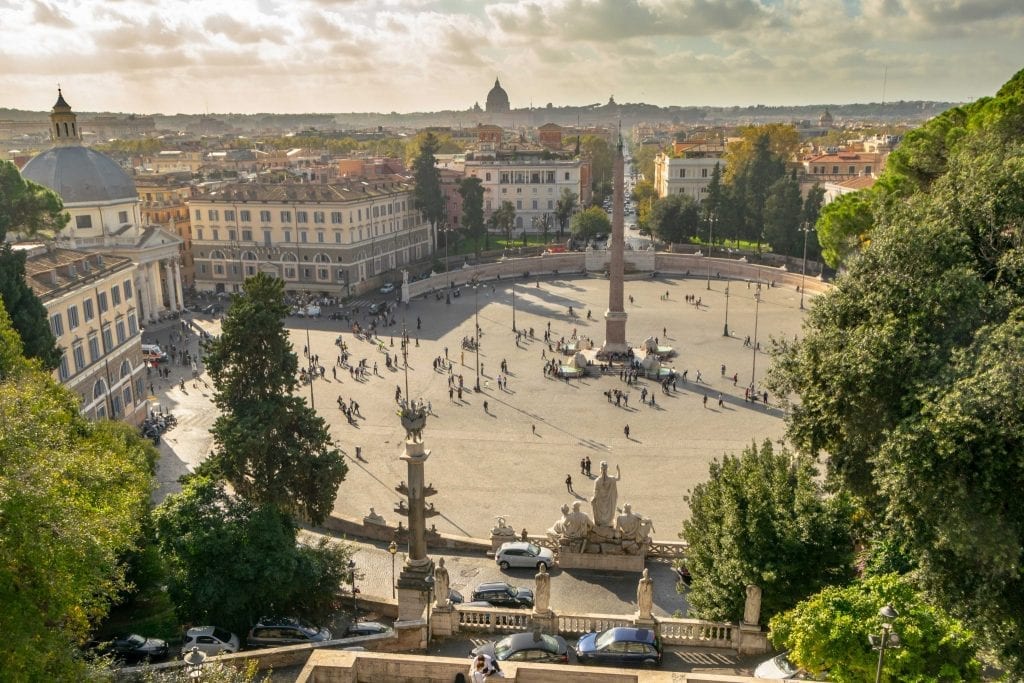
Tour the Galleria Borghese.
20-minute walk from Pincio Terrace.
A beautiful stroll from Pincio Terrace through the Borghese Gardens will lead you right to the Galleria Borghese and arguably one of the most impressive–though not one of the largest–art collections in Italy!
(The good news about it being a smaller museum, of course, is that it’s easier to squeeze into your vacation in Rome).
Housed in a former palace, the Galleria Borghese is absolutely stunning and worth a visit during your 4 days in Rome, especially for art lovers.
It is required to purchase tickets in advance to visit the collection, though, and tickets do book up.
I f you have your heart set on visiting the Galleria Borghese, be sure to get tickets ahead of time!
Reserve your tickets for the Galleria Borghese today! Prefer the context of a tour? This one gets rave reviews!
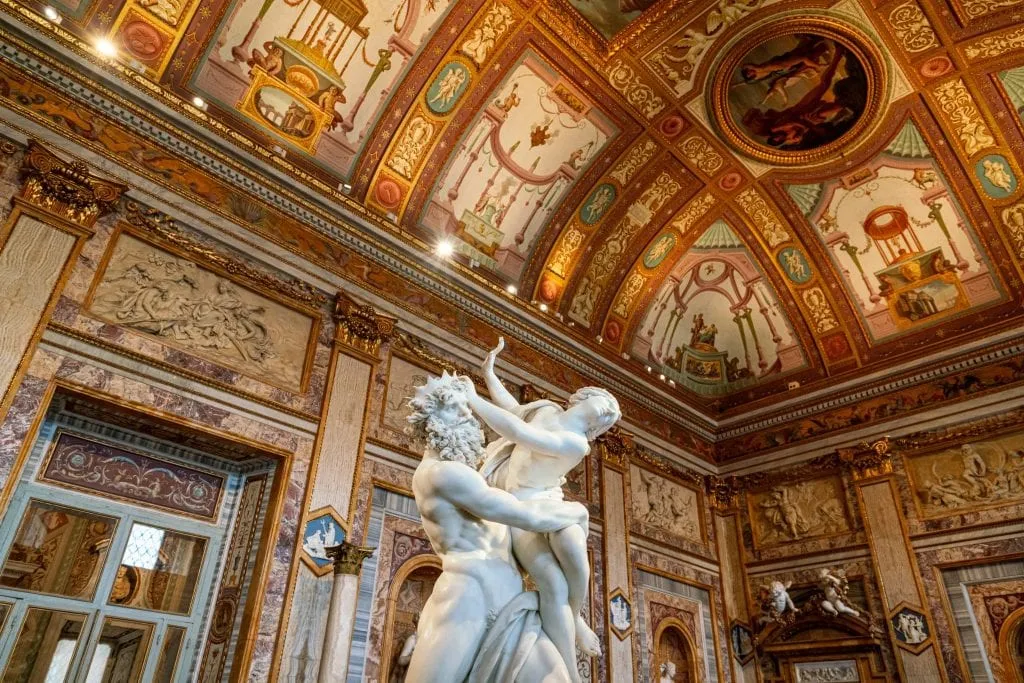
Optional: pay a visit to the Capuchin Crypt.
9-minute walk from the Spanish Steps.
I’ll be honest: this stop on our suggested 4 day Rome itinerary isn’t for everyone, but it is absolutely fascinating and I can’t resist pointing it out.
In the 17th century, the Capuchin Crypt was slowly built with the skeletons of the friars that died at this monastery.
Skeletons are arranged as works of art in several small chapels here, and including everything from full skeletons in the robes of a monk resting on a bed of bones, to chandeliers made of small human bones.
The chapels bear unsettling messages like: “As you are, we once were. As we are, soon you will be.”
Clearly, not a place for small children or those not comfortable around the dead–but the level of detail of the… art (for lack of a better word) is a sight to behold.
This is one of the least toured crypts in Rome (and of course, it’s technically an ossuary), but it is conveniently located to work in a stop during your 4 days in Rome, and if it sounds like something that might interest you, it’s definitely worth the short walk!
(And if you also find this fascinating, it’s worth noting that it’s not the only place of its kind in Italy– Milan , Palermo , Monterosso al Mare in Cinque Terre , and more are home to religious places decorated with bones).
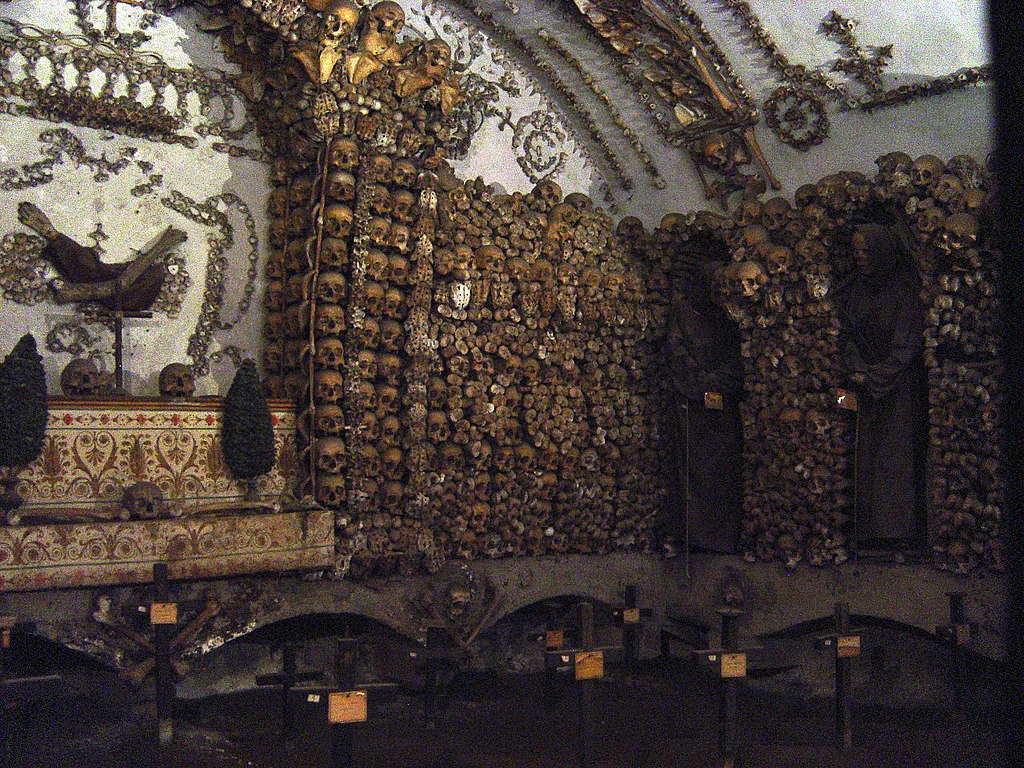
Stroll to the Spanish Steps.
21-minute walk from Galleria Borghese.
After a stop off at the Galleria Borghese and possibly the Capuchin Crypt, most of the second day of this 4 day Rome itinerary focuses on iconic Roman sights and popular tourist highlights, starting with the famed Spanish Steps.
The Spanish Steps, like many popular highlights in Rome, are almost always crowded, but there are options if you want to have them to yourself: we got up at dawn in February for the below photo!
Sadly, the tradition of sitting on the Spanish Steps was banned in 2019 (and as of December 2022, we can confirm it’s definitely still being enforced), but they’re still absolutely worth visiting during your 4 day Rome itinerary!
Depending on time, if you’re a fan of the Romantic poets, you may also want to tour the small Keats-Shelley Memorial House that overlooks the steps and functions as a museum of the Romantic poets (and also features great views of the steps and piazza).
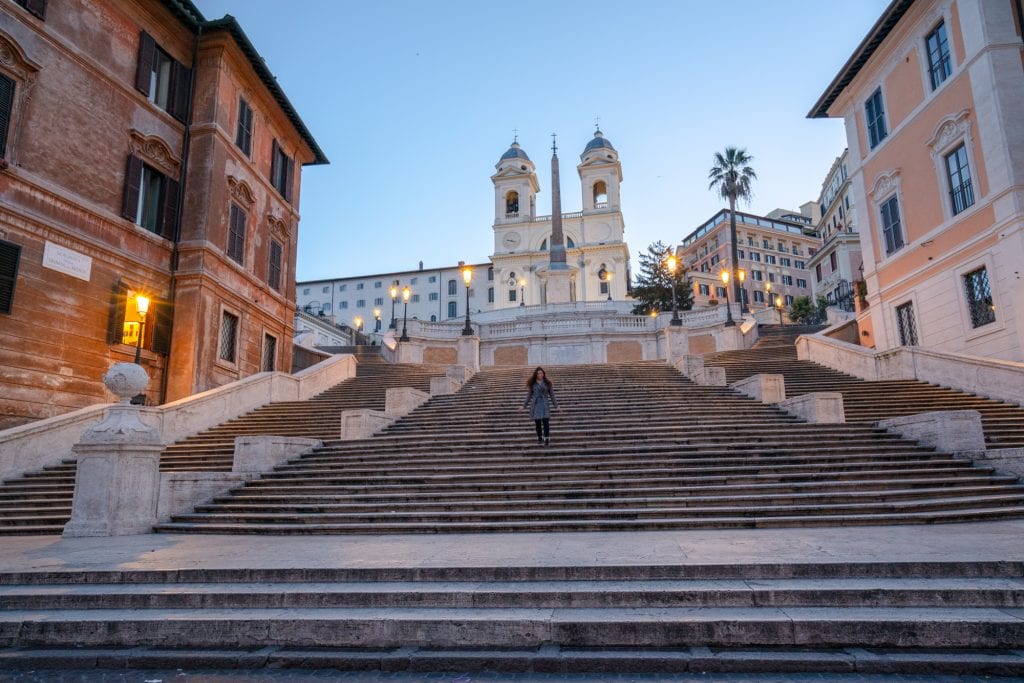
Throw a coin in the Trevi Fountain.
8-minute walk from the Spanish Steps.
What’s a Rome itinerary without a stop at the Trevi Fountain?
I’ll confess: on my first visit to Rome, I was more excited to see the Trevi Fountain than almost anything else, and it did not disappoint!
The fountain is truly magnificent, and after more than a dozen visits, I’m still in awe of how gorgeous it is (and also of just how many people can squeeze themselves around it, but hey, that’s just the reality of traveling to popular places in Rome).
Be sure to throw a coin in the fountain to ensure that you’ll always come back to Rome!
If you want to enjoy the view at bit but avoid (some of) the crowds, you can often grab a seat on the steps of the Church of Santi Vincenzo e Anastasio a Fontana di Trevi to relax for a minute.
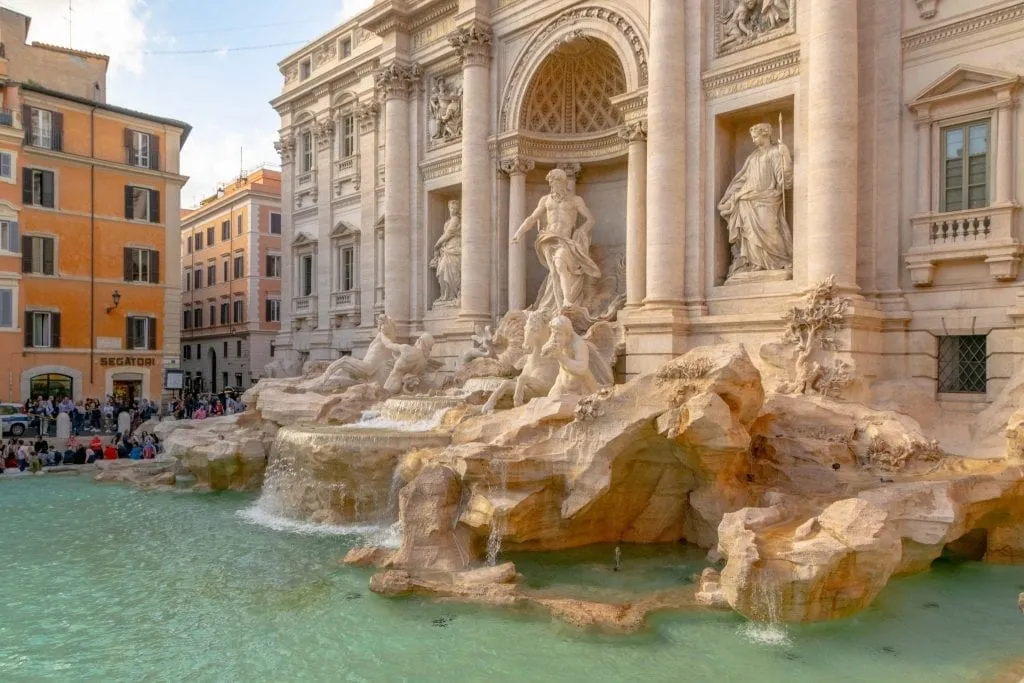
Stop by the Galleria Sciarra.
Located less than a 5-minute walk from the Trevi Fountain and yet almost never crowded, the Galleria Sciarra is an excellent way to escape the crowds of Rome’s popular tourist attractions and take a breather before continuing on to the Pantheon.
The Art Nouveau frescoes painted by Giuseppe Cellini in the late 19th century that adorn the walls are an excellent example of how beauty and exceptional artwork is truly around every corner in Rome.
The frescoes have a specific theme: women, or even more specifically, female virtues.
Feel free to take a moment to admire them for yourself–the courtyard will probably feel incredibly quiet and peaceful after the hectic crowds at the Trevi Fountain!
The building itself is used for offices today, so you can find the small courtyard open to visitors during standard business hours.
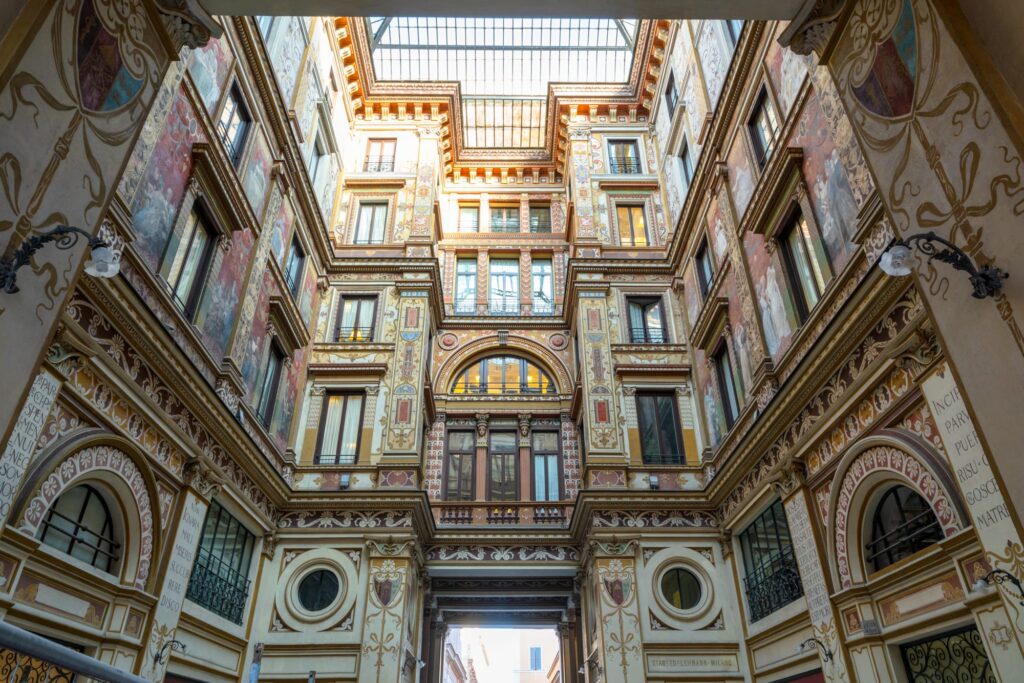
Step inside the Pantheon.
7-minute walk from the Trevi Fountain.
The Pantheon is nothing if not mysterious: its age, how it survived the Barbarian raids, and even what exactly it is made out of are all questions that remain unanswered.
Built originally as a temple to all gods and later turned into a church, the Pantheon is worthy of its status as one of the best-known sites of Ancient Rome left in the city.
No 4 day Rome itinerary would be complete without a chance to marvel at the Pantheon, so be sure to step inside and stare in awe!
While the Pantheon has traditionally been free to visit, the city of Rome introduced an entrance fee starting in 2023.
Today, base tickets for the Pantheon cost 5 Euro, purchased onsite or through this website .
Alternatively, you can purchase tickets to the Pantheon that include a downloadable audio guide .
Be sure to read the signs carefully when arriving at the Pantheon: there are separate lines for those who already have downloaded tickets and those planning to purchase one in-person.
Get your Pantheon tickets + audio guide now!
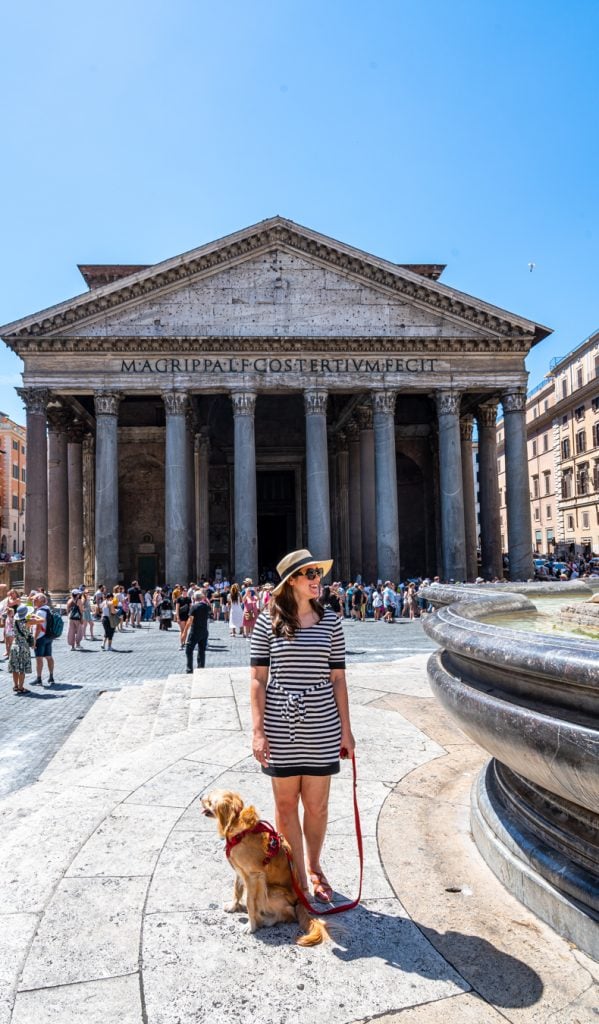
Check out the Piazza Navona.
5-minute walk from the Pantheon.
The beautiful, wide-open space known as the Piazza Navona has always been busy throughout Roman history.
It has served as a stadium, as a food market, and even as a spot for public water parties!
Today, it is known as one of the prettiest and most popular piazzas in Rome, boasting three ornate Baroque fountains that are perfect for perching on the edge of and watching the world go by.
It’s one of the most popular piazzas in Rome to visit, so expect crowds, especially near the baroque fountains–but it’s popular for a reason.
( Rome travel tip : want to escape the crowds for a second? Head around the corner to Piazza di Pasquino, see the talking statue, and grab a glass of wine from the expansive list at Enoteca Cul de Sac ).
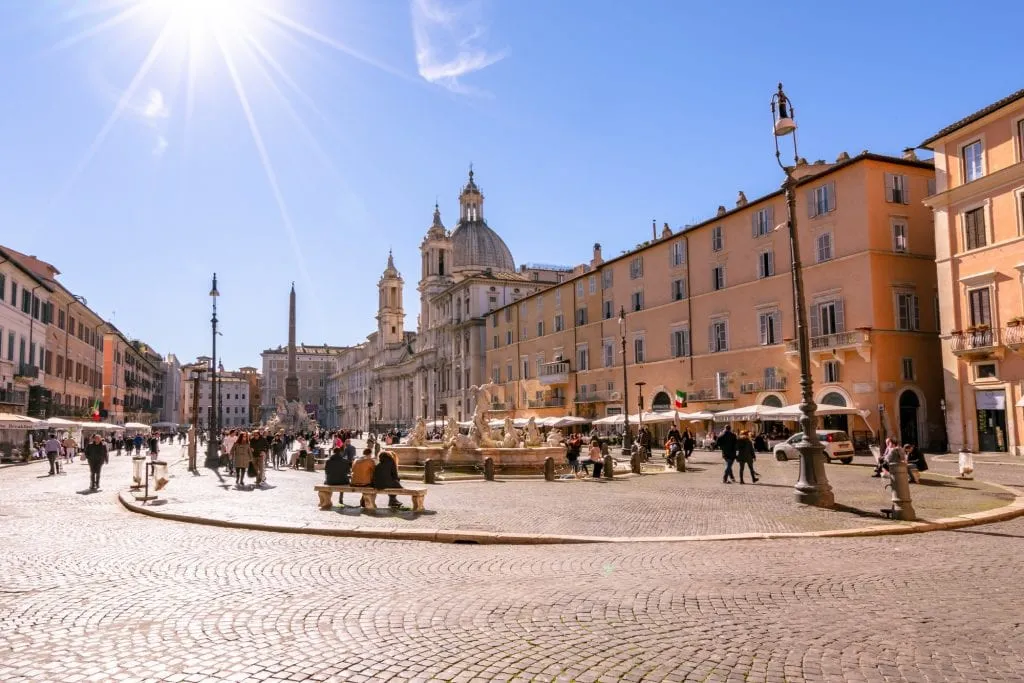
Head over to Castel Sant’Angelo.
11-minute walk from the Piazza Navona.
A walk from Piazza Navona to Castel Sant’Angelo will lead you through not only more of Centro Storico, but across the Bridge of Angels, one of the prettiest bridges in Rome, which dead-ends into the Castel Sant’Angelo.
Castel Sant’Angelo, despite its name, was never built to be a castle at all, but a mausoleum.
As the tomb of Emperor Hadrian and some of his family, Castel Sant’Angelo (in its original form, anyway), is an impressive nearly 2,000 years old–and it, whether or not you choose to go inside as part of your 4 days in Rome itinerary, is worth stopping by while in Rome.
(It also usually has genuinely impressive buskers out front–we usually stop to sit along the Tiber, enjoy the music, and admire the view at least a couple of times on every trip to Rome).
While you’re there, be sure to head to the nearby Ponte Umberto for a gorgeous view when you look back toward the Bridge of Angels and St. Peter’s Basilica.
If you time it right, this is a fantastic place to watch the sunset in Rome!
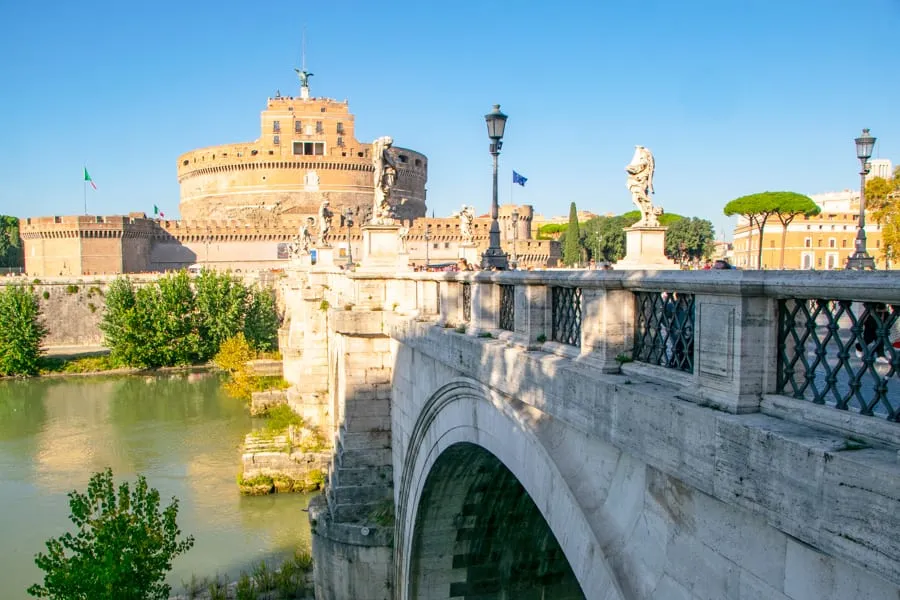
Day 3 in Rome: Explore Vatican City + Trastevere
Start your day bright and early at the vatican museums..
The Vatican Museums, with their magnificent art treasures, incredible map room, spectacular Sistine Chapel, and more, are an absolutely unmissable experience when planning to experience Rome in 4 days.
Plus, as a bonus, visiting means that you’ll actually be able to say you visited a whole other country!
Due to the severe crowds and ridiculously long lines, it is nearly essential to pre-book your visit to the Vatican Museums.
If you’d like to brave the odds on a rainy day in February, may the force be with you, but we once walked by the line to the museums nearly daily for a month as October bled into November, and the lines stayed at “Wow, okay, I’ll give that scalper whatever he wants to end this wait” levels.
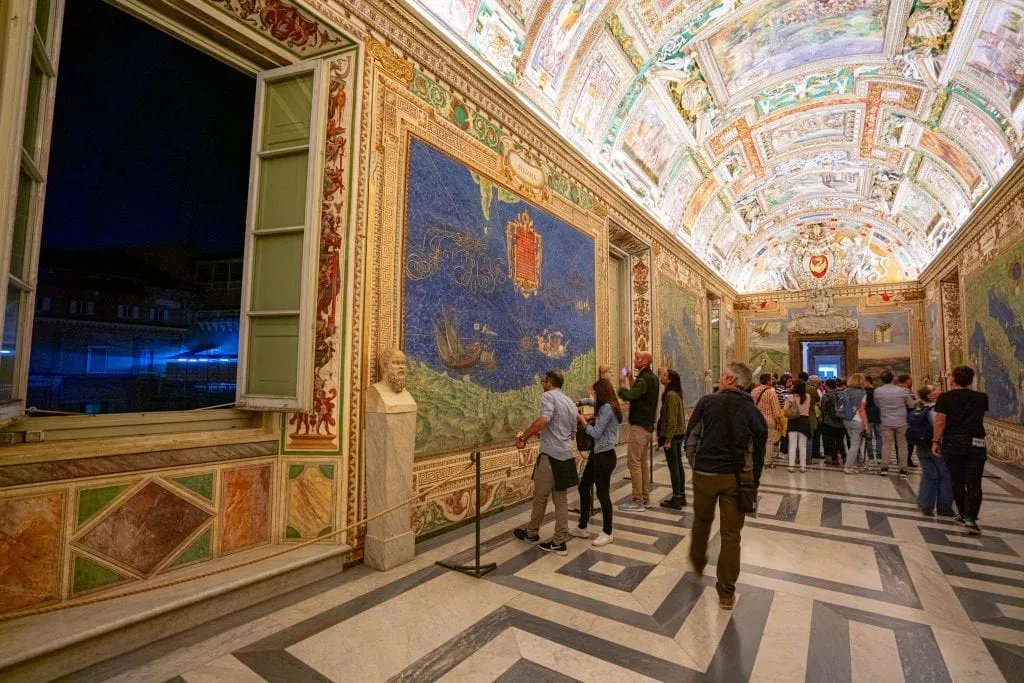
Definitely book ahead to help your 4 day Rome itinerary go more smoothly!
If you’re particularly interested in seeing the Sistine Chapel without a few hundred of your new closest friends, we’ve had friends of ours absolutely rave about the experience of the early access tour , where you can gain access to the museums and Sistine Chapel before they officially open for the day.
While it is a pricier option, word on the street is that if it’s in your budget, it’s 100% worth both the money and the effort spent getting out of bed early in the morning.
After personally touring the Vatican Museums both independently and with a guide, we’re personally of the opinion that a tour (especially one that takes place outside of peak hours) is enormously beneficial, and can highly recommend this one for an early-morning experience.
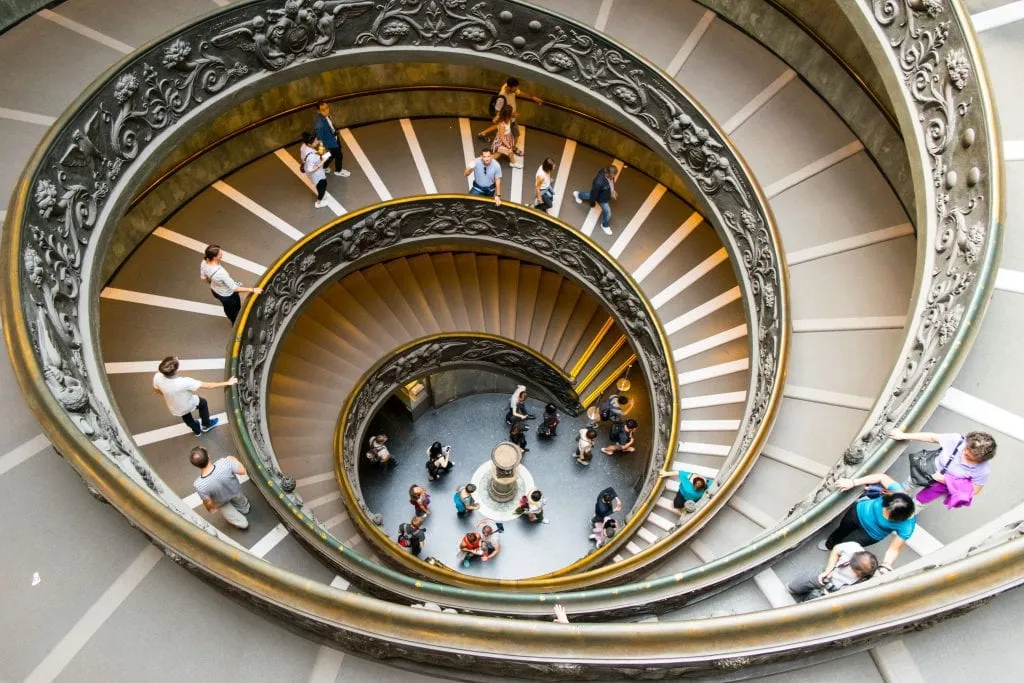
Also, bear in mind when planning your 4 days in Rome itinerary that the Vatican Museums are closed on Sundays, with the exception of the last Sunday of the month, when the museums are open and free to visitors who are able to enter before 12:30 PM (they then close at 2:00 PM).
From April to October each year, the Vatican Museums are also open on Friday nights, and we personally loved our Friday night tour .
Book your early morning or evening tour of the Vatican Museums today! Prefer to explore independently? Book skip-the-line tickets to the Vatican Museums and Sistine Chapel!
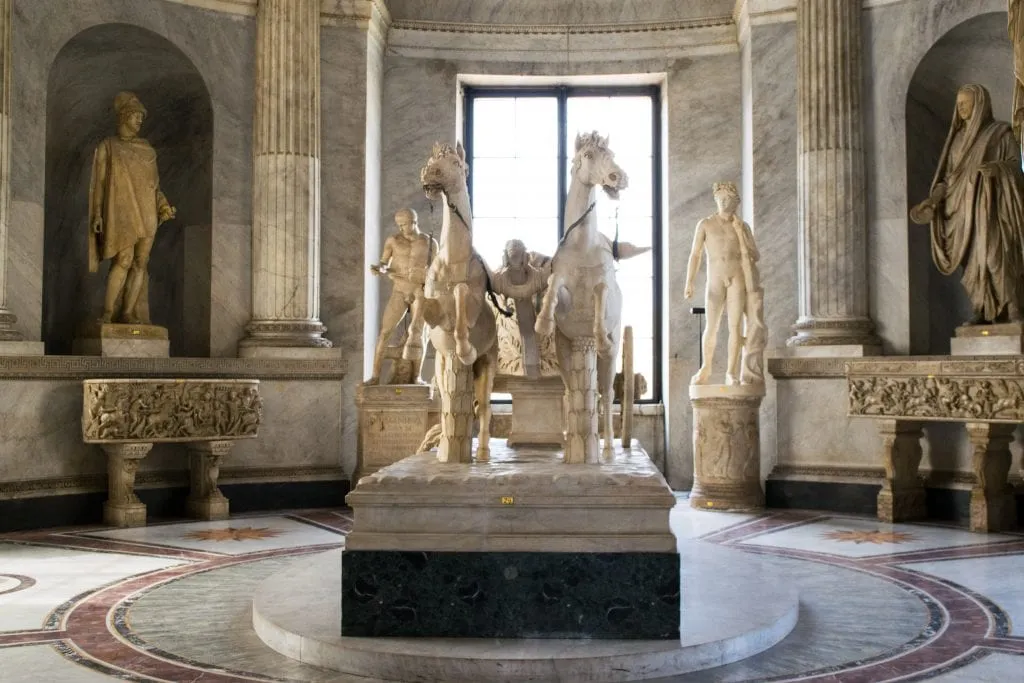
Step inside St. Peter’s Basilica.
11-minute walk from the Vatican Museums (depending on where you exit).
St. Peter’s Basilica is, hands down, the most impressive church we have seen in all of Italy (even if it technically isn’t in Italy at all).
Once you arrive out front, take a few minutes to admire the iconic oval Piazza del Pietro, and then hop in line to enter the basilica–and don’t worry, the line moves a lot faster than it looks.
The basilica itself is free to enter, but if your legs are up for it, we strongly recommend paying a bit extra to climb the dome (as long as you’re not particularly claustrophobic, that is).
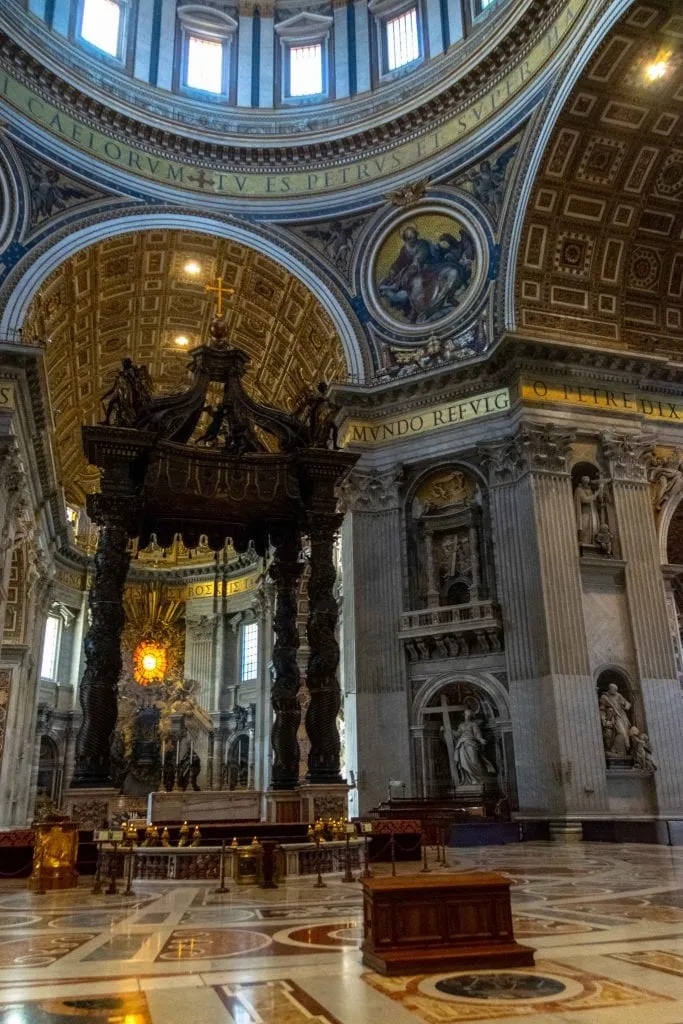
The views from the top, especially of the Piazza del Pietro, are fantastic (the first photo in this Rome blog post is of the view).
Once you get back down, head into the basilica itself.
Keep in mind that St. Peter’s Basilica does have a dress code that is enforced: cover your shoulders and knees, and avoid cleavage.
Push comes to shove, if you’re not dressed for the occasion, there are always plenty of salesmen hanging around the line to get into St. Peter’s that are more than willing to sell you a scarf to throw over your outfit.
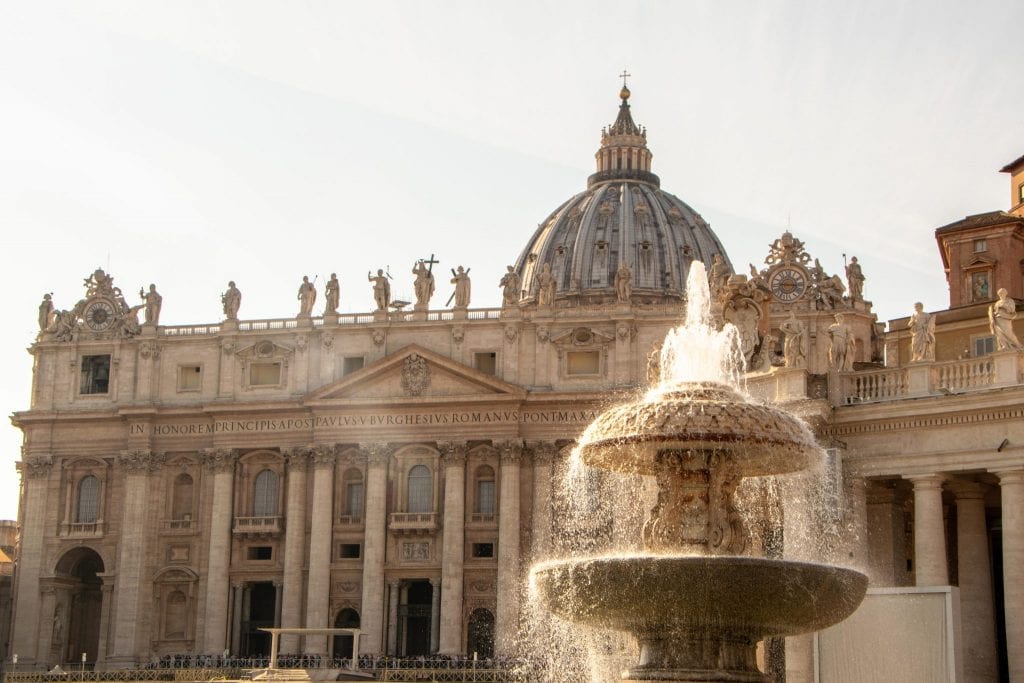
Stroll to the Villa Farnesina.
17-minute walk from St. Peter’s Basilica.
This fresco-covered Renaissance palace is a quiet, fresco-covered beauty, making it a distinct departure from the congested Vatican Museums from earlier in the morning.
Stop by to admire the artwork (Raphael’s frescoes are particularly celebrated), the loggia, and the ornate rooms of the palace.
If you’re “museumed-out” after a morning at the Vatican, you can easily skip the Villa Farnesina as well–but we love it for its much quieter atmosphere and a chance to escape the crowds.
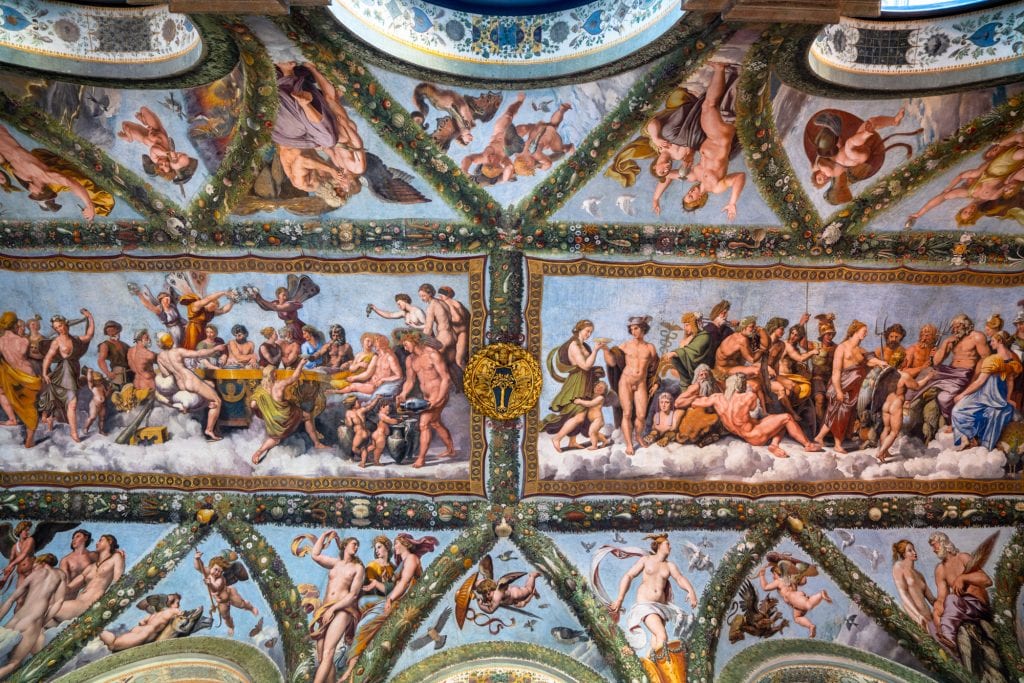
Explore Trastevere indepedently.
23-minute walk to Piazza di Santa Maria in Trastevere from Villa Farnesina.
You already had a taste during your food tour–with 4 days in Rome, once is not enough when it comes to enjoying Trastevere.
Trastevere is one of Rome’s most beautiful and–for lack of a better word–Roman-feeling neighborhoods.
This is where you’ll find some of the best examples of the iconic shuttered windows, colorful buildings, and narrow cobblestone streets that we all imagine when dreaming of visiting Rome, Italy.
Once considered an offbeat destination in Rome, the secret is out about Trastevere, and it’s a popular spot for visitors to grab a meal and wander.
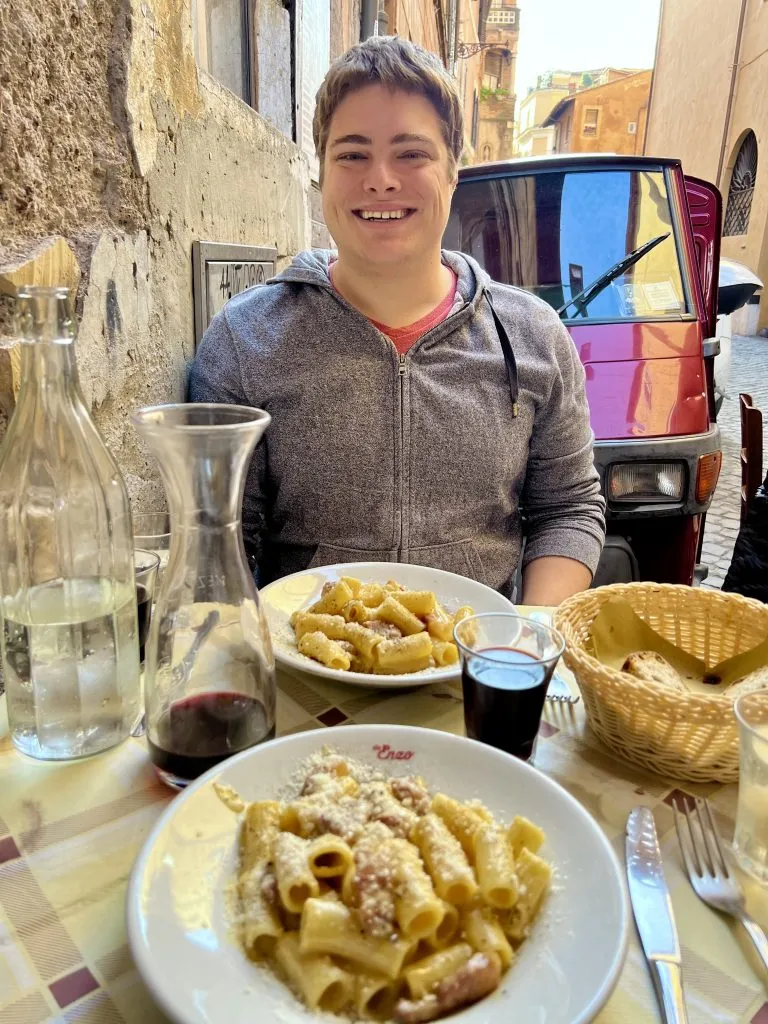
Though you’ll be far from the only visitors around, Trastevere is definitely still worth the stroll along the Tiber required to reach the neighborhood.
While you’re there, but sure to head to the Piazza di Santa Maria, which is an adorable piazza, and to duck inside the Basilica of Our Lady in Trastevere, which boasts some magnificent mosaics.
Trastevere is also a very popular place for aperitivo, so if you’re looking for that iconic spritz-on-an-outdoor-table-along-a-cobblestoned-street vibe, Trastevere is the place to be.

Ascend to the Janiculum Terrace.
15-minute walk from Piazza di Santa Maria in Trastevere.
It’s entirely possible that at this time in your Rome itinerary, your feet will be aching and the idea of climbing up to a viewpoint will sound completely terrible!
And, if that’s the case, no problem: find yourself a cute restaurant in Trastevere and start your evening aperitivo.
If you’re up for a bit more walking, however, head up to Janiculum Terrace (bear in mind that this does involve climbing a bit of a hill) for some incredible panoramic views of Rome, and perhaps even a beautiful sunset!
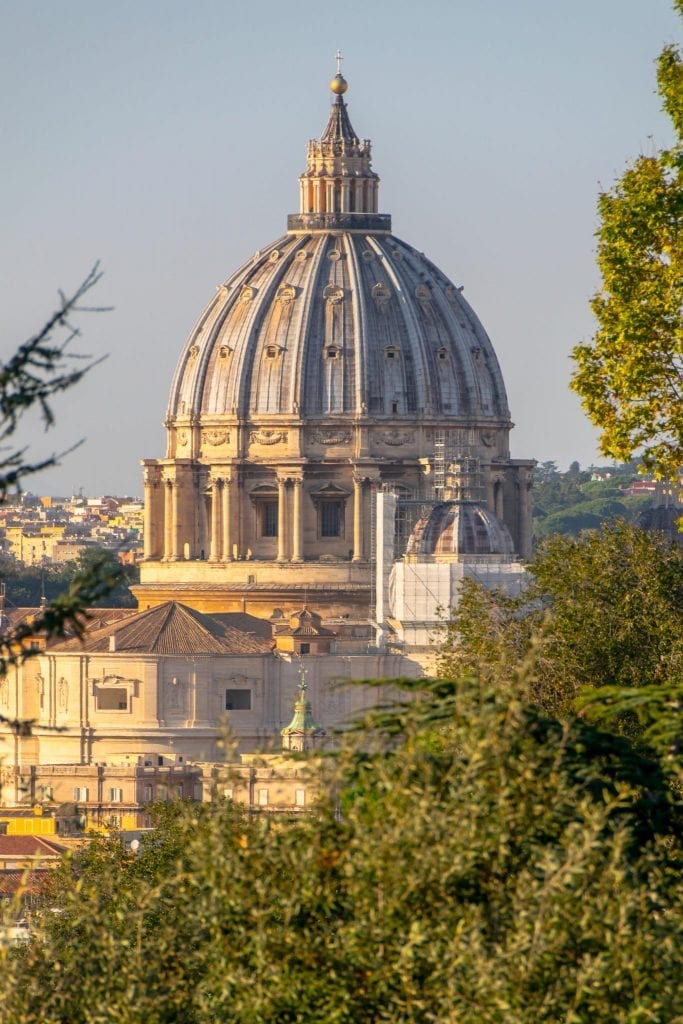
Day 4 in Rome: Testaccio , Aventine Hill + Some Hidden Gems
Start your day with a 2,000-year-old pyramid..
Pyramids aren’t exactly the first image that comes to mind when we think of Rome, but the impressive Pyramid of Caius Cestius has been standing proudly in Rome for 2,000 years!
Start the final day of your Rome itinerary by setting off to Testaccio to see both the Pyramid and several other unexpected attractions.
You’ll be able to catch your first glimpses of the pyramid after exiting the Piramide metro stop, but the best views are actually from inside the Non-Catholic Cemetery, so save most of your picture-taking for those spots!
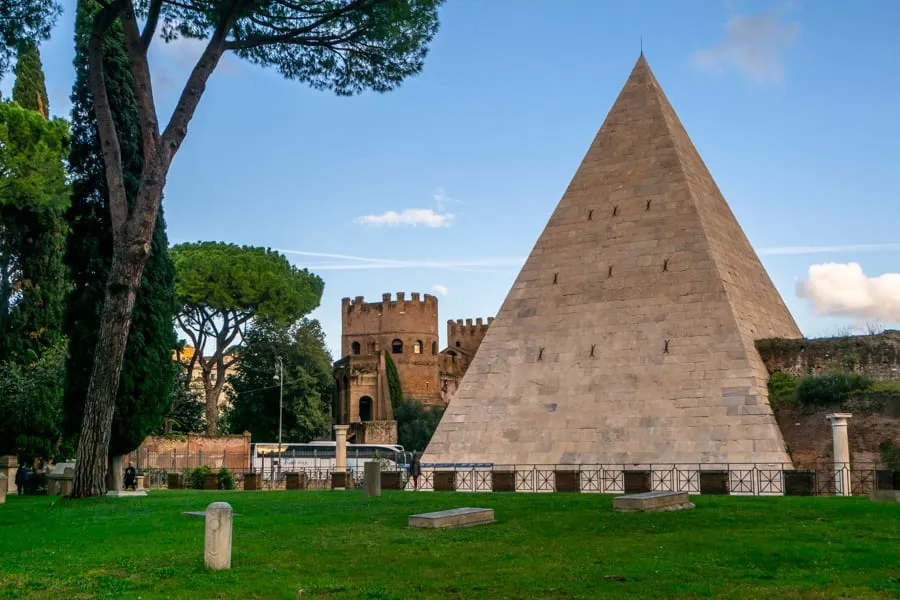
Visit the Non-Catholic Cemetery of Rome.
4-minute walk from the Pyramid of Cestius.
This beautiful cemetery is unique in the historically extremely Catholic city of Rome and houses some notable non-Catholics, including the poets Percy Shelley and John Keats.
It’s a lovely and peaceful place, and the views of the Pyramid of Cestius make an interesting contrast to the more recent headstones.
In addition to being the final resting place of plenty, the Non-Catholic Cemetery is also the home of some very lively cats!
Rome’s Non-Catholic Cemetery doubles as a cat sanctuary, and you’ll likely spot several beautiful felines resting amongst the headstones and prowling through the landscape.
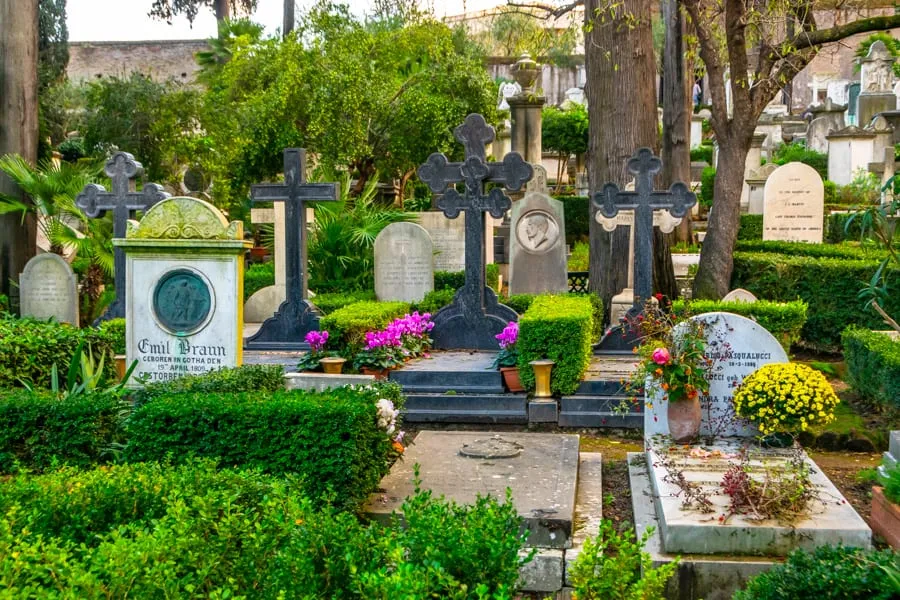
Head to the Testaccio Market.
11-minute walk from the Non-Catholic Cemetery.
As compared to the Campo de’Fiori market noted earlier on this 4 day Rome itinerary, the Testaccio Market (and Testaccio in general) has a distinctly local feel.
True, this neighborhood isn’t unknown to tourists–but it’s also far from overrun by them, and you’ll find plenty of Romans shopping among you at the indoor Testaccio Market.
Check out clothes, shoes, and housewares, or head right to the food–both prepared food and groceries are available in the market.

Stop by Piazza Testaccio.
5-minute walk from Testaccio Market.
You won’t necessarily need long in this quiet and small piazza–but that’s exactly why you should take a moment to stop by.
So many of Rome’s piazzas that you’ll see during your 4 days in Rome tend to be completely packed (did you know that the area around the Trevi Fountain is actually called the Piazza di Trevi? It’s definitely not peaceful these days…).
Strolling through Piazza Testaccio, on the other hand, is a great opportunity to enjoy a more laid-back version of this classic feature of Roman life.
If you want to relax and enjoy the piazza for longer than a quick look, we can recommend grabbing an aperitivo at Oasi della Birra!
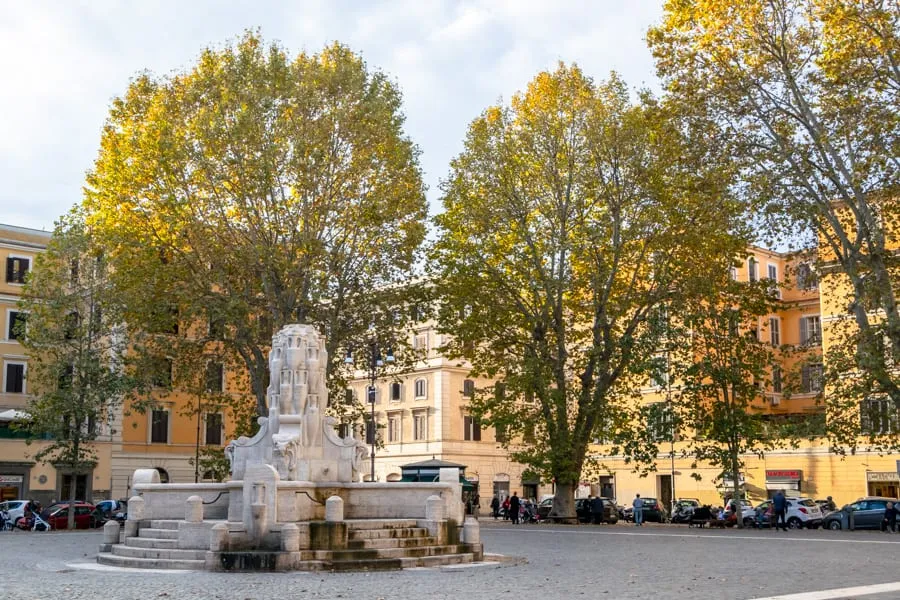
Snap a photo at the Keyhole on Aventine Hill.
12-minute walk from Piazza Testaccio.
If you peer through the keyhole on Aventine Hill, you’ll be greeted with a beautiful view: the dome of St. Peter’s Basilica, framed by garden hedges.
It’s a lovely spot… that we totally missed the first time we tried to visit on account of (apparently) skimping on research.
When I had seen the many photos of this spot in the past, I mistakenly assumed that the “keyhole” in the name was merely referring to the small break in the hedges that framed St. Peter’s–but no, you do indeed peer through a literal keyhole to see it.
Don’t make our mistake and end up walking right by without checking it out!
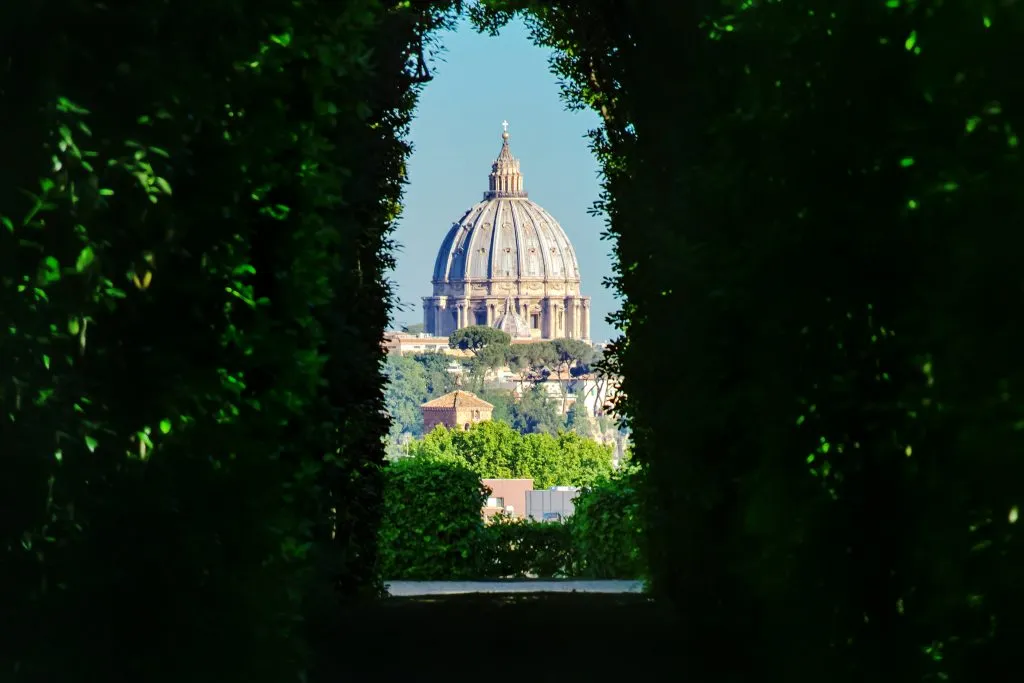
Stroll through the Orange Garden.
4-minute walk from the Keyhole on Aventine Hill.
The Orange Garden is a gorgeous place, and a perfect spot to pause and relax during your 4 days in Rome.
Home to–what else–a grove of orange trees, the garden is meticulously manicured and a very peaceful place to take in the stunning views of Rome that are available from the terrace at the back of the garden.
The Orange Garden is an incredibly relaxing place and a great spot for resting your feet and people-watching for a bit.
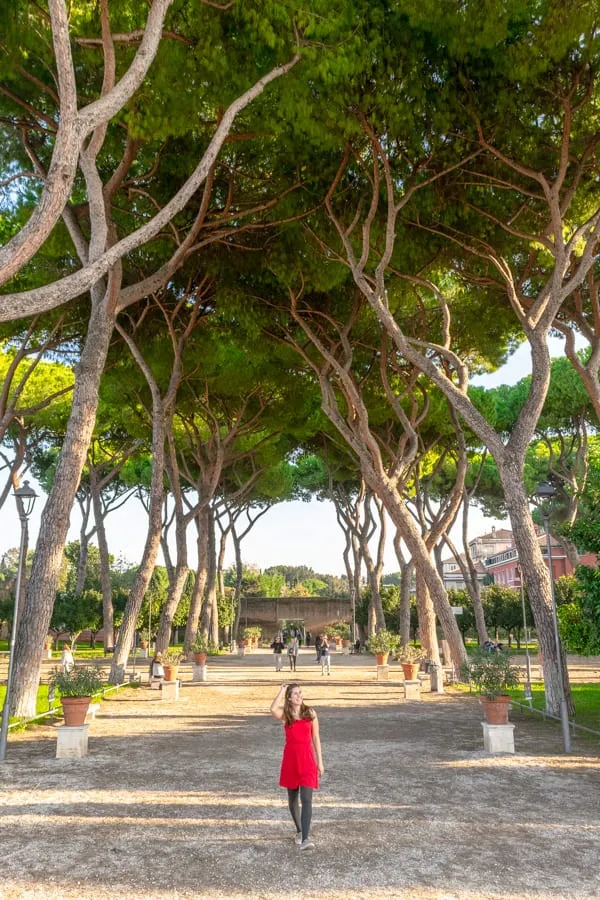
If you’re a history buff, stop by Circus Maximus.
8-minute walk from the Orange Garden.
I wouldn’t necessarily consider seeing Circus Maximus to be an essential stop on this itinerary for Rome in 4 days, but as it’s so close by, it’s worth mentioning for any Roman history buffs that are visiting!
Circus Maximus was the first stadium in Rome and was known for its chariot races.
Located between Aventine and Palatine Hills, you can still see remnants of ancient palaces staring down over Circus Maximus.
Today, the site is a public park and is essentially a field with very few ruins remaining, hence why I don’t think it’s an unmissable stop on your Rome itinerary.
But, that being said, it is very cool to see modern Romans exercising in the exact spot where chariots once raced!
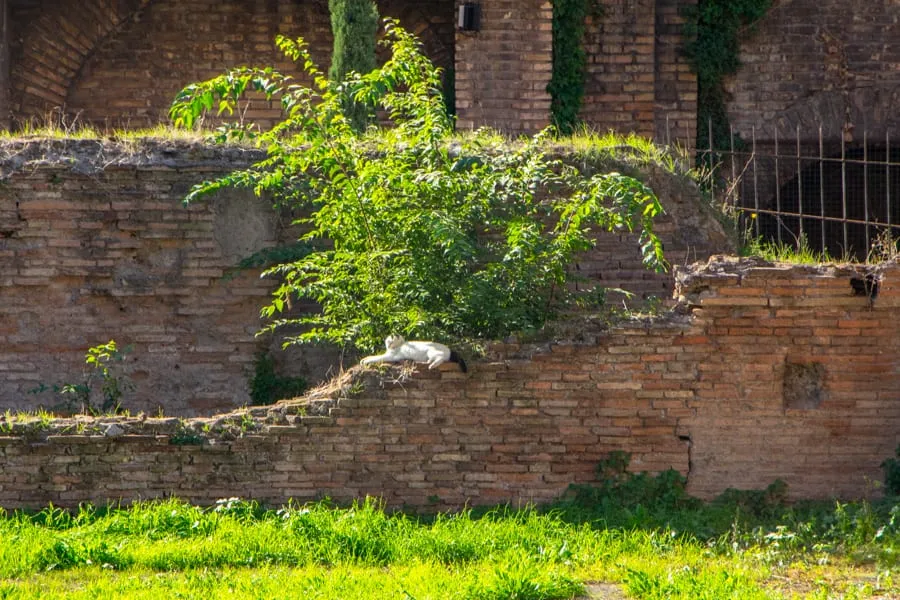
See a less-visited side of Ancient Rome.
By this time in your trip to Rome, you’ve had a chance to sample a wide variety of the Eternal City’s history, from the works of a Republic followed by Emperors in Ancient Rome, to the realm of popes and kings and beyond.
As you get close to the end of your trip, consider going back to the beginning and visiting one of Ancient Rome’s less crowded sites!
The Baths of Caracalla and Domus Aurea (Emperor Nero’s Golden House) are both incredible options.
Domus Aurea requires a bit of planning ahead, but you won’t forget the experience anytime soon!
If you’re curious about Ancient Rome but more interested in museum settings than archaeological ones, this is a good chance to loop back to the Capitoline Museums , as well.
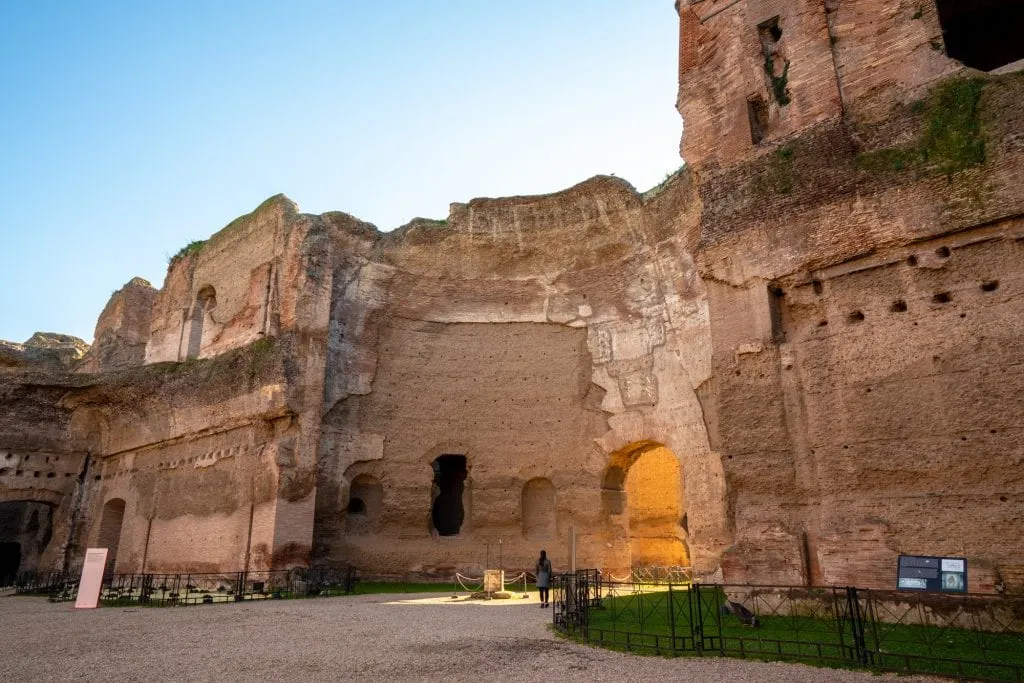
Close our your 4 days in Rome itinerary by stepping inside Rome’s catacombs.
Lurking underneath the surface of Rome are 60 catacombs, dug by early Christians in the days before the city as a whole converted–and of those 60, 5 are open to the public.
For a side of Rome that you definitely haven’t seen so far, descend underground for a visit!
Depending on how fast of a sightseer you are, you may want to choose between this and one of the attractions in the above section–or you may want to squeeze it all in!
When it comes to Rome’s catacombs, The Catacombs of St. Callixtus are the largest and most visited, though all are worth seeing.
While the various catacombs tend to be open until 5:00 PM, for maximum flexibility, consider signing up for this after-hours catacombs tour through Take Walks!
(Note that the tour also visits the Capuchin Crypt, so if you plan to take it, don’t visit the crypt as mentioned on day 2 of this itinerary for Rome).
Book your visit to Rome’s catacombs today!
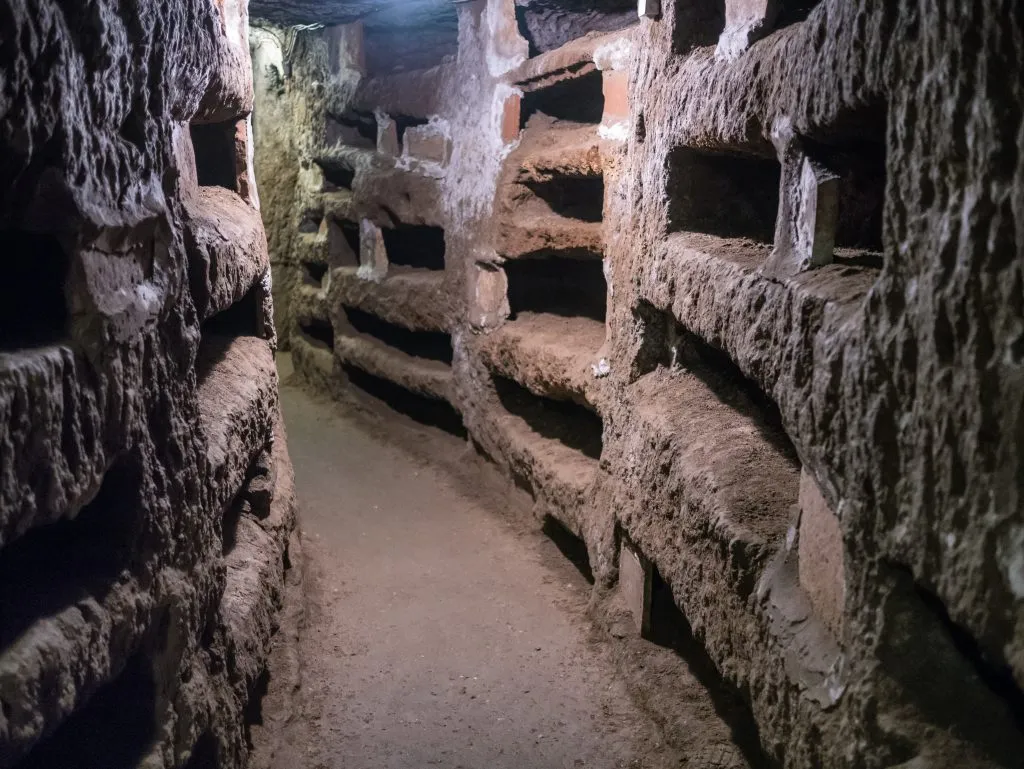
Where to stay for 4 days in Rome depends a lot on your priorities.
Do you want to be surrounded by a beautiful neighborhood? Trastevere is the place for you.
In the center of the action? Head to Centro Storico.
Save money? The furthest reaches of the metro lines.
With 4 days in Rome, though, we consider access to the rest of the city to be the most important deciding factor when deciding where to stay–in other words, choose somewhere within no more than a 10-minute walk to a metro stop.
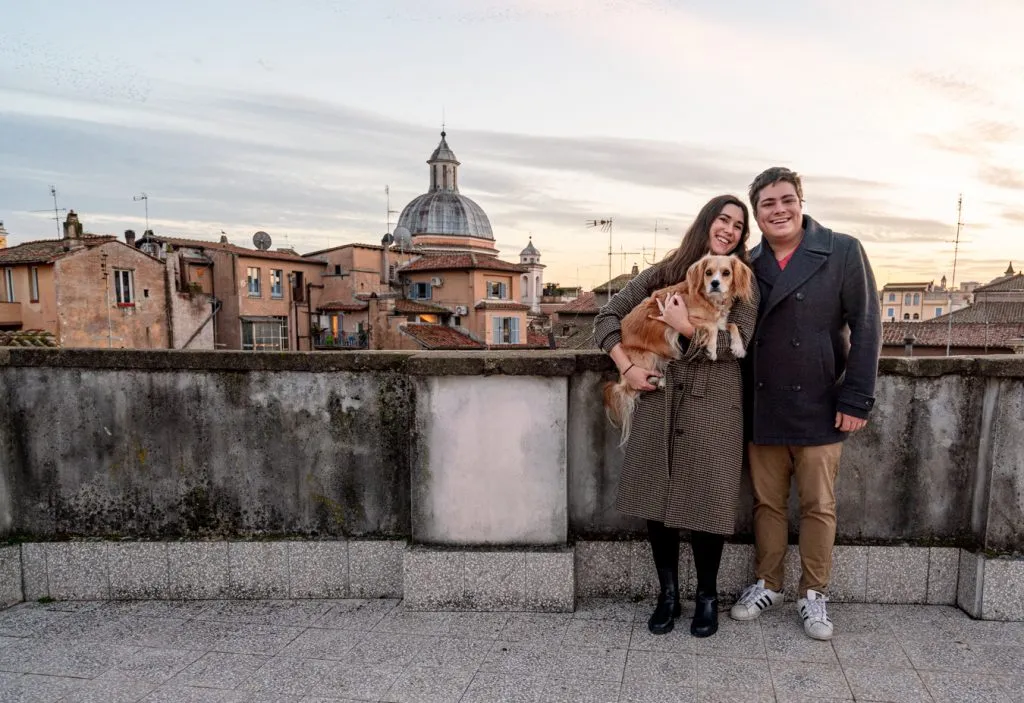
However, if it’s within your budget, we find Centro Storico or fairly close to it (the closer edges of Trastevere, Monti, or Prati/Vaticano, for example), to be the most convenient place to stay for this Rome itinerary.
When choosing a hotel or apartment, looking at its distance from Piazza Navona and the Pantheon is a good rule of thumb–in a perfect world, you’ll be within walking distance of those.
That being said, we’ve stayed all over Rome and loved each corner for different reasons!
Here are a few well-reviewed properties to keep in mind when deciding where to stay in Rome.
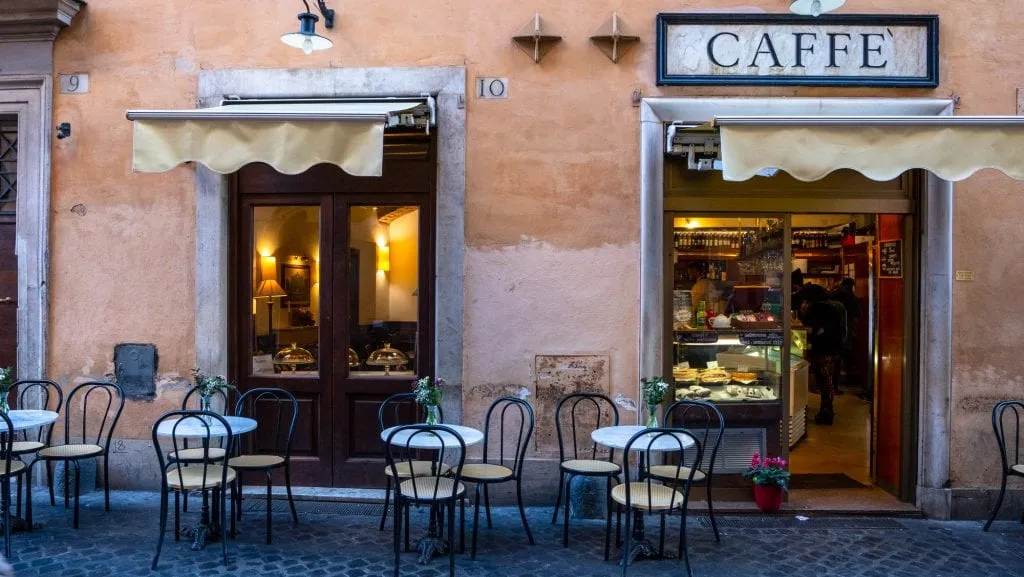
La Cornice Guesthouse — We loved this little guesthouse back in our budget backpacking days! It was extremely clean and comfortable, and very affordable for Rome.
La Cornice is set slightly outside the main tourist areas, but an easy 5-minute walk to the metro and a 20-minute ride got us to the Colosseum and other major sights.
Our favorite part of La Cornice?
Eating a nearby Joseph Ristorante for lunch, a restaurant we have returned to for years–and it all started with a recommendation from the clerk at La Cornice.
Just a 5 minute walk away, their lunch special offered a choice of about 10 main courses plus bread, wine, and one of several desserts for 8 Euros/person–it’s hard to beat that!
Check rates & book your stay at La Cornice Guesthouse!
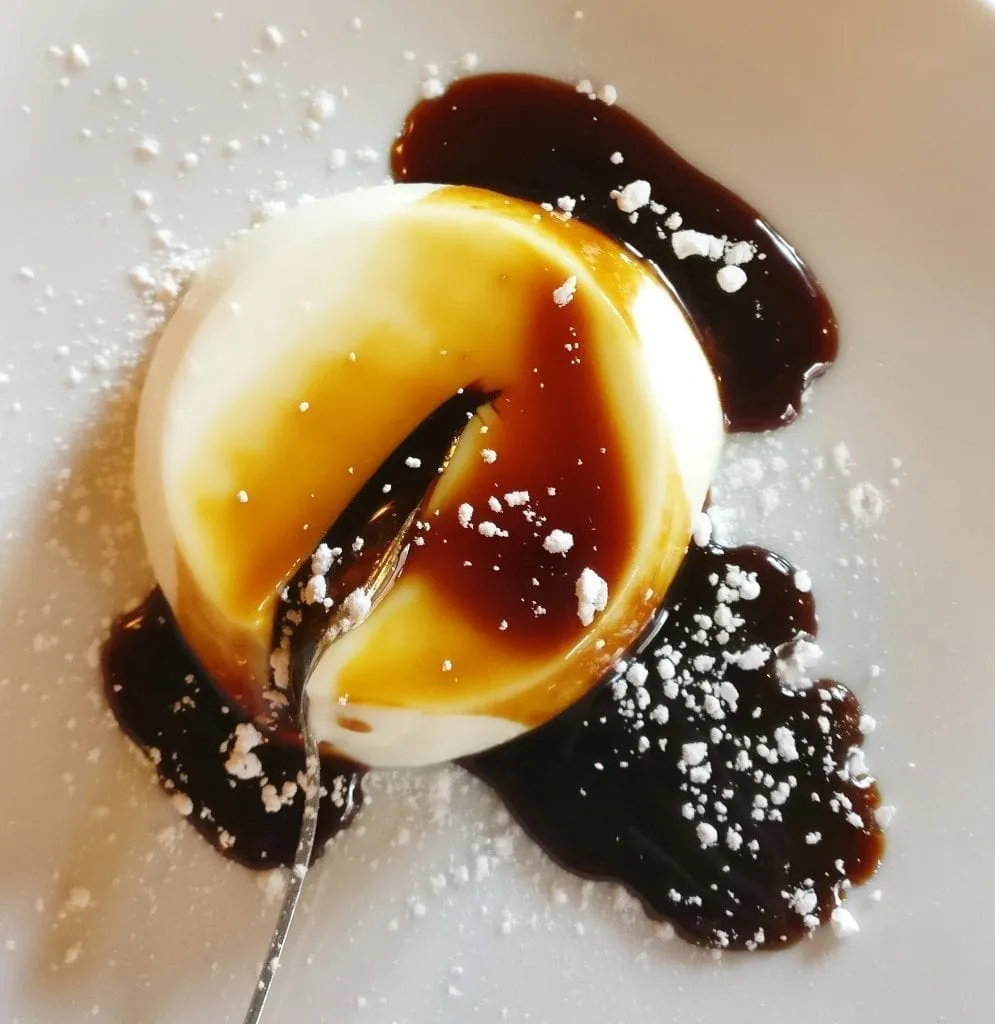
The Wesley — We adore this hotel! You can’t ask for a better location for exploring Rome, as it literally overlooks the Castel Sant’Angelo and is a short walk away from all the major Centro Storico sights.
It is a bit of a hike to a metro stop–you’ll probably need to take a taxi when you arrive/leave with luggage–but the location made it worth it for us.
For a mid-range property, The Wesley is a fairly simple one–expect small and extremely simple rooms, and shared bathrooms for some rooms.
Essentially, The Wesley as a guesthouse floats somewhere between budget and mid-range, with a luxury-status-worthy location.
Because of the fantastic combination of more affordable rates and a fabulous location, The Wesley sells out fast–if you want to stay there and see it’s available on your dates, we recommend booking immediately!
Check rates & book your stay at The Wesley!
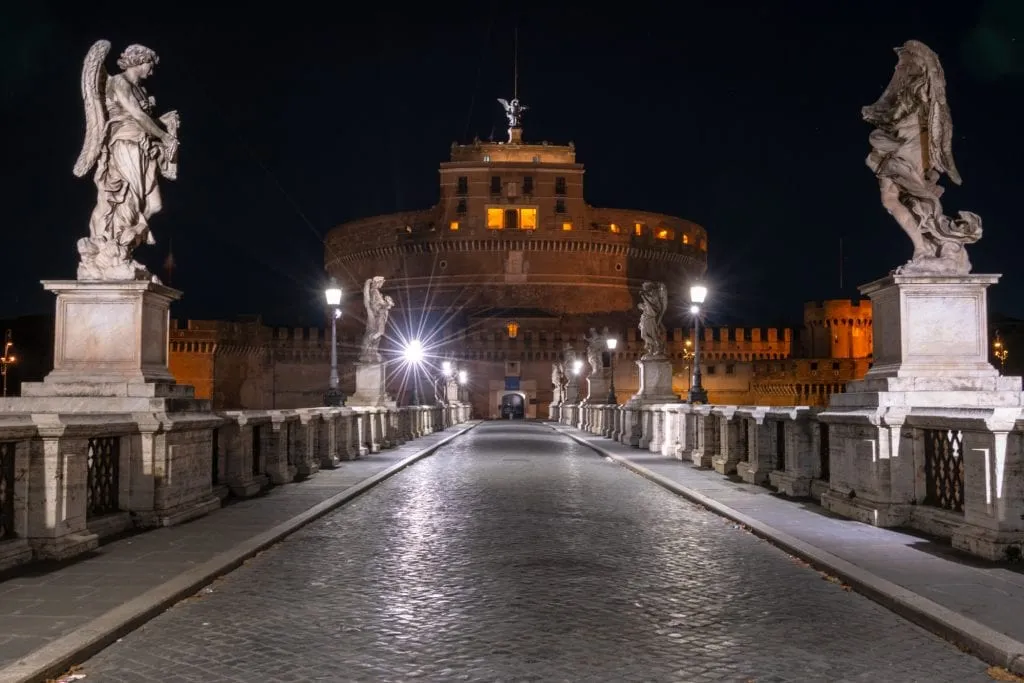
Hotel Condotti — Located just a couple of blocks from the Spanish Steps (and consequently the Piazza di Spagna metro station), you couldn’t ask for a better location in Rome!
Well-reviewed and boasting exceptionally clean rooms, Hotel Condotti is the perfect choice for a traveler with a midrange budget (or luxury traveler–this hotel also holds some impressive-looking suites!) who would like to be within walking distance to the best that Centro Storico has to offer.
Enduringly popular and perfectly positioned, you can’t go wrong with checking into Hotel Condotti.
Check rates & book your stay at Hotel Condotti!
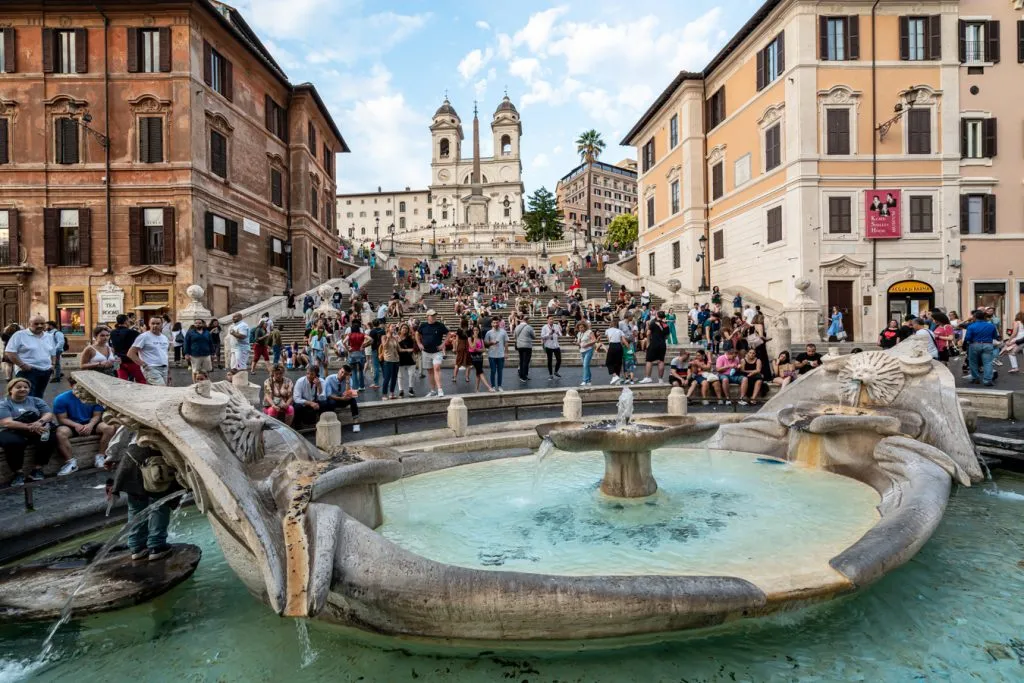
Pantheon Inn — If you’re looking for a building with classic Italian charm in the heart of Rome, this is it.
Located right behind the Pantheon and within reach, the Pantheon Inn offers a quiet, peaceful escape in the middle of bustling Rome.
You will need to walk a bit to the metro stop–but since the walk will take you through the heart of the beautiful Centro Storico, we doubt you’ll mind.
Check rates & book your stay at the Pantheon Inn!
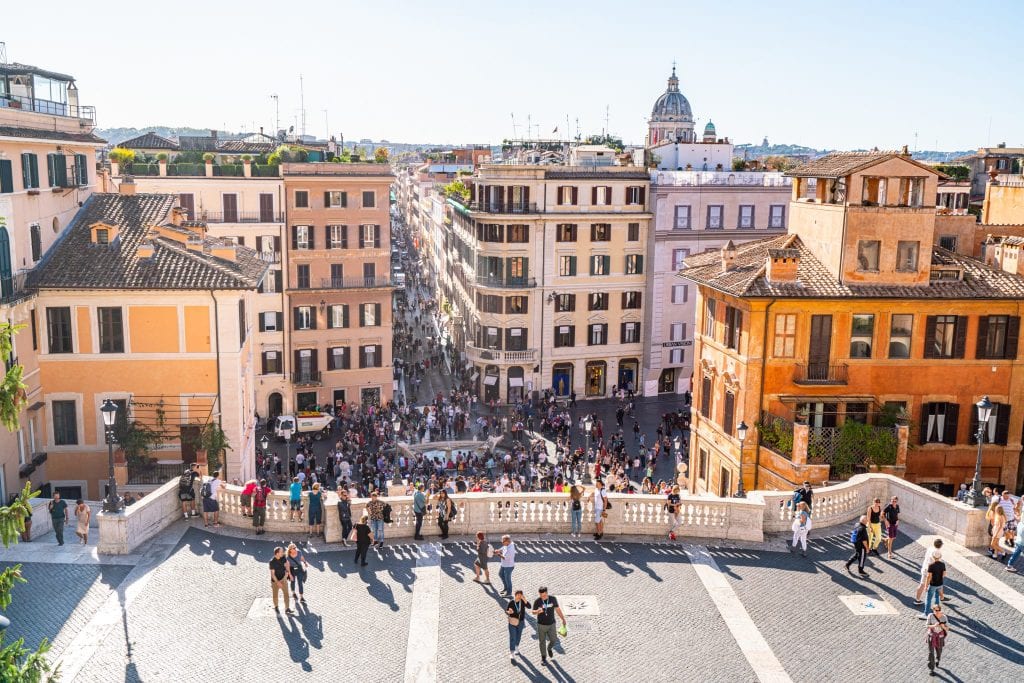
If you’re lucky enough to have more than 4 days in Rome, it’s time to start thinking about day trips!
Consider heading to the nearby Tivoli Gardens, to hilltop towns like Orvieto or Siena , or out on a wine-and-food-centered Tuscany day trip .
If you plan ahead and use the fast train, you can even take a day trip to Florence !
Pompeii is a popular–and worthy–side trip from Rome, but to accomplish it as a day trip, you really need a tour, and this one is among the best of the best!
Pompeii is about 6 hours of driving round-trip from Rome, longer (and more confusing) via train, and trying to also squeeze in Vesuvius on an independent day trip from Rome would be nearly impossible.
If you’d like to visit Pompeii and the Amalfi Coast from Rome, this extremely popular tour has been reviewed more than 2,500 times with Take Walks and is a safe bet to get you there!
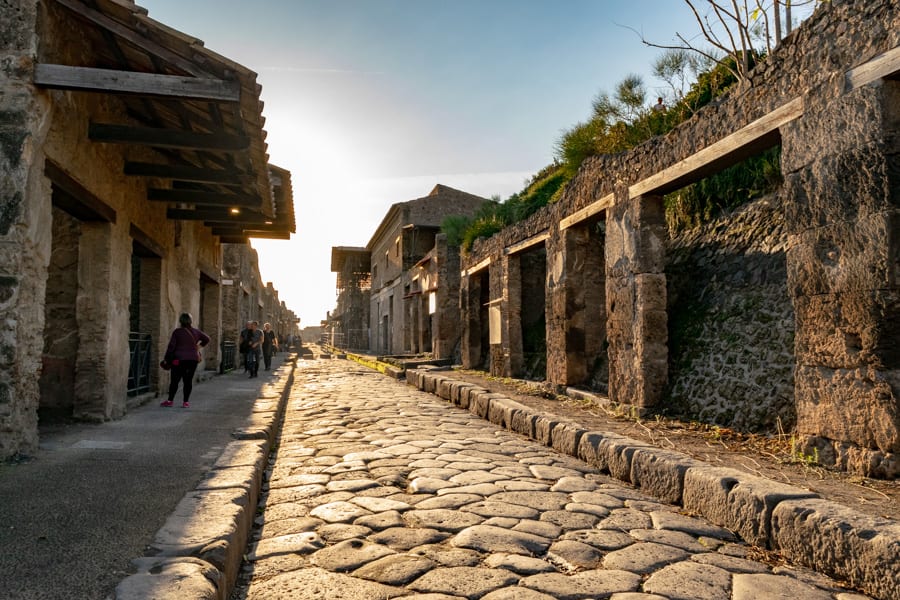
We highly recommend going, it’s an incredible place–just be sure not to overstretch yourself!
Within Rome itself, there’s also plenty to do with extra time!
Consider checking out the Baths of Diocletian, heading out to the Appian Way, visiting the over-the-top neighborhood of Quartiere Coppede , taking a cooking class, or touring more Ancient Roman sites like Santo Stefano Rotondo.
Lesser-known museums like the Galleria Spada and Palazzo Doria Pamphilj are among our favorites and also well worth a visit!
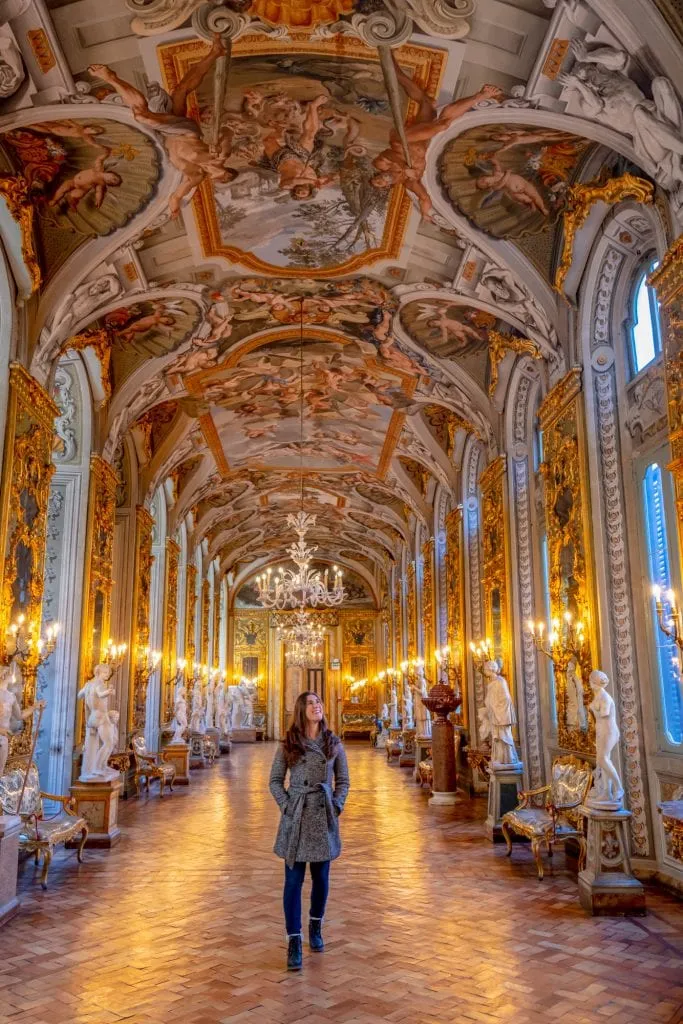
Getting Around During 4 Days in Rome , Italy
We designed this 4 days in Rome itinerary to be as walkable as possible, grouping destinations by geography where we could.
Even still, Rome is large enough that you will need to use other methods of getting around.
The easiest option is simply to use the metro–though Rome’s metro has a mere 3 lines (only 2 of which will likely be of interest to you as a visitor), it connects directly to many of the city’s highlights, including the Colosseum, Trevi Fountain, Spanish Steps, and more.
If you can swing it, your 4 days in Rome will be highly enhanced by staying within a short walk of a metro stop.
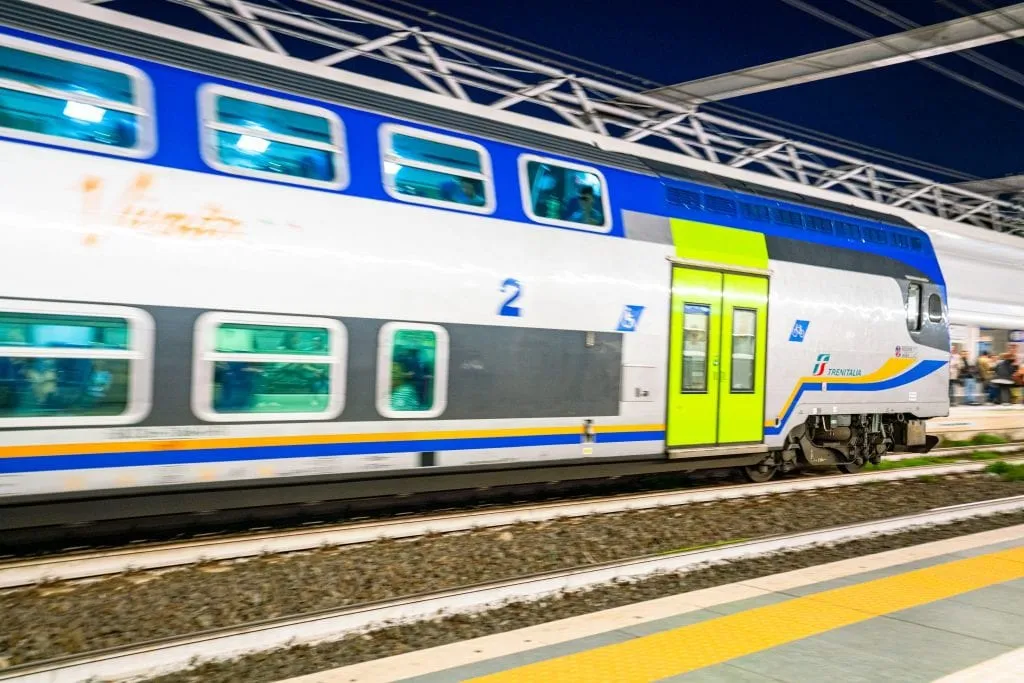
Rome’s bus system is also an option, though it can be slightly confusing and you cannot purchase tickets onboard.
Pick them up at a nearby tabacchi or metro stop before hopping on, or aim for simplicity and purchase a multi-day pass to the transport network.
Uber and taxis are both also present in Rome, but Rome’s heavy traffic and their high prices make these options best avoided if possible.
For the same reason, we don’t generally recommend Hop On/Hop Off bus tours in Rome, but they do exist if you prefer them.
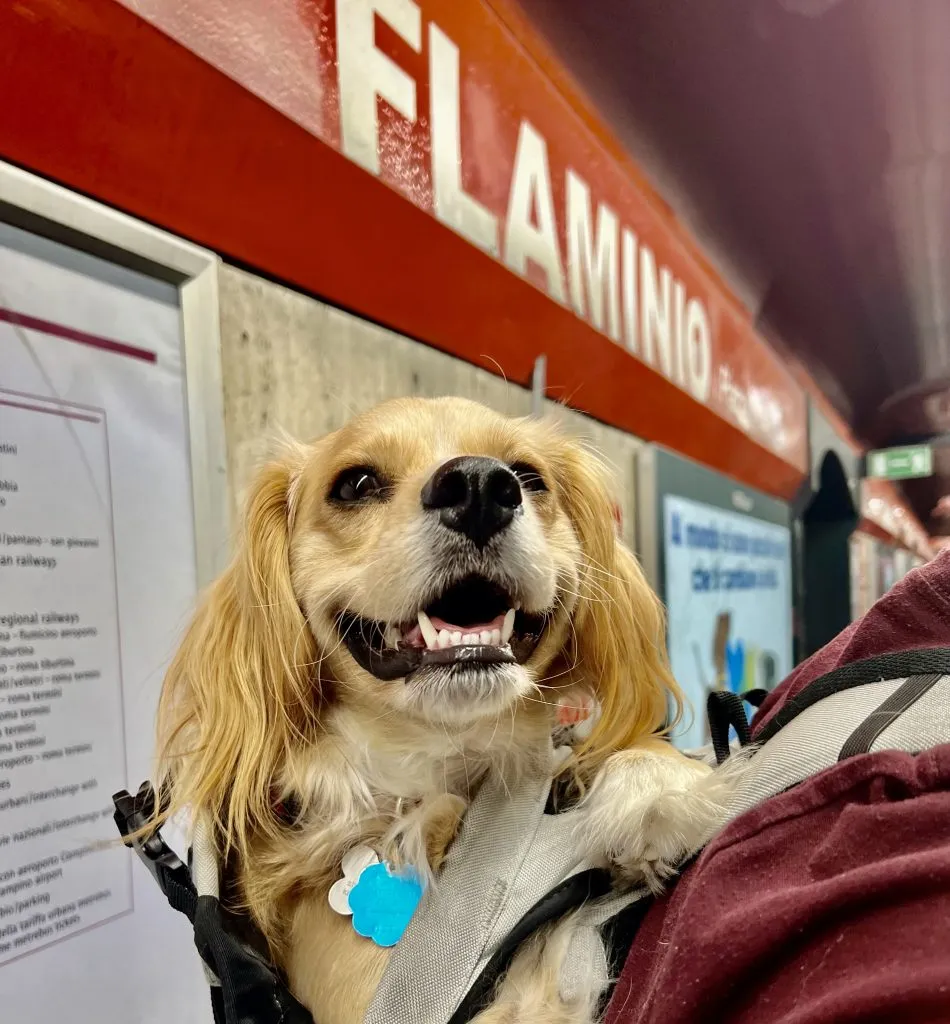
Despite Rome’s international reputation as a pickpocket hotspot, it is, on the whole, a very safe city.
Yes, you do need to keep an eye on your pockets and bags in crowded areas (pay especially close attention in crowded metro stops like Termini and at tourist hotspots like the Trevi Fountain and Colosseum), but we’ve never had so much as a close call during our visits to Rome.
You will see scammers present in Rome’s crowded areas, including men presenting women with roses to try to elicit payment from her companion, “friendship bracelet” offers for bracelets that are free (until they’re tied on your wrist), etc.
It’s best to ignore these scammers entirely, and brush them off with a polite but firm “no” if necessary.
Also, keep in mind that buying and selling fake designer goods is illegal in Italy as both a consumer and a seller.
Be sure to keep your hands off the bags being touted by salesmen in tourist areas, no matter how convincing the imposter might look from a distance.
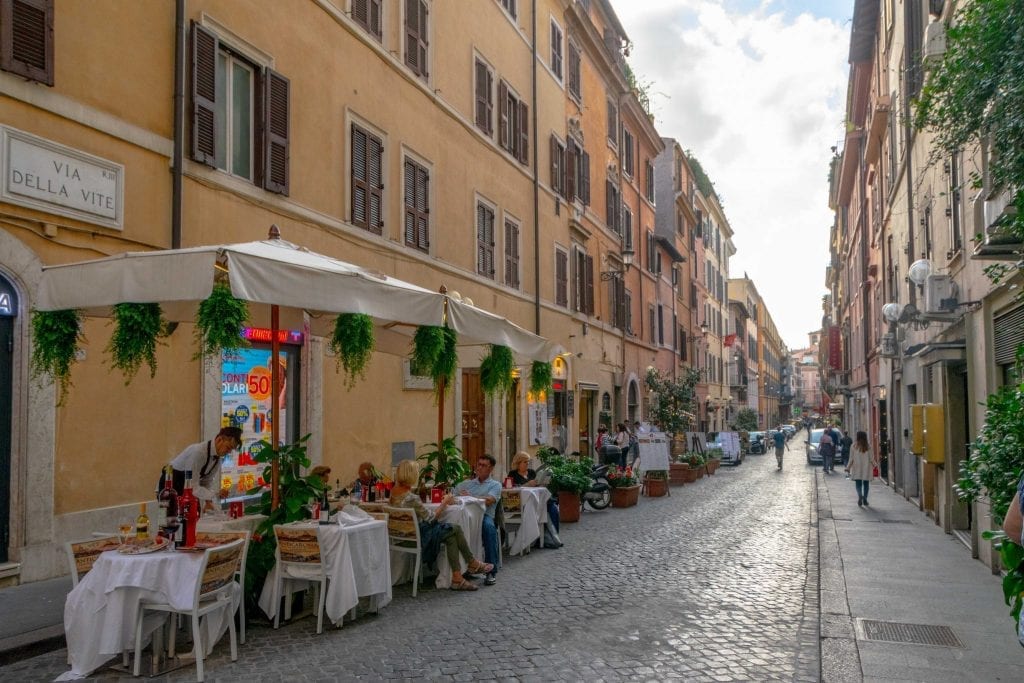
Each season brings a reason to spend 4 days in Rome, and we’ve seen them all in the city!
If you have your pick of dates, though, consider a trip in April or October–both offer high chances of beautiful weather while avoiding the worst of the crowds and prices of the summer high season.
Exploring Rome in winter also has its charms–winters are generally mild in Rome, so if you’re willing to bring along a coat, consider using a winter trip to explore Rome at its emptiest.
Our last choices of times to visit Rome would be July and August, when not only are the prices highest and crowds heaviest, but the weather is also boiling hot.
During summer in Rome, we tend to sightsee in the morning, retreat to air-conditioning in the afternoon, and then come out again starting in the early evening–but it’s not as relaxing as visiting during more mild weather!
(If you are planning a June, July, or August trip, here are our best tips for summer in Italy ).
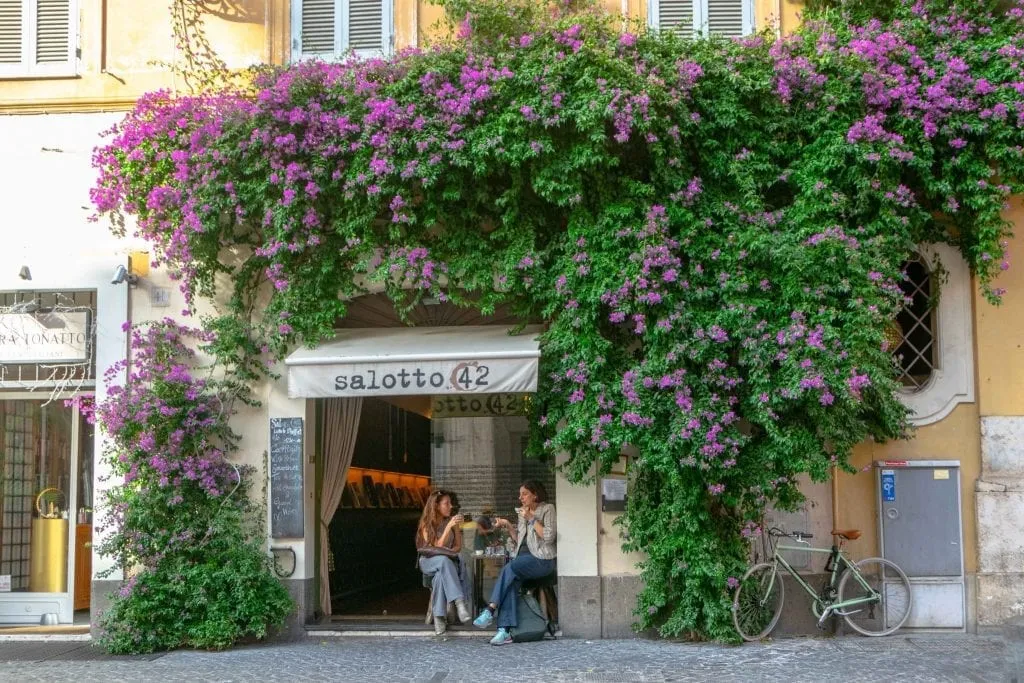
Don’t forget to include these important items when you pack for Rome!
Travel Insurance — We don’t ever suggest traveling without travel insurance–anything can happen, and this is definitely a case of better safe than sorry.
Bring a small pack of tissues, toss them in your day bag, and you won’t have to worry about it.

You’ll be so glad you brought along a Swiss Army Knife!
Option C: Hope you get lucky with the weather (but fair warning, we’ve never been to Italy and avoided rain entirely!).
Take This Map With You! Click each highlight to pull up the name of the destination. To save this map to “Your Places” on Google Maps, click the star to the right of the title. You’ll then be able to find it under the Maps tab of your Google Maps account! To open the map in a new window, click the button on the top right of the map.
[convertkit form=828904]
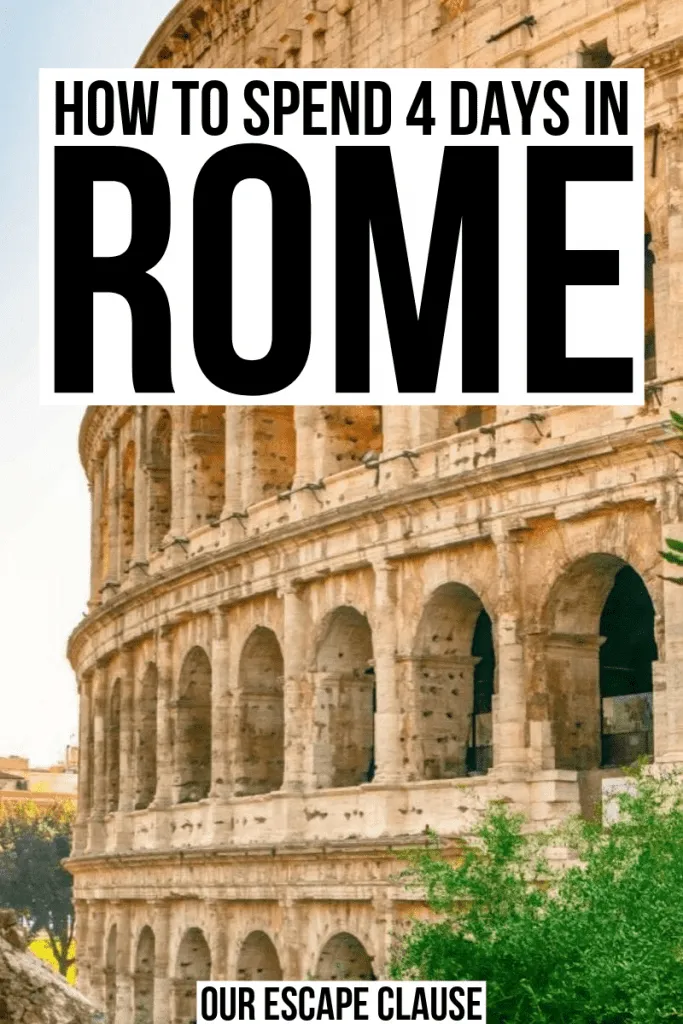
About Kate Storm

In May 2016, I left my suburban life in the USA and became a full-time traveler. Since then, I have visited 50+ countries on 5 continents and lived in Portugal, developing a special love of traveling in Europe (especially Italy) along the way. Today, along with my husband Jeremy and dog Ranger, I’m working toward my eventual goal of splitting my life between Europe and the USA.
31 thoughts on “The Ultimate 4 Days in Rome Itinerary (+ Map & Tips!)”
What an awesome guide! I love how complete it is – no stone unturned! I visited Rome back in 2014 and absolutely loved it. So much to see! Can’t wait to go back one day. Your blog is inspiring me to plan my dream trip: a full month travelling around Italy!
That sounds like an amazing trip! A month in Italy is a fabulous use of time. <3
Hello, Thank you for this! My wife and I spent 4.5 days in Rome in September 2017 and have not stopped taking about it since. The first trip was mostly a “pilgrimage” for us where we did visit many of the churches (though not nearly the 900). We are seriously considering heading back this September and look to do something a bit different. As much as I do love museums, my wife is not much of a fan so I will defer to her 🙂 . However, your itinerary can easily be adjusted to suit our needs (Wed audience in St. Peter Square vs Vatican museums, etc.) and is a super useful guide to areas I never would have considered before (Testaccio) and relatively structured days. Again, thank you!
Thanks so much, Michael! September 2017 was actually when we took our first trip to Rome too, and we can’t stop going back. 🙂 I’m sure you guys have already visited these on your pilgrimage trip, but just in case you haven’t and are looking for more church ideas, some of the coolest churches in Rome IMO that aren’t the completely obvious choices are Basilica di San Clemente and the Santo Stefano Rotondo. Hope you guys have an amazing trip back to Rome!
Thank you for this well-thought out, detailed, and diverse itinerary. Highly appreciated. Looking forward to following many if its stops next month in September.
Thank you so much, Wendy! Have a fabulous trip to Rome! 🙂
This was very insightful
Thanks, Yogita!
I just wanted to thank you because this guide really helped us to have a really awesome trip and saved us tons of time on planing, we did our 5 days trip to Rome on this guide, and the google maps itenerary was a life saver.
Rome was great and this made our trip easier
Best regards, from Lisboa, Portugal!
Thanks so much, Ruben! That is so wonderful to hear. So glad you had an amazing trip!
I travelled to Rome a couple of years ago and this is so close to my itinerary, its not funny. I am so glad to see itineraries like this on the internet that encourage people to go see the historical sights, vs. others that encourage people to ‘skip the important sites’ so as to not waste time.
Thank you for helping people experience the true beauty of Rome
Thank you, Pallavi! That is definitely our goal. 🙂
I just wanted to thank you because this guide will really help us on our 15th anniversary trip later this year. We have never traveled abroad and are so excited. This will save us so much time on planning.
So happy to hear that, Rachel! Hope that you guys have a fantastic trip, and Happy Anniversary!
Hi! My husband and I spent 4 days in Rome in late January 2020 and based our trip around this review. It was perfect for our first time. Thank you so much!
Thank you for sharing, Shareen, that makes my day to hear!
This guide is phenomenal. i was overwhelmed with the incredible options in Rome until I found this guide. We really want to do the food tour in Trastevere you recommend, especially since we are staying in Trastevere. , but there is not very much information about what is included. Is there a better description somewhere or could you give a a quick thumbnail? Thanks!
Thanks so much, John, that’s wonderful to hear!
Unfortunately, the exact Trastevere tour we took isn’t online anymore, but we do link a popular, comparable option in this post: https://www.ourescapeclause.com/trastevere-food-tour/
Trastevere is a popular neighborhood and while each tour will follow its own exact route, you can generally expect to a try a pasta, a cheese shop, gelato, etc–all the classics!
Kate & Jeremy thank you for being so kind and thoughtful to share thitineraries of Rome and additional travel information with the rest of us. I will be in Sorrento the last week of Feb. 2023. Do you know if the port has daily ferry tours to the Amalfi coast? Also travel by vehicle should I be concerned about luggage being stolen during stops as I am traveling. Also, would you have a recommendation on a name of a facility or location I could rent a vehicle. Thank you for your help.
Of course, glad it was helpful!
I’m not sure if the boats run daily during the winter, but I would think so.
For rental cars, we use and recommend Discover Cars–it’s a search engine that will pull up both local and international carriers.
As far as safety, it’s not recommended to leave anything at all visible in your car while parking it. Some people are comfortable with storing luggage out of sight in a vehicle, and others prefer not to take the risk. It’s a matter of personal risk tolerance, essentially.
Loved reading your 4 day guide to Rome, my wife and I are visiting mid August 2023, and aside from visiting the places you mentioned. It would be lovely to know some little restaurants off the typical tourist route that serve really nice Italian food. Hopefully you can send us in the right direction.
We have several, and are always adding new ones to our list!
I try to update them and include options near the attractions where we’re located, but a couple that we like that I don’t think are mentioned here include Osteria La Quercia (near Campo de’ Fiori), Cul de Sac (an enoteca with a huge wine list), Arancio d’Oro, and Antica Osteria Brunetti.
Hope you guys have a great time!
thanks for this information
You’re welcome, have a great time in Rome!
I have thoroughly enjoyed reading through this 4 day itinerary and planning for my stay in Rome. However, after a second look at my reservation I sadly realized I only have 3 days in Rome. Do you have a similar plan for a 3 day stay?
Not yet, though I hope to write one specifically for 3-day visits eventually!
The simplest way to rework this itinerary, though, would be to simply trim off the 4th day, as it covers the most off the beaten path spots of any given day on the route.
However, it depends on your interests! You can also opt to trim off whatever stops don’t sound interesting, and compress your days a bit to squeeze more in to a shorter time frame. For example, if you’re not much for art museums, you could skip the Galleria Borghese and/or the Villa Farnesina, and instead let the Vatican Museums shine as your big museum visit of the trip.
Yes, after looking at day 4, I thought trimming it off might work. Thanks very much for your response and for all the tips you’ve included here.
We were in Rome 10 years ago and are taking my daughter and her Fiance this Oct. This list is exactly what I was looking for! My husband and I would like a day trip to Florence while they do the Vatican (only need to see that once) and I have kept your guide for that as well. Is there a way to learn the bus routes etc? We walked EVERYWHERE on our last trip because we couldnt figure it out. We also used Rick Steves tours for a lot of it too and that was great!
Hi Melissa,
That’s wonderful to hear, thank you!
We don’t use buses a lot in Rome (we generally walk and occasionally take the metro), but you can plan your routes via the bus website! Here it is: https://www.atac.roma.it/
It’s still a bit confusing, but much easier than without any directions. As far as I know, the buses still require that you purchase tickets from a tabaccheria in advance, too–something to keep in mind!
Hi Kate, Love your post and has given me a great advice while we are planning our 21 day trip to Italy. I’m very curious to know what you do as a career/ or money to fund your lifestyle of travel. Would love to be able to see the world. I currently live and work in the US.
Thank you so much!
We’re professional travel bloggers, so our income comes from the ads you see when you scroll through the site and sometimes from a commission if you book something (like a tour or hotel) through one of our links. We don’t accept any sponsored travel and always pay for our own trips.
It did take us years to work up to blogging being a living wage, though! When we started, we were living off of savings from our 9-5 jobs back in Texas. We were one of those couples that quit to travel the world. 🙂
This blog post from years ago (that I’ve since updated) covers a bit of our early days: https://www.ourescapeclause.com/6-month-round-the-world-trip/
Leave a Comment Cancel reply
Let's be friends! Sign up receive our monthly newsletter with updates and new in-depth guides.

4 Days in Rome: How to Plan an Amazing Rome Itinerary
Wondering exactly how to spend 4 days in Rome? Or maybe you have more or less time and you’re trying to figure out how to plan an unforgettable Rome itinerary. Either way, you’re in the right place. We have each been to Rome multiple times – including a full ten days in 2021 – and have put all of our tips, tricks, and discoveries into this guide to help you plan an amazing trip, especially if it’s your first time.
We recently spent three months in Europe – the longest trip we can take on a tourist visa as Americans – and were astounded how often we heard about the Romans as we traveled around Spain and Portugal (not to mention Italy).
Everywhere we went, we found remnants of Ancient Rome, from temples to excavated ruins and city walls. In fact, many Spanish cities like Barcelona were founded by the Romans, though they obviously look very, very different today.
One of the things I find most interesting about Rome is the contrast between the elements of Ancient Roman history, which is perhaps the most well-known empire in human history (at least the most “well-known” in modern times), and the fact that Italy as a nation is relatively young.
One of the youngest in Europe, in fact. Italy didn’t become a sovereign nation until the mid 19th Century despite regions within its current borders being immensely important for two millennia, give or take.
Both Alysha and I have been to Rome multiple times before. In fact, I loved Rome so much after my first trip with family post-college-graduation that I did the exact same trip two years later, this time with friends. Alysha lived in Rome for six months in college, calling the more residential part of Prati, the neighborhood near the Vatican, home.
In 2021, we spent 10 days in Rome, split into two five day visits , and we fell in love with the city all over again. After that trip, we have almost completely re-written this guide to reflect our discoveries on that latest visit in hopes that you, like us, will fall in love with the city that has had such a profound impact on human history.
In this guide to planning your trip to Rome, you’ll find a detailed 4 day Rome itinerary, complete with things to do, see, eat, and drink, along with the important details you need to know like how to see the Colosseum and when to walk around the historic center to get that photo of Trevi Fountain without all the people.
You’ll also find logistics – like how to get around and the best time to visit – that are important for planning your trip.
We hope you enjoy this guide, that you find it helpful for planning your trip, and we help you discover something new and exciting, whether it’s your first time, or tenth.

Disclaimer: Some of the links in this post, like hotel links, are affiliate links, meaning at no additional cost to you, we make a little bit of money if you click through and book. That being said, we would never recommend something to you that we don’t stand behind 100%.
How Many Days in Rome?
Given the amount to do and see in the city, we think that 4 days in Rome is the absolute minimum you should plan for to avoid spending your entire trip running around from sight to sight without time to savor the atmosphere of the city and enjoy the dolce vita that makes Italy so special.
With four days, you’ll comfortably be able to fit in the Vatican, Colosseum, and Borghese Gallery alongside eating pizza and pasta, drinking plenty of wine, and exploring a few of our favorite neighborhoods (and getting some pretty magnificent views of Rome along the way).
Our biggest tip for planning a trip to Rome is to not do more than one major sight (e.g. the Colosseum, Vatican, or Borghese Gallery) on the same day .
Each of those places is going to take a lot of energy, and by the time you’re getting ready to go to the second one, you’re going to be exhausted and the experience isn’t going to be nearly as enjoyable.
If you have two or three days in Rome, it’s still doable. Below the main itinerary, we have our thoughts on how to spend one, two, and three days in Rome to help you plan a trip with less time.
Where to Stay in Rome
There are a wide variety of options in terms of accommodations in Rome, and which you choose is largely going to depend on your style and budget.
Which is why we’ve put together a detailed guide to help you decide where to stay in Rome , which has our favorite neighborhoods along with pros/cons and highlights for each. For more detail, head over and read that.
Here’s the short version.
- Our overall recommendation is to find a charming hotel or guesthouse in Trastevere , which is far and away our favorite part of Rome. Cobblestone streets, energetic piazzas, and some of the best bars and restaurants in Rome? Sign me up! We stayed at Horti 14 Borgo on our last trip, a gorgeous boutique hotel just outside of the center of Trastevere, and really enjoyed it. Especially the breakfast buffet.
- If it’s your first time in Rome , you can’t go wrong with the Centro Storico . Stay at Casa Pietra or Coronari Palace if you’re looking for a hotel or guesthouse. We stayed at these apartments on our latest trip, and they were almost perfect.
- If you’re looking for a slightly different experience , look at Monti , a hip part of Rome that’s near the Colosseum and Forum, and is packed full of bars, restaurants, cafes, and more. It’s a good central location, and generally feels much younger than, say, the Centro Storico.
You can find the long version over in our more detailed guide to where to stay in Rome .
4 Days in Rome: A Complete Guide to Planning Your 4 Day Rome Itinerary
Over the course of 4 days in Rome, you’ll marvel at the achievements of Ancient Rome, see some of the best art collections in the entire world, and delight in what modern Rome has to offer, like great wine bars, restaurants, and more.
Here’s an overview of the itinerary you’ll find below:
- Day 1 : The Colosseum & Roman Forum + Your First Aperitivo
- Day 2 : The Vatican, St. Peter’s Basilica, and Castel Sant’Angelo
- Day 3 : Self-Guided Centro Storico Walk + The Borghese Gallery
- Day 4 : Explore Two of Rome’s Best Neighborhoods
Day 1: The Colosseum & Roman Forum + Your First Aperitivo
Start your day where it all began – in the heart of Ancient Rome. Take the majority of the day to wrap your head around the centuries of history where this little quarter of the city played an outsized role, then spend the afternoon and evening experiencing aperitivo.
The Colosseum and Roman Forum
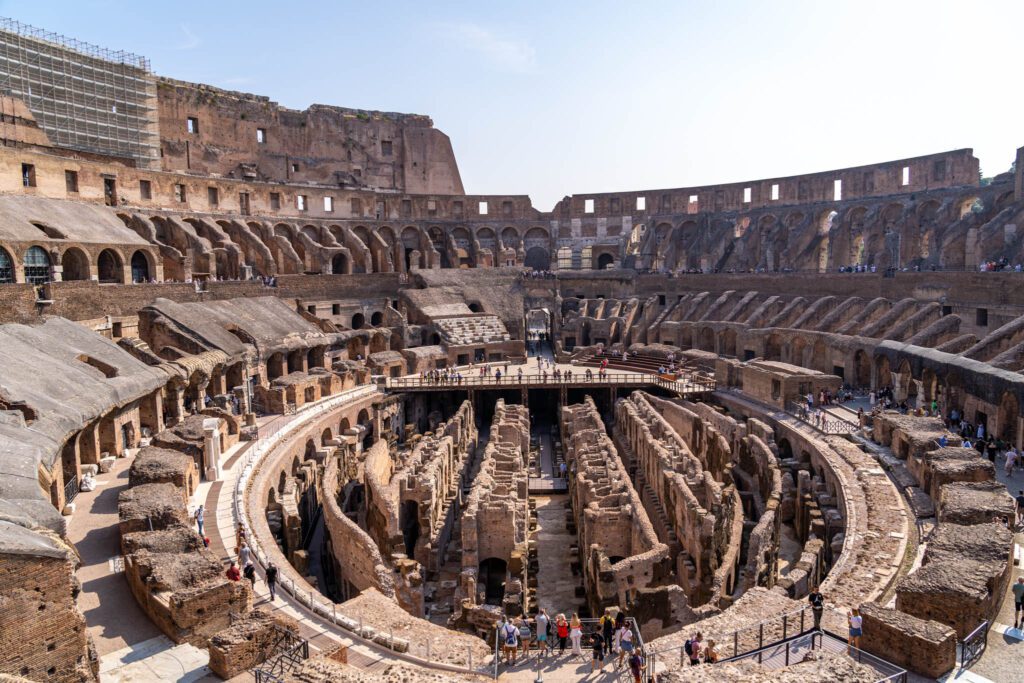
For all intents and purposes, these two sights should be grouped together. They represent similar periods in Roman history, they’re adjacent to each other, and they’re visited on the same ticket or tour.
Before or after your tour, there’s an excellent view of the Roman Forum from OUTSIDE the boundaries located here .
It’s well worth heading up and over the hill to Piazza del Campidoglio (with a replica of a famous Michelangelo statue in the middle) and Piazza Venezia , which houses the Altar of the Fatherland dedicated to Italy’s first king after unification, Vittorio Emanuele II.
The Colosseum (or the Flavian Amphitheater)
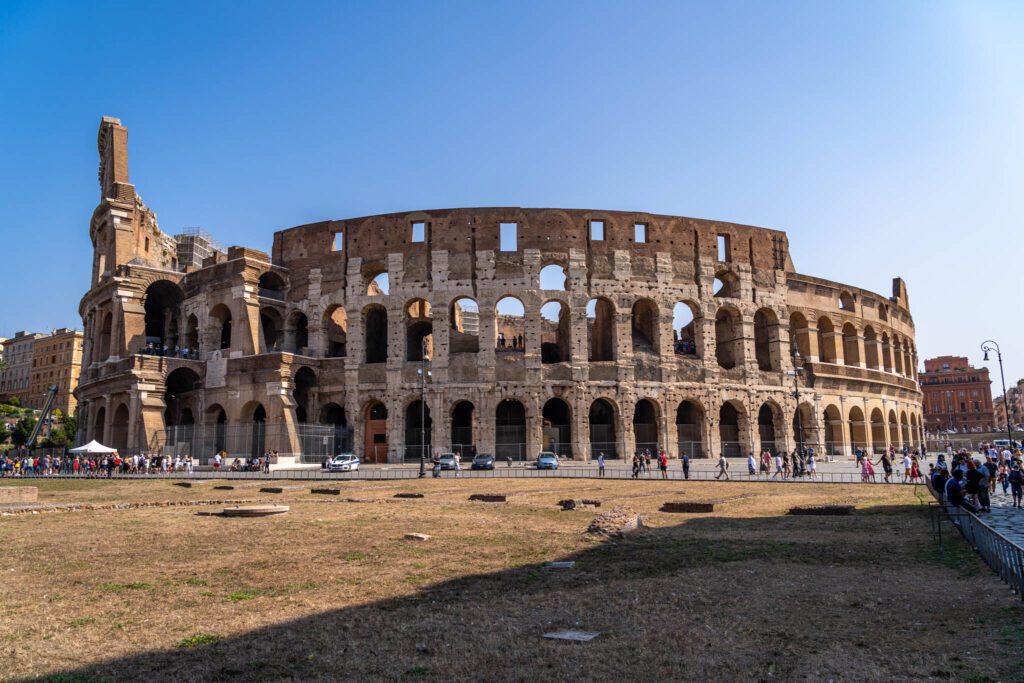
The Colosseum is the massive Roman amphitheater, the most well-known (and biggest) in the world. The structure was commissioned by Emperor Vespasian in 72 C.E. after the area was used as a private palace for infamous (and unpopular) Emperor Nero. It was kind of a gesture to the people that the ruling class hadn’t forgotten them.
Unfortunately, Vespasian didn’t live to see it completed. Instead, it was completed under his son Titus in 80 C.E., taking just eight years to build (which is insane when you consider that some churches take several centuries).
It’s most likely that the building, after some expansions and renovations over the years, could fit somewhere between 40,000 and 50,000 spectators, though you’ll still hear numbers as high as 80,000 thrown around which most historians agree is a little aggressive.
Another misconception about the Colosseum that is mostly perpetuated by media like movies and TV shows is that the gladiatorial games were brutal, bloody, and murderous.
That’s true to an extent, but our guide reminded us that, at the end of the day, the gladiators were highly skilled professionals AND they were the property of rich people who most definitely didn’t want their assets killed.
It’s more likely that the gladiatorial battles were similar to modern-day boxing matches than the bloodbaths you’ve seen Russell Crowe participate in.
They’ve reconstructed part of the wooden floor of the arena, and below that you can see the intricate series of cages, tunnels, and staging areas where gladiators and exotic animals were kept before being brought up onto the stage using an innovative elevator system.
It’s massive, and it’s an incredible feat of human ingenuity. I, Matt, have done the Colosseum four different times now, and each time my jaw hits the floor as you emerge onto the platform around the edge of the arena.
The Roman Forum
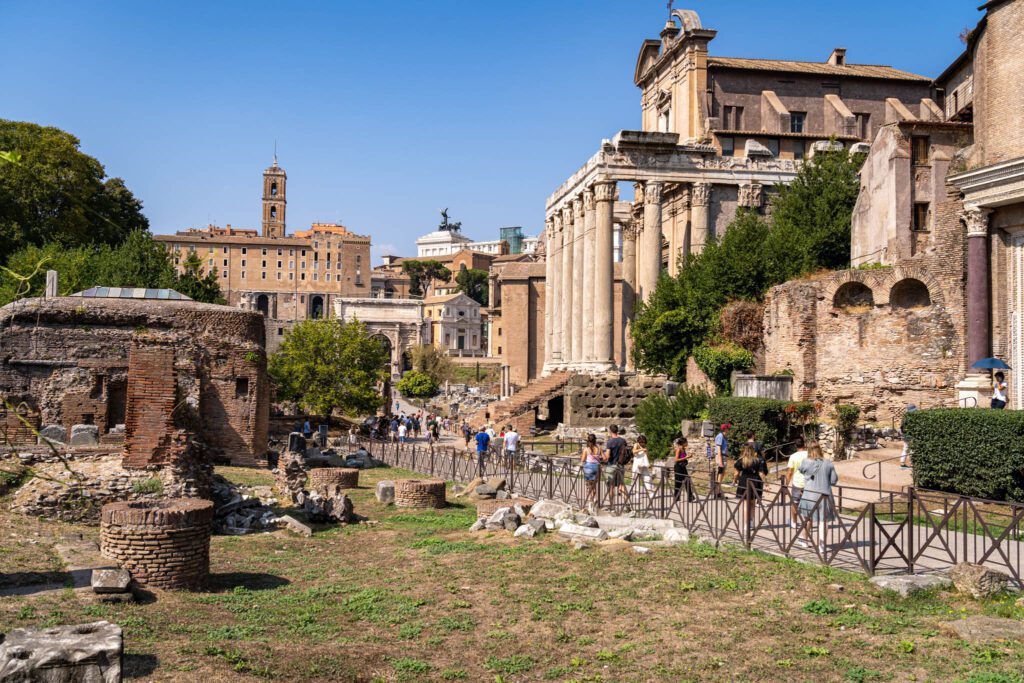
The Roman Forum – known in Italian as the Foro Romano – is a little different than the Colosseum. Unlike the Colosseum, which stands tall and intact (having been rebuilt and renovated over the years), the Roman Forum is mostly ruins.
Which makes it hard to understand what you’re looking at without a guide to help you decipher the difference between the Senate building and the Temple of the Vestal Virgins. Palatine Hill, one of the seven hills of Rome, is just to the southwest and is accessible from within the complex (you’ll find one of the best views in Rome from the viewpoint at the top).
The majority of the important buildings in Ancient Rome were within walking distance of this historic meeting place.
Contrary to popular belief, while there is a temple dedicated to Julius Caesar here, he was actually not killed in the Forum, but over near Largo di Torre Argentina.

How to Visit the Colosseum and Roman Forum
Like I mentioned above, I have done the Colosseum and Forum four different times now – twice with a guided tour, twice on my own – and I can say without a doubt that the Colosseum and Roman Forum are best experienced with a guided tour .
Specifically, a guided tour with someone who knows what they’re talking about, which is exactly what you’re going to get with Walks of Italy.
We did this Walks of Italy tour on this most recent trip to Rome, and we were blown away by the knowledge, richness, and detail that our guide – Dario – brought to the experience for us.
He busted all sorts of myths that we had fully believed to be true, and was able to weave together a cohesive story throughout the three hour tour that had us engaged the entire time.
And keep in mind, we had both experienced it already more than once before!
We highly, highly recommend booking a guided tour for the Colosseum and Forum. If you only have time for one guided tour in Rome, this should be the one.
Especially because the Forum is really just a bunch of crumbled buildings on the surface, and you need the history and context from a guide to really kick your imagination into overdrive and envision how this area might have looked when it was the beating heart of the Roman Empire.
If you’re not quite sure about a tour, read about our experience with the Walks of Italy Colosseum tour .

Visiting the Colosseum and Forum Independently
You, of course, can visit independently. We would suggest purchasing the audio guide, or downloading the Rick Steves audio guide ahead of your visit. It’s not going to be as interactive or interesting as a tour, but it will give you some of the context around what you’re looking at.
Buy your tickets in advance, and as far in advance as possible if you’re coming to Rome in the summer.
For more information and to buy tickets, go to the official website (we’re not giving you exact hours and ticket prices because they do change, and it’s better to just go to the official site to check them in real time).
You’re going to need at least three to four hours to do them both justice. Even in late September, exploring the Roman Forum was HOT. In the summertime, it will be borderline unbearable with very limited opportunities for shade and a brief respite from the sun. Bring plenty of water and sunscreen, you will need both.
Afterwards, take a well-earned break and grab lunch, head back to the hotel and relax, and get ready for a late afternoon walk up to one of the best viewpoints in Rome.
The Orange Garden and Keyhole
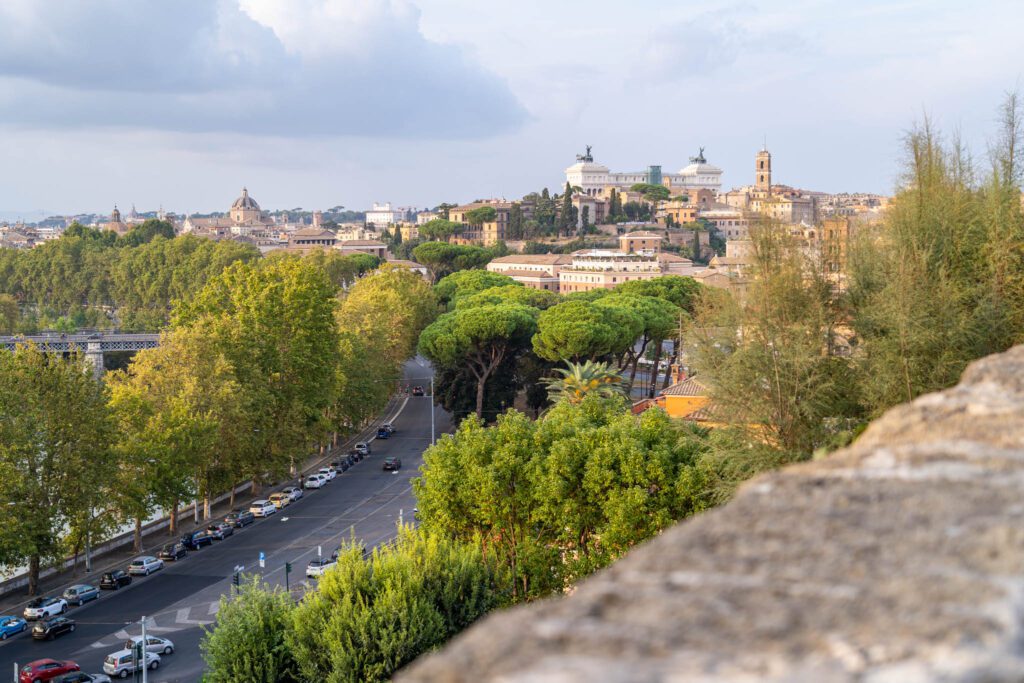
Post-nap, it’s time to get back out there and explore a bit more. This time, head to the Orange Garden ( here on Google Maps) , which is perched on a hill with great views of Rome and the Vatican.
Another worthwhile stop just a few hundred feet away is the keyhole ( here on Google Maps), which is a now-Insta-famous spot where you can look through, well, a keyhole, that has the dome of the Vatican perfectly framed. I say it’s Insta-famous, because if you’re here in peak season in the afternoon, you’re likely going to have to wait in line for the privilege of looking through said keyhole.
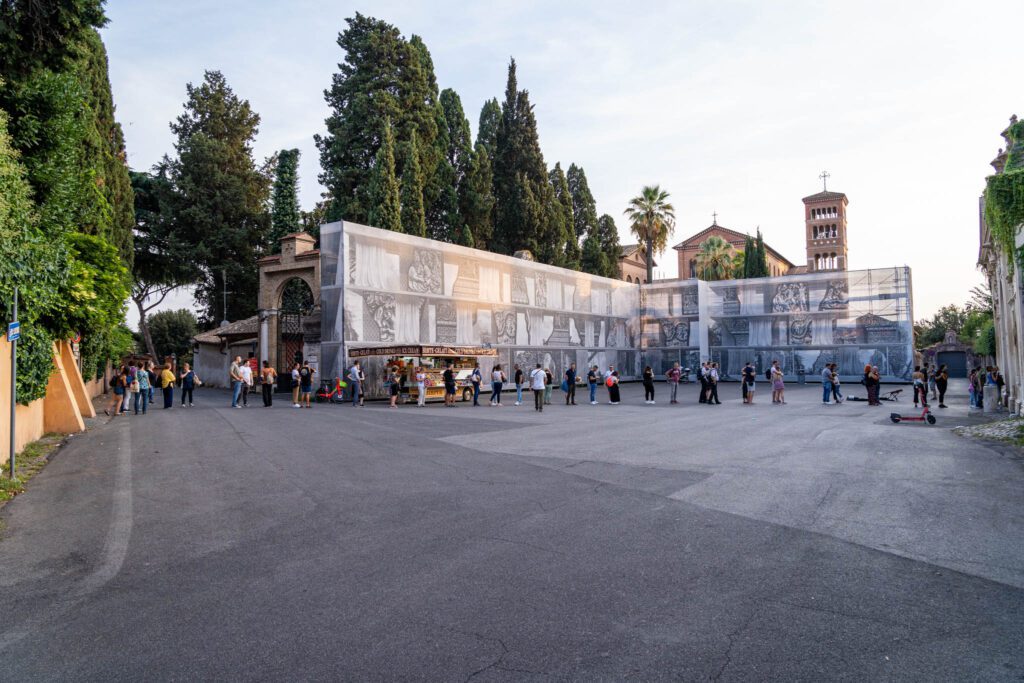
An alternative would be to do this part of the itinerary in the morning before the Colosseum, which is a vastly different experience. Instead of kids and tourists coming up to watch the sunset, the area is packed full of locals walking their dogs. And there was not a single person waiting to look through the keyhole, just us!
Your First Aperitivo
Aperitivo is a period during the late afternoon, between getting off work and dinner time (which is later than you’d expect in Rome) where people go out for drinks. And those drinks are served with a selection of small bites, like bruschetta, olives, and things like that.
If you’re American or Canadian, it’s a little like happy hour, except the food is complimentary with your drinks. While the days of full-on aperitivo buffets are behind us, at least in most of Rome, the idea behind aperitivo is still one of our favorite parts about spending time in Rome.
During aperitivo, our drink of choice (and what you’ll see many people drinking) is the Aperol Spritz. It’s a light cocktail – perfect for a summer day – that is made with sparkling water, sparkling wine (all of the bubbles, please!) and Aperol, an orange-colored bitter aperitif.
The spritz is usually 4-5 Euros (definitely don’t pay more than 6 Euros!), and is the quintessential aperitivo beverage to us. I made the mistake of ordering a Campari Spritz instead, just to try it, and won’t be doing it again. It was fine, totally drinkable if you’re into bitter liqueurs like Campari, but it wasn’t nearly as refreshing.
Anyway, after the orange garden, you’re in the perfect position to head to our favorite aperitivo spot in Rome – Zerosettantacinque – which is near where the Circus Maximus (a huge chariot racing track) used to be, which fits perfectly with the Ancient Rome theme of today.

The location is great, the drinks are good, and they bring you a little selection of bites to go with your drinks (and have a bigger menu of food, if you’re still hungry).
Dinner and Drinks in Monti

After a spritz or two, head into nearby Monti, the hip neighborhood on the northern side of the Colosseum, for dinner.
I say hip because there are multiple record shops and vintage clothing stores on one of the streets, which is a clear sign that the kids hang out there (by “the kids” I’m referring to 20-somethings wearing bell bottom light wash jeans and those glasses with thin wire frames and big lenses that look like Harry Potter’s glasses).
We walked through here a couple of times at various times of day. After dark is, by far, the most lively time to be here.
Grab dinner at either Cimarra Pizza and Cocktails or Al Vino Al Vino , and indulge in your first gelato of the trip at Fatamorgana , one of our favorite gelato shops in Rome with rotating seasonal flavors and fresh ingredients.
P.S.: We loved this piece on how to spot “good” gelato. Spoiler: the gelato with super bright colors that is spilling out of the tubs outside the shop near Trevi Fountain is, unsurprisingly, not the best you can find.
More Rome Travel Guides to Help You Plan Your Trip
- ITINERARY : How to Plan an Amazing Rome Itinerary
- WHERE TO STAY : The Best Places to Stay in Rome
- COLOSSEUM TOUR : Our Favorite Colosseum Tour in Rome (Review)
- GLUTEN FREE : Gluten Free Restaurants in Rome
Day 2: The Vatican, St. Peter’s Basilica, and Castel Sant’Angelo
On your second day, tackle the second world-famous attraction in Rome, the Vatican. Home to the Sistine Chapel and St. Peter’s Basilica, the Vatican is fascinating even if you’re not really religious. It’s an impressive collection of art, with the crown jewel being the Sistine Chapel.
A word on fashion for this day, not because we want to make sure you’re as stylish as possible, but because the Vatican is a religious site. That means your shoulders and knees should be covered up , even if it’s blistering hot in the summer.
Otherwise you may not be able to enter certain parts of the complex, namely St. Peter’s Basilica.
But First, Coffee

Before your trip to the Vatican, head to Pergamino Caffè for some of the best coffee in Rome. I’m a coffee lover, particularly if I get to choose which coffee is used to make my coffee, and this is the perfect place for that.
They have coffee roasters from all over Europe, heavily focused on Italian roasters, and will prepare you a cup of great coffee, whether you’re into lattes or filter coffee.
It’s on the south side of the Vatican, just around the corner from the main entrance to the Museums, which makes it a perfect spot pre-Vatican.
The Vatican and St. Peter’s Basilica
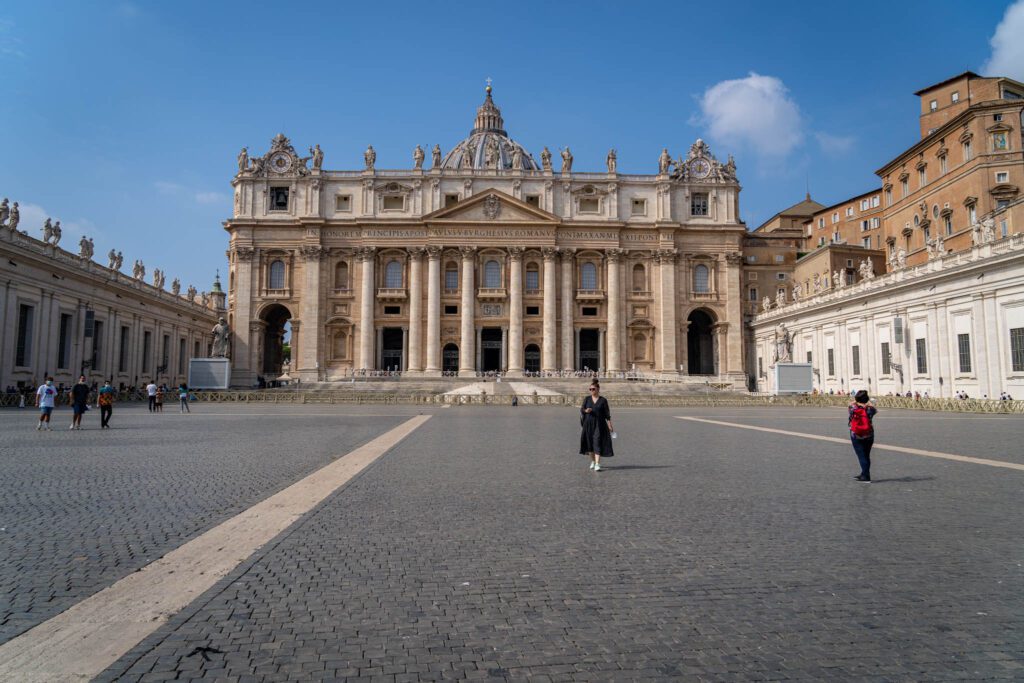
Arguably the most famous museum in the world makes its home in the collections of the Vatican. They show a whopping 20,000 pieces of art and culminate with the legendary Sistine Chapel, where the ceiling frescos bear the work of Michelangelo.
One contradiction that always pops up in the back of my mind when visiting huge, ornate churches has to do with the role of the church.
Why, you might ask, does an organization that preaches the Bible, which unequivocally condemns rich people who do not give away their wealth, have such an ornate and over-the-top display of wealth? Great question to ask the Pope, if you run into him (or her, in case you’re reading this at a time when we’ve gotten a female pope).
As a religious site, I have questions about the Vatican and St. Peter’s Basilica. If you put those questions aside for a second and just consider it as a collection of art, it’s a pretty incredible display featuring a who’s who of Italian art history.
There are essentially two pieces – the Vatican Museums (which include the Sistine Chapel) and St. Peter’s Basilica . You should visit both, and you should try to be either on the first or last tour of the day (obviously, the way we have it written would have you here for the first tour of the day).

Buy tickets here – toggle the site to English with the language selector in the top right.
For the best experience, we’d recommend either picking the tickets that include an audioguide , or, even better, book a guided tour that includes a live guide .
We’d go with the “Pristine Sistine” tour with Walks of Italy (have we mentioned that we really like them?), which gets you into the Museums an hour before they open to the public, when you at least have a shot at experiencing the magic of the Sistine Chapel before it’s packed wall-to-wall with smelly, loud tourists, which can really ruin the vibes.
Lunch in Prati
After the Vatican and St Peter’s Basilica, head into Prati, the neighborhood immediately adjacent to the Vatican, for lunch.
This is the part of Rome that Alysha called home for six months in college (albeit a more residential part of the neighborhood a ways away from the Vatican), and it’s a little bit more upscale and family oriented than other parts of the city center.
However, despite being so close to a tourist attraction – which is usually a bad sign in terms of food quality and value – there are some truly outstanding places to eat here.
If you’re looking for the best pizza-by-the-slice in Rome, go to Bonci Pizzarium , a tiny hole-in-the-wall where you’ll find a daily selection of rectangular pizzas served in rectangular slices, which is different from what you might get in the US. Pizza toppings rotate all the time.
I went here with friends years ago, and unfortunately the whole “gluten free” thing is a major problem in this case, so we didn’t go back this last time.
If you’re sick of Italian food (really? On day two?), we LOVED El Maiz , a Venezuelan restaurant serving arepas, cachapas, and tostones.

We love Venezuelan arepas, and were pleasantly surprised to find them in Rome. The tostones – fried green plantains with toppings – here are spectacular, and were among the best things we ate in Rome. Although the queso cachapa (kind of like a sweet corn crepe stuffed with about a pound of cheese) is delicious too.
Castel Sant’Angelo
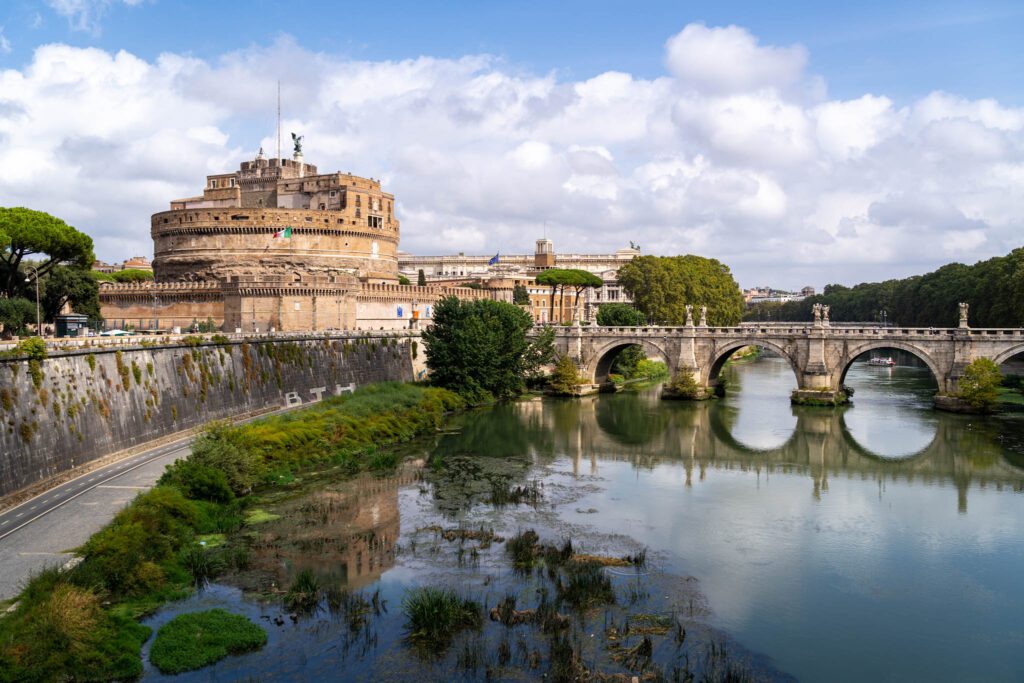
After lunch, make your way towards the river to Castel Sant’Angelo , which is a place that we ordinarily would have skipped, but found ourselves doing on day 8 or 9 because we had plenty of time to fit it in.
It was built by the Roman Emperor Hadrian as a mausoleum, and then the Catholic Church grabbed it and turned it into a fortress. Today, it’s part art museum, part abandoned castle with some cool art installations inside.
It’s a bit expensive to get in – 14 Euros at the time of writing – but we enjoyed it. The best part, by far, is the terrace on top, which has a lovely view of the Vatican.
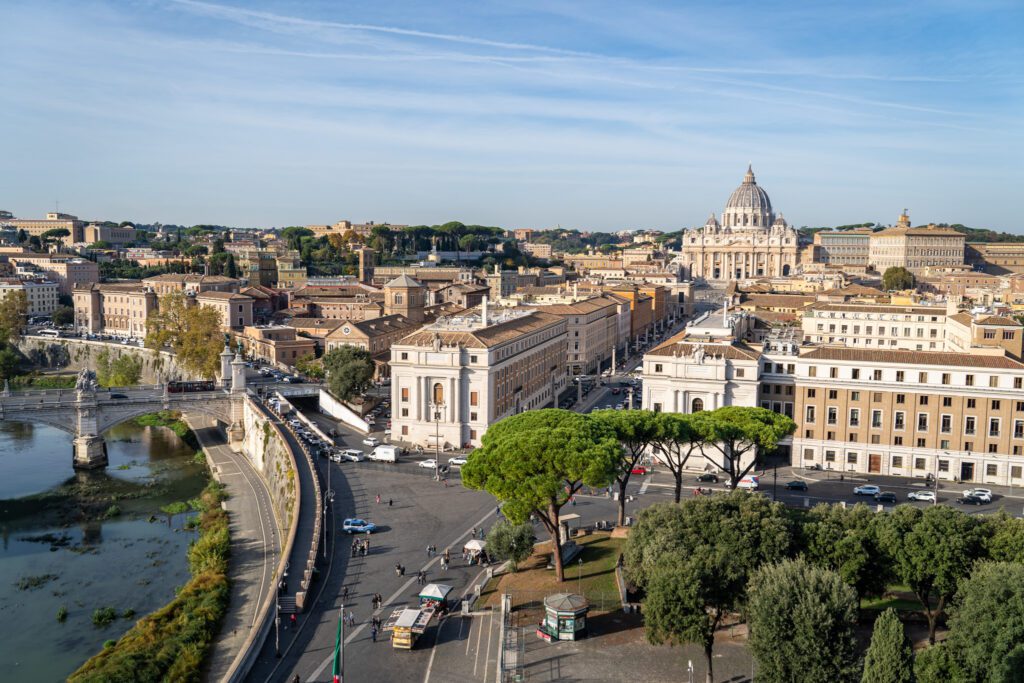
Buy your tickets in advance – especially in 2021 and beyond when attendance is limited. We didn’t and ended up waiting a bit because the timeslot at the beginning of the day was sold out.
The view from the other side of the bridge directly in front of Castel Sant’Angelo is also spectacular. If you decide not to go inside, definitely make sure to head to the other end of that bridge (and give a firm “no, grazie” to all of the people trying to sell you various things as you cross the bridge).
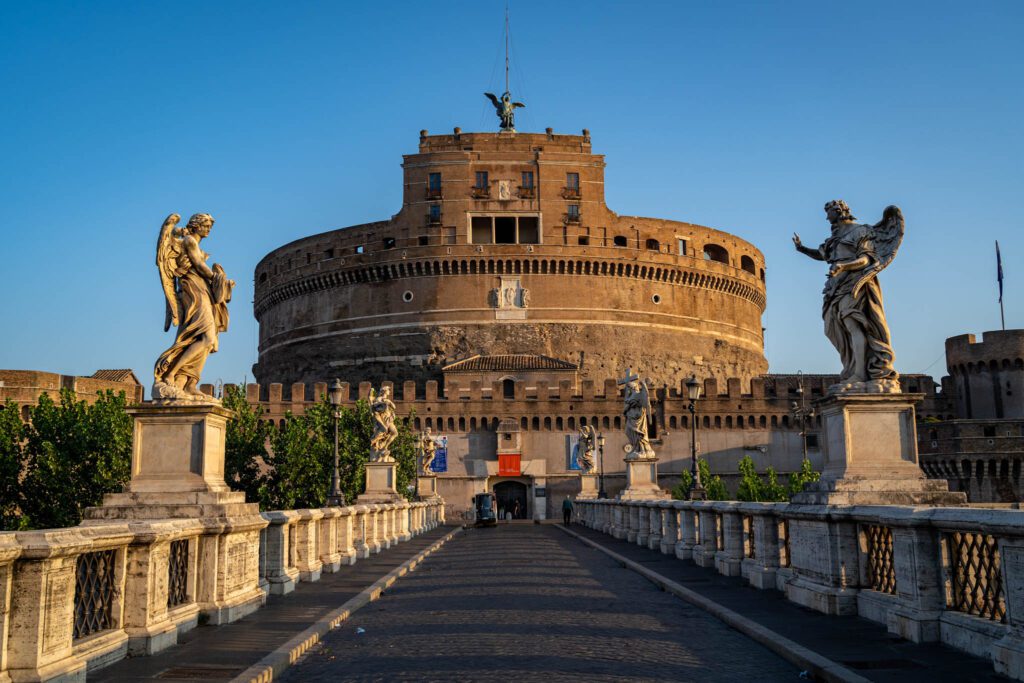
That photo spot is roughly here on Google Maps, and that picture was taken at 8:00 am, before the bulk of the tourists showed up.
Our Favorite Wine Bar in Rome
When in Rome, drink good wine. And our favorite wine in Rome came from Enoteca Il Piccolo , a charming little wine bar in the Centro Storico known for a rotating selection of natural wines from local producers.
Not only was the wine – specifically a pet-nat, lightly bubbly white wine – great, but the experience was unique too! For context, we speak minimal Italian – enough to get by, order food, and pay, but that’s about it.

I attempted to describe, in Italian, what kind of wine I wanted (Alysha went straight for the bubbles – CLASSIC!), and it was a little bit of a disaster. An older gentleman, who I believe was the owner, was helping me, and he took my attempt, turned around, left, and brought me back a great glass of wine that perfectly matched what I was hoping for. All with about ten words spoken between us.
They have a nice little terrace outside that is a great place for a glass of wine on a warm afternoon, and sell wine by the bottle if you want to get one to enjoy later.
Dinner in the Centro Storico
After you’ve enjoyed some Italian wine, it’s time to dive into the best part about Rome – the food! In the Centro Storico, you’ve got a lot of options, but they generally get worse the closer you get to popular places like Trevi Fountain and Campo de’ Fiori, so we’d recommend picking a place around a few blocks from those main spots if you can.
For what it’s worth, we really enjoyed Pantha Rei , a restaurant tucked away on an alley near the Pantheon with gluten free (and gluten-full) options. You can see the Pantheon from their outdoor terrace.
Roscioli Salumeria con Cucina is one of the most highly rated restaurants in Rome – make a reservation if you want to eat here! This is our top pick based on recommendations from locals (though, for gluten reasons, we didn’t eat there ourselves) if you are able to get a table.
Post-dinner, get gelato at either Grom (our favorite gelato in Rome) or Frigidarium , probably the most famous gelato shop in the world.
Here’s a guide to eating in Rome that we really enjoyed, despite not being able to eat at 95% of the places she recommends (plus, if you’re truly a foodie, you should probably do one of her food / walking tours ).
Day 3: Self-Guided Centro Storico Walk + The Borghese Gallery
Today, pick yourself up out of bed as early as you can to make it to the Centro Storico before it’s flooded with tourists, then spend a leisurely afternoon exploring the Villa Borghese and taking in the most popular art museum in Rome – the Borghese Gallery.
Cap it off with a foodie experience – either a cooking class or a food walking tour – to dive deep into the food culture of Rome and try some amazing bites from local spots you probably wouldn’t discover on your own.
An Early Morning Self-Guided Walk of the Centro Storico
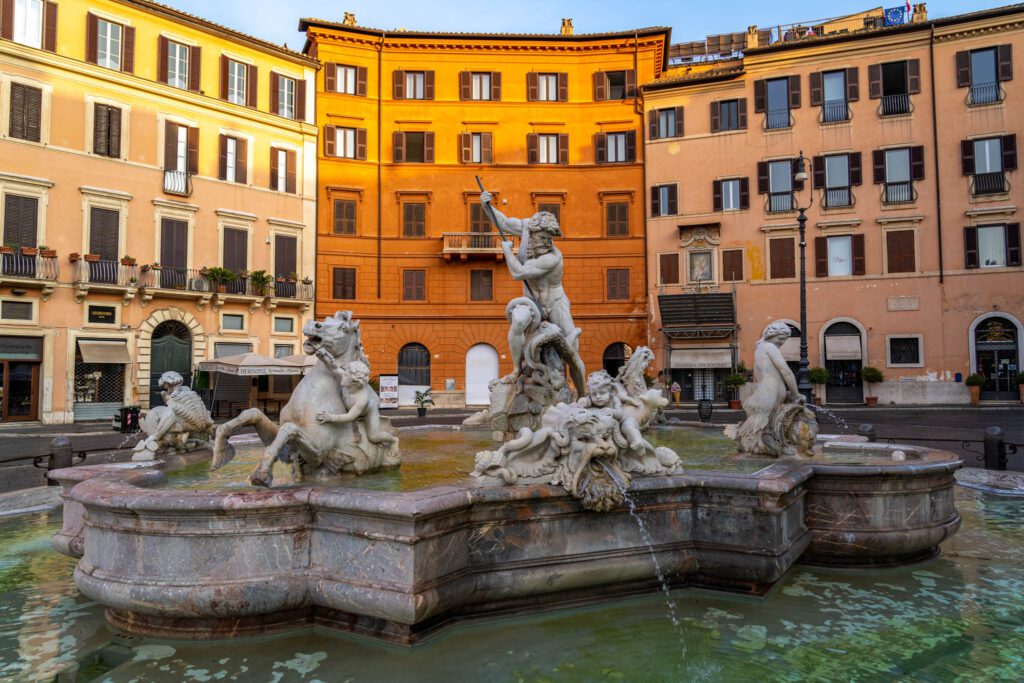
As we mentioned above, you’ll want to get out to start this walk before 9:00 am. At the very latest. Otherwise, this entire route is just packed wall-to-wall with people at basically any other time of day.
Follow a route roughly northeast from Campo de’ Fiori to the Spanish Steps, ending at Piazza del Popolo.
Here’s a handy map of this route , along with the stops mentioned.
- Piazza Navona – This vast square is built atop an ancient stadium (hence the shape). It’s a pandemonium affair, with trattorias and wine bars spilling onto the uneven cobblestones. The Fontana dei Quattro Fiumi (by Gian Lorenzo Bernini, no less) looks especially wonderful at night, as does the Fontana di Nettuno at the north end of the square.
- Campo de’ Fiori – A flower / produce market by day that also has some of the most tasteless souvenirs imaginable (don’t buy souvenirs here), this is a perfect spot to start your exploration of Rome’s city center.
- The Pantheon – Once a Roman temple, now a Catholic church, the Pantheon has a mighty imperial façade that was rebuilt in the 2 nd century AD. The great rotunda inside has a hole in the roof that lets in a solitary beam of sunlight, sometimes illuminating the tomb of the revered artist Raphael. There can be huge lines to get in later in the day, another reason to get up early!
- Trevi Fountain – They say you’ll return to Rome if you throw a coin in the Trevi Fountain. Good luck getting close enough to do that. The spot is always packed with crowds, even early in the morning, but it’s still an iconic sight that’s famed for appearing in films like La Dolce Vita . Whatever you do, don’t eat nearby, where you’ll pay 50% more for 100% worse food.
- Spanish Steps – 135 steps of pure elegance await here. They’re an icon of Rome and link the Borghese Gardens to the Piazza di Spagna, where a gorgeous Baroque fountain by Pietro Bernini decorates the flagstones.
- Piazza del Popolo – Your final stop, this is where you’ll find the city’s oldest obelisk – the narrow tower in the middle of the square, inspired by the Egyptians – and the former northern gate of the city of Rome. However, the square isn’t nearly that old – it was actually designed in the 19th Century. Head up to the Terrazza del Pincio ( here on Google Maps) for an incredible view of the square and St. Peter’s Basilica.
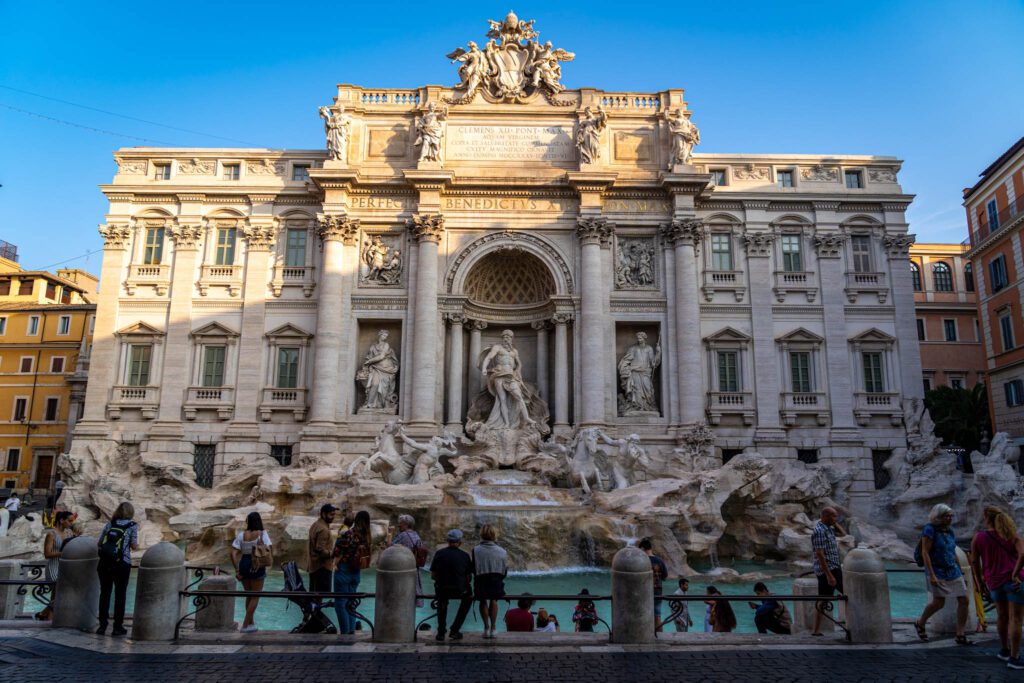
The Borghese Gallery and Gardens
Spend the afternoon exploring the best green space in the city – the Villa Borghese – and experiencing the only art museum (unless you count the Vatican Museums, I suppose) on this Rome itinerary, the Borghese Gallery.
Tickets for the Borghese Gallery are notoriously hard to get because of the extreme limits on people allowed inside at a given time, so book your visit as early as possible. Only 360 people are permitted into this exclusive art gallery every day.

We recommend you pre-book tickets as soon as humanly possible so that you have a chance to experience what we think is the most interesting museum in Rome (sorry, Vatican). You can do so here .
Alternatively, if you’re interested in taking a deeper dive, grab a spot on the excellent Borghese Gallery Tour with Take Walks . It might seem expensive, but you’ll get to experience masterpieces, most notably by the swashbuckling painter Caravaggio (his spine-tingling David with the Head of Goliath is housed within), with all the context and details you’ll want to have to truly appreciate what you’re looking at.
We always do tours of art museums after some great experiences at the Prado Museum in Madrid and the Uffizi Gallery in Florence , and highly recommend it if you’re, like us, not really an art gallery kind of person.
The stories behind the artists and paintings that an expert brings to the table really give you a deeper, richer experience, and help you focus on the important things in a huge museum full of amazing art.
The Villa Borghese is the epicenter of one of Rome’s most lovely parks. If you’re feeling lazy, grab a seat here under the trees and just watch the world go by. Don’t miss the Temple of Asclepius and the lake , which was our favorite part.
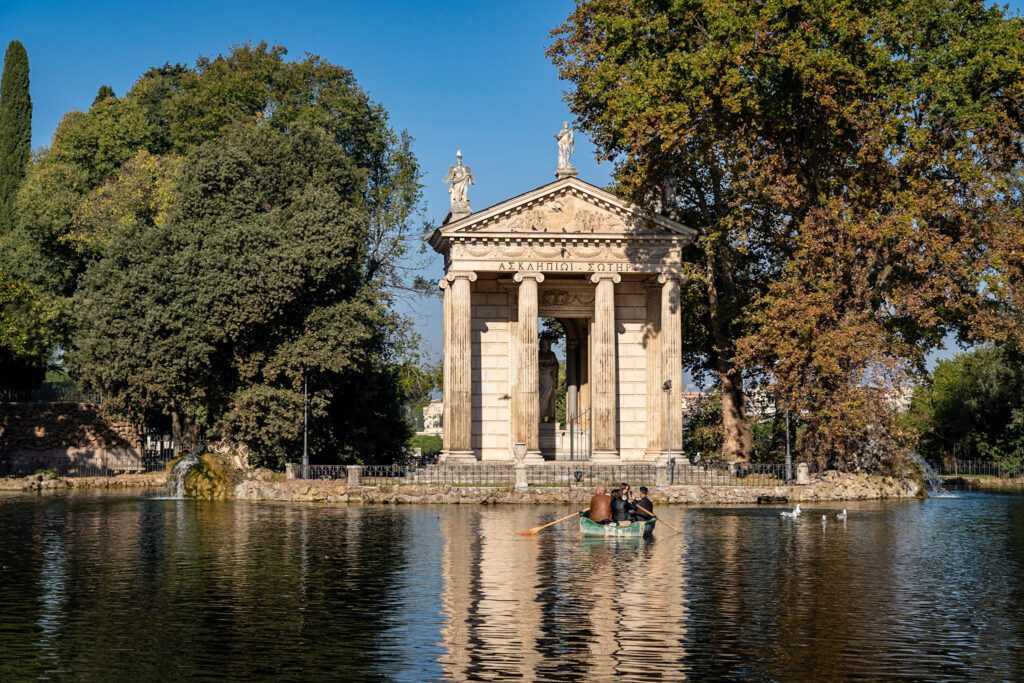
Choose Your Own Foodie Adventure
Diving into the food culture in places we’re visiting is one of our favorite aspects of traveling, and we try to include a food tour, cooking class, or market tour in most places we visit.
Unfortunately, the reality is that because Matt has Celiac Disease and can’t have even a speck of gluten without being sick for days, a food tour or cooking class wasn’t in the cards for us.
HOWEVER. That does NOT mean it shouldn’t be for you! We’d highly recommend it because it gives you a local’s perspective on the city’s food scene – what and where to eat and drink – and you get to connect with fellow travelers and try some amazing food.
Here are some options for you, split between food tours and cooking classes. Our bias is to do a cooking class, because we LOVE to cook, but we also enjoy a good food tour.
Option 1: Learn to Cook Italian Food with a Cooking Class
We’ve done all sorts of cooking classes around the world (read about our cooking class in Mexico City here), and while the gluten-filled nature of Italian food made it nearly impossible to do one in Rome, that doesn’t mean you shouldn’t.
Here are four cooking classes that would definitely be on our list if, you know, Matt could eat gluten.
- Handmade Pasta Class at the Pantheon : You’ll get a brief overview of Roman cuisine before diving in, where you’ll learn how to make two traditional kinds of pasta, along with multiple sauces. And, of course, you get to eat it. Vegetarians welcome.
- Handmade Pasta & Roman Sauces with Riccardo : We love experiences that take us to real people’s homes, in neighborhoods where most tourists don’t make it to. This is that. Join Riccardo – who was born and raised in Rome – in his family home where you’ll make handmade pasta, classic sauces like carbonara and cacio e pepe (our two favorites), and get to connect with the food culture in Rome in a really special way. Plus, wine, obviously, because this is Italy. Vegetarians welcome.
- Handmade Pasta with Grandma : Every culture has the phenomenon of “grandma cooks best,” with classic family recipes passed down from nonna to nonna, and unsurprisingly Italy is no different. You’ll make ravioli, fettuccine and farfalle – all from scratch – in their family home. Note that this tour is a ways outside of Rome (you meet here ) so you’ll need to find your way there and back on the train. Vegetarians welcome.
- Pasta-Making Class – Cook, Dine & Drink Wine With A Local Chef : Hosted by Walks of Italy, which we’ve already mentioned is one of our favorite tour companies in Italy, you’ll get a full rundown of handmade pasta, along with aperitivi and prosecco beforehand, and gelato for dessert. The class takes place in Trastevere. Vegetarians welcome.
Option 2: Dive into Rome’s Food Culture with a Food Tour
Here are some food tours that caught our eye though, sadly, we also skipped these because of the whole gluten and cross-contact issue.
- Hidden Rome Food Tour in Trastevere with Dinner and Wine : Explore Trastevere – our favorite neighborhood in Rome – through the eyes of a local foodie. You’ll simultaneously taste amazing food from places that you wouldn’t have discovered on your own, and also get the background and context for how that food came to be a staple in Rome. Plus, wine and limoncello along the way! This tour combines the history and cultural aspects with great food, which is what we usually look for in a tour.
- Twilight Local Food and Hidden Places : A local born and raised, Selene and her team will take you on a tour-de-Rome’s best food. Along the way, you’ll learn about the history and culture of Rome. Followed by pizza al taglio and carbonara, among other delectable tastings. This tour covers the Centro Storico, mostly.
- The Roman Food Tour in Trastevere : This tour, which covers Prati, the neighborhood to the north of the Vatican, includes a tasting of meats and cheeses and the best pizza al taglio in Rome (which we already featured above in the Vatican section…).
- Taste the Best of Rome (Evening Tour) : 25 tastings over four hours – so you’ll want to show up hungry! You’ll meander through Prati, stopping at five locally owned spots to try a variety of delicacies from truffles, to meats and cheeses, and more.
Day 4: Exploring Two of Rome’s Best Neighborhoods
On your last day in Rome, spend the day exploring two of Rome’s most interesting neighborhoods – the ever-popular Trastevere, full of bohemian charm with cobblestone streets and ivy-adorned buildings, and grittier Testaccio, which we like because it feels like real people actually live there (and the food scene is great, too).
A Morning Walk Above Trastevere

We think that Trastevere is best in the afternoon and evening, when the activity spills out into the cobblestone streets and charming piazzas.
However, there is a great market at Piazza di S. Cosimato ( here on Google Maps) where you can find fresh produce, meats, cheeses, and other products perfect for people who have a place with a kitchen and are looking to do some cooking.

The real reason to head to Trastevere in the morning is to tackle one of our favorite walks in Rome, which we sort of accidentally discovered on one of our last days in Rome on our latest trip.
The walk takes you up the hill behind Trastevere to Belvedere del Gianicolo – where you’ll find a great view over the city – and then back down the other side.
Along the way, there are some really good explanatory panels that describe the historical importance of this area during Italy’s struggle for independence in the mid-19th Century.
Giuseppe Garibaldi, an Italian general during the period immediately before the unification of Italy, is considered to be one of the most important figures in modern Italian history, and there was a battle on this hill above Trastevere that was key in establishing Italy’s independence.
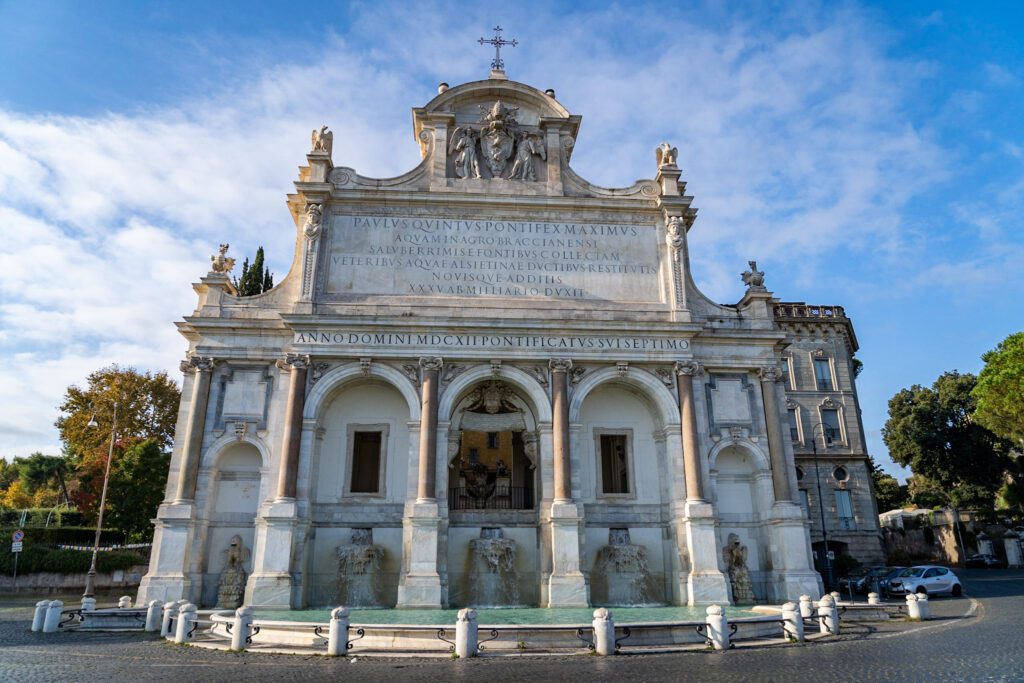
Though, it should be said that the Italian Republic he fought to establish was short-lived, and came back under a new name and brand a decade or so later, which is what has remained to this day.
There’s a statue of him in the middle of the plaza at the Belvedere del Gianicolo.
Here’s a map of the route , and the stops we’d recommend, which ends at Roma San Pietro , where you can catch the train out to Testaccio , the other neighborhood you’ll be exploring today.

A contrast from Trastevere and the rest of Rome’s historical center, the first thing we noticed about Testaccio is that it feels like real people live there.
A neighborhood that, 20 years ago (even less, really) was full of warehouses is today one of the best neighborhoods for foodies in Rome.
To get to Testaccio, grab the regional train from Roma San Pietro to Roma Ostiense , which should only take about 20 minutes and leaves you with a few minutes walking into the heart of the neighborhood.
It costs a couple of Euros per person – buy tickets from the machines at the station, and be sure to validate them before boarding the train .
The first thing to know about Testaccio is that it’s a great food neighborhood.
The food scene is centered around Mercato Testaccio , a big food market that’s roughly half stands selling produce, meat, and cheese, and half stands selling ready-to-eat food (plus some other stands selling random knick knacks and/or shoes). This is where you should have lunch.
It’s not overrun by tourists. It’s not wildly overpriced for what it is. It’s a place where locals go to shop and eat. If you’re interested in going deeper, look at this Testaccio Food Tour .
Here are some other places to check out in Testaccio:
- Tram Depot : A lovely outdoor spot to grab coffee and a pastry or two in the Italian sun. It’s a former tram, now refurbished and serving up good coffee to mostly locals (we were the only tourists there as far as we could tell).
- Non-Catholic Cemetery : When Rome was still a devout Catholic city, the remains of protestant foreigners weren’t permitted to be buried in the regular cemeteries alongside the Catholic citizens. Instead a few non-Catholic cemeteries sprung up to accommodate them and the one in Testaccio is one of the most famous. Remains of Percy Shelley and John Keates can be found buried here. There are also some great views of the Piramide di Caio Cestio, an Egyptian-style pyramid in the middle of Rome, commissioned by a rich Roman guy in the 1st Century B.C.E. that still stands today.
- Volpetti Salumeria : A popular market selling all manner of meats, cheeses, preserves, baked goods, and wine. It is open everyday and perfect for grabbing picnic food to enjoy while exploring Rome. Mingle with the locals as they go about their daily shopping to purchase the ingredients used in real Italian cooking.
An Evening in Trastevere
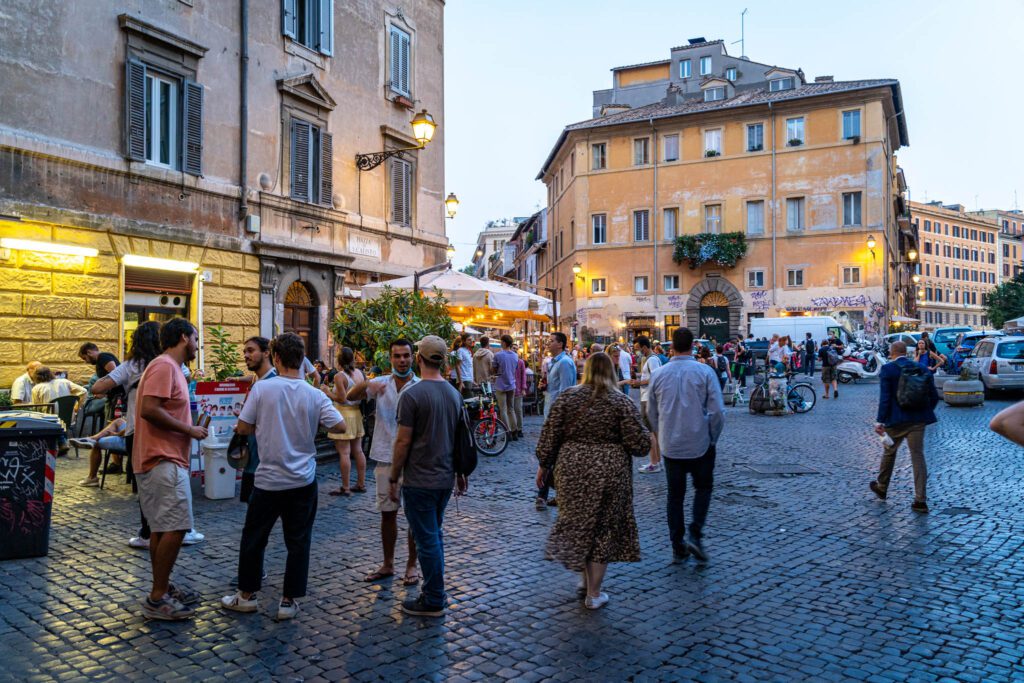
For your last evening in Rome, return to where you started the day – Trastevere – and explore the neighborhood at its best, which is undoubtedly when the sun starts to set over the Tiber.
We don’t have much of an agenda for you here – we think the best thing to do is to wander the streets and soak in the atmosphere. Did we mention that we LOVE Trastevere and we think it’s the coolest place to stay in Rome ? We did? Oh, okay, cool.
While we don’t have an agenda, we DO have some recommendations for you to start your exploration.
Don’t miss the Basilica Santa Maria , a beautiful church in the center of the neighborhood filled with gold mosaics by Cavallini. This is one of the prettiest and most underrated churches in Rome – though you wouldn’t really know it from the façade – so it’s a must see in this area.
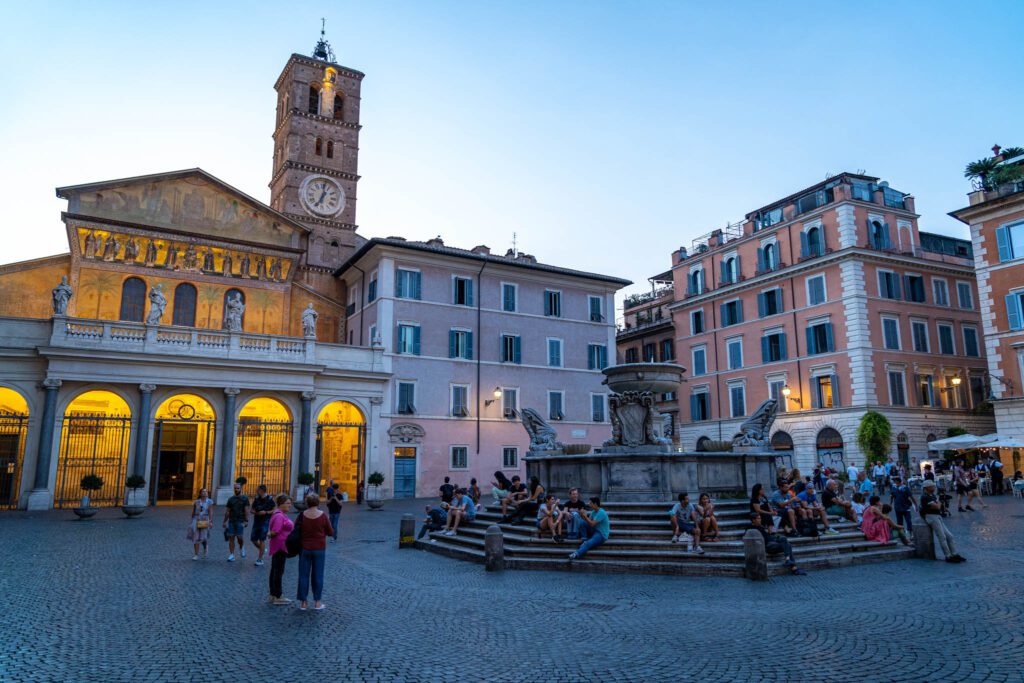
The square in front of it is a meeting place of sorts so is an amazing place to sit and people watch by the fountain.
The other thing you should know about Trastevere is that it has amazing nightlife . Trastevere is one of the liveliest neighborhoods in Rome packed with little bars and trattorias that stay open to the early hours.
There are no clubs here but plenty of small wine bars and craft beer to sip on until the first light of dawn. In summer, bars and restaurants spill out into the streets with tables and chairs outside to enjoy the long sunlight hours.
We like Mama Eat for dinner because they have great gluten free options, and Freni e Frizoni was recommended to us by both a friend and the host at our hotel, though we found it to be expensive and full of tourists (though the spritz was good and the location is great).
Les Vignerons is an amazing little wine and beer store run by a very passionate man (we had a small disagreement, exacerbated by my terrible Italian, about gluten free beer) that is perfect for picking up a bottle of wine, beer, or – and this was a surprise to us – cider! Highly recommend it if you’re looking for a place to buy wine or beer.

What to Do with Less Time in Rome: Planning a Shorter Rome Itinerary
If you have less time in Rome, you could either try and fit the same amount of things to do in a shorter time period, or you could be more selective about what to do and see, and save the others for a later trip.
We’d recommend the latter approach, which is generally how we approach travel. Pick a few sights, go deep on those, and save the rest for another visit.
For each of these itineraries, you can use the relevant sections in the detailed itinerary above to help you figure out the logistics around each of the sites mentioned.
What to Do with One Day in Rome
If you only have one day in Rome, I hope you’re ready for a whirlwind. If you come to Rome and it’s your first time, you’re going to want to see the Colosseum, the Vatican, and the Centro Storico.
Fitting all three of those sights in a single day is going to be exhausting, and it’s exactly the kind of travel that we don’t usually recommend because it’s just running from place to place without the time to truly experience the place you’re exploring.
But, if you only have one day in Rome, here’s how we would spend it.
First, do a morning tour of the Colosseum and Roman Forum .
Afterwards, have lunch in the Centro Storico (we’d recommend Antico Forno Roscioli ) and get gelato at either Fatamorgana or Grom . You can also try to fit in an authentic Italian espresso-at-the-counter experience at Tazza d’Oro too.
After lunch, do the walk from Campo de’ Fiori to the Spanish Steps, passing by Trevi Fountain and the Pantheon along the way.
In the late afternoon / early evening, do a tour of the Vatican at closing time , when it’s much more peaceful. End with dinner in Prati or Trastevere.
Another option would be to do a full day tour of Rome with Walks of Italy , which includes skip-the-line tours of both the Vatican and Colosseum.
What to Do with 2 Days in Rome
If you have two days in Rome, spend it on four main things: the Colosseum and Forum, the Vatican, a walk through the Centro Storico, and an evening in Trastevere.
Spend your first morning taking a guided tour of the Colosseum and Roman Forum , which will give you a richer experience and help you understand the context behind what you’re looking at. Have lunch in Monti before heading to the Centro Storico and walking from Campo de’ Fiori to the Spanish Steps, ending at Piazza del Popolo. Head back the way you came and get some
On your second day, do an early morning tour of the Vatican , head up to admire the view from the top of Castel Sant’Angelo, then head to Trastevere for aperitivo, dinner, and drinks.
What to Do with 3 Days in Rome
With 3 Days in Rome, follow the full itinerary above as written with one change. Cut day four, and spend the evening of day one in Trastevere instead.
More Time? Here are Some Additional Things to Add
If you have more than four days in Rome, there’s still plenty to do and see in the Eternal City. We spent 10 full days in Rome on our latest trip, and we were still finding new things to do and see on the last day (and we didn’t even do the Vatican or Borghese Gallery since we’d already done them before).
One thing we would NOT recommend is a day trip to Pompeii. It is just way too far to go in a day – you’ll need to travel about six hours when it’s all said and done. You need at least 1-2 days.
The Catacombs : Take a tour of the Capuchin Crypts to get into the dark history that lies under Rome’s streets.
A Day Trip to Tivoli : Every major European city seems to have a palace somewhere nearby, built by someone rich at some time in history. For Rome, that’s Tivoli, built by Emperor Hadrian. It’s probably the best day trip from Rome. Here’s a guided tour to get there and back in about half a day.
Pasta / Wine in Frascati : Get out of the city for an evening and head out to nearby Frascati, a well-known wine region in Lazio, for a cooking class / wine tasting extravaganza .
Wine tasting near Rome : One thing we loved about our trip to Italy is trying alllll the different Italian grape varietals! At home, we really get only a handful of grapes. In Italy, each region has their own unique grapes, and it’s fun to try them all. For Rome, Frascati is the place to go for wine tasting, and makes a fantastic day trip. The best way to do it without a car is a guided tour – here’s a tour that gets stellar reviews.
The Best Time to Visit Rome
There’s no hard and fast rule about the best time to visit Rome. The Italian capital is blessed with four distinct seasons.
Our overall pick would be the fall, but each quarter of the year offers its own unique delights.
- Summer – High season in Italy. Rome is super busy and very hot. Hotel prices skyrocket and there are long lines for many of the main attractions. The bonus is that you get to see the city buzzing with life and the weather is usually sun, sun, and just a little extra sun for good measure.
- Fall – Our favorite time in Rome. Seriously, we don’t think you can beat this city in September and October. There’s just something so lovely about the changing color of the cork oaks along the Tiber River and the balmy evenings. The only downside to autumn is that there’s the chance of some rainfall.
- Winter – Rome takes on a brooding, mysterious air in the winter. There can sometimes be freak snow storms, and we’ve seen frozen fountains on Piazza Navona in the past. Hotel rates tend to be cheaper in winter and there’s way fewer people crowding the main attractions. You’ll need the thermals and a coat though!
- Spring – Like fall, spring is downright stunning in Rome. There can be quite a bit of rainfall, but that’s balanced out by the flower blooms in parks like Villa Borghese and Doria Pamphili. May is another sweet spot for crowds because the summer rush hasn’t started quite yet.
Getting to Rome
Rome is one of Europe’s major capitals, which means it’s really well connected to other spots around the world by both air, road, and rail. Getting in shouldn’t be hard, no matter if you’re starting in New York City or London.
Flying to Rome
Rome has two airports: the Leonardo da Vinci International Airport (FCO) in Fiumicino and the Rome Ciampino Giovan Battista Pastine Airport (CIA) in Ciampino.
The first is the capital’s main international hub. That’s where you’ll touchdown from long-haul flights from the US, but also on cross-Europe flights with premium carriers like British Airways or Lufthansa.
Ciampino is primarily an arrival point for low-cost airlines like Ryanair and EasyJet, which are worth knowing about if your trip to Rome is part of a continent-wide adventure.
Getting into the city from both airports is a cinch:
- From Fiumicino Airport (the Leonardo da Vinci International Airport) : Take the train. It’s pricier than the bus at around $18 each way, but far faster (30 minutes from A to B) and won’t slow down when traffic gets bad – and it can get really bad in Rome! The train is called the Leonardo Express . It leaves from the station within the airport (follow the train signs) and arrives at Termini Station.
- From Ciampino (Rome Ciampino Giovan Battista Pastine Airport) : Sadly, there’s no direct train route from the airport in Ciampino to the center of Rome. The buses are pretty reliable, though. Take the service with either Terravision or SITBus. They cost up to $9.50 per person, each way, and take 50 minutes to arrive at Termini Station in the center.
Don’t be tempted to use Uber to get to your hotel from the airport. Rome is a taxi culture. Only the deluxe Uber Black cabs are offered on the app. A taxi from either airport to the center should cost around $50.
Arriving by Train
Rome is the hub of a highly efficient Italian railway network that can take you south all the way to Sicily via the pizza mecca of Naples, and north to Vienna and Munich on high-speed and overnight trains that go through the Alps.
There are also many shorter, slower trains – known in Italy as Regionale trains – that connect the capital with surrounding towns in regions like Lazio, Tuscany, and Umbria (all of which are worth exploring if you have more time in Rome).
These days, virtually ALL trains to Rome come into the huge Termini Station . We’ve always loved arriving there. It’s a feast for the senses. Everywhere you look there’s something going on, from business travelers clinking espressos to huge locomotives purring to a stop.
Termini Station is also a convenient arrival spot. It’s got a direct link to the Rome Metro network, and there’s a major bus interchange right out front.
It might be worth adding a warning : The area immediately around Termini isn’t the most welcoming in the city. It can feel a tad rough and gritty. Keep your wits about you if you’re arriving late there and don’t let it put you off the town right away!
Getting Around Rome
Rome was founded way back in 750 BC. In the 2,700+ years since then it’s been expanded and altered and built on more than most cities around the world. So, it should hardly come as a surprise that it’s not the easiest town to navigate.
The streets can be narrow and winding, particularly in the Centro Storico (the medieval core of Rome). There are even roadways that have to work around ancient monuments – we remember waiting 30 minutes once to pass under an arch in an ancient aqueduct!
The upside? Walking might just be your best bet.
Rome isn’t small but it’s not massive a la London or Paris. Many of the main areas you’ll want to see as a first-time visitor on a 4 day trip to Rome are all linked by paths along the Tiber River. What’s more, doing Rome by foot is a joy in its own right.
You just never know when you’ll stumble upon an imperial arch built by one of Rome’s famous emperors, or an inviting little vinoteca beneath the stone pines.
The Rome Metro
The ever-expanding Rome Metro currently has three lines. They all intersect at Termini Station. Really, the Metro is for commuters who want to reach the suburbs of Rome, because the main lines extend very far to the east and the north of the town.
That said, there are a few stops near the major attractions – Circo Massimo, Repubblica, Spanga, Colosseo – that you might make use of.
The bus network in Rome is very extensive. It covers everywhere the Rome Metro doesn’t and even doubles up to offer alternative routes to popular spots like the Colosseum and Vatican City.
At last count, there were 338 individual bus lines running throughout the Italian capital. The main interchange is just out the front of Termini Station, but you can catch buses from anywhere along the routes they run. Look for the map of where you can go at the individual stops.
Always remember to validate your ticket at the crunching machines on the buses – this is a common mistake among first-time travelers to Rome and often ends in a fine!
Rome’s above-ground trams connect the major suburbs to the east and west. For that reason, they might not be of such great use to visitors looking to explore the heritage-rich heart of the capital (where the main sights are).
However, there are some tram services in Rome that can be handy, like the one from Trastevere to Argentina (just south of the Pantheon) or the Colosseum, for example.
Tickets for Public Transportation
All the tickets for all the different types of public transportation in the Eternal City are linked. Buy one and you can travel on trams, buses, and metros to your heart’s content. There are a variety of fare options:
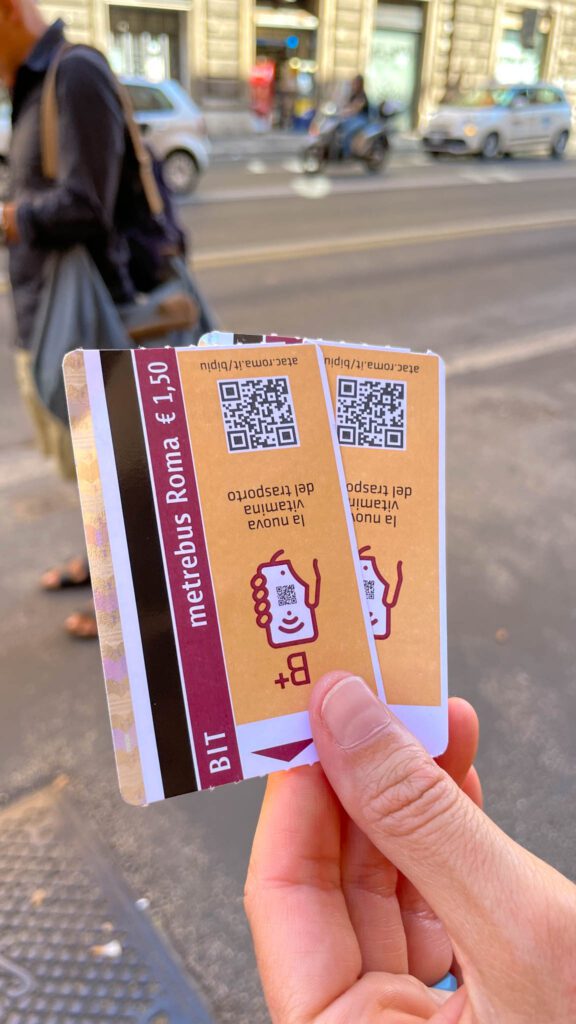
- 100-minute tickets (€1.50/$1.80) – Valid for any public transportation in Rome for 100 minutes with unlimited transfers.
- 24-hour ticket (€7.00/$8.35) – Valid for any public transportation in Rome for 24 hours after the moment you validate.
- 48-hour ticket (€12.50/$15) – Two days of unlimited travel on any public transportation from the moment of validation.
- 72-hour ticket (€18/$21.50) – Three days of unlimited travel on any public transportation in Rome from the moment of validation.
All tickets can be bought at the kiosks by the stations (there are lots around Termini Station) or from machines on the Metro platforms. Make sure you validate tickets at the punch stations before use!
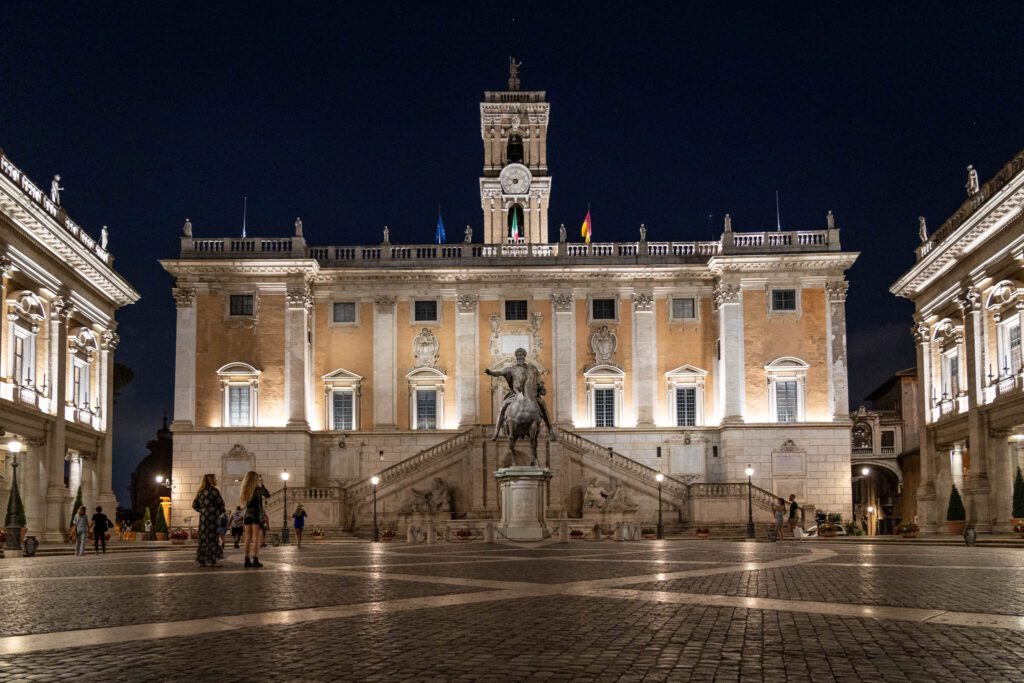
Matt is the founder and main writer behind Wheatless Wanderlust, which he started back in 2018 as a way to share his gluten free travel guides with his fellow Celiac travelers.
Since then, Matt and his wife Alysha have visited 18 national parks, spent three months in Europe and six weeks in Colombia, and have explored every corner of the Pacific Northwest, which is where Matt grew up.
He writes super detailed guides to the places they visit, bringing together personal experience and historical context to help YOU plan an amazing trip.
I just spent the last hour reading this blog and OMG, it is wonderfully written and EXACTLY what I was looking for. I am thinking of planning a trip to Rome next March and I am SOLD after reading this. You wrote in great detail, to the point where I could see myself there. I’m looking forward to planning this trip and I soooo appreciate this blog. Keep it up!!
What a great blog, my very first research for our (traveling with my husband) upcoming trip to Rome in about 20 days. We just returned from Milan after a 2 month trip to northern Europe in late summer. Now heading to Rome via Milan and this was the perfect information I was looking for. Though we are traveling in November, am sure Rome might not be as cold as Philly. Enjoyed reading this and will definitely keep this as our guide to our 4 day adventure. Looking forward to reading about your other destinations. I read about you both and it seems like I was reading about me n my husband (yes we do lot of research and of course the excel spread sheet, google mapping, travel folders etc). We are big travel enthusiasts and travel extensively, yes 3 months at times too, just too lazy to write up a beautiful blog like yours. Have done many countries and yet always feel there is till so much more to explore. So keep on traveling and sharing your experiences. Thank you once again.
Thanks for the kind words! We put a lot of time and effort into it, and we’re glad you found it both useful and entertaining (the balance we’re always trying to strike). We do love a good excel spreadsheet when we’re planning. Cheers!
Leave a Reply Cancel reply
Your email address will not be published. Required fields are marked *
This site uses Akismet to reduce spam. Learn how your comment data is processed .

5 Days In Rome, The Perfect Rome Itinerary
With its ethereal beauty and rich history, Rome is a magical mecca of ancient architecture and carbs.
Over the centuries, Rome has accumulated layers of beauty, history, and romance, eagerly awaiting the arrival of those who come to admire it. I simply can’t resist the city and have visited many times.
If you’re planning a trip to the Eternal City, my 5 days in Rome itinerary gives you a detailed, step-by-step guide for exploring the city in the most efficient way.
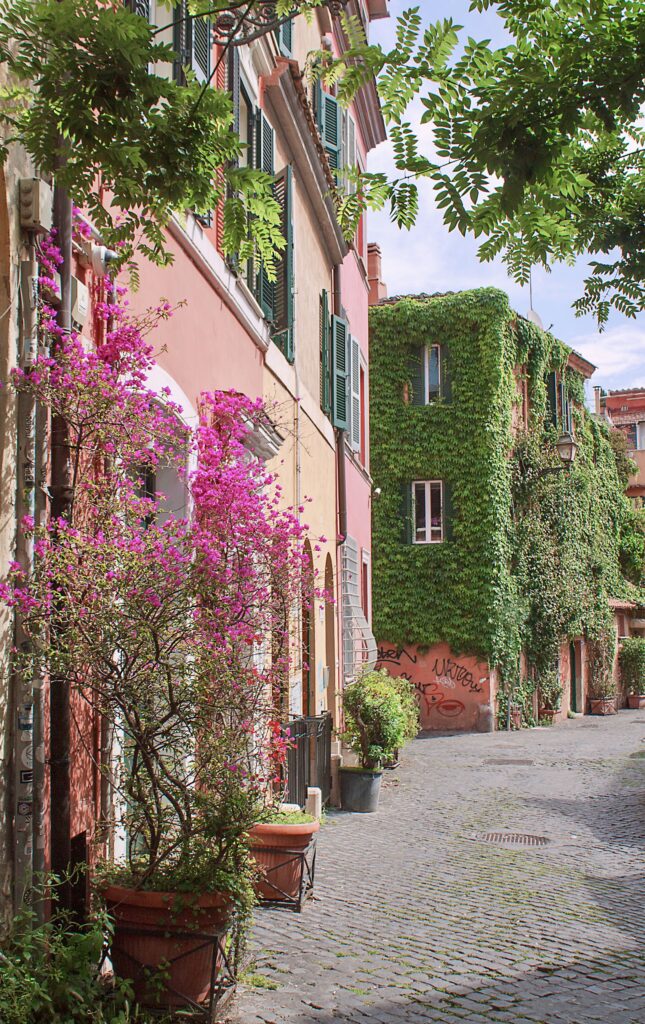
Snapshot Of 5 Days In Rome Itinerary
Here’s what you’ll see with 5 days in Rome.
- Day 1 : Imperial Rome, Monti, Capitoline Hill
- Day 2 : Centro Historico, Borghese Gallery
- Day 3 : Vatican City, Trastevere
- Day 4 : Rome Hidden Gems
- Day 5 : Day Trip to Tivoli or Orvieto
You may be tempted to rush through Rome in fewer than 5 days. I have myself.
But Rome has so much to offer and discover — mind blowing art, charming neighborhoods, perfect wine bars. It’s better to slowly savor the wealth of art and cuisine that’s before you.
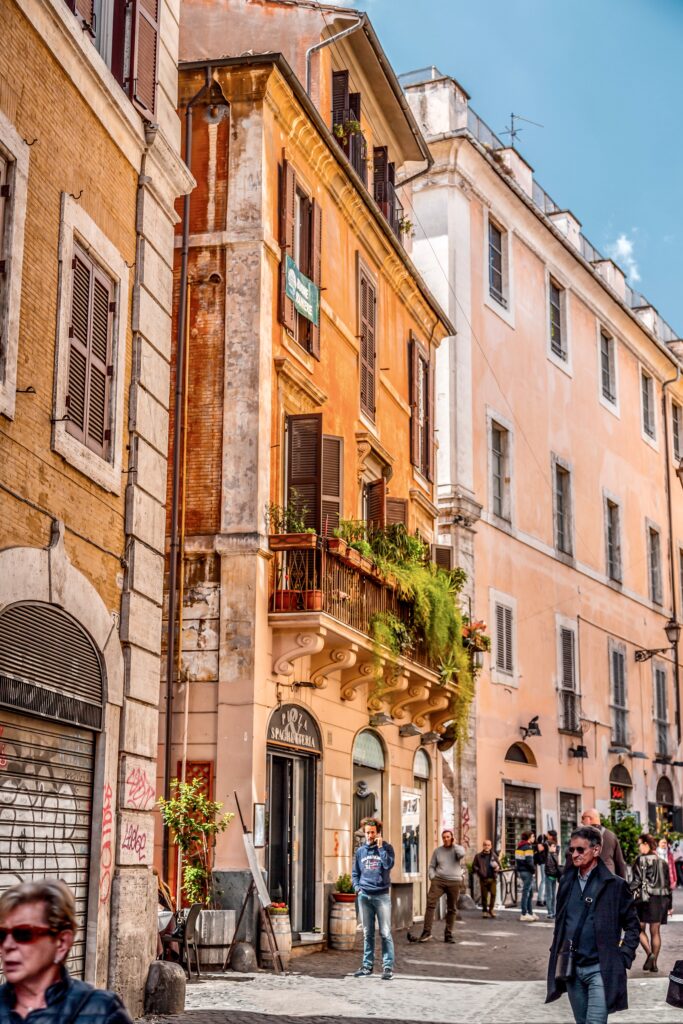
You’ll need a plan of attack and pre-purchased tickets if you want to hit all of Rome’s key cultural sites and ramble among the rubble properly.
So channel your badass gladiator and read on for the full scoop on the best things to see, do, eat, and gasp at in Rome.
As with all of my suggested itineraries, I recommend that you use this 5 days in Rome itinerary as a guide. You can tailor it to suit your individual interests, needs, and pace of travel.
5 Days In Rome Itinerary
Day 1 am: imperial ruins.
Begin your day by visiting the Imperial ruins tour, which includes the iconic Colosseum, Palatine Hill, and the Roman Forum.
I never tire of it. These sites can be visited with one trifecta ticket or ticket or on a guided tour and are Rome’s biggest draw. You can gaze in awe at the birthplace of Western civilization.
1. The Colosseum
The Colosseum , also known as the Flavian Amphitheatre, stands at a towering height of 600 feet and was officially inaugurated in 80 A.D. during an extravagant 10-day festival.
Over the centuries, it has become synonymous with spectacles involving gladiators, chariots, and the infamous “thumbs up or thumbs down” decree by the emperor. Within its walls, gladiators and wild animals engaged in deadly combat for the entertainment of the masses.
When visiting the Colosseum, make sure to explore the arena floor, where all the action unfolded, and take in the special boxes and podiums reserved for the emperor, vestal virgins, and senators.
Additionally, the top level of the Colosseum, which includes seating for the common people, was reopened in 2017. This vantage point offers breathtaking panoramic views and might just be the highlight of your visit.
I also recommend booking a guided tour that takes you to the hypogeum or the Colosseum Underground. You won’t see this on a standard tour.
You’ll be able to inspect animal cages, gladiator corridors, back stairs used by the slaves, trap doors, and the launching point for mock naval battles.
Tip : If you’re DIY-ing the Colosseum, you need to reserve your entry time online well in advance. This is true even if you have a skip-the-line Roma Pass.
2. Palatine Hill
Palatine Hill has enough raw beauty and buried mystery to restore the rosy tint of Rome to any jaundiced eye.
It’s a lovely setting, lush and green, with plenty of benches and a viewing terrace.
This is where the rich and famous of Imperial Rome lived. None of the structures are terribly intact. And you might find it hard to identify the ruins.
The most impressive one is the ruins of Domitian’s Palace, which included private and public areas.
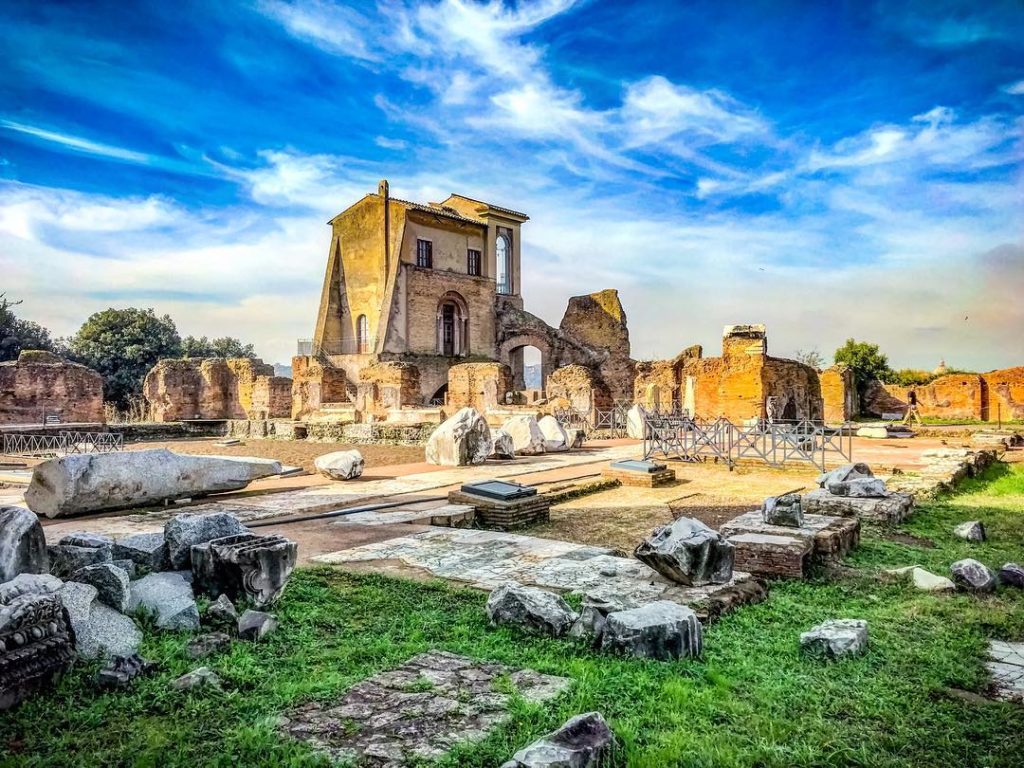
But there are three other noteworthy stops.
Domus Tiberiana is an ancient Roman palace, notable for its connection to the early emperors and its impressive architectural remains. It recently opened to the public for the first time in September 2023.
The House of Augustus is the former residence of Emperor Augustus, offering visitors a glimpse into the life of one of Rome’s most influential figures. Its red Pompeiian style frescos are some of the finest in Italy.
My last time in Rome, I took a this guided tour with a PhD and loved the sound and light show. It takes place three times a day.
Finally, the Palatine Museum, located near the Domus Tiberiana and House of Augustus, houses an extensive collection of archaeological artifacts and art from the Roman Republic through the Roman Empire.
3. The Roman Forum
After Palatine Hill, you move on to the Roman Forum , the very core of antiquity. This was where Romans shouted “Caesar has been murdered” and crowded to hear Mark Anthony’s eulogy.
I advise having a guided tour here. There’s not much signage. It will be difficult to divine what you’re looking at without a guide to decipher the lovely rubble and ruins.
The forum is a rectangular valley running from Arch of Titus to the Capitoline Hill. The main road is the Via Sacre.
The forum was the beating heart of Rome, the seat of power, and its central showpiece. It was a grandiose public district consisting of white temples, grand basilicas, and vibrant public spaces.
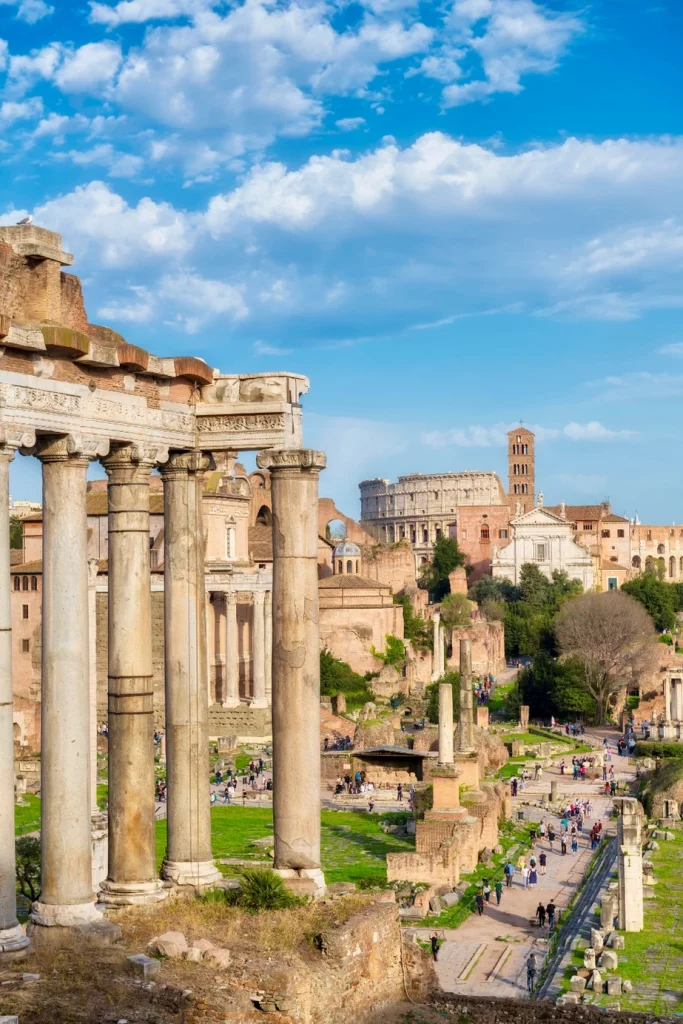
Stroll by the Arch of Titus, the Basilica of Constantine, the Temple and House of the Vestal Virgins (home to the sacred flame of Rome), and the 3 columns of the Temple of Castor and Pollux.
You’ll also find a small temple to Julius Caesar . Inside, is a mound of dirt covered with coins and flowers that marks his grave.
If you buy the SUPER ticket on Viato r , you can also visit the Church of Santa Maria Antiqua .
It’s renowned for its early Christian frescos that are nicknamed the “Sistine Chapel of the Middle Ages.” Two rooms feature a sound and light show that fills in the blanksand shows you what the frescos looked like in their day.
Day 1 PM: Monti and Capitoline Hill
After you’ve finished exploring the ruins, take a short 5-10 minute stroll to Rome’s neighboring Monti district.
Monti is the city’s trendiest area, teeming with one-of-a-kind shops and trendy dining spots. You can enjoy a delicious lunch at one of the restaurants along Via Panisperna or Via Urbana.
One absolute must-see attraction in Monti is the Santa Maria Maggiore Church, a personal favorite of mine even compared to St. Peter’s Basilica.
This historic church boasts an older pedigree, dating back to the 5th century A.D., and it mesmerizes visitors with its stunning mosaics adorning the triumphal arch and nave.
For more mosaics, including the stunning Chapel of San Zeno, you can pop into Santa Prassede , which is just around the corner.
Tip : Monti is also a great place to take a guided food tour or a guided wine tasting tour .
When you’re done in Monti, head over to the the Vittorio Emanuel II monument on Capitoline Hill, also known as the “typewriter” or “wedding cake” building. For views, hike up to the second floor.
For even better views, book a ticket for the elevator around the back up to the viewing terrace. It’s a fairly pricey, but I thought it was worth every penny.
I personally thought this view was better than the view from St. Peter’s Basilica because it was closer to the ancient Roman sites.
When you’re done swooning over views, head back down the stairs. Take a left at the bottom of the stairs and then another left.
A few 100 feet later, you’ll see Michelangelo’s stairway, rising to the Piazza del Campidoglio at the top of Capitoline Hill.
Take the stairs up. At the top is the wonderful Capitoline Museums , housed in two buildings connected by an underground passage. In high season, you’ll want to pre-book a skip the line ticket .
Inside, are some of Rome’s greatest treasures — the Equestrian Statue of Marcus Aurelius, the original She-Wolf of Rome that suckled Romulus and Remus, and other ancient statues.
After exiting the museum, head down the alleyway on the right side of the square under an arched building. That will take you to a viewpoint over the Roman Forum. This is the best view you’ll have of the forum.
You could also make a quick detour to the Church of Santa Maria d’Araceli. It’s an ancient brick church. The church is mostly known for its beautiful frescos by Pinturicchio, an early Renaissance artist.
When hunger calls after this hectic day, head to the atmospheric Jewish Ghetto neighborhood. It’s just a stone’s throw away, on the banks of the Tiber River.
On your way, visit Largo di Torre Argentina. These are the ruins of the Theater of Pompey, the very spot where Caesar was assassinated. They opened in 2021. But it was not until June 2023 that walkways were installed so you can see the ruins up close.
I just wandered around the evocative Jewish Ghetto. But you also book a guided walking tour of this historic neighborhoo d , if you want something more structured or are interested in the history.
Day 2 AM: Central Rome
Begin day 2 of your 5 days in Rome with a classic walk through Rome’s Centro Storico . Start at Campo de’ Fiori and end at the Spanish Steps, visiting the Trevi Fountain, Piazza Navona, and the Pantheon along the way.
You can follow my walk (linked above) on your own. Alternatively, you can also book a private walking tour of this beautiful part of Rome.
1. Campo de’ Fiori
Campo de’ Fiori is Rome’s colorful market square.
In the center is a statue of Giordano Bruno, a 16th century friar and philosopher who was imprisoned in Castle Sant’Angelo and burned at the stake for his scientific theories.
Here, you’ll find fresh produce and can pick up some souvenirs like olive oil, pasta, or limoncello. There are also a cluster of contemporary art galleries near the Campo.
2. Piazza Navona
Your next stop is the Piazza Navona , sometimes called the Square of Fountains. Piazza Navona is the very symbol of Rome.
This famous square is a long rectangle, dotted with beautiful fountains designed by Gianlorenzo Bernini and outdoor cafes. It dates back to the time of Domitian, who used it as a racetrack. Today’s buildings date from the 16th century.
Be sure to pop into the beautiful Church of Sant’Agnese designed by Borromini. Borromini was an Italian architect who helped launch Roman Baroque architecture.
Everyone goes to Piazza Navona and admires the striking concave facade. Most people don’t step inside the church. Do it, it’s free!
Pink and white marble covers the walls. The bright and simple interior is filled with Baroque statues. Beautiful frescos decorate the dome.
Tip : If you love ancient sculpture the Palazzo Altemps is a lovely museum at the northern end of the piazza.
3. Church of Sant’Agnese and St. Louis of the French
Just one block from Piazza Navona is the Church of St. Louis of the French. You can enter for free.
The highlight is the Contarelli Chapel, which holds three stunning Caravaggio paintings. If you’re an art lover, you can’t miss this spot!
4. Pantheon
Then you’re off to Rome’s most famous temple, the 2,000 year old Pantheon , set in a lively piazza. This is my favorite building in Rome.
The entrance boasts massive 40 foot single piece granite columns. The pediment proclaims that Marcus Agrippa, Augustus’ right hand man, built the Pantheon. In fact, it was built by Hadrian.
Inside is a magnificent dome with a giant oculus (or eye in the sky) that inspired the domes of St. Peter’s Basilica and the Duomo in Florence .
If it’s raining, water falls through the oculus and drains out the floor.
One of the greatest painters of the Renaissance, Raphael, is buried in the Pantheon. His tomb sports a sculpture by Lorenzo Lotti that Raphael himself commissioned.
>>> Click here to pre-book a ticket and avoid lines
Just one block away from the Pantheon, you should make a quick stop at the Basilica of Santa Maria Sopra Minerva . The plain facade belies the treasures inside.
The Minerva is a mini-museum, with frescos and sculptures by some of the greatest artists of the Renaissance and Baroque.
Tip : You can also book a guided tour of both the Pantheon and Sopra Minerva .
5. Piazza Colonna
Then, stroll to the Piazza Colonna. This square features the massive Column of Marcus Aurelius carved from Carrara marble.
Reliefs wrap around the column telling stories of Marcus Aurelius’ war exploits.
The exploits were exaggerated because Rome had already begun losing skirmishes with the barbarians.
READ : Guide to the Gorgeous Palazzo Colonna
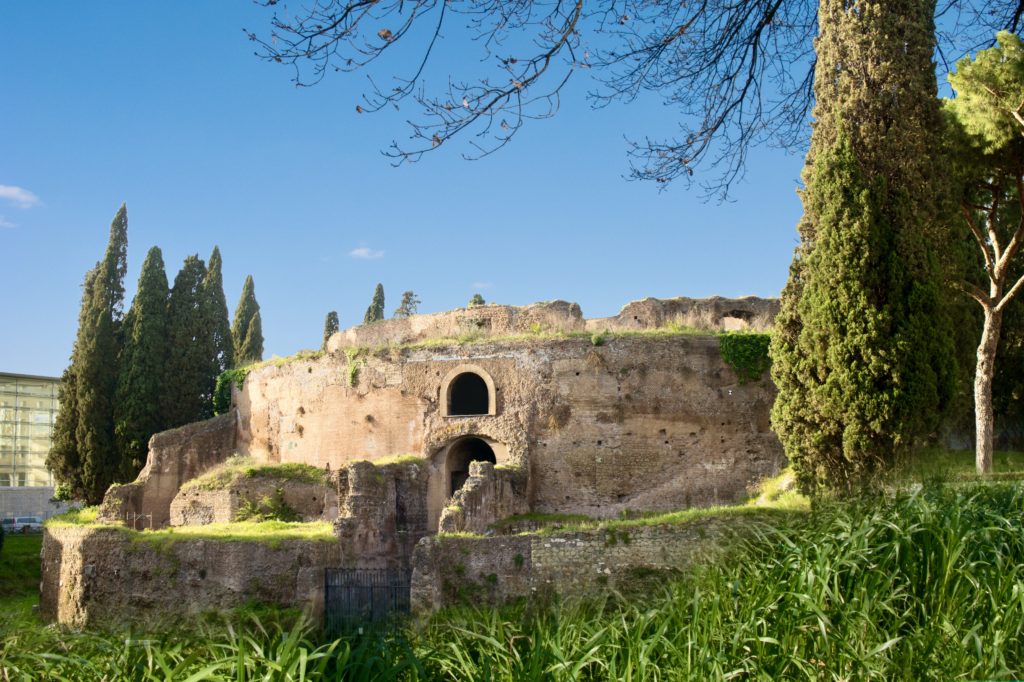
6. Mausoleum of Augustus or Ara Pacis
Fans of the first Roman emperor will want to visit the Mausoleum of Augustus and/or the Ara Pacis Museum . They’re right next door to each other.
Dating from 28 B.C., the mausoleum is Augustus’ monumental family tomb, built in his 30s, shortly after he became emperor. Talk about your own sense of destiny!
Everyone in the Julio-Claudian dynasty is buried there — Augustus, Livia, Octavia, Agrippa, Germanicus, Tiberius, Caligula, etc. Though Augustus did ban family members he considered disloyal, like his own daughter Julia.
The Ara Pacis, or Altar of Peace, is one of Ancient Rome’s most significant monuments. Built in the 1st century BC, this 2,000 year old altar symbolizes the peace and prosperity of Emperor Augustus’s reign.
It’s covered in gorgeous relief sculptures. They show Augustus’ family, processional scenes, mythological images, and a cornucopia of vegetal and floral motifs.
>>> Click here to pre-book a skip the line ticket
7. Trevi Fountain
Further on is the famous Trevi Fountain, an imposing Baroque monument designed by architect Nicola Salvi. The fountain was immortalized in Fellin’s La Dolce Vita .
The fountain is 85 feet high and 65 feet wide, making it Rome’s largest fountain. In the center is the figure “Ocean.” Water pours from 24 spouts.
If you’re superstitious, toss a coin over your shoulder to ensure your return to Rome. Over 3,000 euros are collected from the fountain daily and donated to charity.
If you didn’t lunch earlier, you have options. There’s a cute little hole in the wall restaurant nearby, Ristorante Sora Lucia, which serves up delicious gnocchi for locals.
Piccolo Buco is also a tiny and delicious pizzeria only one minute from the Trevi Fountain. And La Prosciutteria serves up killer porchetta sandwiches.
8. Spanish Steps
After lunch, head down Via Sistina to the Spanish Steps. It’ one of Rome’s iconic sites.
This grand staircase of 135 steps connects the Piazza di Spagna at its base to the Trinità dei Monti Church at the top.
Visitors and locals alike gather here to relax, people-watch, and take in the picturesque views of Rome, making it a popular spot for both tourists and Romans.
At the foot of the steps is another famous Bernini fountain, the Sinking Boat Fountain .
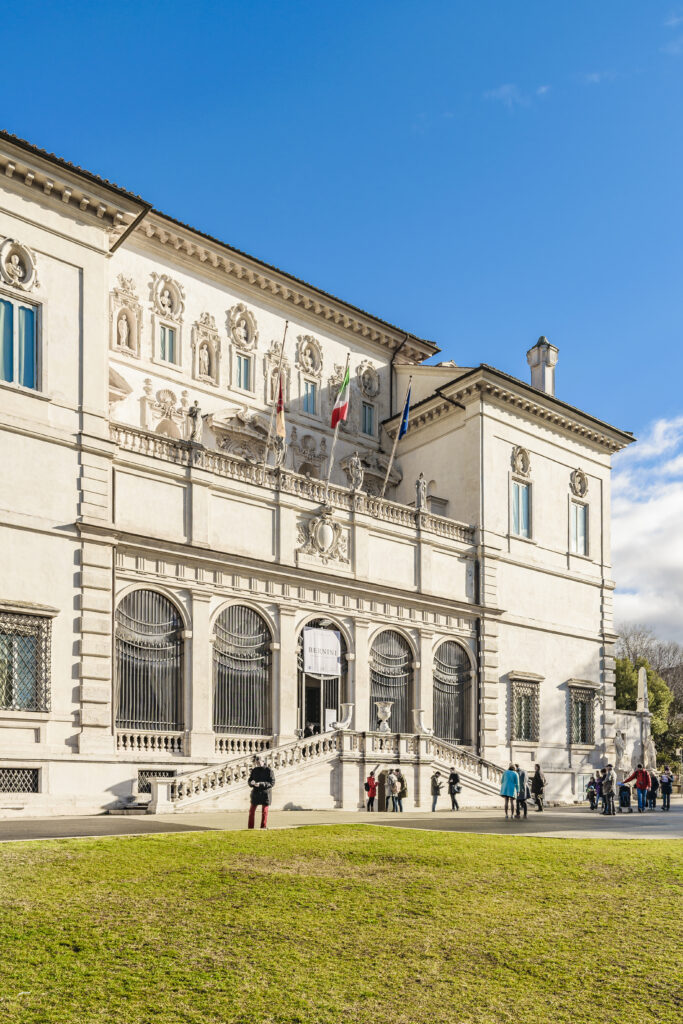
Day 2 PM: Borghese Gallery
After lunch, take in one of my favorite art museums in the world — the Borghese Gallery . You may think I’m exaggerating, but I’m not. Incredible masterpieces are set in a stunning villa filled with frescos and marble.
The villa was commissioned in 1613 by Cardinal Scipione Borghese to house his impressive collection of Roman, Renaissance, and Baroque art.
The cardinal was a fan of Bernini and helped him rise to fame. An ardent and obsessed collector, he acquired art work by unscrupulous means, once stealing a painting from a convent altar in the dead of night.
READ : Bernini Guide to Rome
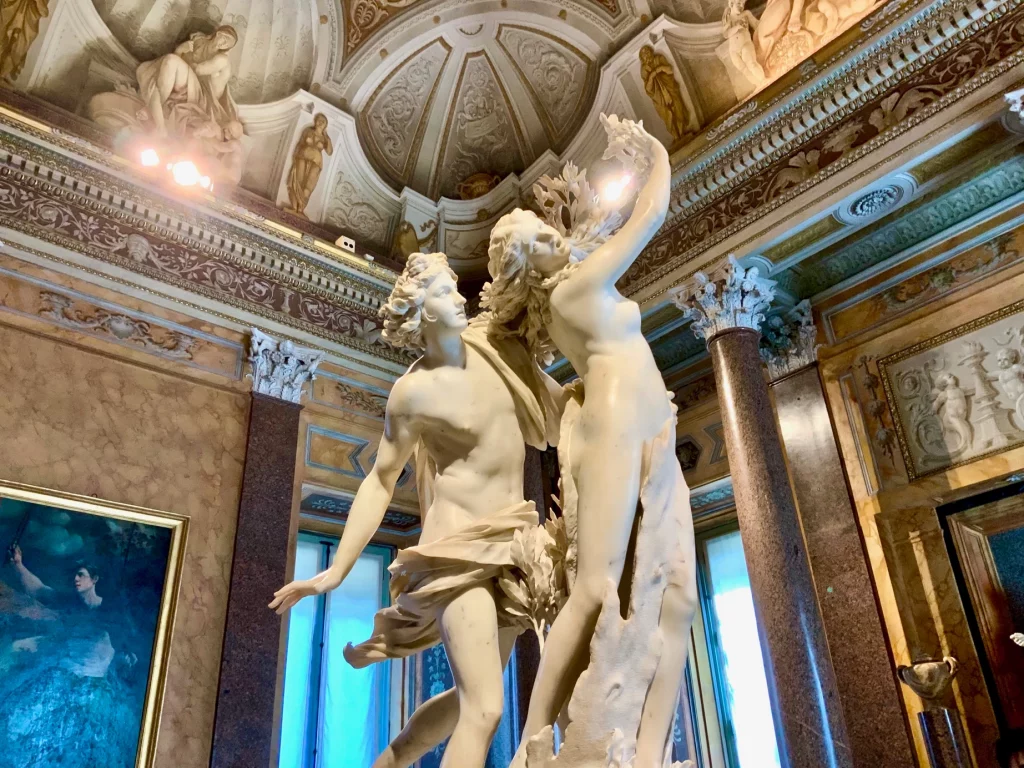
You’ve got to pre-book a ticket well in advance to visit the Borghese Gallery. Only a set number of people are allowed in every two hours. You can’t purchase a ticket at the museum itself.
Your visit will start in the Pinacoteca, or painting gallery, on the upper floor. But budget most of your time for the first floor.
Arrive early and only carry a very small purse or bag. Everything else must be checked, no exceptions. There are information placards in each room. But an audio guide will educate you on the must see highlights more easily.
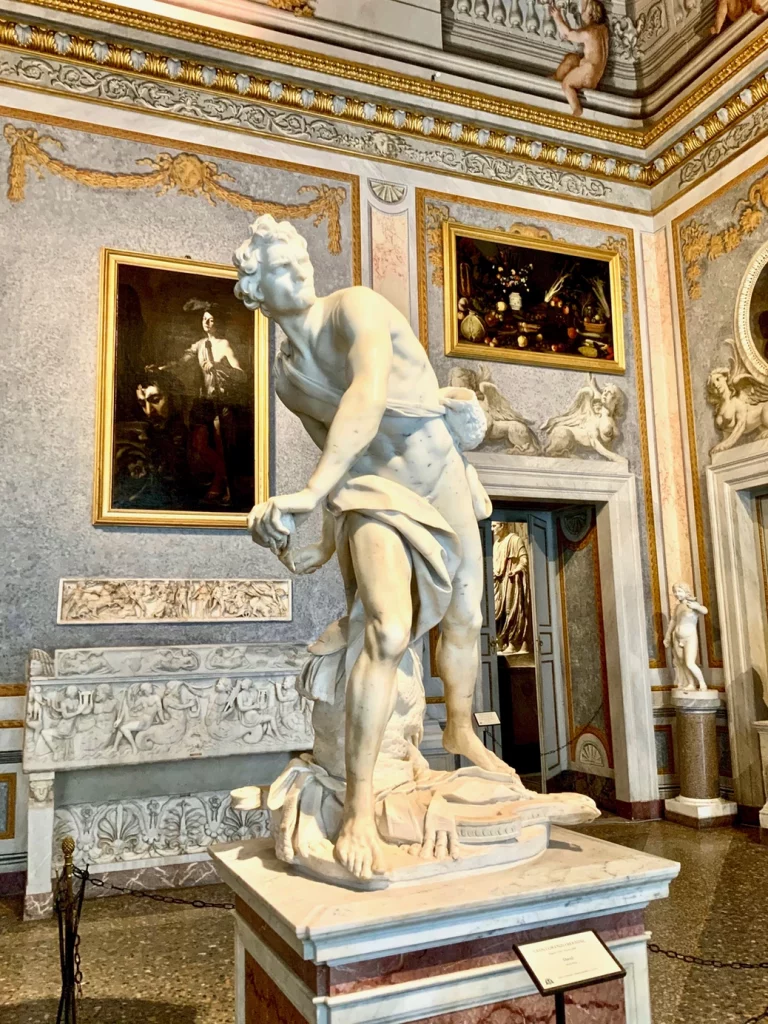
In the Pinacoteca, you’ll find some Bernini self portraits and smaller sculptures. You’ll also find two of Raphael’s most famous works — The Deposition and Young Woman with a Unicorn. Both paintings are currently undergoing diagnostics for conservation work.
The bottom floor is overflowing with perfectly arranged masterpieces. The sculptures by Bernini, who almost single handedly invented the Barqoue style, steal the show. The most beautiful ones are The Rape of Persephone , Apollo and Daphne , and David .
There’s also a stunning work by Antonio Canova, Pauline Borghese as Venus . And a room filled with Caravaggio’s art, including his famous David with the Head of Goliath .
Click here for to book a guided tour of this magnificent museum.
Piazza Popolo
When you’re done admiring the exquisite art, I recommend heading over to the west side of the Borghese Gardens, towards the Piazza del Popolo. The cobbled Renaissance square is home to Rome’s north gate and its largest obelisk.
Pop into the Basilica of Santa Maria del Popolo to see two beautiful Caravaggio paintings for free. Climb the stairs to the Pincio Terrace (directly above the piazza at the end of Via del Corso).
The view of the rooftops of Rome is quite beautiful, particularly at sunset.
There are some good restaurants near the Borghese Gallery, if you want to stay in the area for dinner. For gourmet food, try Oliver Glowig (Michelin-starred) or Sapori del Lord Byron. For a cozy informal setting, try Girarrosto Toscano.
Alternatively, you can take a food tour in Rome at night and find out what and where the locals eat. There are several options for all interests (I’ve done them all and feasted!’
- a food tour of the trendy Testaccio district
- a food tour in the off the beaten path Pratti district
- a food tour in the beautiful Trastevere district
- a food and wine tour in the historic center
Day 3 AM: Vatican City
Start off day 3 of your 5 days in Rome with a bang by visiting Vatican City , the spiritual and administrative center of the Roman Catholic Church.
Unless you arrive on a weekend. You don’t want to go on a weekend, ever. It’s too crowded. So if your time in Rome falls on a Saturday or Sunday, flip flop the days of my sample itinerary around and push the Vatican to a weekday.
The Vatican holds one of the world’s greatest art collections. It’s a treasure trove of cultural and religious artifacts.
Some of the most famous art works on the planet are there. If you’re an art or history lover, the Vatican is an absolute must see site in Rome.
You absolutely must pre-book skip the line tickets for the Vatican. Or else you’ll be stuck in line for hours unless it’s the dead of winter. You may also want to book a guided tour and there are many options to choose from .
Much of the work was collected by Pope Julius II, who left a staggering legacy. Julius rebuilt St. Peters Basilica.
He commissioned Michelangelo’s Sistine Chapel and the Vatican’s Raphael Rooms . In 1506, he founded the Vatican Museums.
The real highlight of the Vatican is the Sistine Chapel, adorned with Michelangelo frescos . Michelangelo spent 4 years toiling away on the 9 ceiling panels.
They depict scenes from Genesis and seem to open up the chapel to heaven. And he did it standing up, not laying down as legend holds.
In 1533, Pope Julius II summoned him back to Rome to paint The Last Judgment on the altar wall. This fresco is more monumental in style than Michelangelo’s ceiling frescos.
In the middle, Christ is excessively youthful and floats on clouds. He’s depicted more like Apollo than the suffering bearded savior one expects.
When you’re done admiring the Vatican treasures, head to St. Peter’s Basilica . It’s the most famous church in Christendom.
Designed by Bramante, Raphael, and Michelangelo, it’s a true Renaissance masterpiece. The dome of St. Peters, designed by Michelangelo, is the tallest in the world.
The basilica is the burial place of St. Peter and past popes, has Bernini’s famous Baldachine altar, a plethora of Bernini sculptures, and Michelangelo’s tragically beautiful Pieta .
St. Peter’s is free to enter. But you may have a long security line. If you’re on your own, pick up an audio guide inside. It will take you on an hour long tour.
For just € 6, you can climb up a narrow flight of stairs to inspect the dome at close range. There’s also an elevator for € 8.
From there, you’ll have a bird’s eye view of the nave below.
Continue higher to stand on the outside of the dome. This is where you have the iconic view of St. Peter’s Square and a panoramic view of Rome.
You can take a guided tour of St. Peters or a tour that includes the underground grottos .
When you’re done Vatican-ing, head to the nearby Castle Sant’Angelo .
The castle is a cylindrical beauty at the end of the Sant’Angelo Bridge. It was once Hadrian’s Masoleum. It then served as a fortress, castle, papal residence, and (now) museum.
The castle is the perfect reflection of Rome’s history. Though Castle Sant’ Angelo owes its name to a medieval legend, its history dates back to ancient Rome. Visiting the Castle Sant’Angelo is a walk through the entire history of Rome in one go.
Click here to pre-book a ticket.
It’s worth going inside if you’re a real history buff. The Terrace of the Angel on top serves up stunning views of St. Peters and the surrounding area.
From here, unless you want to burn off some pasta, I recommend taking a taxi to Rome’s atmospheric Trastevere neighborhood.
Day 3 PM: Trastevere
On day 3 of your 5 days in Rome itinerary, head to Trastevere. This beautiful and charming Rome neighborhood is a village within a city, with the laidback vibes of small town Italy.
Trastevere is worth lingering in. Its lovely cobbled and cafe-lined streets are vastly quieter than the cacophony of central Rome.
You may want to book a guided walking tour or even take a fun Segway tour to get oriented.
If you haven’t yet had lunch, grab a delicious panini at La Proscuitteria (there’s a branch in Trastevere as well).
After a look around Trastevere, head into Villa Farnesina . It’s an underrated small museum in a beautiful setting that’s a quiet oasis of in situ art and architecture.
The villa is only open weekdays until 2:00 pm. If you can get there at 1:00 pm, you’ll have an hour, which is all you need.
This sumptuously decorated villa was built in the early 1500s for one of Europe’s richest Renaissance men, Agostino Chigi. The villa has some magnificent mythological frescos by Renaissance painters Raphael, Peruzzi, and Sebastian del Piombo.
Then stroll to the lively Piazza di Santa Maria, which is the heart of Trastevere. Head into the Sant Maria Basilica, the oldest church dedicated to Mary in Rome.
The church itself dates from the 3rd century. But it’s outfitted with a 12th century Romanesque bell tower. Inside, in the apse, you can admire the beautiful 12th century mosaics.
Spend some time wandering the quaint alleys of Trastevere, admiring the golden and coral homes. Then, visit the Church of Santa Cecelia.
The exterior is a mishmash of architectural styles. But the interior is a luminous gold and cream combination.
It’s time for happy hour. Settle in for some wine at Enoteca Ferrara, which has a huge wine list. You can eat here too. I had a divine puttanesca.
If you want to move on in Trastevere, try Ombre Rosse .
Another restaurant I enjoyed is La Sora Lella on Isola Tiberna. It’s one of Rome’s oldest restaurants, serving up classic rustic food in a casual setting. You’ve got to make reservations for both places.
Today, take in some of Rome’s hidden gems.
San Clemente
In the morning start your day with a visit to the Basilica of San Clemente . It’s one of the most fascinating churches in the city.
San Clemente is microcosm of the architectural stratification that is a prime characteristic of Rome.
You enter a 12th century church, descend to a 4th century church below, and further down to 1st century spaces including a Mithraic temple. Along the way, you’ll see some beautiful mosaics and frescos.
Because this is such a historic site, you might consider booking a guided tour. There is signage, but you’ll get more out of the experience with a guide.
You can book a 1 hour small group tour or a a 2.5 hour private tour .
Domus Aurea
The ruins of Nero’s Golden House, Domus Aurea, are now open after years of excavation. Located on the Oppian Hill, you can only visit on Friday throughSunday with a hard hat. But Domus Aurea is worth the effort; it’s an exciting archaeological site.
Nero’s Golden House was once the grandest building on earth. Built by Emperor Nero between 64-68 AD, the sprawling property covered up to 300 acres.
The facade and walls were adorned with frescos, gold leaf, glass mosaics, pearls, and marble. In natural light, it had a golden hue.
But little of this wealth survived Nero’s rule. As Nero’s extravagance and tyranny spun out of control, rivals condemned both his reign and his emblematic palace.
For a decade after his death, the palace was looted, destroyed, and filled in with brick. But the vivid frescos by the artist Famulus couldn’t be pried off.
At the end of the 15th century, the Domus Aurea was discovered by accident when a young man fell into a crevice. To his surprise, he found himself surrounded by paintings.
At first, the palace ruins were thought to be caves or grottos. Artists like Michelangelo and Raphael flocked to see the ancient frescos.
In the 18th century, proper excavation of the Golden House began. The crown jewel is the Octagonal Room, which represented a revolution in architectural style and technique.
Since the site is only open on certain days, I advise booking a guided tour , with a virtual reality experience, well in advance.
When you’re done at Domus Aurea, head over to the nearby St. Peter in Chains, San Pietro in Vincoli. There, you can inspect one of Michelangelo’s most riveting sculptures, the statue of Moses on the tomb of Pope Julius II .
Doria Pamphilj
One of my favorite secret gem museums is the Palazzo Doria Pamphilj (pronounced Pom-fee-lee). It’s simply a joy to visit, a heady blend of in situ art and magnificent 17th century architecture.
The art collection was meticulously assembled and is still owned by a powerful Italian family, the Doria Pamphilj. The museum boasts over 650 works spanning the 15th to the 18th century.
The collection includes pieces by Velazquez, Raphael, Bernini, Caravaggio, Titian, Carracci, and Bruegel. And it has a spectacular Hall of Mirrors. The palazzo also has one of Rome’s most beautiful gardens.
>>> Click here to pre-book a ticket
For dinner, make a reservation at one of the most authentic and unconventional restaurants and wine bars in centro historic, Roscioli .
It’s a small place, but with excellent food. After a full day on the streets of Rome, you’re owed a carbonara.
Day Trip to Tivoli or Orvieto
I think the best and easiest day trips from Rome, via high speed train or tour, are Tivoli and Orvieto.
1. Tivoli: UNESCO Sites
While the town of Tivoli isn’t one of Italy’s most picturesque villages, Tivoli home to two magnificent UNESCO World Heritage Sites: the sprawling Hadrian’s Villa and the comely 16th century Villa d’Este, a Renaissance retreat.
You might want to book a tour , just to make it easier to visit both sites and get the historical backdrop.
READ : Best Day Trips From Rome
If you’re fond of ancient history or are ruin luster like me, you’ll be fascinated and thrilled by the evocative ruins of Hadrian’s Villa .
If you have ruin fatigue, Villa d’Este is a playground of whimsy, topped with a frescoed villa. The gardens are to die for — filled with sparkling fountains, moss draped grottos, and ponds filled with water lilies.
If you opt for Tivoli, you’ll get back early enough to take an evening stroll through Rome’s centro historic.
If you want to really splash out on your final dinner, try La Pergola , with three Michelin stars, at the Rome Cavalieri Hotel .
The hotel itself also has a superb art collection (you can schedule a tour with an art historian). If you want something more casual as you stroll, La Sagrestia is right near the Pantheon.
2. Orvieto: Cathedral Town in Umbria
A car free haven, Orvieto is a striking hill town. There are three reasons to day trip to the capital of Umbria — its beautiful cathedral with one of Italy’s most exciting facades, chianti, and ceramics.
Orvieto’s piece de resistance is its UNESCO-listed Orvieto Cathedral . It’s one of the most beautiful and ancient churches in Italy.
It’s a riveting ensemble of spires, spikes, golden mosaics, statuary, stained glass, and black and white striped marble. And that’s just the facade.
Inside, the Chapel of San Brizio is one fo the most beautiful chapels in Italy . It has a great Renaissance fresco cycles by Luca Signorelli.
Michelangelo came to inspect the chapel before beginning his own master work, the Sistine Chapel in the Vatican. The frescos depict the usual religious themes — temptation, damnation, and salvation.
If you opted for Orvieto, have apertivo and dinner there.
For inventive cuisine, try I Sette Consoli. If you want to eat in the remains of an Etruscan tomb, reserve at Al Pozzo Etrusco.
For some more detailed guidance on what to do, here’s my one day in Orvieto itinerary . You may want to book a guided day trip tour to Orvieto from Rome.
This tour includes both Orvieto and Assisi , another stunning town in Umbria that’s the home of St. Francis. You can also take an 8 hour guided tour to Orvieto and Civita di Bagnoregio , a tiny architectural stage set suspended in midair on a hilltop.
Must Know Tips For Rome
1. how to get to rome.
You’ll likely fly in to Fiumicino Airport.
While I had decent luck with taxis in central Rome, one place you won’t fare well is Fiumicino Airport. The cabs aren’t well regulated and known to rip off tourists.
You may also encounter exceedingly long lines, especially on the weekends. Given this, I strongly advise booking a privat e tr ansfer online , so you can skip the line.
You can also take the train. The Leonardo Express leaves every 15 minutes from the Felice Santini train station near the airport.
It drops you off in Rome’s Termini Station, which is in northeast Rome. Click here to book a round trip ticket.
Tip : Right across the street from Termini is one of Rome’s best museums, the Palazzo Massimo . It’s a bastion of ancient sculpture and frescos.
2. How To Get Around Rome
Rome is a fairly walkable city. So bring really comfortable shoes, especially for the uneven cobblestones. I easily clocked 10 miles a day.
I’m not really a fan of Rome’s metro. It’s only 2 lines, very crowded, and known for pickpockets. The bus system was too confusing for my taste.
I thought it was easier and fastest to use taxis, if you’re going a fair distance (like from the Vatican to Trastevere). Look for them at taxi stands near major attractions.
It’s not very easy to flag them down on the street. Most will pretend they don’t take credit cards, so be sure to have cash. You can also use Uber.
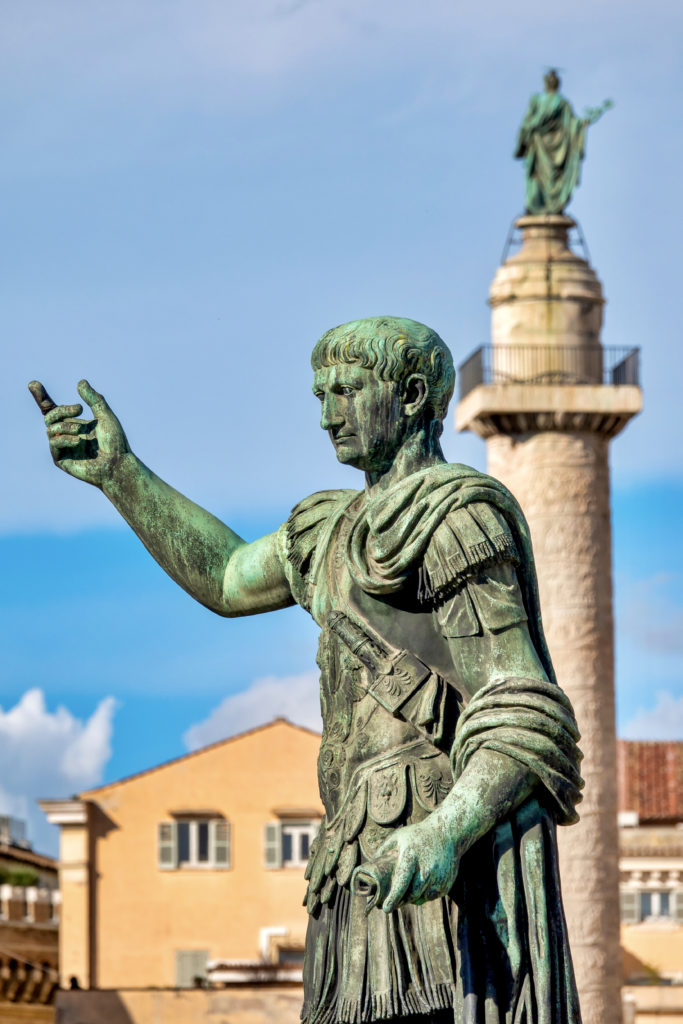
Definitely don’t have a car in Rome. The drivers are very aggressive and many streets are teeny tiny.
If you’re venturing outside Rome on an Italy road trip, pick up the car on your way out of Rome.
There are plenty of other fun ways to explore Rome, for every interest. You might consider booking one of these tours:
- a daytime Segway tour
- a nighttime Segway tour
- an e-bike tour
- a biking sightseeing tour
- the hop on hop off bus tour
- a private tour by car
- a classic vespa tour
3. When To Visit Rome
Try to visit Rome in the off season. Rome is one of the world’s most popular and busiest cities. It can be a chaotic, crowded, sweaty mess in the summer.
Fall and spring are lovely. Even in winter, you’ll have sunny days and mild temperatures.
If you must visit in high season, it’s essential to invest in skip the line tickets. Otherwise, the bulk of your day will be standing in lines and you won’t see nearly as much.
4. Rome City Passes
If you’re in Rome for 5 days, consider purchasing the Roma Pass . For just 38 euros, You’ll have full access to public transportation, admission to two museums, and discounts on performance and exhibition tickets.
Alternatively, try the more comprehensive Omnia Rome and Vatican Card . It consists of the Roma Pass and an Omnia Card.
Most importantly, it gives you skip the line access at the Vatican Museums, St. Peter’s Basilica, and the Colosseum.
5. Where To Stay In Rome
If you’re a first timer in Rome, you may want to stay in the historic center around the Pantheon or Piazza Navona. Some good options are the Li b ert y Boutique Hotel , the H otel M aalat , De co Ro ma , or Hotel H a s s ler Roma .
If you want to stay near the Imperial ruins, P al azzo Manfredi and the In n at The Roman Forum are good choices.
If you want to stay in the quieter Monti area, which makes a great base, the Pa lazzo Man fr edi (Colosseum views), Vill a S palletti Trivelli (Roman townhouse), and Ro m a Luxus (former 18th century palace) are fantastic choices.
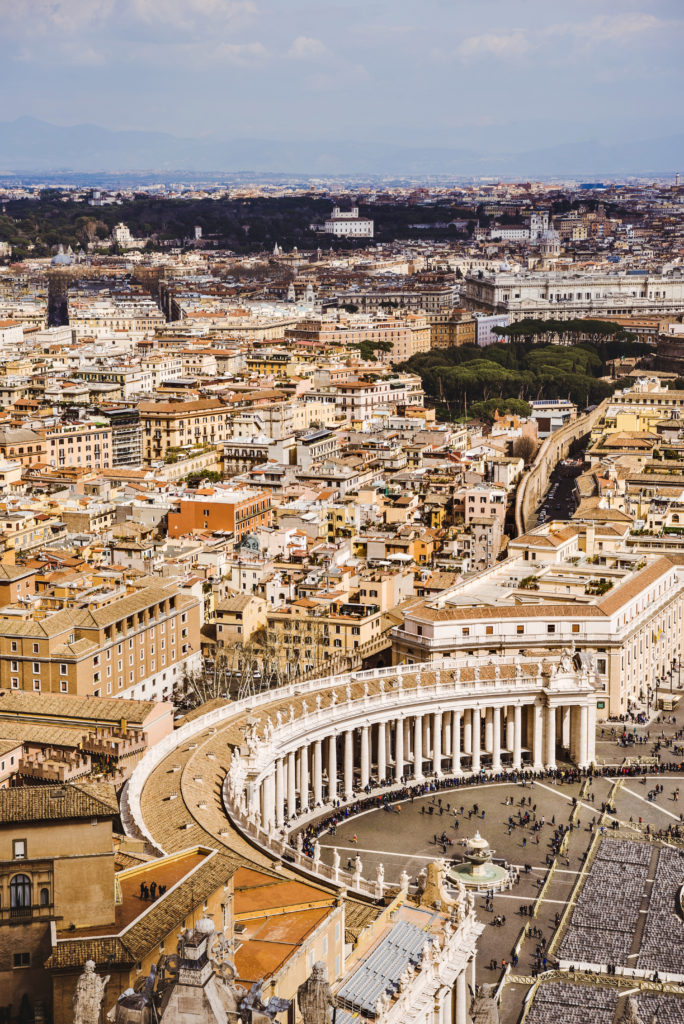
One of my personal favorites is the Rome C avalieri , which has its own art collection. You will also love the J.K. Pla ce Roma , a simply gorgeous boutique hotel.
6. Departing Rome
Are you ending your trip in Rome? If so, you may want to drop off your car and stay at one of the airport hotels to fly out the next day.
The Hilton Rome Airport is the best place to stay. It’s just a few blocks away and you can easily roll your bags there.
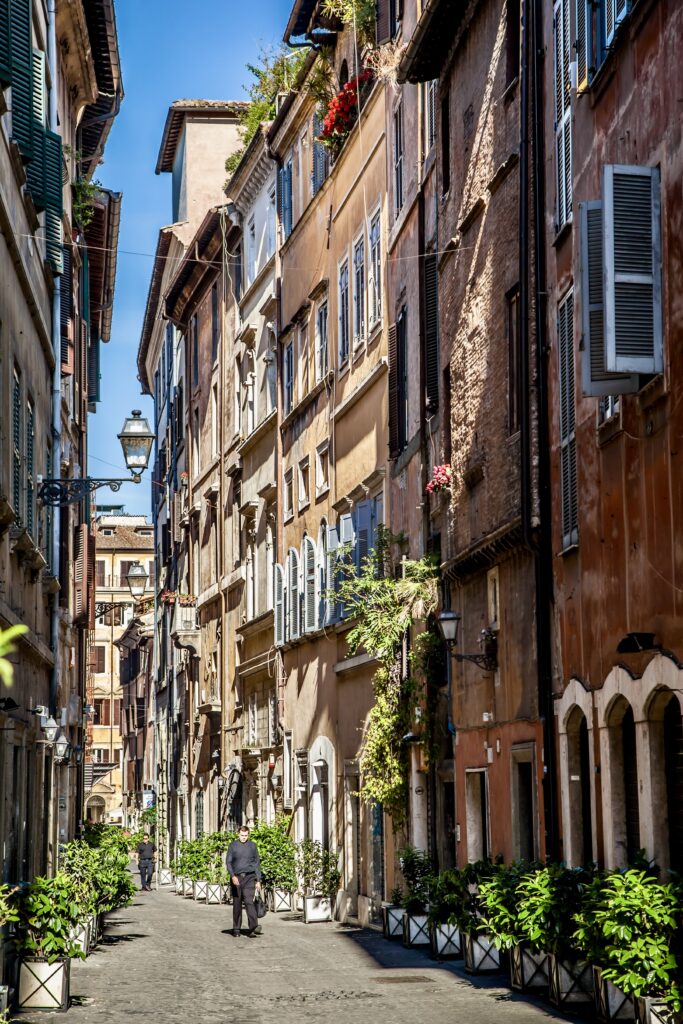
If you’re staying at another airport hotel, you will need to take a taxi. Be sure to get in the line for local taxis, which is different than the regular taxi line. It’s across the street and up the stairs.
I hope you’ve enjoyed my 5 days in Rome itinerary. You may enjoy these other travel guides and resources for Italy:
- Historic Landmarks in Italy
- Most Beautiful Towns in Italy
- 101+ Epic Experiences To Have in Italy
- 10 Day Itinerary for Italy
- 10 Day Itinerary for Tuscany
- 12 ways to spend 1 week in Italy
- 5 ways to spend 1 week in Sicily
- 10 day itinerary from Milan to Rome
- 3 Day Itinerary for Florence
- 2 Day Itinerary for Venice
- 24 Hours in Milan
- 24 Hours in Siena
If you’d like to spend 5 perfect days in Rome, pin it for later.
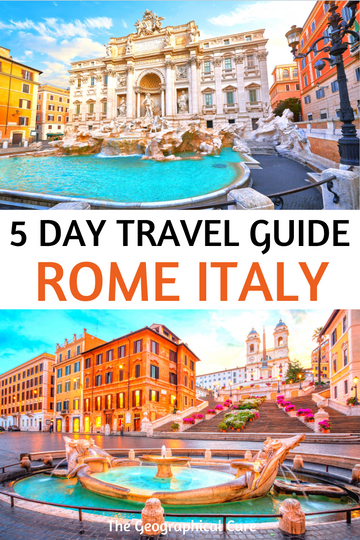
6 thoughts on “5 Days In Rome, The Perfect Rome Itinerary”
Hi Leslie, I love your blog and 5 day itinerary for Rome. My interests seam to be similar to yours and I will be using majority of your itinerary on my trip to Rome. However, I was wondering why you didn’t combine House of Augustus and Livia with the first day itinerary when you visited Colosseum, Roman Forum and Palatine? Would it make sense to purchase a full experience ticket and see all in one day?
Sure you could book the Full Experience ticket, which is a new ticket, and do it all in one day. But the ticket does give you 2 days to visit the sites. Thank you and I hope you have a great trip to Rome.
Hi Leslie! Just want to say how much I like your site. I’m heading to Europe to visit a friend in September. I’m considering adding on a few days in Rome, but wondering if you think things will still be chaotic with tourists in mid-September. I’m hoping to avoid the summer rush to Europe’s biggest cities.
Thanks Jenn. It will still be crowded in September. But with everyone back in school and summer over, it will be bearable. Just purchase tickets in advance!
Hi Leslie, Happened to come across your blog and WOW !! I am going to have to book another 4 days in Rome just to see it through your eyes. Loved all the information advice tips and WOW .. We have already booked a few things in so far for our two days that we have prior to getting on a cruise ship. So we would have seen the Colosseum Tour underground, arena floor, Roman Forum & Palatine Hill.. We have booked a tour for the Jewish Ghetto & Trastevere plus a Night Ghost walking tour.. we can fill it in with some of your ideas. Then when we get back into Rome after the cruise we can add a few extra days to finish off what you started
We also want to do a ebike tour along the Appian Way and a Foodie tour in Trastevere …
Can’t wait to visit Rome..
Thanks Jane! You will love Rome. Sounds like you have done your planning’s high is key. If you need any more ideas, check out my article on hidden gems in Rome.
Leave a Comment Cancel reply
Save my name, email, and website in this browser for the next time I comment.
Last Updated on January 9, 2024 by Leslie Livingston
- Skip to primary navigation
- Skip to main content
- Skip to primary sidebar
- Skip to footer

The Mindful Traveller
Eco Travel Blog & Photography
5 Perfect Days in Rome, Italy: Complete Itinerary
1 April 2022 · In: City Guide , Italy , Rome

Welcome to the Eternal City and vibrant capital of Italy! From the Colosseum to the Pantheon and Vatican City, this Rome 5-day itinerary is perfect for first-timers and is ideal for any time of the year . It will show you all the best things to do and guide you through everything you need to know to make your Italian city break unforgettable.
I visited Rome at the end of December with my partner Matt on a short city break , and I truly fell in love with this city. It was a beautiful discovery, and I was amazed by its culture and history and loved wandering through its narrow streets. I could not recommend you visit it enough, even for a few days!
In this 5-day travel guide, I share the best itinerary covering the top attractions in Rome so you can make the most of your time away. I also provide you with easy eco-tips for travelling responsibility . Enjoy!
Disclosure : Some of the links below are affiliate links, meaning that at no additional cost to you, we will receive a commission if you click through and make a purchase. For more information, read our full affiliate disclosure .
4- Admire the Trevi Fountain
2- explore st peter’s basilica, 5- stroll through piazza navona, 2- visit villa borghese, overview: how to see rome in 5 days.
- Day 1: Colosseum, Altare Alla Patria & Trevi Fountain
- Day 2: Vatican Museums, Chapel Sistine & St Peter’s Basilica
- Day 3: Roman Forum, Pantheon & Piazza Navona
- Day 4: Trastevere, Piazza Santa Maria & Janiculum Hill
- Day 5: Piazza di Spagna, Piazza del Popolo & Villa Borghese
READ MORE: 40 Best & Prettiest Cities to Visit in Europe
Rome 5-day itinerary – Map
Click on the top left of the map to display the list of stops and locations.
Rome travel tips: things to know before you go
- Book tickets for popular attractions in advance.
- Avoid tourist restaurants.
- Always carry cash.
- Wear comfortable shoes to walk around.
- Bring a reusable water bottle to refill anywhere.
- Prepare your itinerary, but do not overplan.
- Do not try to see the Vatican and Colosseum on the same day.
- Keep museum closures in mind.
- Buy bus tickets before boarding.
- Museums are free every first Sunday of the month.
Shop the printable travel itinerary
Plan your dream city break & live a unique experience in Rome.

Detailed itinerary: 5 days in Rome
This Rome guide covers all the best things to do and see in 5 days and is perfect for travelling with family, friends or as a couple, whether it is your first time in the city or you have been there before.
On the other hand, remember that this itinerary is only a guide with recommendations. You can spend more days in the Italian capital or add other stops to your trip.
READ MORE: Rome Winter Guide: 10 Magical Things to Do
Day 1 – The Ancient Rome
1- visit the colosseum.

We began our journey with the Colosseum (Colosseo). I was super excited to discover this impressive monument, and I could not stop thinking about the film Gladiator (we watched it the next night).
Also known as the Flavian Amphitheatre, the Colosseum is an iconic ancient Roman structure located in the heart of Rome. Built during the Flavian dynasty, it was completed in 80 AD.
This colossal amphitheatre, made of concrete and sand, could accommodate 50,000 to 80,000 spectators and was renowned for hosting gladiator contests, animal hunts and other public spectacles .
With its distinctive oval shape and imposing exterior adorned with arches and columns, the Colosseum is a testament to the skills of Roman engineering and is a globally recognised symbol of ancient Rome – a must-visit on your city break!
UNFORGETTABLE EXPERIENCES I RECOMMEND
Once there, I was not disappointed – the outside looked incredible! However, even though we had booked our tour tickets in advance, we had to wait in a long queue to collect them, so I recommend arriving early in the morning.
Inside, we used audio guides to help us better understand the history of the Colosseum. You can also book a tour with a guide, but we wanted to do that ourselves. Plus, the audio guide will explain which way to go.
The inside of the Colosseum was just as impressive as the outside. I could not believe gladiators were fighting there more than 2000 years ago! I also could not believe the monument was still in such good condition – it is something you must see!

2- Discover Vittorio Emmanuelle II Monument
After finishing our tour, we went to eat and, unfortunately, it was too late for the Roman Forum (Foro Romano). Instead, we visited the Vittorio Emmanuelle II Monument (Altare alla Patria), an impressive building in terms of size, especially considering how long ago it was built!
The Victor Emmanuel II Monument, also known as Altare della Patria, is a grandiose national monument . Completed in 1925, it was erected in honour of Victor Emmanuel II, the first king of a unified Italy.
The monument is characterised by its massive white marble structure, grand staircase and an imposing central equestrian statue of Victor Emmanuel II. It is also home to the Tomb of the Unknown Soldier , symbolising the Italian soldiers who lost their lives in World War I.
With its neoclassical design, the Victor Emmanuel II Monument is a prominent landmark you should not miss. In addition, it offers panoramic views of the city from its terraces – especially great at sunset!
🎟️ Book your entrance to the terrace: Panoramic Glass Elevator Ticket with Audio App .
I was amazed each time we passed it during the week. We did not visit the museum part but went up into the building to admire the view.
You can also go on the roof with an elevator, but we found it a bit expensive for what it was (10€), especially when you already have a beautiful view for free.

3- Marvel at the Forums
We then walked down Via dei Fori Imperial to discover other Forums, including the Forum of Trajan, Forum of Augustus and Forum of Nerva . You can not go inside them, but you can often get quite close, and it was still lovely to see. It is something completely different from things you can see in other cities!
Via dei Fori Imperiali is a grand boulevard in the heart of Rome, connecting the Colosseum to Piazza Venezia. Built by Benito Mussolini in the early 20th century, it runs alongside the ancient Roman Forum and passes by several important archaeological sites , including Trajan’s Forum and the Imperial Forums.
I would recommend taking the time to see the Trajan’s Forum , a monumental complex built by Emperor Trajan between 107 and 113 AD. It consists of a large open space surrounded by a series of impressive buildings, such as the Basilica Ulpia , Trajan’s Column and Trajan’s Market .
The entire complex is a remarkable example of Roman imperial architecture and is considered one of the most significant and well-preserved forums from antiquity.
🎟️ Book your tour: Trajan Markets Experience with Multimedia Video .

Finally, we ended our day with the magnificent Trevi Fountain . On our way, everything was quiet, and suddenly it was there, in a small place.
The Trevi Fountain is a renowned Baroque masterpiece located in the historic centre of Rome. Completed in 1762 by architect Nicola Salvi, the fountain is a grandiose structure adorned with elaborate sculptures and reliefs .
The central figure represents Oceanus , the god of the sea, riding a chariot pulled by seahorses and tritons. The fountain is not only a captivating artistic display but also a popular and iconic attraction for travellers from around the world.
The blue colour of the water and the white status made it really special. Unfortunately, it was so crowded, but we still managed to make our way to the fountain. We did not throw a coin in, but you can do it – it is a tradition and brings luck!
🎟️ Book your tour: Uncover the Trevi Fountain and Underground Tour .

Day 2 – Vatican City
Vatican City is one of the emblems of Rome. We started to walk to the Piazza San Pietro, and the crowd was very impressive. Fortunately, we pre-booked tickets for a guided tour of the Vatican Museums and The Sistine Chapel , which made us skip the queue.
1- Tour the Vatican Museums & Sistine Chapel
The Vatican Museums constitute one of the most extensive and impressive art collections in the world. Established by Pope Julius II in the early 16th century, the museums house an array of masterpieces, sculptures and historical artefacts accumulated by different popes over the centuries.
Notable highlights include the Sistine Chapel with the iconic frescoes by Michelangelo , the Raphael Rooms and the Gallery of Maps . The Vatican Museums are undoubtedly an experience to add to your bucket list, as they offer a rich journey through the history of art and culture.
UNFORGETTABLE TOURS I RECOMMEND
Our guided tour was very helpful. Without it, I would have had no idea where I was or what I was observing. Moreover, it was not too long – I love museums but in small doses.
The Museums were gorgeous, and we were lucky enough to see some beautiful masterpieces by Michelangelo.
The Sistine Chapel was a masterpiece in itself. I did not even know where to look. And I was delighted to admire The Last Judgement by Michelangelo – a wonder. Unfortunately, you can not take photos.

After the tour, we continued our way to St Peter’s Basilica , a key religious and cultural landmark worth the visit, despite the crowd!
Small tip : where you are inside the Sistine Chapel, instead of turning left at the end, turn right and continue to the Basilica (for free).
St. Peter’s Basilica is one of the largest and most significant churches in the world. Designed by architects including Michelangelo and Gian Lorenzo Bernini, it constitutes a masterpiece of Renaissance and Baroque architecture .
The basilica is built atop the traditional burial site of Saint Peter, one of the twelve apostles of Jesus, and is a major pilgrimage site. Its notable features include the iconic dome , the Baldacchino canopy over the papal altar and numerous works of art , including the Pieta by Michelangelo.
We started our visit with the top: the Dome , designed by Michelangelo. You have the choice to take the elevator and some stairs, or only the stairs (good luck). The effort was totally worth it, and the view of Rome and the Piazza San Pietro was gorgeous.
After enjoying the scenery, we went back down and visited the inside of the Basilica, which was also beautiful.
We finished our day with the Piazza San Pietro by night: the colours were magical with the Christmas atmosphere.

Day 3 – The Roman Forum & Pantheon
1- visit the roman forum.
Since we did not have time to do the Roman Forum on the first day, we decided to go back on the morning of the third.
The Roman Forum, located in the heart of ancient Rome, is a vast archaeological site displaying the remains of a once bustling centre of political, religious and commercial activities. It served as the focal point of the city for over a millennium, with structures such as the Temple of Saturn , the Arch of Titus and the Senate House .
Surrounded by ruins, columns and triumphal arches, the Forum provides a vivid glimpse into the civic life and architectural grandeur of ancient Rome . It stands as a remarkable testament to the historical and cultural significance of the city.
I was amazed at all these ruins and how people lived before us. We used a map given at the entrance to understand what was there and where we needed to go. We also had a stunning view of the Colosseum and hiked on top of Palatine Hill.

2- Enter the Pantheon
We then headed to the Pantheon , a testament to the ingenuity and skill of ancient Roman builders. It is free and an attraction you need to see!
The Pantheon is a magnificent ancient temple and one of the best-preserved buildings from antiquity . Originally built by Emperor Hadrian around 126 AD, it was dedicated to all the gods of ancient Rome.
It is renowned for its massive dome with an open hole at the top , allowing natural light to illuminate the interior. Its classical design and engineering marvel make it a significant architectural landmark , and it continues today to be used as a Roman Catholic church, known as Santa Maria ad Martyres.
BOOK YOUR ENTRANCE
It was impressive to admire an Ancient Rome monument (the best-preserved) in the heart of the capital. The inside was also unique, with its architecture and hole in the middle of its cupola (we could not help but wonder how they made it).
The hole in the cupola (7,8m in diameter) is the only source of light and represents the connection between the temple and the Gods above (the Pantheon has a Greek origin, in fact, the word Pantheon means “honour all Gods”).

3- Stop by Church Saint-Louis-Des-Français
We continued walking to Piazza Navona and stopped on the way to the Church Saint-Louis-Des-Français (San Luigi Dei Francesi), a Catholic church dedicated to Saint Louis IX, the King of France
Built in the late 16th and early 17th centuries, the church is a fine example of Baroque architecture . One of its notable features is the Chapel of Contarelli , which houses three famous paintings by the Baroque master Caravaggio , depicting scenes from the life of Saint Matthew.
The interior was beautiful, like most churches in Rome. I recommend you go inside as many as you can, this is not something I usually do, but there is something special and unique about Romain churches. We were continuously amazed by their rich architecture and beauty.

4- Relax at Caffè Sant’Eustachio
On the way to Piazza Navona, we also stopped at a historic coffeehouse renowned for its traditional and high-quality espresso: Caffè Sant’Eustachio .
Founded in 1938, it has maintained a reputation for serving some of the best coffee in the city . The café is famous for its unique blend and preparation techniques , including the Gran Caffè method, using a special machine to create a smooth and rich espresso.
With its vintage ambience and a central location near the Pantheon, Caffè Sant’Eustachio is a popular destination for travellers seeking an authentic Roman coffee experience .
We enjoyed our café on the terrace as the weather was lovely – something I recommend.

We then finally reached Piazza Navona , a picturesque square known for its Baroque architecture and vibrant atmosphere . Built on the site of the ancient Stadium of Domitian, the square is home to 3 beautiful fountains, including the famous Fountain of the Four Rivers by Gian Lorenzo Bernini.
Surrounded by charming cafés, restaurants and historic buildings , Piazza Navona is a popular gathering place for locals and tourists alike. The square is also often animated by street performers, artists and musicians, adding to its lively and festive ambience !
The atmosphere was great: children were playing, and there was a cute Christmas market in the middle. I also found in this place a great leather shop named Cartoleria Pantheon dal 1910 that I recommend you visit for the superb quality of its products.
We ended our day by wandering through the little streets toward the Tiber. It was one of my favourite things to do, just because of how beautiful and authentic these streets were, with small shops and lights everywhere – such a great atmosphere.

Day 4 – Trastevere
Trastevere is a charming and historic neighbourhood , located on the west bank of the Tiber River. Known for its narrow cobblestone streets, colourful buildings and lively atmosphere, it retains a distinct medieval character .
The area is popular for its vibrant nightlife , with its many restaurants, bars and artisan shops . It is also home to several remarkable churches, such as the Basilica of Santa Maria in Trastevere , contributing to its cultural and architectural richness.
I recommend taking the time to explore the area. Trastevere offers a delightful mix of local Roman life and bohemian vibes , making it a perfect place for a relaxing stroll.
🎟️ Book your tour: Trastevere Guided Food and Wine Tour with 20+ Tastings .
Trastevere was the area where we were staying, and one of the best for its active life and beautiful streets. We decided to have a chill day there, and for sunset, we walked on a hill by following the road Passeggiata del Gianicolo to have a beautiful view over the entire city.

Day 5 – Piazza di Spagna & Villa Borghese
1- explore piazza di spagna.
We started our day at the Piazza di Spagna , an iconic and bustling square dominated by the famous Spanish Steps , a monumental staircase designed in the 18th century.
At the foot of the steps is the Barcaccia Fountain , designed by Gian Lorenzo Bernini’s father, Pietro.
Piazza di Spagna is also surrounded by luxury boutiques, cafés and art galleries , making it a lively and fashionable area, particularly ideal for shopping lovers!

We went down the stairs and walked to Piazza del Popolo . We could not find anything special to do there, so we went up to the Villa Borghese , a large public park.
Originally a private vineyard and garden of the Borghese family in the 17th century, it was later transformed into a public park in the 19th century. It now features lush greenery, walking paths, fountains and a lake , providing a peaceful retreat from the hustle and bustle of the city.
Within Villa Borghese, you will also find the Galleria Borghese , which houses an impressive art collection , including works by Caravaggio, Bernini and Raphael, making it a cultural haven amid the natural beauty of the park.
In addition, the park is a great place for families with children, as you can row boats on a small lake, visit a zoo or watch a play in front of a replica of Shakespeare’s Globe Theatre. We also had a lovely coffee on the terrace of Casina del Lago.
For sunset and our last evening, we again went to the top of the Vittorio Emmanuelle II Monument. The beautiful colours over Rome made it the perfect way to end our trip and say goodbye to this incredible city.

Cooking experiences I recommend
My top 6 pizzerias in rome.
As you may know, Italy makes incredible pizzas, so we challenged ourselves to eat one daily and rate them.
Here are our favourite 6 pizzerias in Rome:
- Bottega Rocchi, near the Pantheon
- Dar Poeta, in Trastevere
- Il Bersagliere
- La Bruschetta E, near the Borghese Park
- Ristorante Pizzeria Imperiale, near the Colosseum
- CasaRita, in Trastevere
How to get to Rome
The best way to get to Rome will depend on where you come from and your budget, but there are many options to reach the Italian capital.
One of the quickest ways to get to Rome is by plane . If you are travelling from another country or a distant city, you will likely arrive at Leonardo da Vinci Fiumicino Airport (FCO), the primary international airport well-connected to major cities in Europe and the world.
Another airport serving Rome is Ciampino Airport (CIA), mainly used by budget airlines. From both airports, you can take a taxi, bus or train to reach the city centre.
One of the most eco-friendly ways to get to Rome is by train . Italy has an extensive and efficient rail network, and Rome is well-connected to major European cities by train. Its main train station is Termini Station, which you will find in the city centre.
Finally, the most affordable option for getting to Rome is by coach . It is a great way to reach the Italian capital if you are exploring Europe on a budget, but it may take longer. Several international and national bus companies operate services to and from Rome via its main terminal, Tiburtina Station. In addition, check out the Eurolines bus service.

How to get around Rome
The great thing about Rome is that it is not a big city so you can easily do everything on foot . That is what we did during our five days there, and it was perfect. And because it can get hot in summer, bring a reusable water bottle to stay hydrated! Rome has plenty of free fountains offering fresh and cold water.
Rome also has a vast public transportation network consisting of buses, a subway and trams. For example, we used the bus once to reach the Colosseum with the app Moveit . You can also use TicketAppy . It will help you book your ticket on your phone and avoid wasting paper.
Another great way to travel around Rome is by bike . It is ideal for slowing down and appreciating your surroundings. And if you need a boost, rent an electric bike.
Finally, if you want to explore outside of Rome, I would look at buses, trains or small guided tours – depending on where you want to go and for how long.

Where to stay in Rome
The best neighbourhoods in rome.
Are you looking for the best place to stay in Rome? Here is an overview of the top neighbourhoods in the Italian capital:
- Centro Storico: the best area for first-time visitors
- Trastevere : the best area for couples
- Piazza di Spagna : the best area for luxury hotels
- Monti & Colosseum : the best area for history lovers
- Prati & Vatican : the best area for a quiet stay
- Esquilino & Roma Termini : the best area to stay on a budget
- Testaccio : the best area for food lovers
- San Giovanni : the best area for local vibes
🏨 READ MORE: Where to Stay in Rome: 8 Best Areas (& Green Hotels)
My experience
My partner Matt and I booked an apartment on Airbnb for five days in Trastevere , an ideal location with everything within easy walking distance. Plus, the view was incredible! We were also lucky to have a small terrace on the roof to enjoy the view of Rome on sunny days.

Best time to visit Rome
Spring (April to June) and autumn (September to October) are the best times to visit Rome, as the weather is mild and pleasant with fewer crowds, which is ideal for sightseeing.
In spring, the city comes alive with blooming flowers and diverse events, making it an excellent time for exploring and enjoying outdoor activities. Autumn also enjoys beautiful colours and is a great time to experience the city without the intense heat of summer.
Summer (July to August) in Rome can be hot, with temperatures often exceeding 30°c. It is also the peak tourist season, so popular attractions can be crowded. But despite the crowds, this season offers longer daylight hours, allowing for extended sightseeing and enjoying outdoor cafés.
Winter (November to March) is relatively mild compared to some northern European cities, but it can be chilly and rainy. And whilst it is the low season, you can discover the capital without the crowds – except around Christmas! In addition, some attractions may have shorter opening hours.
I visited Rome at the end of December with my partner Matt, as we wanted to experience the unique city of Rome in winter and spend New Year’s Eve. I loved it! The atmosphere was incredible, and the temperatures were not cold (around 13 degrees). It was busy, and we struggled a bit from time to time, for the Colosseum, for example. Otherwise, everything was perfect. Just book your tickets in advance, and you will be fine!

Sustainable travel in Rome
Sustainable travel means exploring the world whilst being aware of your surroundings and having a positive social, environmental and economic impact on the places you visit.
But how to make your next trip to Rome more sustainable?
Here are some sustainable tips for responsible travel in Rome:
- Book direct flights and offset your carbon footprint . But, do not use carbon offsetting as a complete solution. Combine it with other sustainable practices, like avoiding single-use plastic on the plane and mindfully packing your suitcase to be ready for your green adventure.
- Choose direct flights to reach Rome as it generally requires less fuel than indirect flights. ( Skyscanner has an option that only shows flights with lower CO₂ emissions).
- Select an eco-friendly accommodation . It is not always easy to determine whether a hotel has eco-conscious practices, but try to look on their website for green credentials. You can also use Bookdifferent to help you decide.
- Use public transport as much as possible or walk ! Rome is easily accessible on foot, and you will not produce any emissions.
- Eat at local Roman restaurants that use produce from the region. It will contribute to the local economy and reduce the carbon footprint by supporting restaurants where food does not come from long distances.
- Always respect the local heritage . Treat people and their surroundings with respect. Sustainable travel is not only about the environment but also about the local communities. So, always be respectful and try to learn a few Italian words!
More inspiration for your green vacation:
- Best Travel Apps for Exploring Sustainably
- 15 Travel Books to Inspire Your Next Eco-Adventure
- Best Ecotourism Activities Around the World
Eco-friendly gear you might love:
- 10 Best Sustainable Backpacks for Travel & Hiking
- 10 Best Reusable & Eco-Friendly Travel Mugs
- 8 Best Filtered Water Bottles for Travel & Hiking
Check out this page for more inspiration on eco-friendly products & gear.

Rome travel planning guide
Yes, buying insurance is always valuable when travelling abroad. Enjoy your city break to Rome stress-free with one of my favourite providers, Nomad Insurance .
Yes, tap water is safe to drink all over Rome. However, I also recommend travelling with the UltraPress Purifier Bottle , a lightweight filtered water bottle perfect for reducing plastic and staying hydrated.
Yes, renting a car in Rome is easy and is a great way to explore outside of the city freely. I recommend booking yours with Rentalcars.com – they offer a variety of operators for all budgets.
The best way to book your accommodation in Rome is with Booking.com – my favourite platform to compare and reserve places to stay each night, from affordable guesthouses to luxury hotels.
I recommend booking your plane with Skyscanner . It has been my favourite platform for years, as it allows me to book the cheapest flights whilst lowering my carbon emissions.
5 days in Rome, Italy – FAQ
4 days are the perfect amount of time to discover Rome and see the core sights of the city. It will allow you to spend time at the Colosseum, Vatican City, Trevi Fountain, Spanish Steps and the vibrant Trastevere – without rushing. Visiting big sites like the Colosseum or Vatican City takes time and energy – and we often had to push back what we had planned afterwards.
Rome has become one of the most expensive tourist destinations in Europe due to its high number of visitors and attractions. However, it also all depends on how much you decide to spend, and there are still a lot of local and authentic places for small budgets.
Spring (March to April) and autumn (September to November) are the best times to visit Rome. These months offer nice mild weather (summer is hot!) without too many tourist crowds, which is the perfect combination to enjoy the best of Rome.
The best way to get around Rome is on foot. Rome is a very accessible city, and many of the best attractions are concentrated together in traffic-free areas. If some places are a bit far from your accommodation, the other best modes of transport would be buses or taxis.
Yes, Rome is considered a safe destination for tourists, including in the evening. Of course, it is always a good idea to stay informed and use common sense. But Rome is a popular and much-visited city, and many tourists take advantage of their evenings to explore its bustling streets and dine in its charming restaurants.
Shop the Rome eco-travel bingo
Learn how to live an unforgettable experience in Rome whilst respecting places and locals.

And you, have you ever visited Rome or would you like to go one day? Let me know in the comments below!
With love ♡ Lucie
- Share on Twitter Share on Twitter
- Share on Facebook Share on Facebook
- Share on Pinterest Share on Pinterest
You will also love

STAY INSPIRED
Join our community today to receive exclusive travel tips & behind-the-scene stories that will inspire your next adventures, directly to your inbox. Can't wait to see you inside ♡
Reader Interactions
13 December 2022 at 18:19
Thanks for this post. I am planning an anniversary trip to Rome next year and I’ve been planning what I want to see. Your posts have some many tips and spots worth to see!
Leave a Reply Cancel reply
Your email address will not be published. Required fields are marked *
Save my name, email, and website in this browser for the next time I comment.

The Lake District Sustainable Travel Guide
Follow the journey.

On the Blog
- Privacy Policy
Become an insider!
And receive exclusive travel tips & behind-the-scene stories ♡
Copyright Lucie Charpentier © 2024 · Theme by 17th Avenue

4 Days in Rome: Detailed Itinerary (+Map & 2024 Planning Tips)
By Author Jurga
Posted on Last updated: March 5, 2024
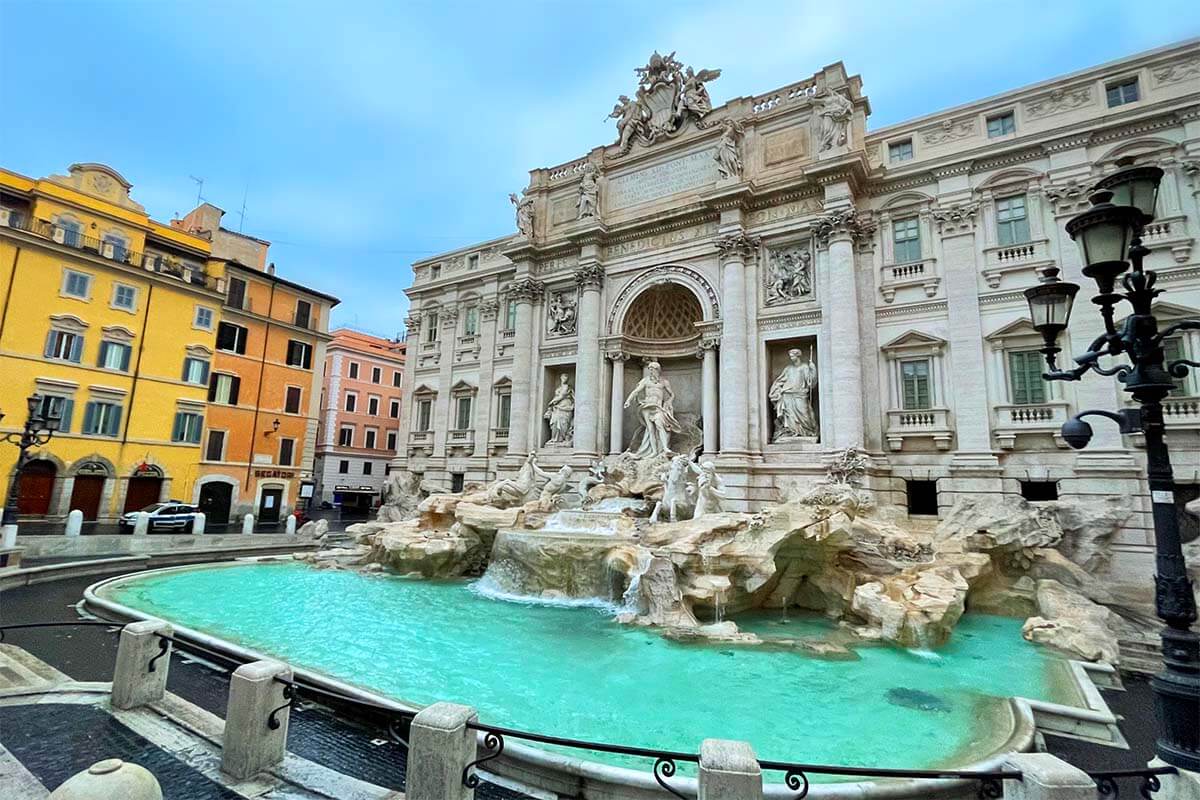
Visiting Rome for 4 days and wondering what to see and how to best plan your time? In this article, we share a perfect itinerary for 4 days in Rome , with maps, essential info, and tips to make the most of your stay in the Eternal City. Find out!
Rome is one of the most beautiful places to visit in Italy and an absolute must-see! Whether you are planning a city break in Rome or it’s part of a longer trip through Italy, it’s well worth taking a bit more time to explore this beautiful city and not just rush through the main attractions.
This Rome 4 days itinerary brings you to ALL the must-see places in the city . In addition, it also includes quite a few of Rome’s hidden gems , some of the best views in the city , and some amazing underground sites that will make your visit so much more memorable.
We also share hotel and restaurant recommendations and other useful tips that will help you plan a perfect trip and explore the city just a bit deeper than most standard itineraries.
Good to know: We recently spent 4 days in Rome and this itinerary is based on the trip that we did and is very detailed (including suggestions on where to eat or where to find the best gelato, etc.). In this guide, we share our experience-based tips and advice , the tickets we booked and tours we did, what we’d do differently, and why.
It should save you hours and hours of research and help you plan an amazing visit and make the absolute most of your four days in Rome. None of the activities, restaurants, or accommodations are sponsored, so if we recommend something it’s only because we actually liked it.
Top 4 Tickets & Experiences to Book in Advance:
- Vatican Museums & Sistine Chapel .
- Colosseum, Roman Forum & Palatine Hill .
- Local Food Tour .
- Appian Way, Aqueducts & Catacombs .
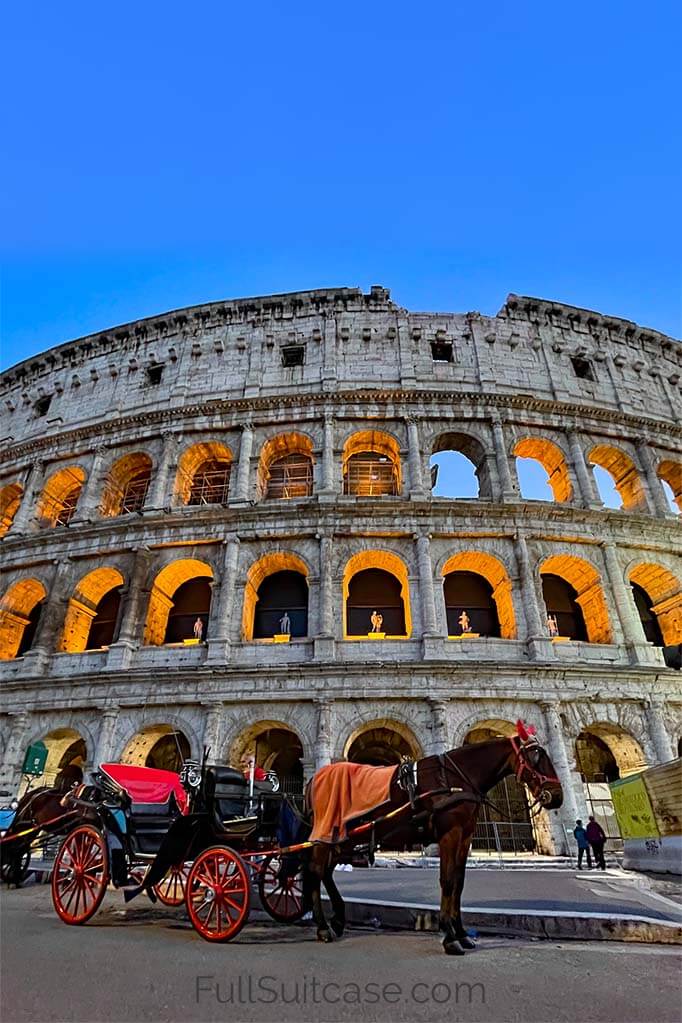
TIP: Use this itinerary just as an example of what can be done each day and switch the days around if you have to. Before deciding where to go on which day, be sure to check if all the places you want to visit are open!
For example, we had to adapt our 4-day Rome sightseeing plan because the Vatican Museums weren’t open on the day we wanted to visit.
PRO TIP: For the Vatican and the Colosseum, it’s essential to book your tickets or tours in advance , so be sure to check that first, before planning anything else! If you are planning on visiting top sites on your own, check out this digital Rome Tourist Card . It’s a combined ticket that includes entry to the Colosseum, Roman Forum, Palatine Hill, Sistine Chapel, St. Peter’s Basilica & its Dome.
This card allows you to choose time slots for all the top attractions in one go (so you can immediately see what’s available on which day). It saves you time and money, and it’s simple to use because all tickets are digital.
Below, you will find more information about tickets and tours for these and other sights in Rome.
READ ALSO: Tips for Visiting Rome
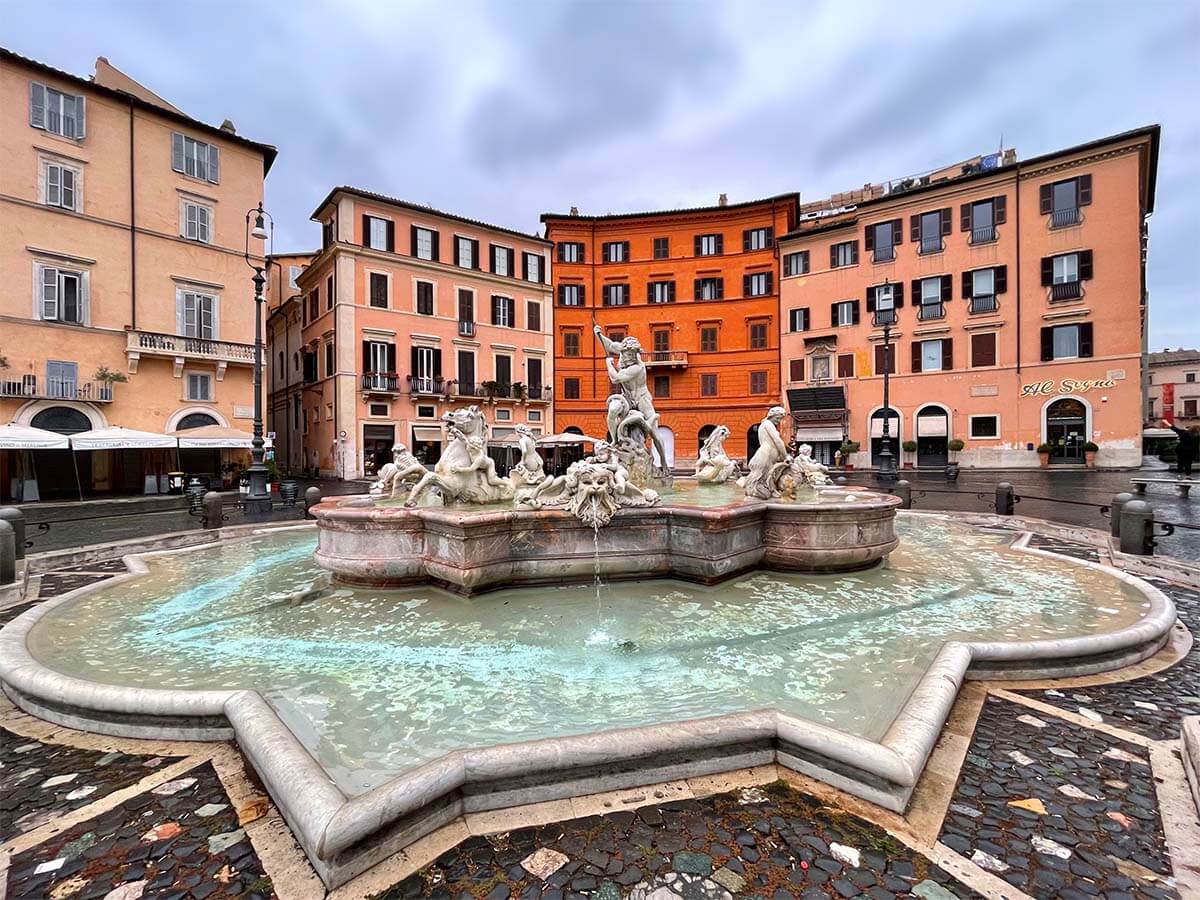
How to see the best of Rome in 4 days? With so many landmarks, must-see attractions, and countless interesting sights scattered in and around the city, there’s not one perfect itinerary.
But if you want to see the very best of Rome, this 4-day plan will not disappoint. I spent a lot of time creating this itinerary for our own trip and I’m quite confident that you’ll love it as well! At the bottom of the article, you’ll also find a MAP indicating all the places to see, restaurant suggestions, and even the meeting points of some tours we recommend.
Of course, you can just pick the places that interest you the most, see fewer places, and explore deeper. But this gives you an idea of what to see, how to plan your time, and what can actually be done in four days in Rome.
Good to know: Prepare to walk a lot (wear comfortable shoes!!!) and if you can, make an effort to get up early so that you can see some of the most beautiful places without the crowds. Also, stay in the heart of the city center! We stayed at 9HotelCesari , just a few minutes’ walk from the Pantheon and the Trevi Fountain. We always stay in this area when visiting Rome – it just makes everything so much easier and more enjoyable.
TIP: If you need airport transfers to/from the city center, you can find all the best options here (by train, bus, or pre-booked taxi).
- DAY 1: Historic Center, Colosseum, several hidden gems, Trastevere
- DAY 2: The Vatican, Food Tour & Jewish Quarter
- DAY 3: Markets, the Pantheon, Galleries, Crypts, Shopping, City Views
- DAY 4: Appian Way, Aqueducts & Catacombs Tour, most interesting churches, Colosseum at sunset
- Map & getting around
- Additional suggestions if you have more time
- Where to stay
Here’s what your four days in Rome could look like:
Day 1: Historic Center, Colosseum, Baths of Caracalla, Aventine Hill, Mouth of Truth, Trastevere
PLANNING TIP: Be sure to book the tickets or the tour of the Colosseum in advance! We did and recommend this all-in tour . If you rather go on your own, you have the choice between regular tickets or tickets that include Arena Floor as well . We recommend the latter as standing on the Gladiator Arena is really special.
Here’s what your first of the 4 days in Rome could look like:
7 – 8 AM: Trevi Fountain, Pantheon, Piazza Navona, Breakfast
Start your first day in Rome with an early walk through the city center. I recommend going to see the Pantheon and the Trevi Fountain first thing in the morning. These are the most visited landmarks in the center and they are always crowded. But if you come here early, you have a chance of seeing these places without too many people around.
If you stay in the heart of the city center, it’s really easy to see these places without the crowds. Our hotel was so centrally located that we woke up at around 6.30 AM, took a quick shower, dressed, and were at the Trevi Fountain just before 7 AM. It was magical to see it empty and actually be able to enjoy it and take the time to admire this masterpiece!
It’s also nice to see the Pantheon and Piazza della Rotonda without people. You won’t be able to visit inside the Pantheon this early, but you can come back for that later. If you have a bit more time, you can walk to Piazza Navona and see it without the crowds as well (it’s just a 3-4 minutes walk from the Pantheon, so really not a big detour).
Go back to your hotel for breakfast . Alternatively, you can have breakfast at one of the many cafés in the city center.
READ ALSO: The Best Area to Stay in Rome
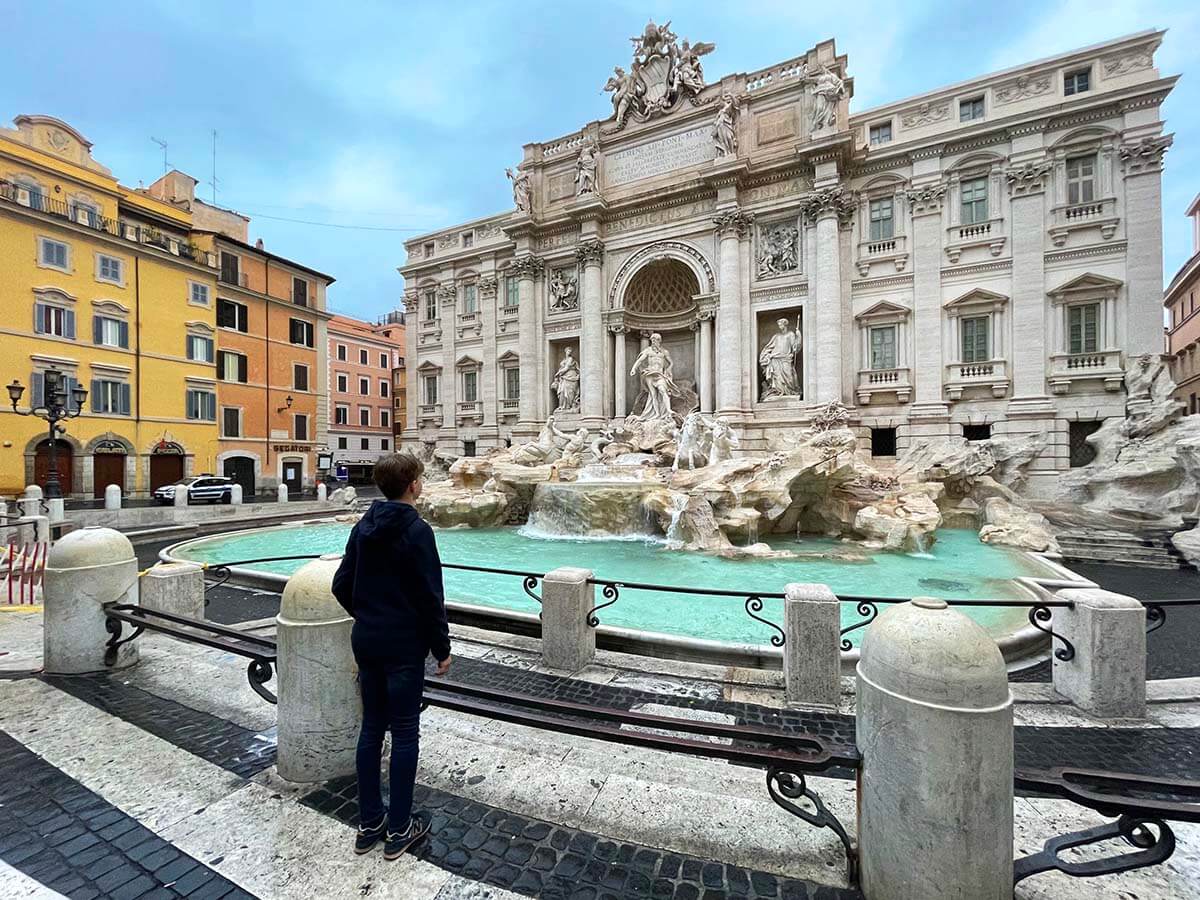
8.30 – 10 AM: Piazza Venezia, Capitoline Hill, Via dei Fori Imperiali
Next big stop – the Colosseum . It’s just a 20-30 minutes walk from the city center. You could take a taxi, rent an electrical scooter, or simply walk. We recommend walking because you can see so many other landmarks along the way, especially around Via dei Fori Imperiali .
On your way to the Colosseum, you’ll pass Piazza Venezia . This is a huge and very busy city square with a colossal monument (Altar of the Fatherland) and the equestrian statue of Vittorio Emanuele II. This is one of the must-see places in Rome!
TIP: If you have some extra time, you could visit the monument and take the elevator to the top . The panoramic views are stunning, but it’s not cheap and can take quite some time if it’s busy. Yet, it’s definitely possible to squeeze it in your itinerary if you plan well.
Then, take the wide staircase on the right side of the monument and visit Capitoline Hill (Campidoglio). This staircase and the square were designed by Michelangelo. On top of the stairs, you’ll see impressive palaces that house Capitoline Museums .
With just four days in Rome, you’ll have to be very selective about where to go and what to see. If you want to visit these museums and the Colosseum + Forum Romanum on the same day, it’s definitely possible, but you’ll have to skip most of the other suggestions for this day.
We recommend just passing by here. On top of the hill, check out one of the best viewpoints in Rome , Belvedere di Via Monte Tarpeo which overlooks the Roman Forum. On the other side of the Senatorial Palace, you’ll see a small statue of the Capitoline Wolf . This statue depicts an old legend, according to which a wolf saved and cared for Romulus and Remus, the twins that later founded the city of Rome.
After leaving Capitoline Hill, turn left and walk to the main street – Via dei Fori Imperiali and in the direction of the Colosseum. This road is like a museum in itself – with the Roman Forum on your right, the Forum of Augustus and other historic places on your left, and impressive statues of Roman emperors around you.
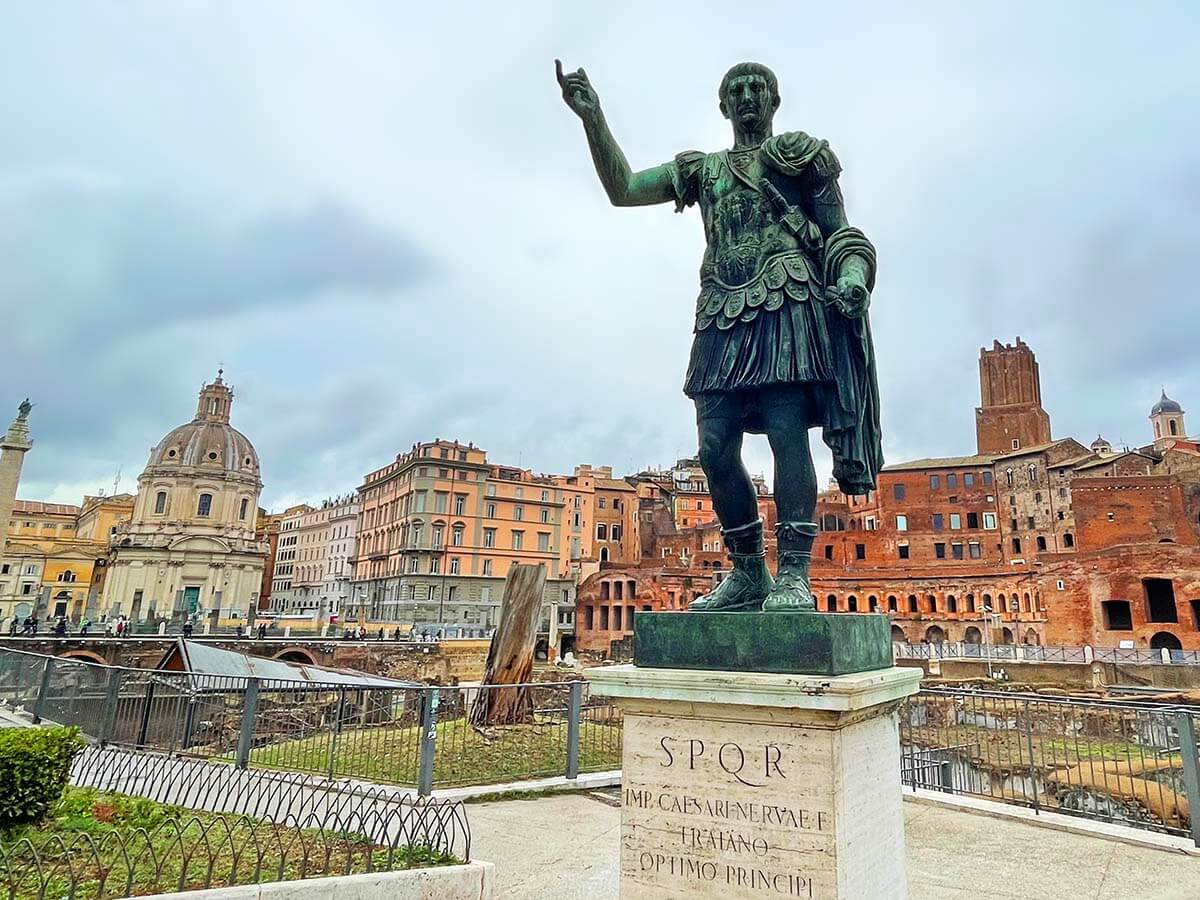
10.30 AM – 1.30 PM: Colosseum Tour + Roman Forum & Palatine Hill
If you booked your tickets or a tour of the Colosseum , you can now visit the Colosseum inside. All tickets also include an entrance to the Roman Forum and Palatine Hill . So plan on spending the next 2-4 hours here. In fact, the tickets include a few other places, but those are not a must. Just as with so many other places in the city, you could spend the whole day here, but with just 4 days in Rome, we recommend only focusing on the musts.
There are several options for the Colosseum. Most people just get a regular ticket and visit on their own, but you should also know that there is a slightly more expensive ticket that includes Arena Floor . In addition, I recommend visiting the underground level as well. And for that, you need a guided tour.
I’ll spare you all the details about all the ticket and tour options and to keep things short, just say that after lots of research, we booked a tour like this that includes Colosseum (all levels), Palatine Hill, and Forum Romanum . It was absolutely worth it and I highly recommend it.
Good to know: We booked a tour at 10.30 AM. You could also rush and come here first thing in the morning, but it’s ALWAYS busy at the Colosseum anyway, so it won’t really enhance your experience. And if you prebook your tickets in advance, there’s no need to hurry or worry about anything.
Going with a tour, we didn’t have to stress about where exactly to go, which line to stand in (we actually skipped most of the lines except the security check), or where exactly to go once we were inside the Colosseum.
We saw all the levels of the Colosseum – the Underground, the Arena Floor, and all the regular areas accessible to everyone. It was an amazing experience and our guide made it a smooth, informative, and very enjoyable visit.
Afterwards, we walked to the nearby Palatine Hill and the Roman Forum . Once again, it was great to have a guide here. I’ve been to these places before, without a guide, and it’s only now that I realized how much I missed.
These areas are so vast and there’s so much to see that it’s easy to get overwhelmed and miss some of the highlights. Also, the guide tells you stories and anecdotes and helps put things into perspective and better understand what you are seeing. Our tour ended at the Roman Forum, giving us more time to explore it further on our own.
READ ALSO: Guide to Colosseum Levels & Tickets
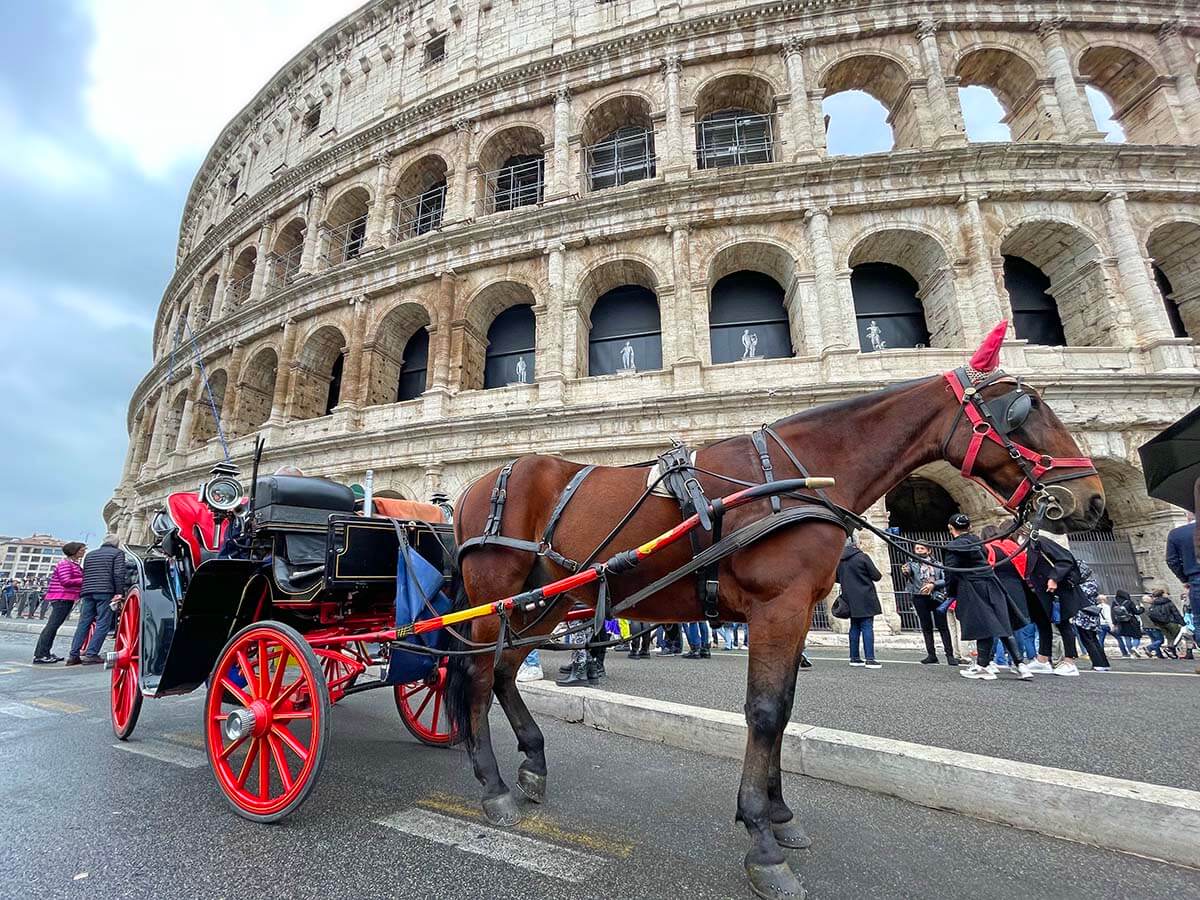
1.30 – 2.30 PM: Lunch near Colosseum
After all the walking and sightseeing, you’ll want to sit down for lunch! So find a nice restaurant near the Colosseum and enjoy a quiet lunch. We thought that we’d just get something quick for lunch and go on, but it was actually nice to take a break and I highly recommend you do the same!
We headed to the small neighborhood east of the Colosseum – this is where you’ll find lots of restaurants and cafes. And yes, many of them are really touristy, but there are some good places to eat here as well. The biggest problem is finding a table here in the afternoon…
For a quick bite, you could try L’Antico Forno . If you have some time to sit down, check out Trattoria Luzzi . This is one of the most popular and good-value restaurants near the Colosseum, but if you want to find a table here at lunch, try to reserve in advance.
We had lunch at La Pace del Cervello , which didn’t have the best reviews, but had a free table outside and we didn’t want to waste more time looking around. The service was super fast and friendly, the pizza was one of the best we had in Rome, and the prices were very correct as well.
TIP: The best way to find where to eat in Rome is to simply take a look at the reviews on Google Maps of the nearby restaurants and pick a place that looks more local (to start with, no pictures on the menu). But – once again – it’s usually so busy near the Colosseum at lunch that you will be happy to find a free table. And if you just get a pizza and some drinks, as we did, you can’t really go wrong anyway.

3 – 3.30 PM: Baths of Caracalla
If you want to get a bit off the beaten path in Rome, I highly recommend visiting the Baths of Caracalla . Located about 20 minutes walk from the Colosseum, this is one of the most remarkable Ancient Rome sites that most tourists never see. Yet, it’s absolutely worth a visit!
Caracalla Baths were built at the beginning of the 3rd century and were one the largest Roman public baths. It’s a huge complex that used to house several baths, saunas, an Olympic-size swimming pool, sports facilities, and even a library. The baths were heated via a series of underground ovens and it’s absolutely impressive to see how advanced and luxurious this place was.
Nowadays, it’s an archeological site/ outdoor museum. Some parts are still very well preserved and restored, with some stunning mosaics that give you a glimpse of how grand and decorative these baths were.
To us, the Baths of Caracalla is one of the most special places in Rome. And yes, it’s not an absolute must, but I highly recommend including it in your Rome itinerary. This is one of those places that will make your visit more special. And it’s also a nice place to escape the crowds.
Good to know: The Baths of Caracalla are open daily except on Mondays and some public holidays. Here you can find more info and also get tickets online, but it’s not an absolute must – normally, you can just buy a ticket at the entrance. You can also visit here with a tour ; obviously, it’s quite expensive compared to just the ticket price, but going with a guide always gives you a very different perspective.
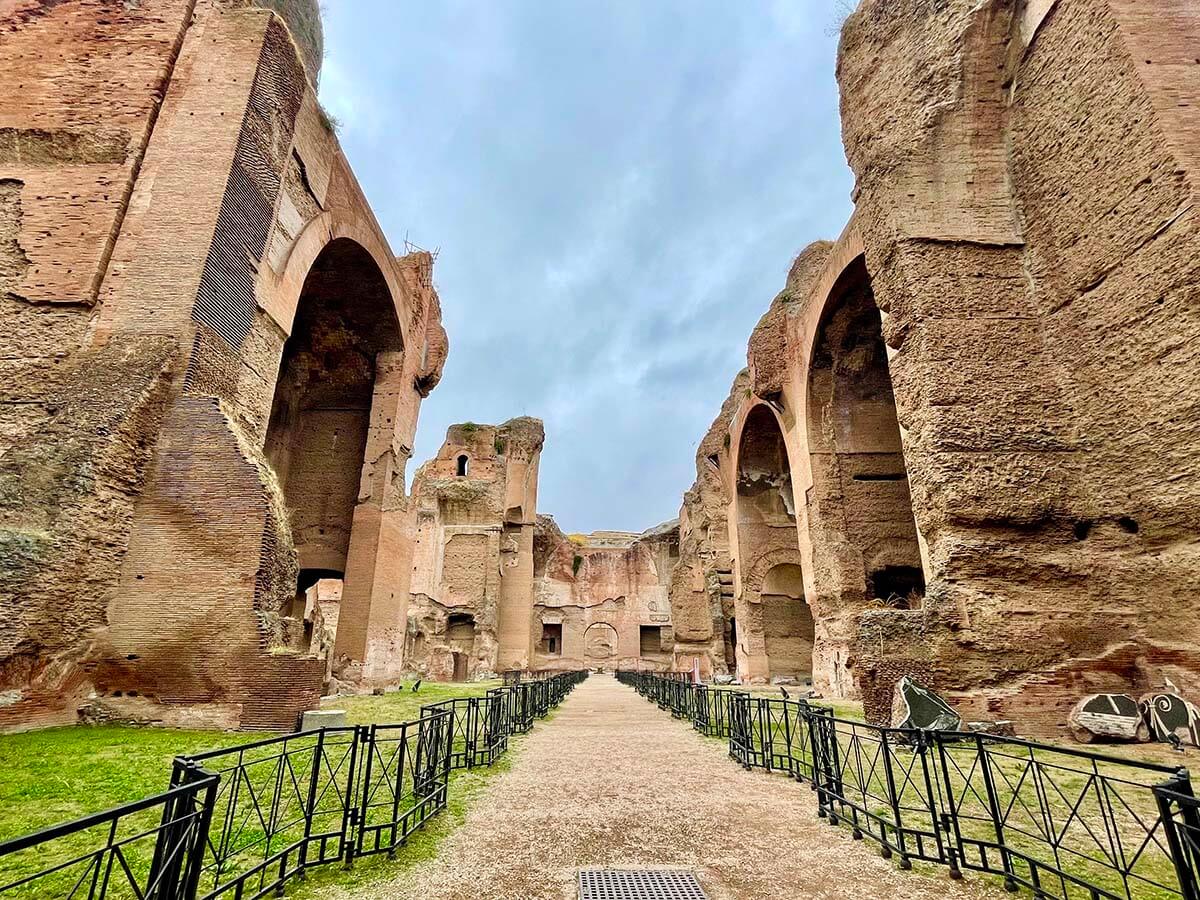
After visiting the Baths of Caracalla, you could see some of the lesser-known places in Rome . None of these is a must, but nice to do if you don’t mind a lot of walking and have some time to spare. You can visit all of them or just pick the ones that interest you the most.
TIP: You could also rent one of the electric scooters that you’ll find all over Rome for getting to these places. It would make it much quicker and easier.
4 – 5 PM: Pyramid of Caius Cestius and/or Aventine Hill
The Pyramid of Caius Cestus is about 20 minutes walking distance from the Baths of Caracalla, and you pass some very local areas of the city. The Pyramid looks like the ones you see in Egypt and was actually built as a tomb in 18-12 BC. It is possible to visit the Pyramid inside, but it’s only open a few weekends per month and requires an advance booking, but you can just see it from the outside, as we did.
Next to it, there’s also an old 3rd-century city gate, Porta San Paolo , part of the old city walls. There’s a small museum here and you can walk up to the top of the tower for nice views.
Next, head to Aventine Hill . Best known for the Knights of Malta Keyhole , there are also several churches here and the Orange Garden ( Giardino degli Aranci ) offering nice views of Rome.
The keyhole is the main attraction here and it is exactly as it sounds – a keyhole in an old door. But what makes it special is that through it, you can see the view of the green garden pathway with St. Peter’s Basilica perfectly framed in the middle.
This is one of the more popular hidden gems of Rome and often, there’s a long queue of people waiting to look through this keyhole. I’ll let you decide if it’s worth your time waiting in line for it, but a visit to Aventine Hill is worth it either way. The three churches are really interesting to see, especially Basilica di Santa Sabina all’Aventino , and also the city panorama from the nearby gardens is really nice.
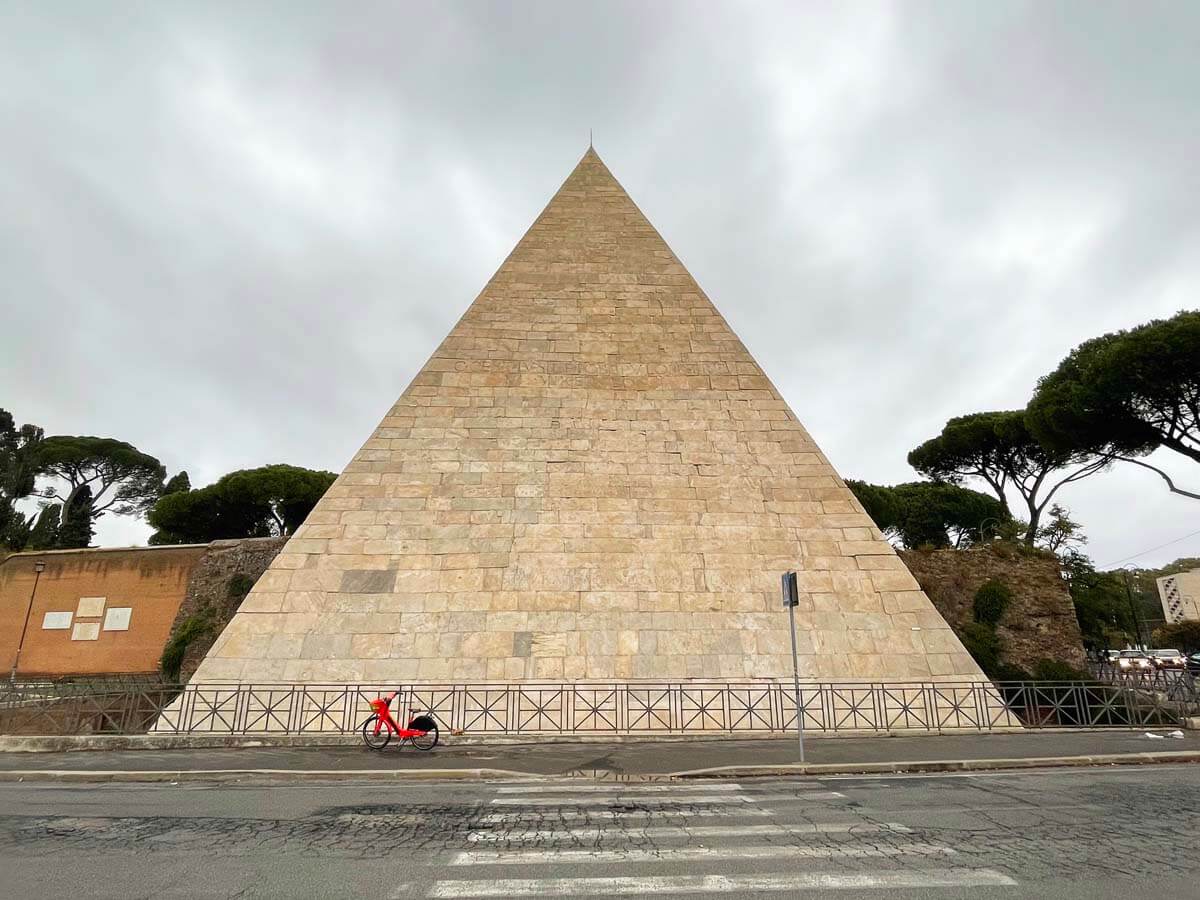
5 – 5.30 PM: Mouth of Truth
Finally, head back towards the river and the city center and stop at Santa Maria in Cosmedin church . Here you’ll find the Mouth of Truth ( Bocca della Verita ), a marble face with an open mouth. The legend has it that the mouth will bite off the hand of any liar.
In the past, you could just stop by here, put your hand in the mouth, take a picture, and move on. However, it’s become a very popular tourist attraction, and so also here, you’ll have to stand in a long queue in order to take a picture with your hand in it. There’s now even a small gate, a donation box, and staff keeping an eye on the crowds and regulating ‘traffic’.
We chose not to waste our time in line and took a picture of the mouth through the gate (you can see it from the street). The church itself is also nice to see, and there’s also an underground crypt of Pope Adrian I (8th century) that’s quite interesting as well. If you don’t have to stand in line for the Mouth of Truth, a visit here will only take 5-10 minutes.

6 PM: Trastevere & Dinner
Trastevere is one of the nicest (local) neighborhoods in the center of Rome. The name Trastevere comes from ‘ trans Tiberim ‘, which means ‘beyond the Tiber’. And indeed, it’s located on the other side of the river, just over the bridge from the Mouth of Truth.
This is a really nice area with narrow cobbled streets, colorful houses, countless restaurants, cafes, and bars. If you are looking for a nice place to have dinner, Trastevere is the best foodie area in Rome!
Before heading to dinner, you could also visit a few churches here. The most famous is Basilica di Santa Maria in Trastevere , located on the most picturesque little square. Don’t miss it!
Also check out Basilica Santa Cecilia in Trastevere – a real hidden gem, best known for the sculpture of St. Cecilia that was originally found in the Catacombs of St. Callixtus (and that we recommend visiting – see day 4 of this itinerary).
TIP: If you like exploring with the locals, you could book a food tour of Trastevere . It covers some of the landmarks of the neighborhood, plus you get to taste some delicious food as well. There are normally tours starting at around 5-7 PM, so it’s possible to fit it into this itinerary.
Or simply find a nice restaurant and enjoy a quiet dinner – you definitely deserve it after all the walking! Some of the best places to eat in Trastevere are Trattoria Da Enzo al 29 (close to Basilica St Cecilia) or Osteria Nannarella (close to Basilica St Maria). Be sure to try fried artichoke ( carciofi alla giudea ), one of the local specialties.
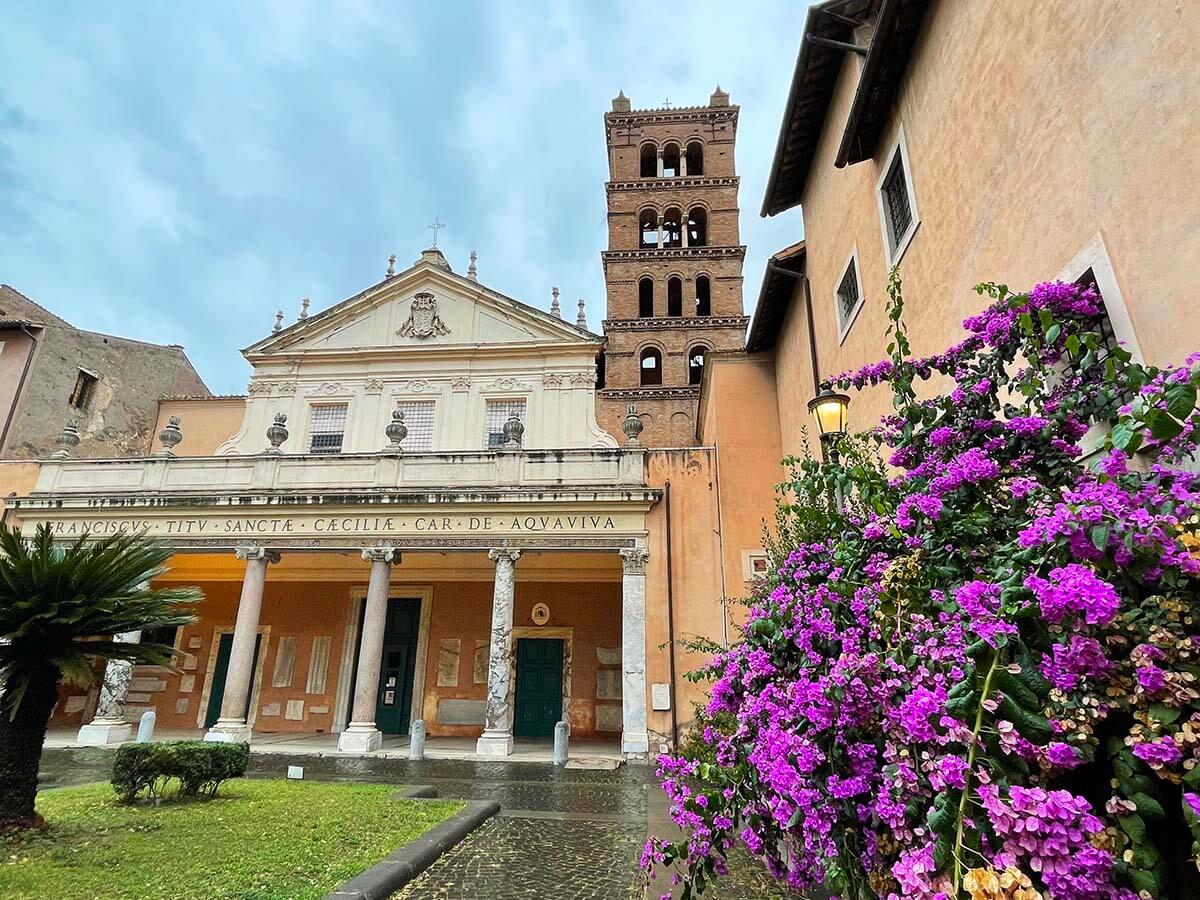
Day 2: The Vatican, Food Tour & Jewish Quarter, Historic Center
PLANNING TIP: Be sure to check if the Vatican is open on the day you want to visit and reserve your tickets / tour for the Vatican Museums (Sistine Chapel) online! See below for the best tour suggestions. The tickets are timed and they always sell out at least a few days in advance. Also, be sure that you wear clothing that covers your knees and shoulders! Also be sure to book the food tour in advance!
Here’s how you could plan your day:
Early morning: St. Angelo Bridge & Castel Sant’Angelo
If you walk to the Vatican from the city center, you’ll pass the Sant’Angelo Bridge and Castel Sant’Angelo . This area gets crowded during the day, but if you come here early, you’ll be able to enjoy it without the crowds.
TIP: Some of the best views of the St. Angelo bridge with St. Peter’s Basilica in the background are seen from the Umberto I Bridge and the southern side of the river between the two bridges.
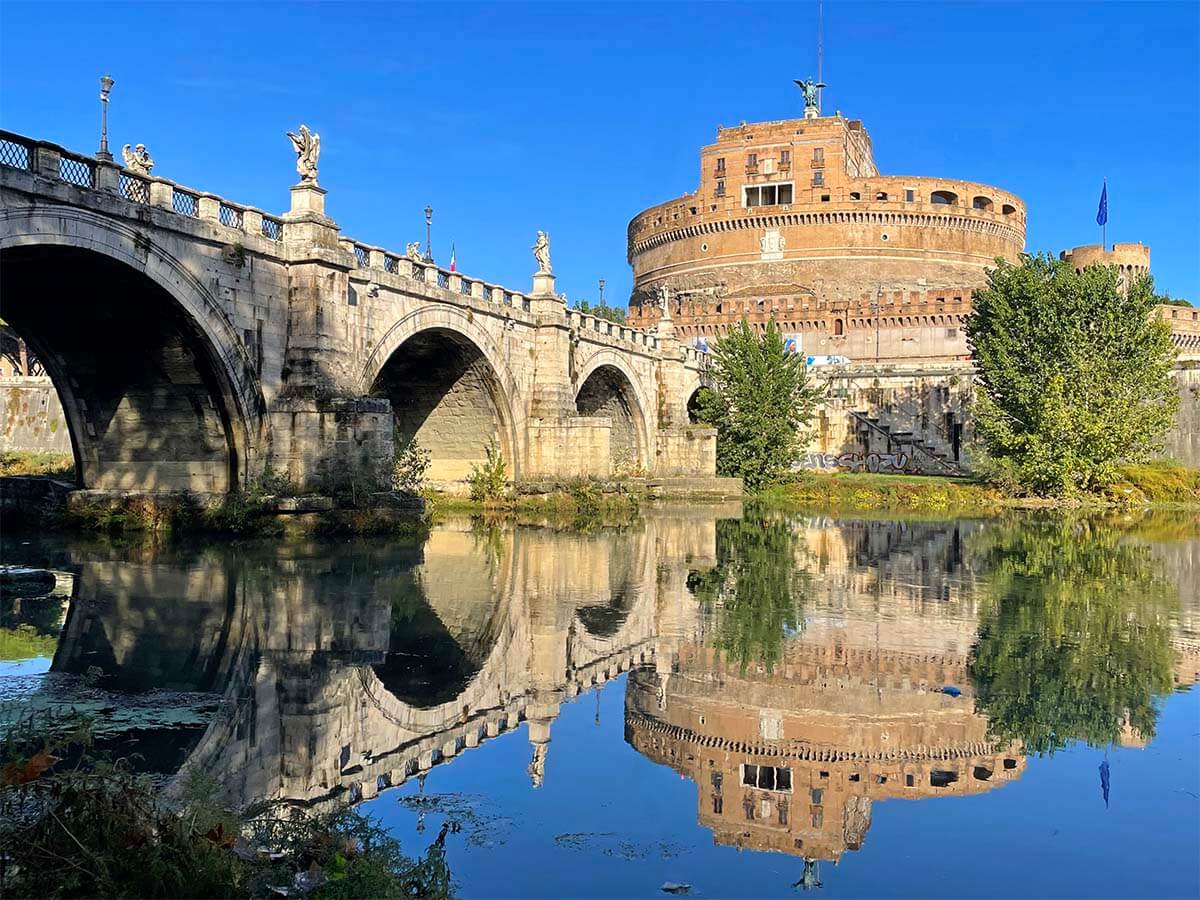
Morning: Vatican Museums & Sistine Chapel
Together with the Colosseum, the Vatican Museums (where you’ll find the famous Sistine Chapel ) is the most popular tourist attraction in Rome. It’s essential to book your tickets (or a tour) in advance!
Sometimes, if you didn’t think to book in advance and all the regular entrance tickets are sold out, you can still visit with a tour (they have separate access to tickets).
We have been to the Vatican Museums with a tour in the past, and so on this 4-day Rome trip, we just got the regular tickets instead of taking a guided tour. Big mistake! Next time, I’d definitely go with a tour. Here’s why.
Our experience: Once you enter the museums, you find yourself in a beehive with a labyrinth of halls and corridors and staircases… And yes, you get a plan and there are signs pointing to some parts of the museum, but it’s absolutely not clear where to go. All the routes point to Sistine Chapel and so eventually, you do get there (and see a lot along the way), but you have no idea what exactly you are seeing, whether you have missed something or not, and what’s worth it the most…
TIP: So if you want to save yourself all the stress and be sure that you see the best that the Vatican Museums have to offer, consider going with a guided tour . I’m a bit hesitant to recommend a guided tour with the official guide of the museum because we saw lots of frustrated people inside who were sent from one place to the other, looking for the official group tours. Instead, you can book a tour with one of the local companies (see below). That way, you meet your guide outside, enter the museums together, and can actually relax and enjoy your visit.
Here are 3 of the best tours of the Vatican:
- Early Entry to the Vatican & the Sistine Chapel . If you want to see the Sistine Chapel at its quietest , this is the best tour. It starts very early but gives you an extraordinary experience, incomparable to any regular daytime tours. In addition, this tour visits St. Peter’s Basilica and enters it directly through the museum saving you lots of time.
- Skip-the-Ticket-Line Vatican Tour and Sistine Chapel . This is the most popular (and great value) tour of the Vatican Museums & St Peter’s Basilica. A good alternative to visiting on your own.
- Early morning tour that includes everything + the dome . This tour includes ALL the musts of the Vatican : St. Peter’s Basilica with a visit to the underground crypts and the dome climb + the Vatican Museums & Sistine Chapel.
UNIQUE EXPERIENCE: VIP Key Master’s Tour – on select days, it’s possible to visit the Sistine Chapel with a Key Master as he opens the galleries of the Vatican Museums. You spend two hours inside with just a handful of people in your group – it’s a very unique experience (but also with a very high price tag and limited availability). A similar tour is also available through this company but it’s only bookable once or twice a month.
Good to know: The Vatican Museums are closed on Sundays, except on the last Sunday of the month when they are also free to visit (expect even bigger crowds if you visit on a free day). The museums are also closed on most religious holidays and on some other occasions.
When you pre-book your tour or tickets, you’ll immediately see if the date of your choice is not available, and can adjust your itinerary at that time.

Noon: Lunch near the Vatican
After your visit to the Vatican Museums, you’ll definitely want to sit down and rest your legs. All that slow walking is really tiring…
There are several restaurants and a café inside the Vatican museums, so you could have lunch there. But there are also quite a few nice restaurants in the nearby neighborhood. We chose to dine at one of the local restaurants.
We had lunch at La Locanda di Pietro , just a few minutes walk from the museum. It’s a very nice local restaurant with very friendly staff and truly good food. There are quite a few good restaurants in this area. For low-key simple Italian dishes, check out Ristorante dei Musei , or – if you prefer something different- head to La Cucaracha which serves Mexican food.
TIP: Try to go for lunch at around noon. When we visited, most restaurants were still quiet at 12, but half an hour – an hour later, there were hardly any free tables left (and only inside).
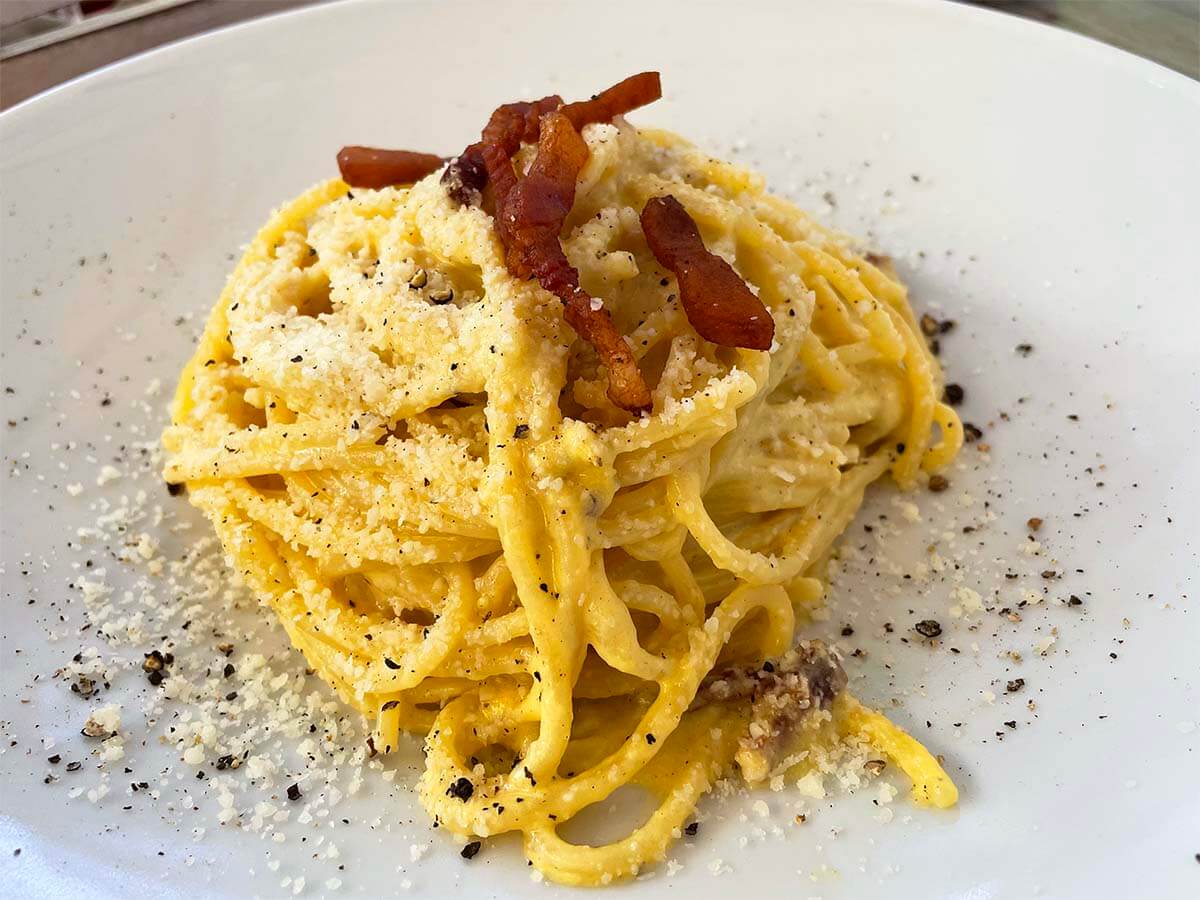
1.30 – 4 PM: St. Peter’s Square & Basilica
Unless you book a tour of the Vatican Museums and St. Peter’s Basilica together, I recommend visiting St. Peter’s in the afternoon. In fact, the later in the afternoon you go, the quieter it usually is.
We booked this tour of the Basilica that included a Dome Climb and the Underground , and it started at 2 PM. So after lunch, we headed to St. Peter’s Square , explored it a bit on our own, went to see the Swiss Guards , and sent some postcards from the Post of the Vatican .
At 2 PM, we met our guide and waited for about 15-20 minutes (security line) to enter the Basilica. The lines weren’t nearly as bad in the afternoon as they were in the morning. While you don’t really need a guide to visit the church (and the entrance is free of charge), we actually enjoyed having a guided tour here. Our guide told us so many stories and explained so many things that we would have totally missed otherwise (and actually did miss on the previous visits here).
TIP: If you go without a tour, consider getting an audioguide – that way, you can better appreciate what you are seeing.
We then visited the crypts where some of the Popes are buried. You can also see St. Peter’s Tomb here, but only the tomb that’s officially accessible to the public (the actual St. Peter’s tomb is located yet deeper under the Basilica and can only be visited with official Vatican tours if/when they run and are very limited in numbers).
After exploring the church, you can opt to go to the top of the Dome . Our tour included this, but if you go on your own, you can do this as well. The entrance is located on the far right side of the church and you can buy a ticket here. You can opt for the stairs or the elevator. We suggest taking the elevator to the rooftop because you’ll still have to do over 330 steps to the actual top of the Dome.
A visit to St. Peter’s Dome is one of the most special things you can do at the Vatican. So if you are fit enough for the 330 stairs (up and then down again), don’t miss it! Not only can you see the rooftop of the Basilica and stunning views of the Vatican and the city from the Dome, but you also get to walk inside the actual dome with the whole church right under your feet. People look like little ants from this height and you realize once more how colossal the building is.
A very unique experience!

4.30 PM: Campo de’ Fiori
After the Vatican, head back to the city center and walk to Campo de’ Fiori . It’s about 25-30 minutes walk.
Campo de’ Fiori is one of the nicest town squares in Rome and a bustling market. Visiting here in the afternoon, you can actually see the square and not just umbrellas and the food stalls.
In the center of the square, you can see a statue of Giordano Bruno . He was a 16th-century philosopher who was burned here for his progressive thinking.
However, it’s also a special experience to see the Campo de’ Fiori market when it’s open. So if there’s no market anymore when you visit here in the afternoon, I recommend coming back here the next morning as well. See more info on day 3 of this itinerary.
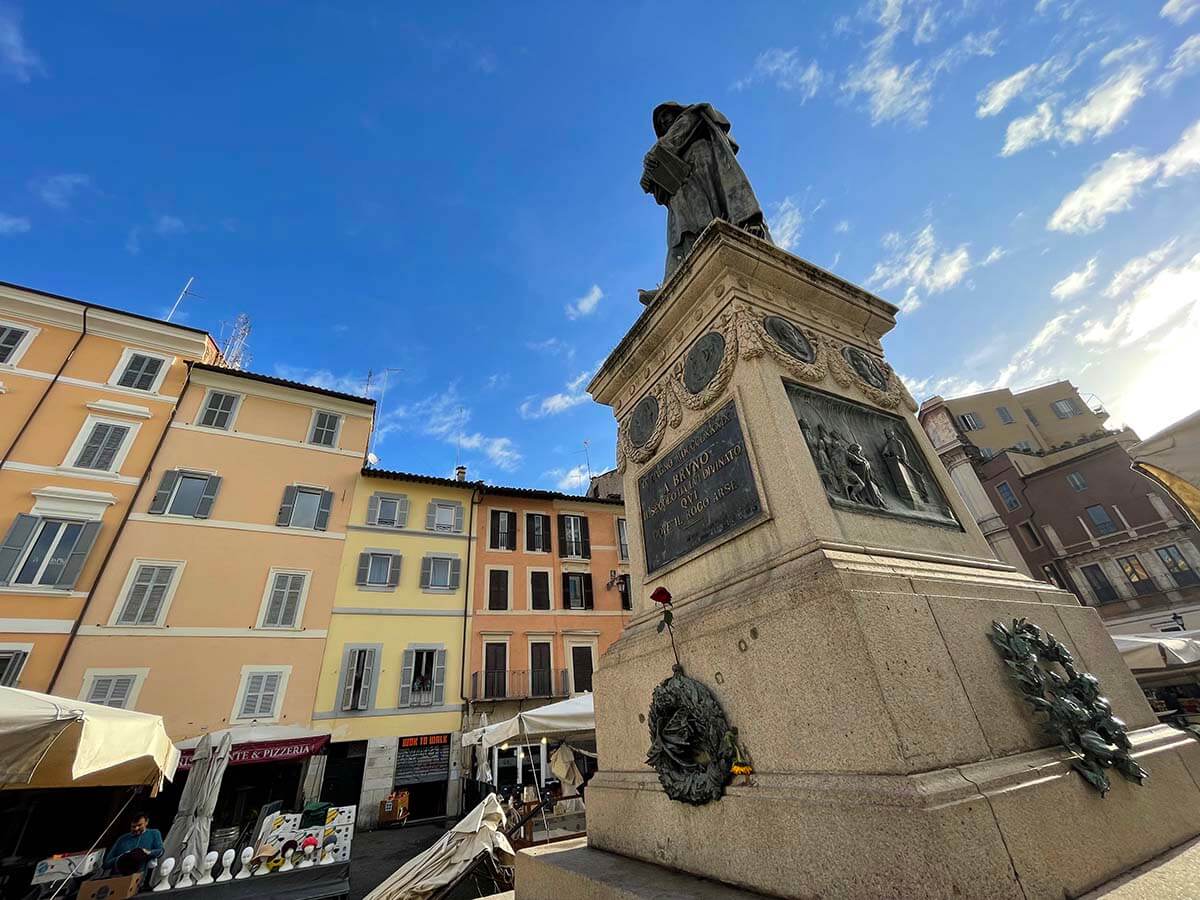
5 – 8 PM: Street food tour & Jewish Quarter
The street food tour was one of the best experiences of our 4-day visit to Rome. If you want to discover a more local side of Rome, I highly recommend taking a food tour! It’s such a great way to get a bit off the beaten path and taste some local specialties.
We’ve been to Rome many times before, but we still learned new things, tasted some of the most delicious food, and saw some places we would have never seen on our own.
We took this highly-rated food tour and I can highly recommend it! The tour starts at 5.15 PM at Piazza del Biscione, which is a tiny town square right at the northeastern corner of Campo de’ Fiori. Be sure to check the starting times and location at the time of your visit, in case something would have changed!
On this tour, you visit a traditional food store from the 19th century and still run by the same family, have Roman pizza, and try other regional specialties at several excellent local restaurants. Our tour also included a tasting of Italian wine, local beer, and delicious gelato. They can also cater to people who have special dietary requirements and, of course, alcoholic drinks can be replaced by water or soft drinks.
We also passed some really nice local areas and also visited the Jewish Quarter (Ghetto) . Together with Trastevere and Testaccio (a bit further away from the center), this is one of the best neighborhoods for food in Rome. If you are still hungry after the tour (can’t imagine you would be, but you never know), this is a nice place to come back for dinner. Or come here at another time, as we did.
The tour also visits Largo di Torre Argentina and ends close to the Pantheon. It takes about 2.5 hours.
LEARN MORE: Rome Street Food Tour: Review & Tips
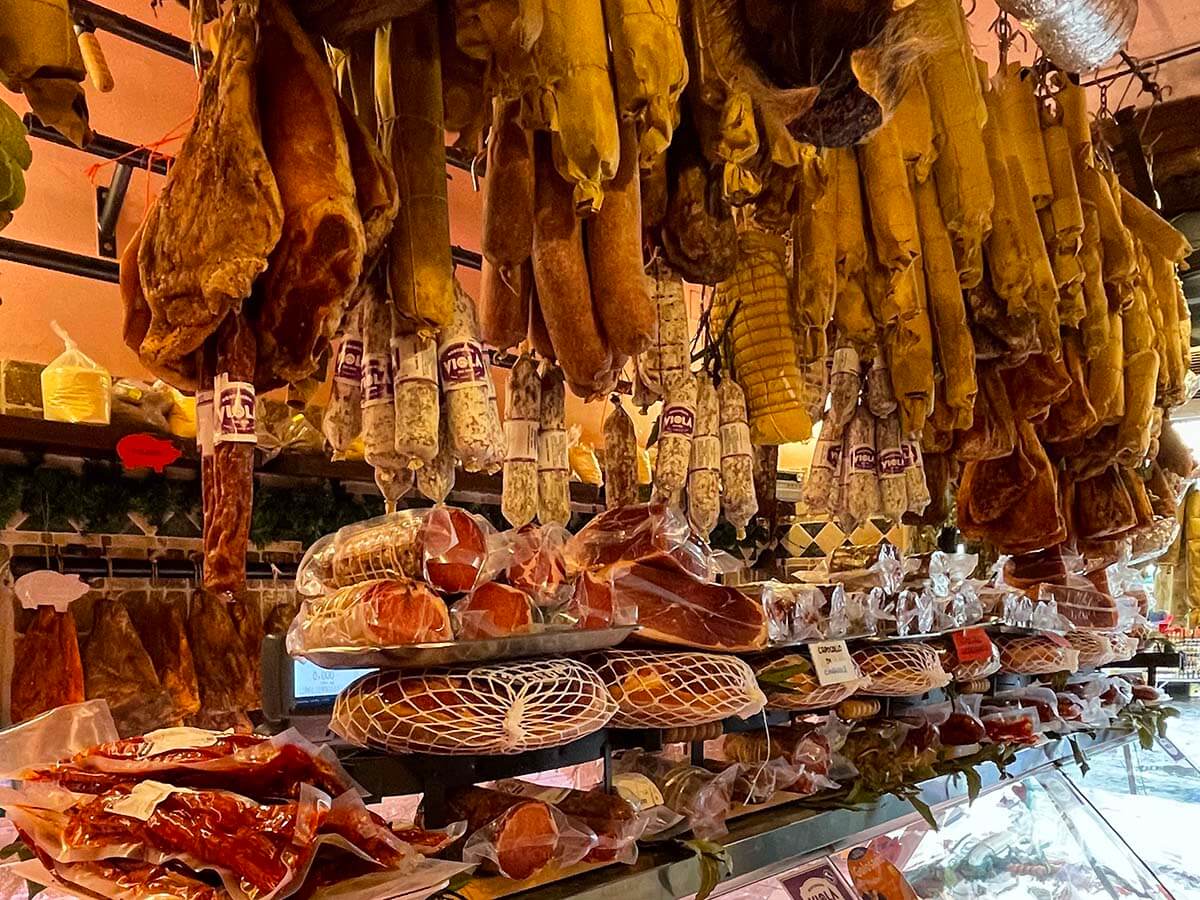
Evening: Explore the historic city center in the dark
If you still have some energy afterwards, walk around the city center and see Piazza Navona, the Pantheon, and Trevi Fountain nicely lit in the dark .
How dark it actually is will, of course, depend on the season when you visit. In November, it gets dark at 5 PM, whereas in June, it stays light until after 9 PM.
TIP: If you still have some space left for another gelato, check out Giolitti or Gelateria Della Palma – these are the two best places for ice cream in Rome. We stopped for ice cream here every time we were around…
We ended our day with some drinks on the beautiful rooftop terrace of our hotel . I think you can also come here for drinks even if you are not a guest at the hotel, but I’m not 100% sure. The drinks are quite expensive compared to the prices at the nearby restaurants though. But if you aren’t having dinner (not likely you’ll still be hungry after the food tour), it’s actually not easy to find a restaurant that will want to seat you just for the drinks. So for that, this bar is perfect.
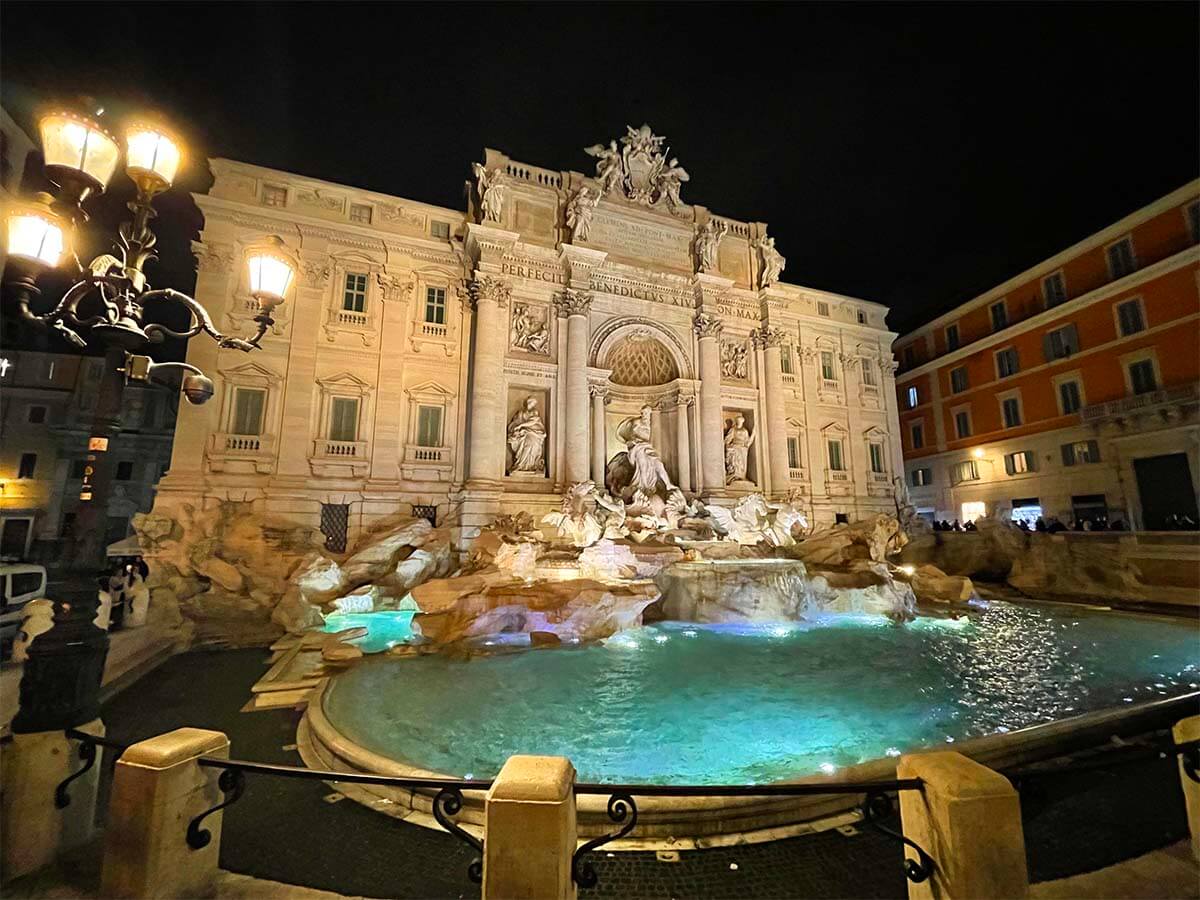
Day 3: Campo de’Fiori, Pantheon, Doria Pamphilj, Capuchin Crypt, Villa Borghese, Terrazza del Pincio, Piazza del Popolo, Shopping, Spanish Steps
PLANNING TIP: Reserve your tickets or a tour of the Borghese Gallery in advance! You may also want to prebook a timed-entry slot for the Pantheon .
Early morning: Campo de’Fiori
In the past, a field of flowers (thus the name), nowadays Campo de’ Fiori is a bustling food market. The market is open Monday to Saturday, usually from around 7 AM to 2 PM.
The market is really touristy, but locals shop here as well. You’ll find stalls selling fruits, vegetables, cheese, meat, pasta, Italian limoncello (and other colorful drinks), and also flowers.
It’s always a nice place to visit when in Rome. The market is lively and colorful, you can buy all kinds of food, fruit, and also stock up on some (edible) gifts to take home.
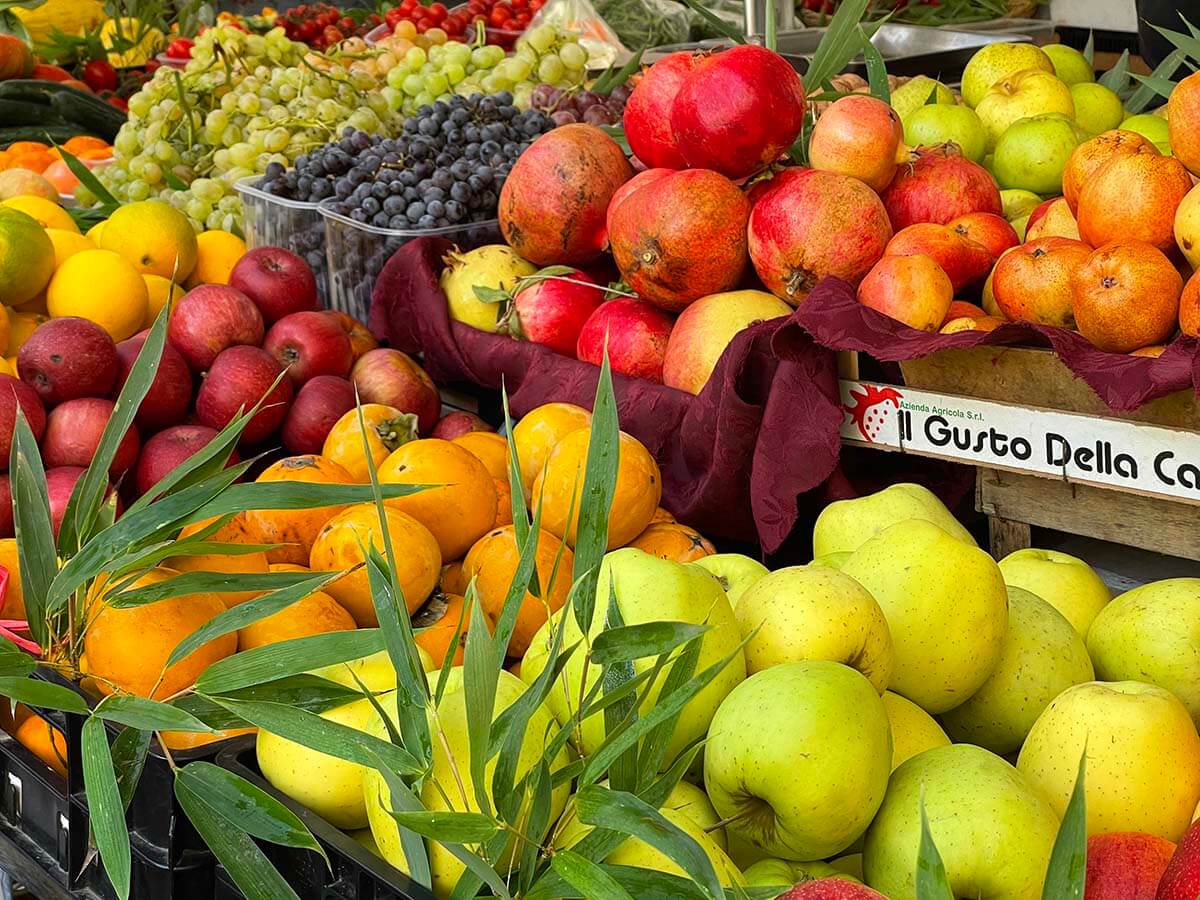
9 AM: Pantheon
You will have passed the Pantheon several times by now, but it’s one of those places that you really should visit inside. Seeing the famous dome with a hole (oculus to the sky) in the middle is a must when visiting Rome!
Originally built in 27 BC and rebuilt in the 2nd century, the Pantheon is probably the best-kept monument from the old Roman times. The name ‘Pantheon’ means ‘temple of all the gods’ and – originally – it was a pagan temple indeed. In 609, Roman emperor Phocas gifted the Pantheon to the Pope, and it was turned into a church. This is one of the reasons why it’s still so well preserved.
A visit to the Pantheon doesn’t require much time. However, it’s always busy here, so if you don’t want to waste too much time, be sure to come here well before it opens.
Good to know: Nowadays, there is an entrance fee to visit the Pantheon. It’s also possible to book a timed-entry ticket in advance, however, getting the earliest time slots is not easy. You may want to check the official website and also Tiqets and GetYourGuide to see what’s available for your travel dates. In any case, keep in mind that you have to pick up the actual ticket at an external location (they do like to complicate things more than necessary…).
Alternatively, you can just stand in line and hope to get in without too much of a wait (in that case, arrive at least half an hour before it opens). Or make it easy for yourself and book a guided tour (likely later than 9 AM though, so you’ll have to adjust this itinerary accordingly).
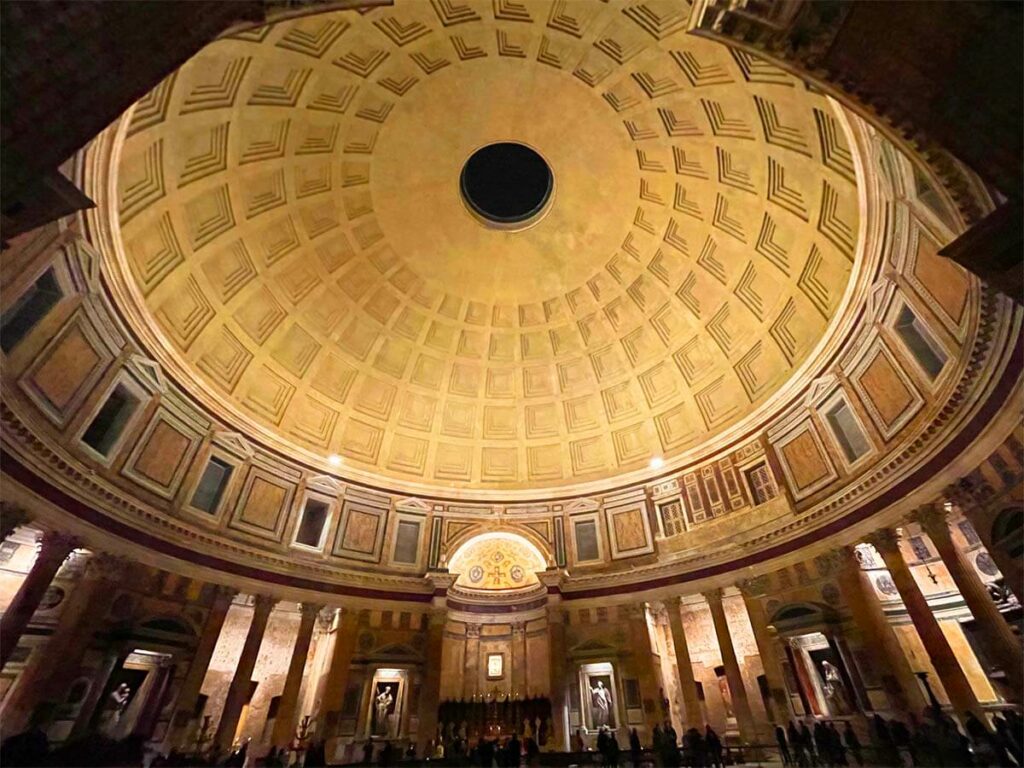
10-11 AM: Doria Pamphilj Gallery
One of the hidden gems right in the historic city center, Doria Pamphilj Gallery is a private art collection that belongs to the princely Doria Pamphilj family. This is one of the largest and most impressive private art collections in Rome and it’s open to the public.
This vast art collection was started in the 16th century and contains a large number of paintings, furniture, and sculptures. You can see various works by Caravaggio, Raffaello, Velázquez, and many other famous Italian artists. But what makes it truly special is the sheer number of pieces of art covering the walls from the floor all the way to the ceiling.
TIP: Be sure to pick up an audio guide at the entrance (included with your ticket). It’s a great way to learn more about the palace, the art collection, and the family behind it. The English narrative is spoken by Jonathan Doria Pamphilj, and he shares some fun stories and anecdotes about the family as well.
Good to know: Doria Pamphilj Gallery is located in a 17th-century Palazzo Doria Pamphilj, about halfway between the Pantheon and the Trevi fountain, about 7 minutes walk from either of the two. It’s open daily from 10 AM. Their website says that you need to prebook the tickets in advance (and they are non-refundable). In the low(ish) season, we were able to visit without an advance booking. During busy times, you may have to wait for a while if you don’t have a reservation.
TIP: If you want to be sure to visit when you want to, but also have the flexibility to cancel, you can book cancelable tickets here .
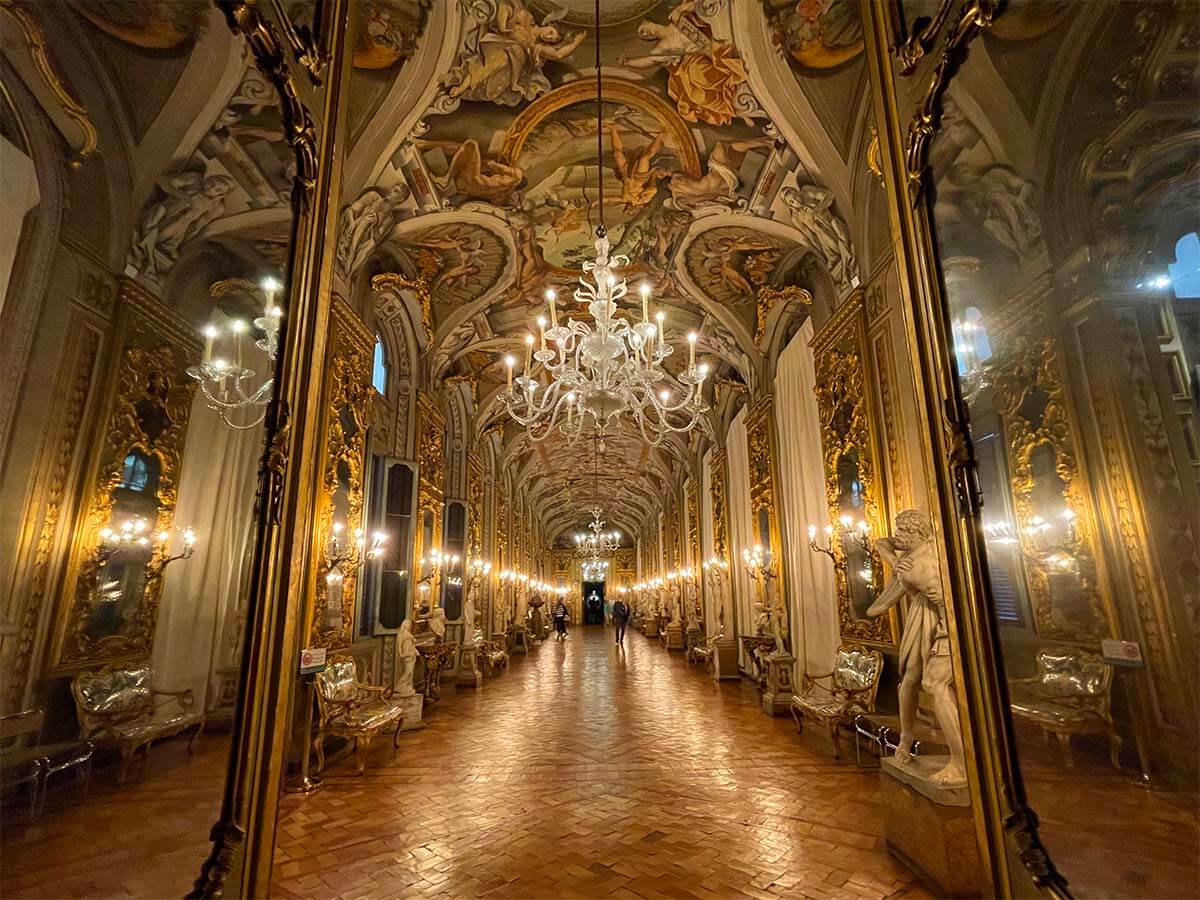
11 AM: Galleria Sciarra
As you walk from Doria Pamphilj Gallery to the Capuchin Crypt (about 15 min walk), you’ll pass another nice secret gem of Rome, Galleria Sciarra . Located just steps from the famous Trevi Fountain, this beautiful place is completely overlooked by most tourists.
Galleria Sciarra is a small glass-covered gallery/patio with beautiful frescos pained on all the buildings surrounding the courtyard. It dates from the late 19th century and is a fine example of the Art Nouveau style.
Good to know: The courtyard is always open, accessible, and free. A visit here only takes a minute or two, so definitely take a look inside!
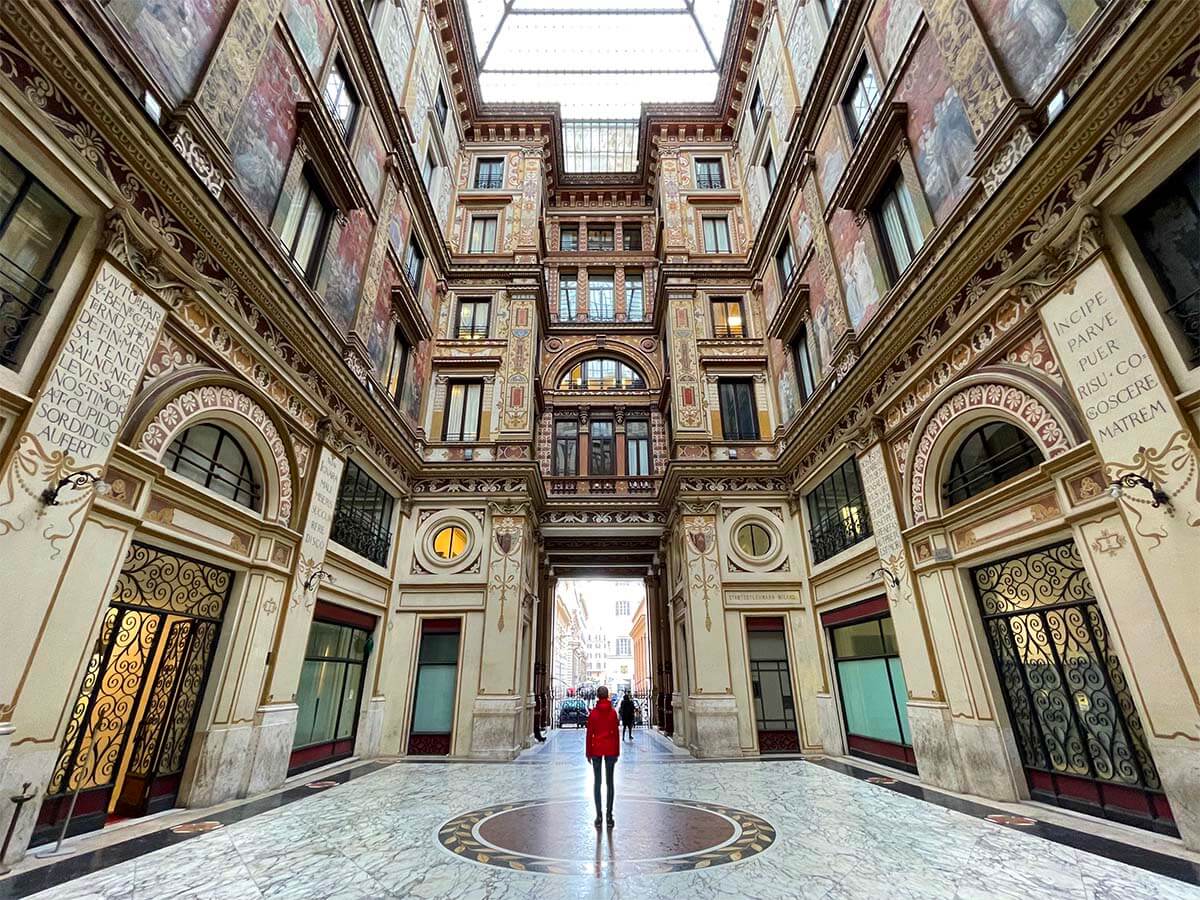
11.20 – 11.50 AM: Capuchin Crypt
If you like quirky places, you may want to check out another interesting hidden gem of Rome, the Capuchin Crypt (Museo e Cripta dei Frati Cappuccini).
The 500-year-old monastery houses a small museum telling more about the Capuchin monks and the history of the friary. But the main highlight are the underground crypts that contain really special and artistic creations made of human skeletons.
We’ve been to several bone chapels in various places in Europe in the past, but this one really stands out from the rest. There are several different crypts, each with its own unique ‘composition’, and it’s fascinating to see how someone created real art from human bones… It doesn’t even feel creepy or spooky, but more artsy…
Good to know: Capuchin Crypt is open daily from 10 AM to 7 PM, except on some public holidays, and you can just get a ticket at the entrance. More information on their website . They have an audio guide available and also run guided tours.
Lots of organized city tours include a visit here together with some other crypts and catacombs visits in Rome. But if you just want to see the crypts and the museum on your own, 20-30 minutes is more than enough time here.
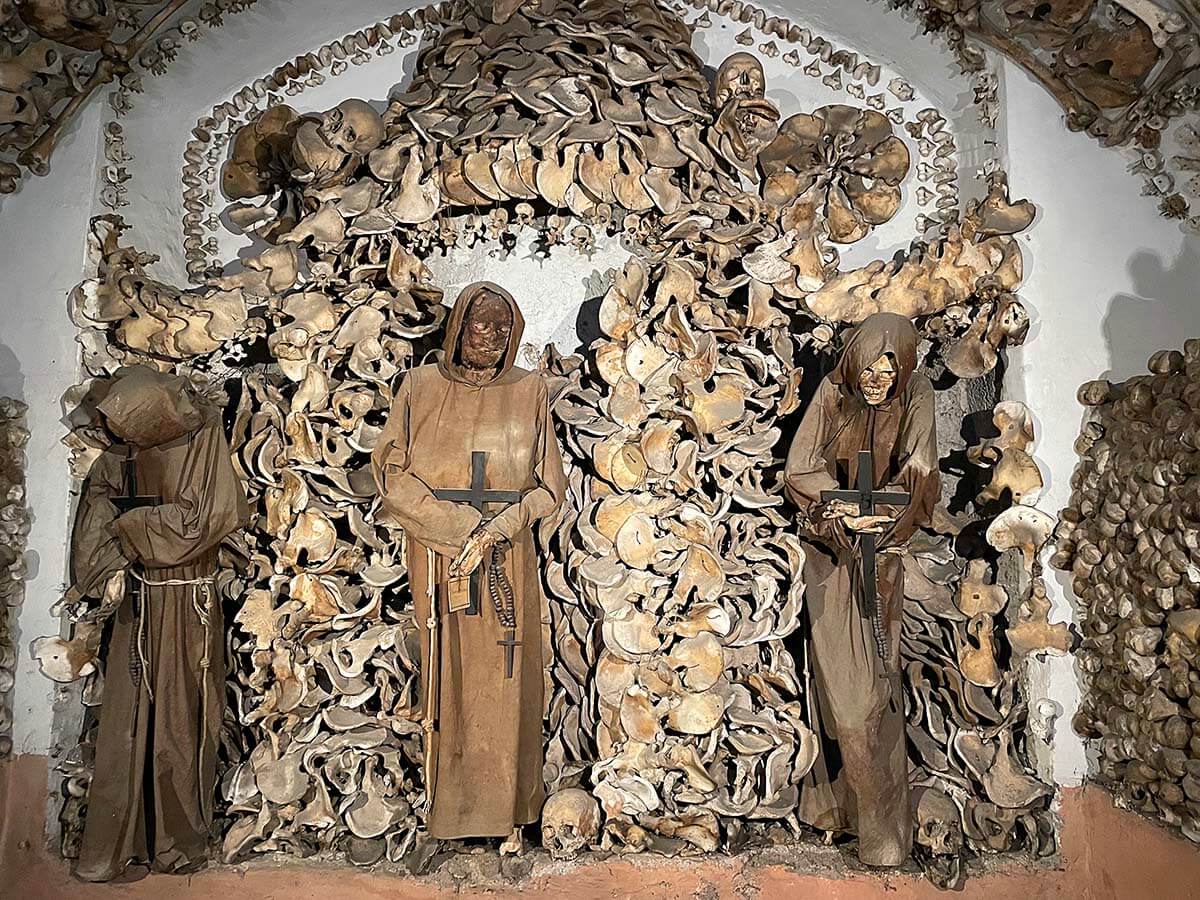
12 – 1.30 PM: Lunch
After visiting the Capuchin Crypt, continue in the direction of Villa Borghese Gardens (about 10 minutes walk to the entrance of the park or 15-20 minutes walk to the gallery).
On the way, you’ll pass several restaurants. If you are feeling nostalgic for some American food, you can stop at the Hard Rock Café.
Alternatively, there are plenty of local restaurants as well. If you don’t mind splurging a bit and are looking for something special, check out the historic Harry’s Bar . And there are lots of other cheaper and simpler places to eat in this area.

2 – 5 PM: Borghese Gallery & Gardens
Villa Borghese is a large landscaped garden, one of the biggest and most beautiful public parks in Rome. There is a lot to see and do in the park and you could easily spend half a day here, but the most famous place is the Borghese Gallery .
If you are interested in art, this is one of the best museums to visit in Rome ! Here, you can see a big collection of masterpieces by Caravaggio, Raphael, Canova, and many others. Also, the interior of the palace is absolutely impressive!
Good to know: The Borghese Gallery is very popular, the tickets are timed, and usually sell out long in advance (especially if you are visiting in high season). So if you want to be sure to visit here, it’s essential to reserve your tickets in advance!
You can opt for a regular entrance ticket , and there are also guided tours available that cover the museum as well as the beautiful gardens. A tour might actually be a good idea here since the gardens are really large and there’s a lot to see.
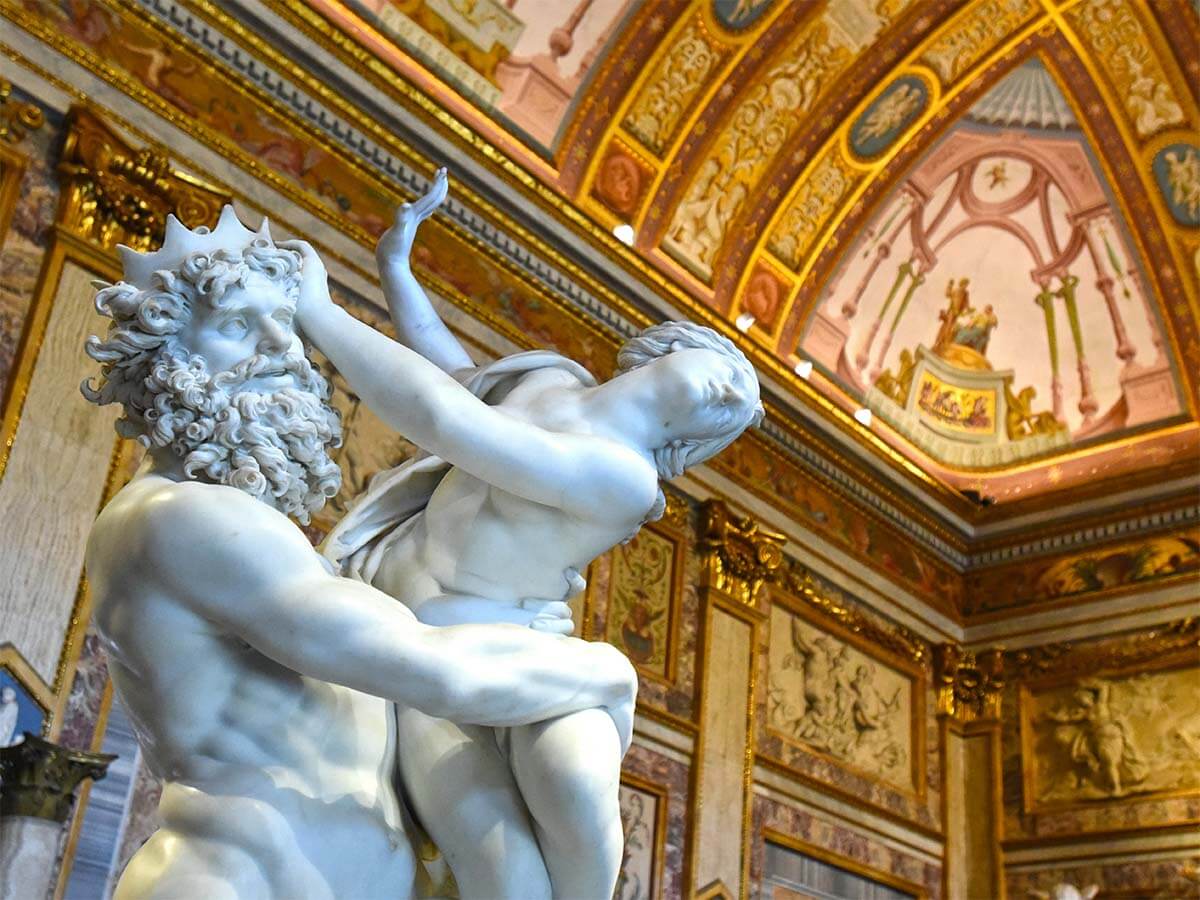
Alternative suggestion: If you are not interested in the museum or the gardens, or want to see as much as possible and don’t mind walking quite a bit more, you could also visit the Quartiere Coppedè nearby.
It’s a small neighborhood with some of the most special architecture you can find in Rome. You can read more about it in our guide to Rome’s hidden gems .
This beautiful but rather compact neighborhood is located about 20 minutes walk from Villa Borghese (so you need about 1 hour in total to walk there and back and see the highlights). However, if you could rent an electric scooter, you could probably visit in about 30 minutes.
It’s also easy to combine it with a visit to the Coppede district and that of the Borghese Gallery. It really depends on your interests and how much you are willing to walk.

5.30 PM: Terrazza del Pincio
Terrazza del Pincio is a popular viewpoint offering nice views of Piazza del Popolo, the city center of Rome, and St. Peter’s Basilica in the distance. This is a popular place to come at sunset too.
There are, in fact, two viewpoints here and the views are nice from both (the other one doesn’t have an official name and is located right under Terrazza Viale del Belvedere, but is often confused with Pincio Terrace). Anyway, I indicated them both on our map.
These viewpoints are located about 15-20 minutes walk from the Borgese Gallery, and the walk through the park is really nice in itself.
From Terrazza del Pincio viewpoint right above Piazza del Popolo, take the stairs on the right side and walk down to this town square.
READ ALSO: Best Views & Viewpoints in Rome
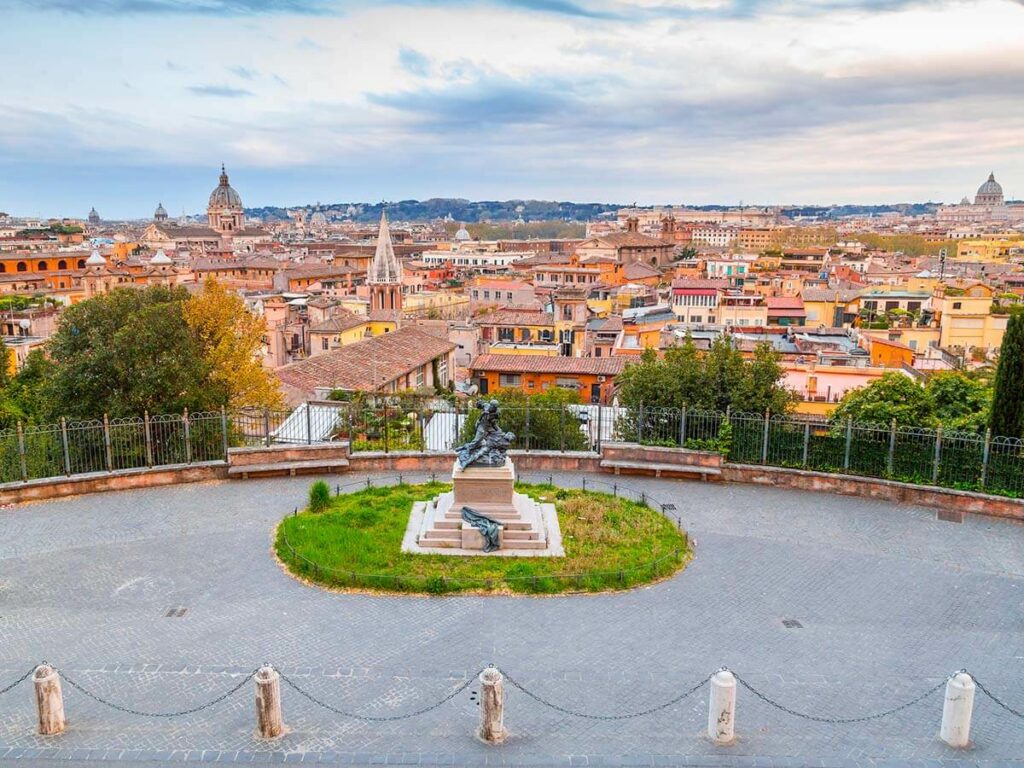
6 – 7 PM: Piazza del Popolo & Shopping Streets
Piazza del Popolo (the People’s Square) is one of the largest and best-known town squares in Rome. Located at the Aurelian city walls, there’s still an impressive city gate here.
If you are coming from the hill at Terrazza del Pincio, the city gate will be on your right. If you want to experience the ‘wow’ effect of the square as first-time visitors to Rome did in the past, you can walk through it and come back to the square that way, but it’s really impressive either way.
Piazza del Popolo is a place where three big streets come together. In the center of the square, you can see an Egyptian Obelisk and the Fountain of the Lions . There are two other fountains with impressive statues at the sides of the square. And it’s also flanked by two impressive churches Santa Maria dei Miracoli and Santa Maria di Montesanto .
The area to the south of Piazza del Popolo is one of the most popular shopping neighborhoods in Rome . You’ll find all kinds of fashion stores here – from the cheaper main street brands to the most expensive designer stores like Gucci, Prada, Dolce & Gabanna, Tiffany & Co, and pretty much any other big name in the fashion industry.
The most famous shopping streets are Via del Corso (popular brands) and Via dei Condotti (high-end designer shops), but the whole area is really a shoppers’ paradise. If you are more interested in sightseeing than shopping, check out Via Margutta . It’s a very picturesque and much quieter street that became famous thanks to the film Roman Holiday .
Good to know: Most stores here are open until 7.30-8 PM, but if you are planning to do some shopping here, you’ll probably want to come earlier. You could easily spend an entire day here too, but with just 4 days in Rome, I’d only come here to do some window shopping.
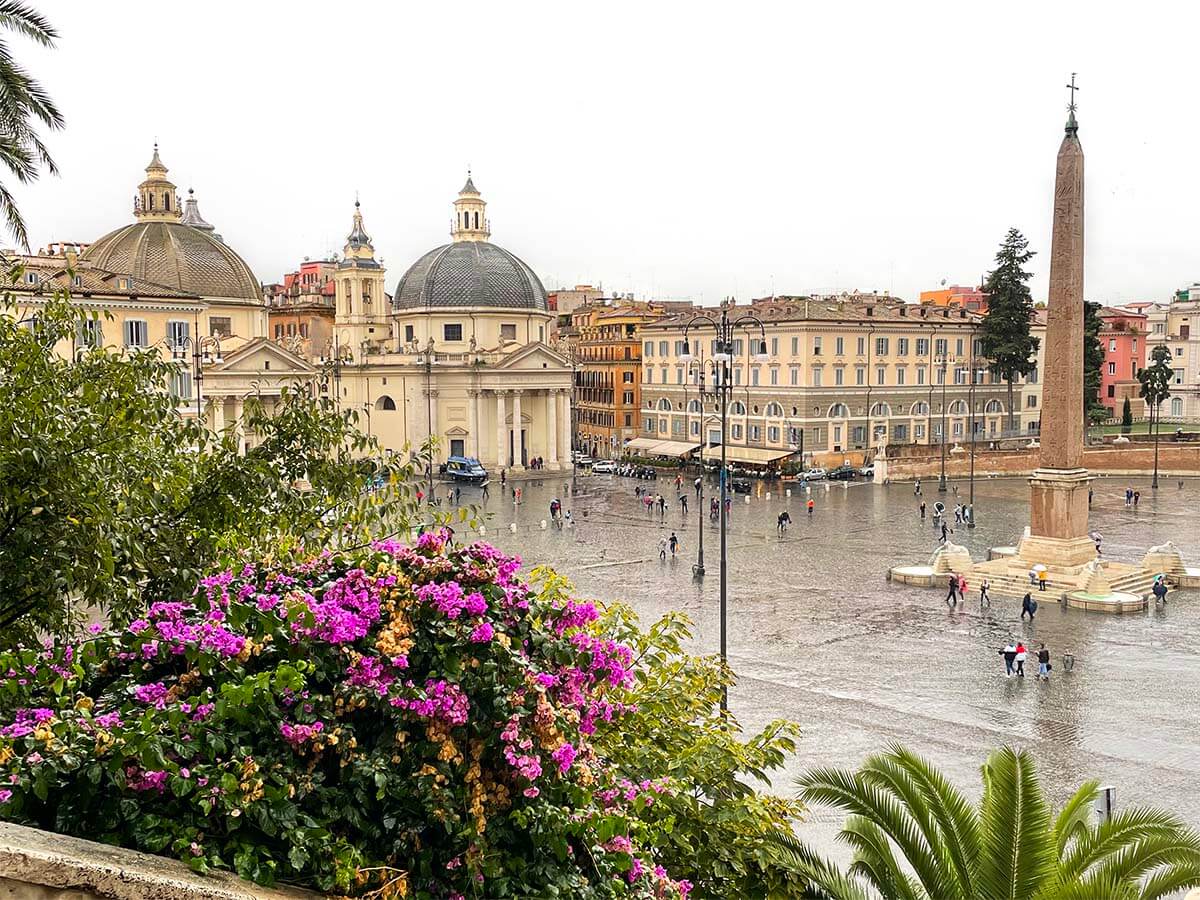
7.30 PM: Piazza di Spagna, Spanish Steps & Dinner
Piazza di Spagna and the famous Spanish Steps is one more of the ‘must-see’ landmarks in the historic city center that you really shouldn’t miss in Rome.
Surrounded by all the shopping streets, this is a very popular area that’s always crowded. In the summer, it’s often difficult to even see the staircase through the crowds. It is now, therefore, forbidden to sit or eat on the stairs.
If you take the staircase up, you’ll be walking in the direction of the Villa Borghese Gardens that you visited earlier today. At the top, there’s also a church – Trinità dei Monti – and you could visit inside if it’s still open.
But, frankly, the stairs are the most impressive when seen from the bottom and the interior of the church is not that special. There are some nice viewpoints at the top, but if you already visited Terrazza del Pincio viewpoint before that, going up the stairs is not really a must. Unless you are here at around sunset and want to see some nice twilight views from above – in that case, definitely go up.
TIP: For dinner with a view, check out Caffè Ciampini di Marco Ciampini , a short walk to the left at the top of the stairs. Otherwise, you will find lots of nice restaurants in the historic city center. I indicated a few nice restaurants on the map.
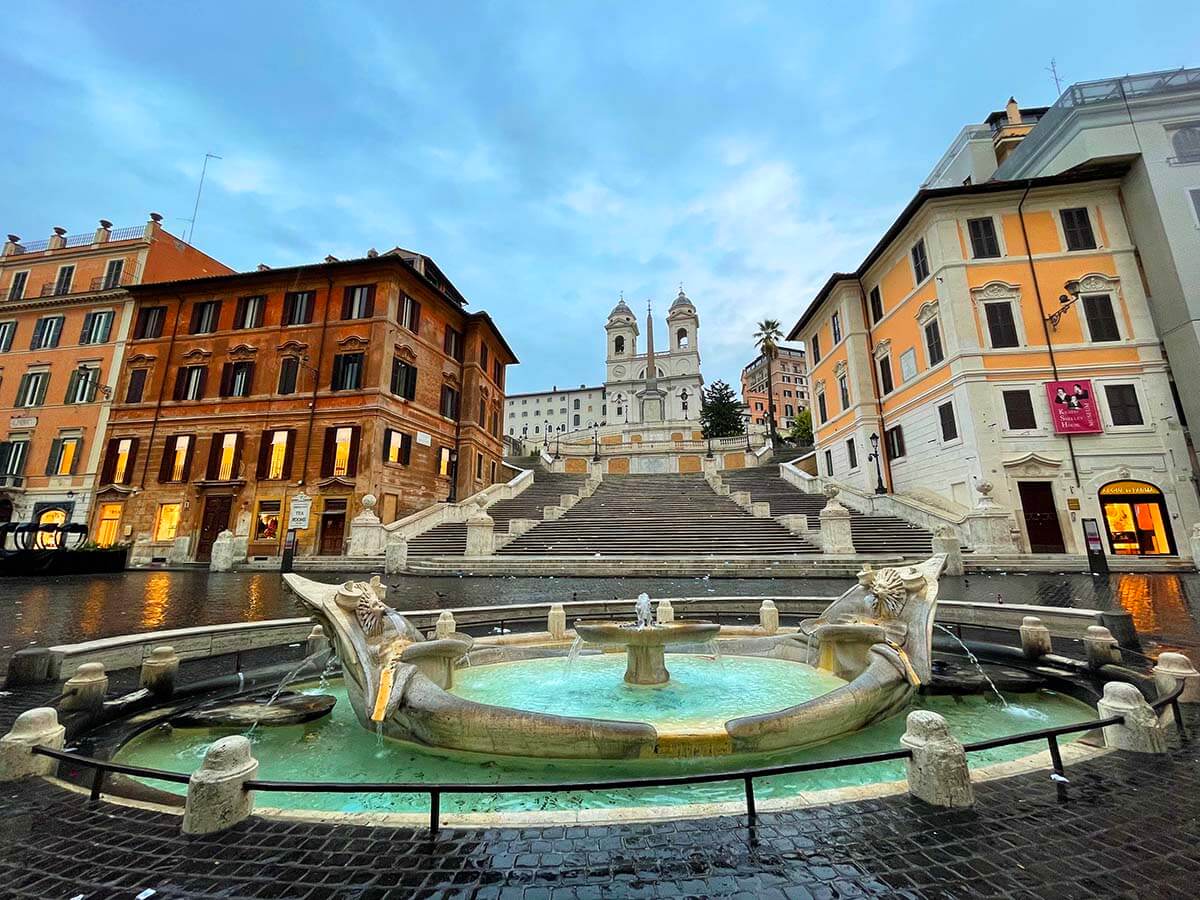
Day 4: Appian Way, Aqueducts & Catacombs tour, San Giovanni in Laterano, St. Clement Basilica, Basilica di San Pietro in Vincoli, Colosseum at sunset
PLANNING TIP: Book this e-bike tour in advance (possible for all ages). If biking isn’t your thing, this bus/ walking tour has a very similar itinerary and takes less time, but – at least at the moment, it only runs a few times a week and only in high season. Also, keep in mind that St. Callixtus Catacombs are closed on Wednesdays. You can still do the e-bike tour, but you’ll likely visit the Catacombs of Saint Sebastian instead.
9 AM – 3 PM: E-bike Tour of the Appian Way, Aqueducts & Catacombs
On the fourth day in Rome, we recommend that you get a bit outside the city and visit some of the ancient Roman sites nearby. The main highlights that are worth it the most are the Appian Way , the Park of the Aqueducts , and the Catacombs of St. Callixtus (or the nearby Catacombs of Saint Sebastian).
Hands down, this was one of our favorite days of the 4-day visit to Rome! So if you are comfortable on an e-bike, I highly recommend considering this tour .
There are other similar bike tours as well, but we chose this one because it has the most complete itinerary, includes (delicious warm) lunch, uses good quality electric mountain bikes, and has the best reviews. Also (take my word for this), you really don’t want to do the Appian Way with a regular bike!
I’m not going to list the complete itinerary of this tour, but below are some pictures that will give you a short overview of what you can expect to see. Since you go with a local guide, you have nothing to plan or worry about. Just enjoy the day and soak in the incredible 2000-year-old sights.
We loved every minute of this tour and I’d do it again in a heartbeat. Also, my teenage son said that it was the absolute best thing we did on the entire trip (and he really enjoyed the rest of Rome as well, with the food tour on day 2 of this itinerary being his second favorite).
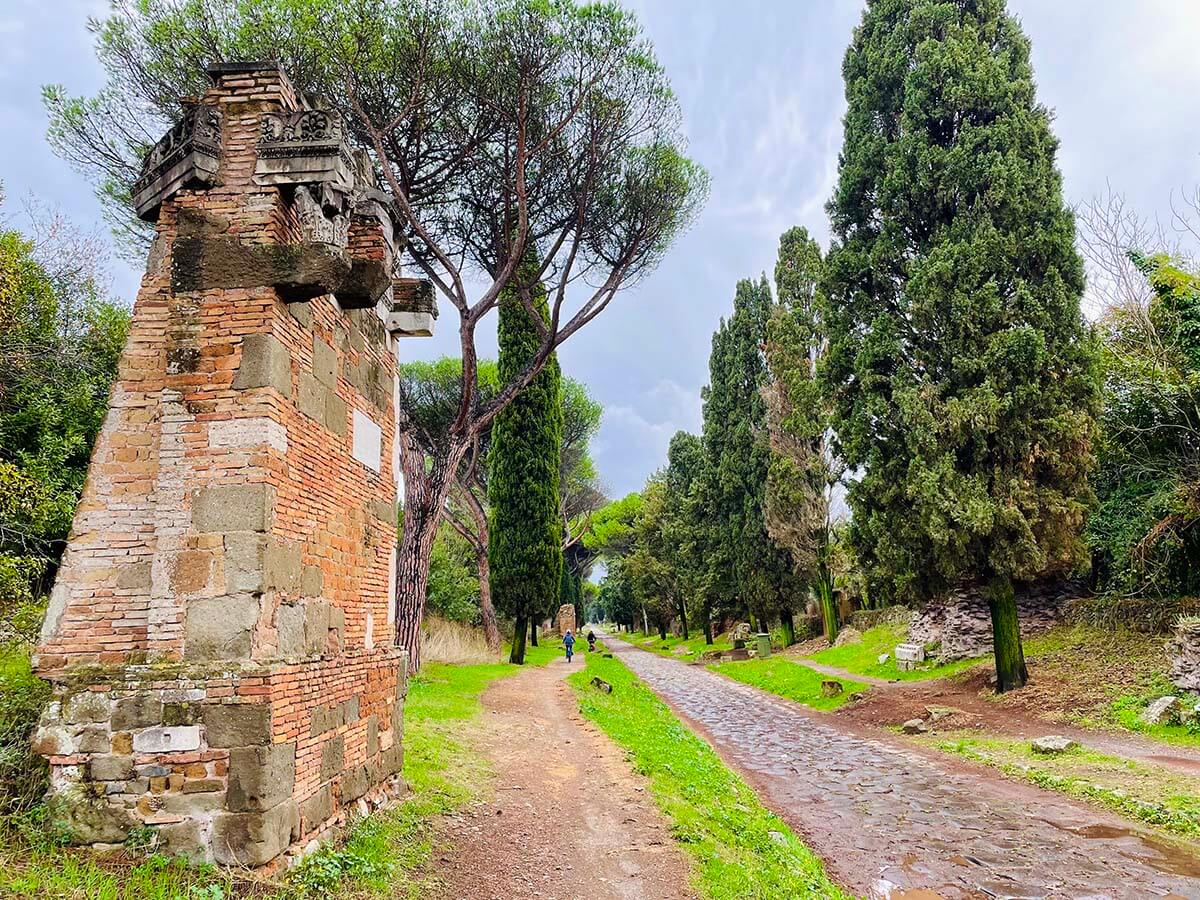
3.30 – 4 PM: Basilica di San Giovanni in Laterano
Just 10 minutes walk from where your bike tour ends, you can visit the main church of the city, the Cathedral of Rome, Basilica di San Giovanni in Laterano . It is this church (and not the St. Peter’s Basilica in the Vatican) that is considered as the ‘Cathedral of Rome and of the World’. The Pope is the reigning bishop of the city of Rome.
The reasoning behind this is quite simple – while the Pope stands above the cardinals and the bishops, St. Peter stands above the Pope. So St. Peter’s Basilica is a whole other league compared to any other church, and Rome – just as any other city – deserves its own cathedral, of course.
Anyway, the Basilica di San Giovanni in Laterano is absolutely impressive. The cathedral is massive, very richly decorated, and the statues of the Apostles inside are just as majestic as the ones at St. Peter’s. In the middle, you can also see the tomb of Pope Martino V , and on the far left corner of the church, there’s an entrance to a 13th-century cloister . You have to pay a few euros to visit here, but consider it as a donation to the church and be sure to check it out.
It took me quite a few visits to Rome before I finally made the time to visit this church, and I can tell you that it’s absolutely worth a detour. And since the bike tour ends just nearby, it’s really easy to add it to your 4-day Rome itinerary. A visit is free of charge, and it’s incomparably quieter here than at the Vatican.
TIP: While you can visit the Cathedral itself for free, you need a ticket to visit the cloisters. You can get this all-in ticket which includes everything there is to see at the Basilica and at the Scala Sancta across the street (more info below).

4 – 4.15 PM: Scala Santa
Just across the street from the Basilica, there’s one more little-known gem of Rome, Scala Santa (the Holy Stairs ). This is a small catholic sanctuary with a papal chapel and three impressive staircases leading to it. The middle of the three staircases is the Holy Stairs.
According to a Christian tradition, Jesus Christ climbed these stairs before his crucifixion . It’s believed that these stairs have been brought from Jerusalem to Rome in the 4th century. This staircase is considered sacred and is reserved for pilgrims who come here to pray and climb to the top on their knees hoping for a plenary indulgence. Millions of people have climbed these stairs on their knees, including many popes.
On top of the right staircase, there is a nice chapel, with an adjacent smaller papal chapel in the middle.
The papal chapel Sancta Sanctorum (the Holy of the Holies) itself is normally closed to the public and can only be seen through a small opening at the end of the middle stairs. It was exceptionally open when we visited, but I’m not sure if it will remain open to the public in the future. It contains lots of relics, some of which have been moved to the Vatican.
Even if you can’t visit the Holy of the Holies, a visit here is more than worth a few minutes of your time. The staircases are really impressive and so is the bigger chapel. And you can see the other one through a small opening too.
Good to know: Scala Santa is open daily in the morning and in the afternoon. There’s no fee to enter and no reservations are needed and you only need a couple of minutes. If you want to visit the papal chapel of Sancta Sanctorum (and it’s open), there’s a small fee (or you can get this ticket for the Cathedral and the Holy Stairs, as mentioned before). You can find more info about this sacred place and the opening times on their website .
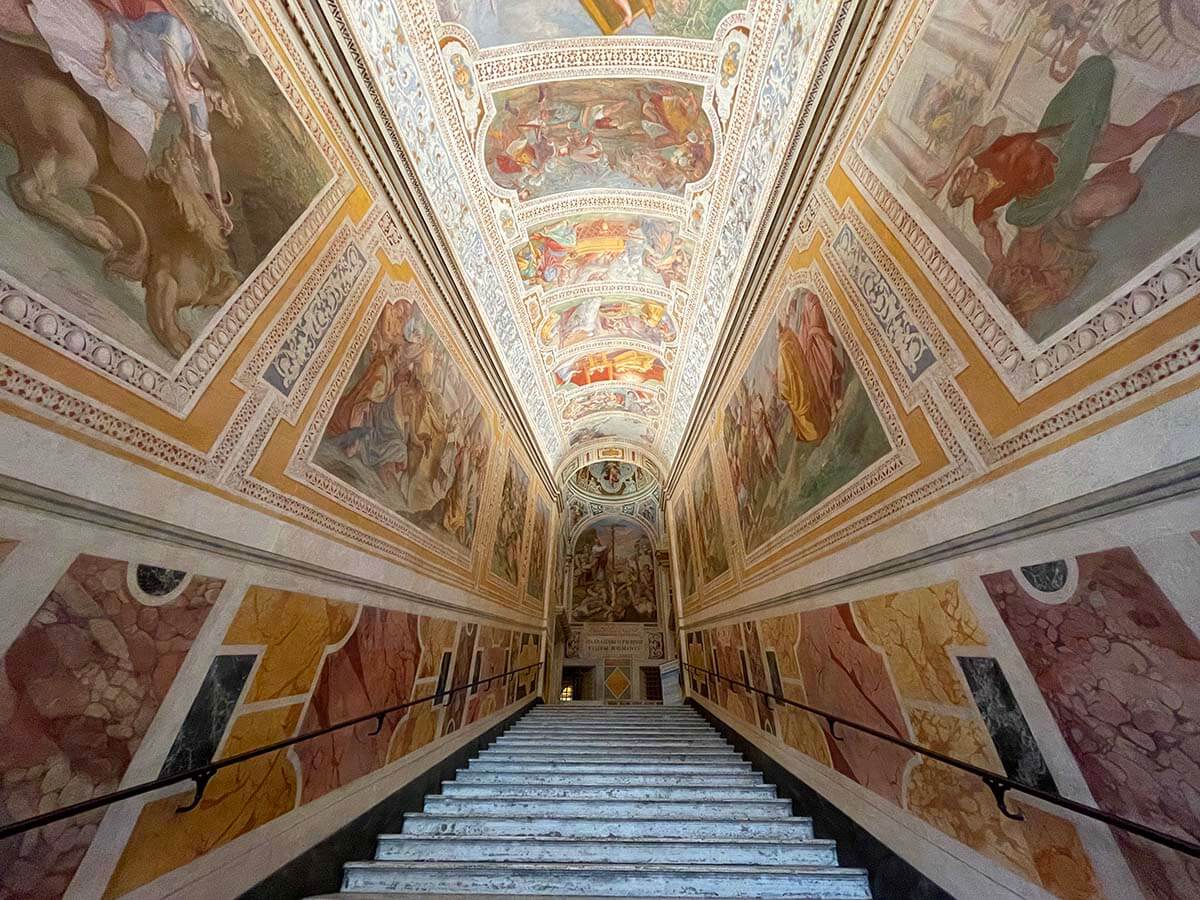
4.30 – 5 PM: St. Clement Basilica
After a visit to Basilica di San Giovanni in Laterano and the Holy Stairs, walk back in the direction of the Colosseum, and be sure to stop at St. Clement Basilica . From the outside, it might look just like any other of 900+ churches in Rome, but it houses a lot of secrets inside. This is one of the most unique places you can visit in Rome ! Yet, despite its proximity to the Colosseum, only very few tourists know about it or ever come here.
St. Clement Basilica was constructed in the 12th century. With its cozy interior and beautiful mosaics, it looks really nice, but – not that special, you’d think. There are tens of other very similar churches all over the city…
What makes it extraordinary is that underneath there’s an archeological site containing two underground levels. Right under the church, there’s the original Basilica, built in the 4th century. AND – yet another level deeper – there are 1st and 2nd- century buildings used by the members of the cult of Mithras. This seemingly ordinary church actually has three layers that literally take you back in time through centuries of Roman history.
There are several places in Rome where you can literally touch the 2000-year-old walls, but this is probably one of the most authentic sites (it probably feels like that because there are very few tourists) AND it’s so easy to visit! You don’t need any advance reservations, there are no queues, and it’s just a stone’s throw from the Colosseum! So even if you are not doing the bike tour and plan your Rome itinerary differently, you could easily come here when you are visiting the Colosseum.
Good to know: The Basilica’s Archeological Excavations are open daily except on Christmas Day. You can check up-to-date info for the opening times and buy a ticket on their website . Or pay a few euros more and simply get a ticket at the entrance. Kids under 16 are free of charge.
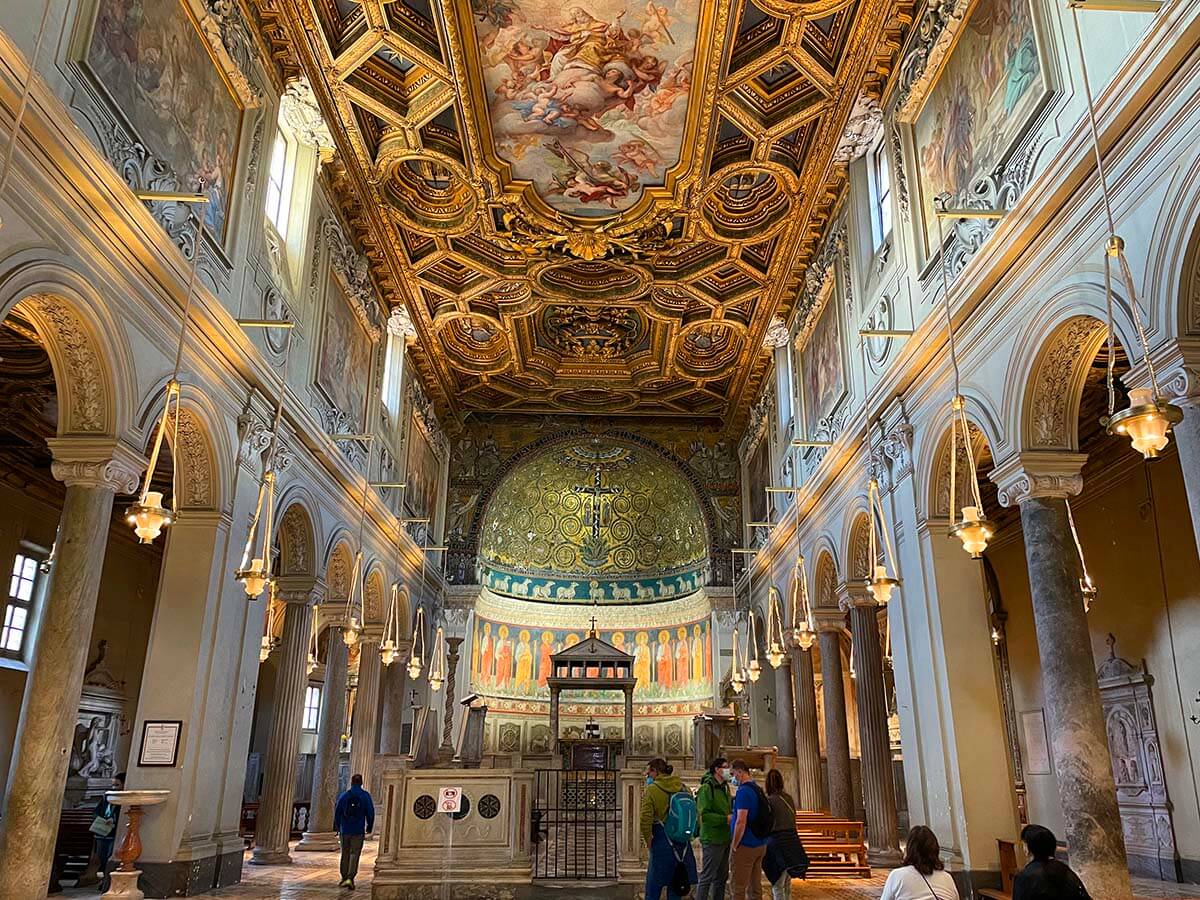
5.15 – 6 PM Domus Aurea
Domus Aurea , aka the Golden House of Emperor Nero, is located just next to the Colosseum and is well worth a visit as well. It’s an ancient archeological underground site where you can see the remains of the extravagant villa built by Nero after the Great Fire in 64 AD had destroyed a large part of the city.
The Golden House was huge, with over 200 rooms, pavilions, gardens, and even an artificial lake in the center, and was built to impress and entertain.
The most remarkable feature was the Octagonal Room with five rooms around it and waterfalls cascading down the walls. The main dining hall – the Octagonal Hall itself – has a big concrete dome with an oculus which is believed to have inspired the architecture of the Pantheon. This room also had a revolving floor – an impressive engineering achievement at that time.
Nero wasn’t loved and his impressive palace was looted and destroyed soon after his death. It was covered in earth and several other structures were built on top of it, including the Baths of Trajan and Titus. The Colosseum was built at a place where Nero’s lake used to be and it also got its name from the Colossus statue that used to stand at the entrance of Domus Aurea.
Good to know: Domus Aurea is normally open daily until 6.30 PM. However, at the moment of writing, it’s only open on the weekends and just a few hours a day. All visits are guided and normally also include a VR experience that gives you a good insight into how grand this palace was. Since it’s an underground site, it’s quite cold inside so you may want to take a sweater.
If you absolutely want to visit here, check the current opening times and reserve your tickets in advance. Normally, you can find info and reserve the tickets on this website , but it’s not always updated and can be somewhat unclear too. In the low season, you could probably just walk to the entrance and see if there are tickets available too. And otherwise, check out this organized tour – they’ll only show the dates and the times when a visit is actually possible.

6.15 – 6.30 PM: Basilica di San Pietro in Vincoli
Basilica di San Pietro in Vincoli is a 5th-century church best known for its relic – the chains of St. Peter and Michelangelo’s statue of Moses that is part of the tomb of Pope Julius II.
Normally, a visit is free of charge and the church is open daily until 7 PM. It’s located just 5 minutes walk from the Colosseum in the direction of the city center. Well worth a few minutes of your time.
TIP: After leaving the church, go to the right and you’ll find a small passage with a staircase on via San Francesco di Paola. It’s a nice hidden gem. If you walk to the center, you can continue via this staircase. Alternatively, head back to the Colosseum for sunset.
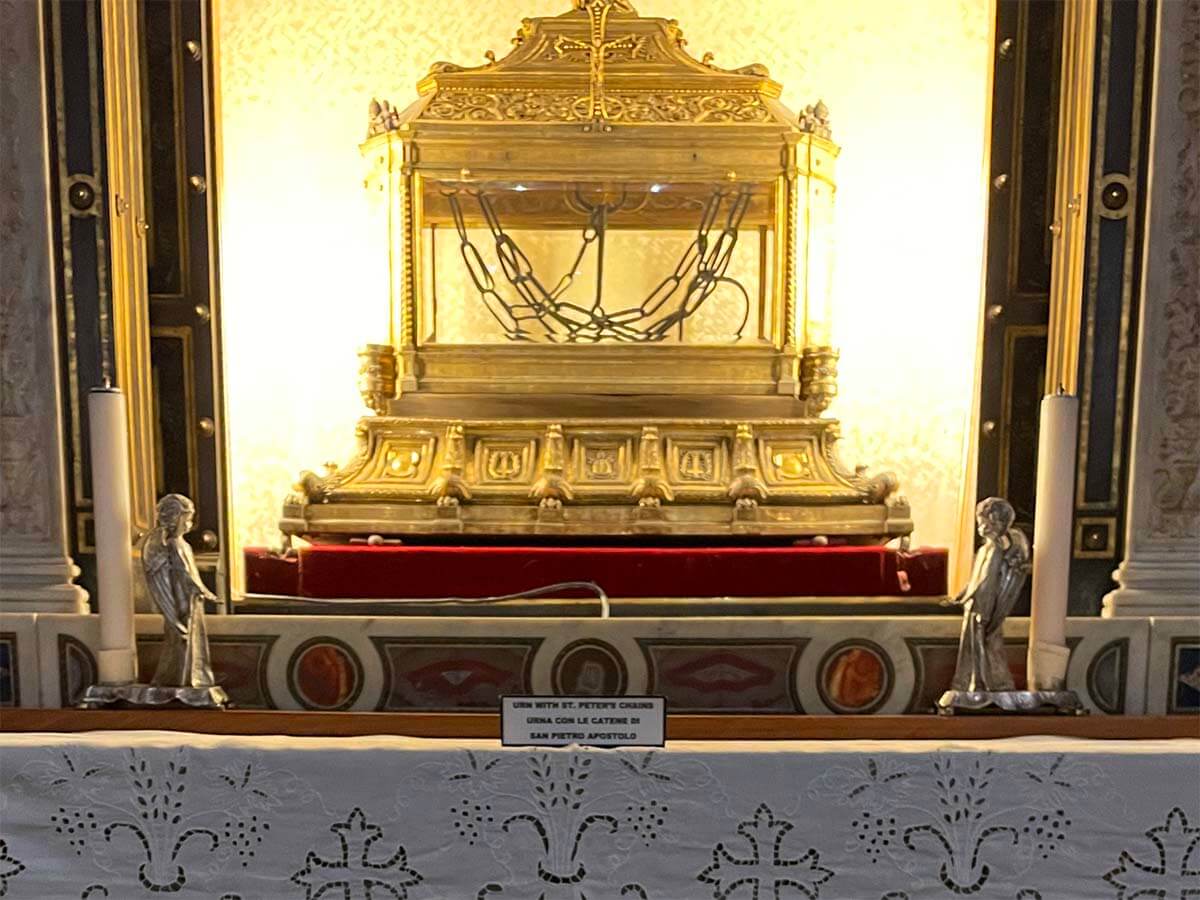
Sunset at the Colosseum
Depending on the time of the year (and the time of the sunset), you might find yourself close to the Colosseum at around twilight .
Seeing this landmark in a different light (and usually without the crowds of daytime visitors) might be a nice way to end your Rome city trip.
This itinerary is based on our most recent visit to Rome in November . At that time, the sunset was around 5 PM. So we came to the Colosseum after a visit to St. Clement Basilica, and could indeed enjoy the beautiful light. It wasn’t busy either.
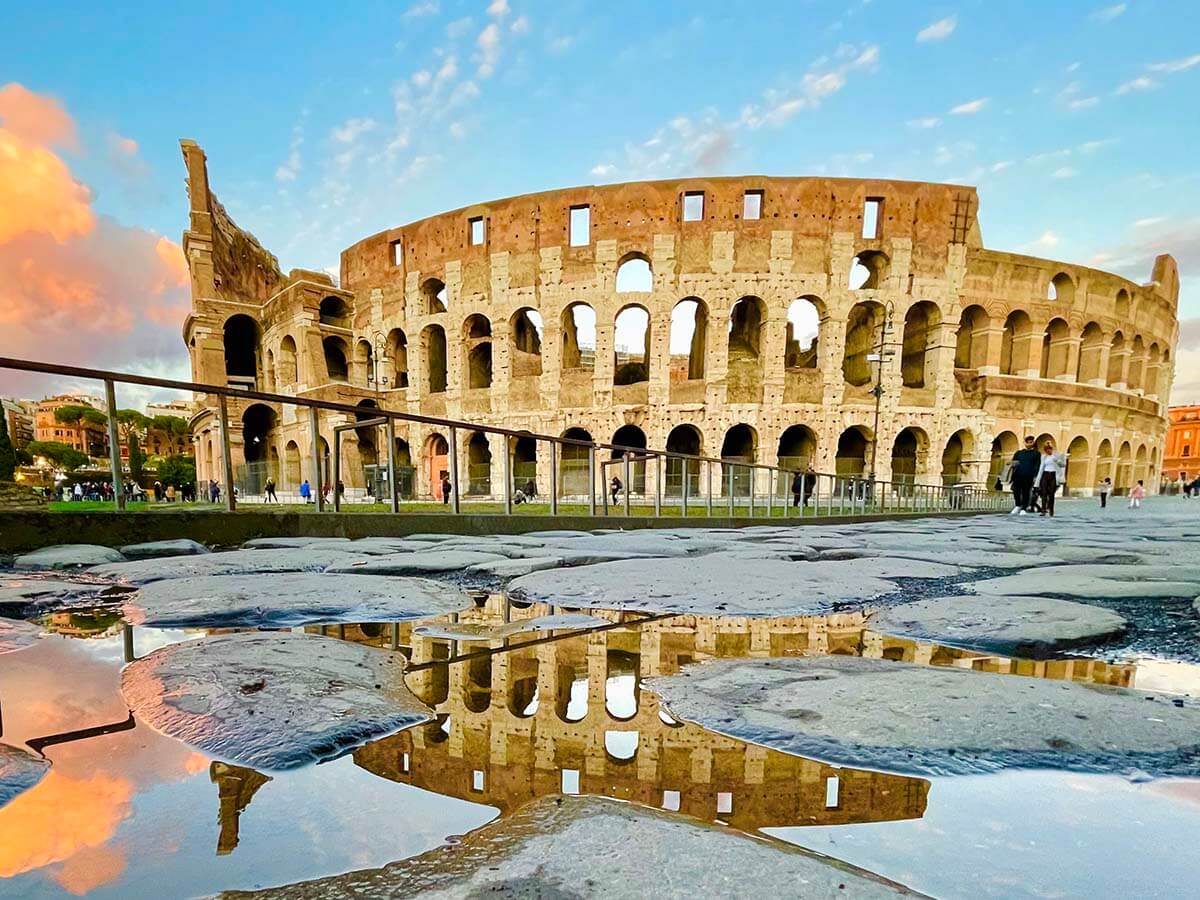
There are many restaurants in the Colosseum area too, so you could have dinner here. We walked in the direction of the Jewish Quarter – there are some really good restaurants serving traditional Italian food here, but you have to reserve most of them in advance, definitely in the high season.
Here are some restaurant suggestions for this area that we got from our food tour guide: Giggetto , Sora Margherita , or Al Pompiere Roma (for local Roman dishes), Emma (for pizza and Roman appetizers).
Since the other restaurants opened for dinner even later, we went to Emma’s and were glad to get one of the last available tables (had no idea it would be fully booked on a weekday in November).
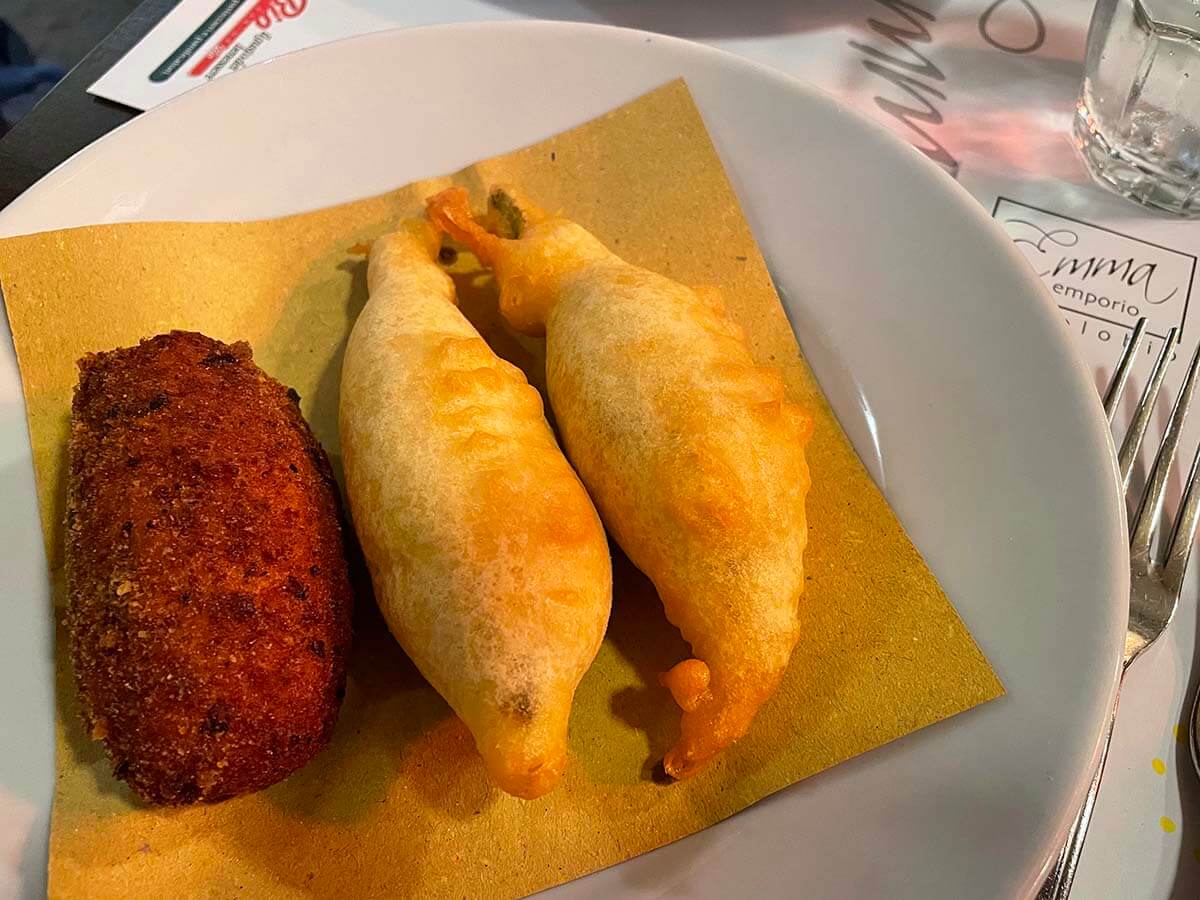
Map & Getting Around
Below, you can see a map of this 4-day Rome itinerary .
It contains all the places mentioned in this article, including restaurant suggestions. You can save this map to your phone and use it during the trip. To make it easier, we used four different colors – one per day.
Getting around: For this itinerary, we simply walked everywhere (except for the airport transfers and the e-bike tour, of course). This is definitely doable if you stay in the city center, plan well, and wear very comfortable shoes. However, prepare to walk A LOT .
You could also cover some of the bigger distances by public transport (buses, metro), take a taxi , or – probably the easiest and quickest – rent an electric scooter . They are scattered all over Rome and it looked like it shouldn’t be a problem to find one where and when you need it. Just drive carefully because the traffic is crazy.
LEARN MORE: Rome Airport Transfers
How to use this map: Use your computer mouse (or fingers) to zoom in or out. Click on the icons to get more information about each place. Click the arrow on the top left corner for the index. Click the star next to the map’s title to add it to your Google Maps account. To view the saved map on your smartphone or PC, open Google Maps, click the menu and go to ‘Your Places’/’Maps’. If you want to print the map or see it in a bigger window, click on ‘View larger map’ in the top right corner.
If you have more time
If you have more than 4 days in Rome, you could, of course, take it easier and visit some of the places we indicated in our itinerary on different days. There are also many more museums, churches, etc.
However, if you want to make the most of your visit , I recommend booking a few day tours that take you outside the city.
Here are some of the most popular options for the best day trips from Rome :
- Villa D’Este & Hadrian’s Villa in Tivoli
- Pompeii & Mt. Vesuvius OR Pompeii & Amalfi Coast
- Tuscany Taster Tour: Day Trip with Lunch & Wine
- Florence & Pisa in a Day
Where to stay for 4 days in Rome
For this 4-day Rome itinerary, we recommend staying in the heart of the historic city center. Our favorite area to stay in Rome is around Pantheon, but pretty much anywhere between Piazza Navona and the Trevi Fountain is great.
Staying here, you can easily walk to the main landmarks, and pretty much all the main areas of interest are within 15-30 minutes walking distance.
Here are some of the best-rated hotels close to the Pantheon for all budgets (although low-budget options are scarce in this area):
- €€€€€+ The Pantheon Iconic Rome Hotel, Autograph Collection (a very luxurious 5* boutique hotel).
- €€€€ 9Hotel Cesari (a very centrally located 4* hotel; this is where we stayed).
- €€€ Hotel Navona (a popular 3* hotel).
- €€ Hotel Primavera (highly-rated 2* hotel; one of the best lower-budget choices in the historic center).
READ ALSO: Where to Stay in Rome

So, this is our 4 days Rome itinerary. I hope that all the time indications and the details will help you plan an unforgettable trip to the Eternal City and explore a bit deeper, beyond the main attractions.
Have a great trip!
TIP: If you are looking for more information and tips for your trip to Rome , be sure to check out this article with Rome travel tips for your first trip . It contains all the useful info and info that will help you plan a more enjoyable visit. Take a look!
READ ALSO: Best Things to Do in Rome
More travel inspiration for Rome:
- Hidden gems of Rome
- Where to eat in Rome
- 1 day in Rome
- 2 days in Rome
- Best views in Rome
- Best underground sites in Rome
TIP: If you are visiting Italy for the first time and are wondering where to go and how to plan your time, check out this Italy trip itinerary that includes all the must-sees.
If you found this post useful, don’t forget to bookmark it and share it with your friends. Are you on Pinterest? Pin these images!
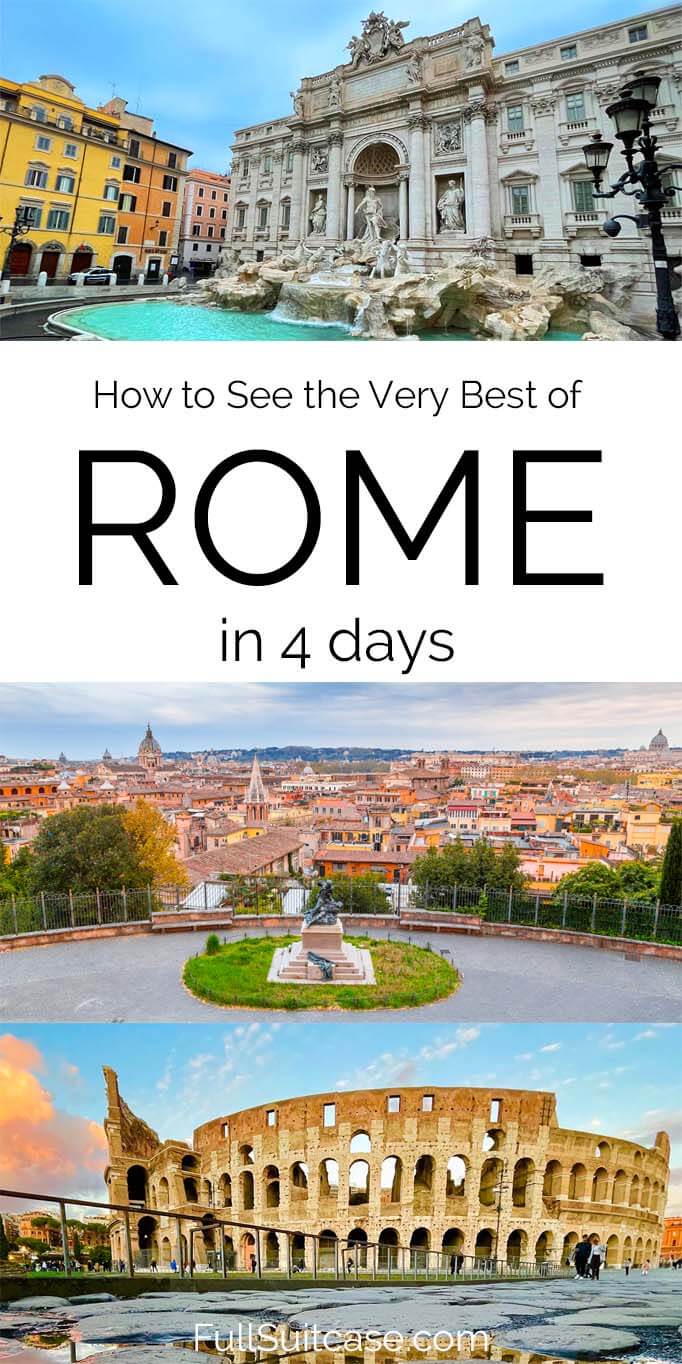
More travel inspiration for Italy:
- Best places to see in Italy
- Best towns to visit in Italy
- Best Sights & Attractions in Venice
- Best Things to Do in Florence
- Best Things to Do in Milan
- Best Things to Do in Siena
- Best Things to Do in Bologna
- Best Things to Do in Verona
- Best Things to Do in Naples
- Best Things to Do in Ravenna
- Best Things to Do in Montepulciano
- Best Things to Do in Como
- Best Things to Do in Rimini
- One Day in Venice
- Three Days in Venice
- One Day in Milan
- One Day in Florence
- One Day in Cinque Terre
- One Day in Naples
- Florence to Bologna: Travel Info & Itinerary
- Bellagio (Italy)
- Tuscany itinerary
- Amalfi Coast itinerary
- Emilia Romagna itinerary
- Dolomites itinerary
- …. For many more destinations, be sure to check our Italy travel guide . It contains an overview of all our articles for a wide variety of popular places all over Italy.
This site uses Akismet to reduce spam. Learn how your comment data is processed .
John Signorelli
Sunday 15th of October 2023
I used the information here to plan my recent trip to Italy. This article was great (as was every article you have on Italy). If anyone is wondering to plan your trip yourself and use this article or to use a tour company, I have zero complaints about what I learned from Jurga for our trip.
Our next trip will be to Athens, but I didn't see an article on that - can't imaging planning my visit without your advice.
Monday 16th of October 2023
Thank you for your feedback on this and all those other articles where you left comments, John. It's always great to hear from our readers who use the information on our blog on their trips! As for Athens, unfortunately, I still haven't been there. And other trips to Greece are from so long ago that it wouldn't make sense to write about it anymore... So I'm afraid I can't help you much with that. But we have many other destinations covered on our blog if you are looking for some trip inspiration for the future. I can highly recommend you look into visiting Portugal one day. We now go there several times a year and absolutely love it every time. If you were to return to Italy, southern Italy and especially the area around Naples - Amalfi Coast is also incredibly beautiful with lots of very interesting sights. Happy travels!
Monday 17th of July 2023
Hi there, I've been trying to book tickets for collesium, forum and palatine Hill priority entrance + arena floor on tiqets website but it says hi there early bird, tickets are unavailable. I am planning trip next month and am trying to book before too late for non tour tickets due to health reasons I can't do tour because of frequent restroom breaks... is there another site to buy same ticket without tour including arena floor? I can't get a hold of anyone on their website. Thanks.
Tuesday 18th of July 2023
Hi Sam, the Colosseum tickets are normally released 30 days in advance and it's indeed, the best time to buy them - as soon as they are available for your travel date. This summer, things have been crazy. A few weeks ago, there was no availability at all; from mid-August things look a bit better. The official site is coopculture, but it's not really user-friendly, so we personally never use it. We recommend using either Tiqets or GetYourGuide for all your tickets in Rome. When the tickets are released, they are normally available on all these websites at the same time. But you can always check the official site in case they release them a bit earlier. As said, this summer has just been crazy for the Colosseum tickets. That said, I still highly recommend going with a tour if you can manage it. So many people tell me they regret not doing a tour because it wasn't always clear where to go, they missed certain parts but were not allowed to backtrack, etc. etc. Hope this helps.
Saturday 17th of June 2023
I love your blog. This itinerary will be so helpful as we are going to Rome for four days this August. Can you advise me on the following: I arrive at 8 a.m. and can't check into my air bnb until the afternoon. Do you know of a place to store our luggage so we don't waste our first day waiting to check in?
Hi Jill, upon arrival at the airport, take a train or a bus to the central station (see all the options explained in our Rome airport transfers article). Once at the station, you could use this highly-rated luggage storage for your bags. PS One more thing for this summer. The Colosseum tickets are practically impossible to get these days. So be sure to book a guided tour asap if you want to be sure to go inside (see our guide to Colosseum tickets for more info). Rome is very busy at the moment. Have a great trip!
Monday 22nd of August 2022
Hi Jurga, I like your itinerary very much. Thank you for all the info. For Colosseum ticket, it includes Roman Forum and Palatine Hill also. Are there separate entries for the Forum and Palatine Hill? Can I go to the Forum first, get out to have lunch, then go Palatine Hill, and then see Colosseum at the last? Is this doable? The morning tickets are sold out, and no re-entry allowed, but I have to get out to have lunch, then enter to another, I wonder how they handle one ticket for three places. Thank you! -Chen
Hi Jurga, Thank you so much! Booked 12:30 tickets. I got another question. For Appian way, if I walk/hike it, can I see all the places in your pictures? I can't bike, but I can hike 7 miles. Or is there a tour bus? Thank you! -Chen
Hi Chen, you can enter Colosseum separately, but the Roman Forum and the Palatine Hill can only be visited together. So it’s three places but actually two tickets. You can do one of the two in the morning and the other after lunch, but you could also do everything after lunch if you prefer. Hope this clarifies. Enjoy your trip!
Turn your dream vacation into reality

4 Days in Rome Itinerary (Most Complete Guide)
- December 26, 2023
Rome is one of the most visited cities in Europe. It’s one of the big three in Italy – Rome, Florence and Venice. Rome is not only the capital of Italy but also the seat of the Roman Catholic Church. Founded nearly 3000 years ago, it’s known as the Eternal City. And it really is!
Rome is home to renowned masterpieces of art, ancient ruins, centuries-old churches and mouth-watering food. It’s an inspiring place that you should visit at least once in your lifetime. And you’ll probably need a lifetime to see it all!
4 Days in Rome itinerary
How to see Rome in 4 days? With so many attractions and must-see places, it’s not easy to craft the perfect itinerary. Plus you need to book some tickets in advance unless you want to spend hours waiting in lines.
Follow this 4 days in Rome suggested itinerary to ensure that you’ll get the best of the city during your vacation. It includes the most popular attractions, the best places to eat and tips on how to avoid the crowds.
Already have a hotel booked? Check if your hotel has a convenient location in my guide to where to stay in Rome first time .
Find a map of this Rome itinerary (with all attractions and restaurants’ websites) at the end of the article.
4 days in Rome (the perfect Rome itinerary)
- Day 1: Colosseum of Rome, Palatine Hill, Roman Forum, Knights of Malta Keyhole, Trastevere
- Day 2: Vatican Museums, Castel Sant’Angelo
- Day 3: St. Peter’s Basilica, Pantheon, Doria Pamphilj Gallery, Altare della Patria, Piazza Navona
- Day 4: Galleria Borghese, Spanish Steps, Trevi Fountain, Basilica of Santa Maria Maggiore
4 Days in Rome – Day 1
Breakfast in italian style.
07:30 AM – 08:30 AM Start your first day with a cup of coffee and a pastry at 081 Caffè or Antico Caffe Del Brasile .
Visit the iconic Colosseum
08:30 AM – 10:00 AM Colosseum (Colosseo) is the largest amphitheatre in the world. Emperor Vespasian commissioned its construction in 72 AD. Colosseum was used for gladiatorial fights and it could accommodate up to 80,000 spectators. Romans even flooded it for boat battles.
Many gladiators found their death here. To be more precise over 500,000 people and twice as many animals. The last gladiatorial fight took place in 435 AD.
You can visit most of the Colosseum on your own, but the underground areas are accessible only with a guide. To explore the gladiators’ rooms and the animal cages under the arena, book this excellent Colosseum Underground Tour .

Also don’t miss to see the Colosseum at night, when it’s beautifully illuminated.

Explore Palatine Hill
10:00 AM – 12:00 PM Palatine Hill (Palatino) is the ancient part of the city. In fact, it’s the birthplace of the Eternal City. According to the legends Romulus and Remus , the founders of Rome, lived in a cave here on Palatine Hill.
During the reign of Augustus, the Palatine Hill was a thriving place, a home to the wealthy Romans. You can still see the remains of the imperial palace of Augustus and his wife Livia.
Palatine Hill is huge and there is a lot to see. You’ll need more time compared to the Colosseum. And don’t forget to wear comfortable shoes.

12:00 PM – 02:00 PM Stop for lunch at Fuorinorma or Mizio’s Street Food . Fuorinorma is the perfect place to taste some wine, cheese and salami platter. For a quick lunch and awesome sandwiches, visit Mizio’s Street Food.
Stroll through the Roman Forum
02:00 PM – 03:00 PM The Roman Forum (Foro Romano) was the beating heart of ancient Rome. It was the centre of the political and cultural life of the city. All the important monuments, temples and courthouses were located here.
Today, you can still see the ruins of the royal residence, the Temple of Saturn, the Temple of Vesta and many other significant buildings.

Knights of Malta Keyhole
03:20 PM – 03:40 PM Knights of Malta Keyhole reveals one of the most unique city views. When you peek through it, you’ll see the dome of St. Peter’s perfectly situated in its centre.
The door in question leads to the Priory of the Knights of Malta. Therefore, the view shows three countries at once – Italy, the Vatican and Malta.
However, the keyhole is not marked in any way. Just look for a green door at the intersection of Via di S. Sabina and Via di Porta Lavernale.

Discover Trastevere
04:00 PM – 05:00 PM Trastevere is the most picturesque district. Cobblestone streets, small markets and coffee shops, Roman trattorias, artisan workshops, it has it all. It’s the perfect place to wander and get lost.
If you look for some delicious Roman food, this is the place to go. The area is full of small traditional restaurants and cafés, that serve mouth-watering food.
Finish the first day of the itinerary with a dinner at I Pizzicaroli Trastevere or La Tavernetta 29 da Tony e Andrea . For a lighter dinner with salami and cheese platter, visit I Pizzicaroli Trastevere. If you look for a lavish meal, then La Tavernetta 29 da Tony e Andrea is your place.
More ideas for your 4 days in Rome – Day 1
If you are ahead of time or want to change any of the sites, check out the attractions below. They are close to the sites from the first day, so you can easily add any of them to your Rome itinerary.
Archbasilica of St. John Lateran
The Archbasilica of St. John Lateran is the most important of the four papal major basilicas. In fact, it’s the mother church of the Roman Catholic faithful. That’s why it’s called an archbasilica. St. John Lateran Archbasilica is also the oldest church in the whole of Europe.

Mouth of Truth
The famous Mouth of Truth (Bocca della Verità) is an ancient lie detector. According to the legends, if you put your hand inside and tell a lie, it will cut off your hand.

Baths of Caracalla
Going to baths was an important part of the daily life of the Romans. It was a place to socialize, gossip and even discuss politics.
The Baths of Caracalla were the largest thermal baths in the world during the 3rd century. In fact, Terme di Caracalla was a spa complex, that includes also reading and exercising areas, gardens and restaurants.
Although today only ruins are left from this place, you can still feel its splendour.

Protestant Cemetery
Protestant Cemetery (Cimitero dei protestanti) is the final resting place for all non-catholic citizens of Rome. It’s a beautiful and tranquil place filled with stray cats. The Protestant Cemetery is one of the oldest cemeteries in Europe and it’s still in use (almost 300 years after its opening). Here you’ll find the graves of the famous romantic poets – John Keats and Percy Bysshe Shelley.

Rome in 4 days – Day 2
08:00 AM – 08:30 AM Start your second day with breakfast at Sciascia Caffè 1919 or Forno Feliziani .
Visit the Vatican Museums
08:45 AM – 01:00 PM Vatican City is the smallest state by area and population (800 people) in the world. Yet, it has its own post office and you can send a postcard from there to your friends!
It is an absolute monarchy ruled by the Pope. However, the popes haven’t lived always in Vatican City. Their first home was the Lateran palace in Rome. At the beginning of the 14th century when a French Pope was elected, the papacy moved to Avignon.
When they returned to Rome 70 years later, the Lateran Palace was in ruins. The popes decided to move to Vatican City and since then it’s been their home.
Although the state is small, it has the largest complex of museums in the world. They contain masterpieces of art and sculpture collected by the popes through the centuries. The most famous artwork is the ceiling in the Sistine Chapel which features the Last Judgment by Michelangelo.

Vatican Museums are huge and you’ll need days to see everything. So, focus on what is most interesting for you and skip the rest. It’s one of the most popular sites and the queues are huge (even before the opening time). So, it’s strongly advisable to book your tickets in advance.
In this way, you’ll get a fast-track entry and use a separate queue to enter. Do it as early as you can, as you have to choose a time slot and the ones in the morning are sold out quickly. If possible, visit the museums early in the morning, because there are fewer people. Later in the day, there could be queues even for the fast-track entrance.
The best day to visit the Vatican museums is Wednesday morning. This is only in case you don’t want to see the Pope or you’re joining a guided tour, which includes also St. Peter’s Basilica. The Papal Audience takes place every Wednesday at St. Peter’s Square. So most of the tourists are at St. Peter’s Square at that time.
My advice is not to visit St. Peter’s Basilica after the Vatican Museums. Leave it for the next day, so you can go very early in the morning. The waiting lines for the basilica are outrageous.
01:00 PM – 03:00 PM For one of the best pizza in the city, visit Ristorante dei Musei . If you prefer salami and cheese platter, go to The Loft . After lunch, try the gelato at Lemongrass (my favourite one).

Tour Castel Sant’Angelo
03:00 PM – 05:00 PM The Roman emperor Hadrian built the castle as a mausoleum for his family in 123 AD. However, its purpose changed several times over the centuries.
During his reign, Emperor Aurelian transformed the mausoleum into a military fortress. He also incorporated it into the city walls. The purpose of the fortress was to defend the northern entrance of the Eternal City.
In the 13th century, a covered fortified corridor (called Passetto di Borgo) was constructed. The corridor connects Vatican City and the castle. You can take a glimpse of this secret corridor if you take the Angels and Demons tour .
From the beginning of the 14th century, the papacy took control of the fortress and converted it to a castle. Papal apartments were built to ensure a comfortable stay in case of a siege.

Castel Sant’Angelo was also used as a prison. Many executions took place in its inner courtyards. This castle was the place where Benvenuto Cellini, Cagliostro and Giordano Bruno were imprisoned before their executions.
Nowadays the castle is a museum. It represents various exhibits, including Renaissance paintings, military weapons, furnishings and sculptures.
The castle took its name from the large statue of Archangel Michael, situated on the top of the building. According to the legends, the city was struck by a plague in 590 AD that ended with the apparition of the Archangel Michael above the mausoleum.
You can book your skip-the-line tickets for Castel Sant’Angelo here .

Take an evening walking tour of Rome
Take an evening walking tour of Rome to admire the beauty of the city at sunset. You’ll see some of the most beautiful spots in the city, including the Spanish Steps, Trevi Fountain and Piazza Navona.
Taste some authentic Italian food
Finish the day with a dinner at Wine Bar De’ Penitenzieri or La Fraschetta di Castel Sant’Angelo . Both restaurants serve authentic Italian food.

Rome in 4 days – Day 3
08:00 AM – 08:45 AM Start the third day of the itinerary 4 days in Rome with some pastry and coffee at Bar Pasticceria Gelateria Parenti Silvano .
St. Peter’s Basilica and St. Peter’s Square
09:00 AM – 11:30 AM Located in Vatican City, St. Peter’s Basilica is one of the largest churches in the world. It is also one of the four major basilicas in the Eternal City. Among them are – Basilica of St. John Lateran, Santa Maria Maggiore and St. Paul Outside the Walls. All four basilicas are truly beautiful, so if you have enough time, don’t miss to visit them.
St. Peter’s Basilica is constructed on the burial site of Saint Peter, one of the twelve apostles of Jesus. The first temple in that place was built in the 4th century by emperor Constantine the Great. In the 15th century, after years of neglect during the period of the Avignon Papacy, the church was in desperate need of restoration.

During the 16th century, Pope Julius II decided to build a new church in the place instead of repairing the old one. Bernini was entrusted with the interior of the basilica.
Some of the masterpieces he designed are the baldachin (a large bronze pavilion, beneath the dome), the throne of St. Peter and the tomb of Alexander VII. The throne of St. Peter is a large bronze throne, which enshrines a chair claimed to be used by the apostle.
One of the most famous monuments in the basilica is the Pietà. It is a marble sculpture of Mary holding the body of her dead son after the crucifixion. Michelangelo created the sculpture in 1499-1500. After a visitor vandalised this piece of art with a hammer in 1972, it is now protected by bulletproof glass.

Climbing the dome of St. Peter’s Basilica
If you want to climb the dome of St. Peter’s Basilica, prepare yourself for a lot of stairs. You can skip the first part of the stairs by taking the elevator to the basilica’s roof level. From the roof level to the top the only option is to take the stairs.
The climbing of the rest 320 steps is not easy – the staircase is narrow and the walls are slanted. Also, it can become crowded and stifling. If you consider climbing the dome, do it before visiting the basilica, because after that you will exit directly in the church.

The entrance to the basilica is free, but you have to pay to climb the dome. Go as early in the morning as you can, because the waiting lines are enormous.
The dress code is very strict, so skip the shorts, bare-shoulder tops and miniskirts. You will be turned away at the entrance if you are not dressed properly. In addition, to enter the basilica, you have to pass through airport-style scanners and security.
St. Peter’s Square is the place where the papal audience takes place every Wednesday. To attend the papal audience, you need to reserve your ticket in advance .

11:45 AM – 01:30 PM Stop for lunch at Likeat or Pane pane vino Ar Vino . Both places offer super tasty sandwiches.
Admire the Pantheon
01:30 PM – 02:00 PM Continue this Rome sightseeing itinerary with a visit to the Pantheon. Pantheon is the best-preserved monument from ancient Rome. Its exact construction date is unknown, but it was around 126 AD.
The most fascinating feature of the Pantheon is its dome. It’s the largest unsupported dome in the world! Nowadays, this former Roman temple serves as a church.
To learn more about the history of this magnificent temple take a Pantheon audio guide tour .

Be amazed by Doria Pamphilj Gallery
02:15 PM – 04:00 PM Doria Pamphilj Gallery is housed in a gorgeous palace that dates back to the 16th century. The gallery features one of the richest private art collection in Rome. Even if you aren’t into art, it’s worth visiting to see the lavish state apartments. There is a free audio guide, that is narrated by Jonathan Pamphilj himself. Today, the Doria Pamphilj family still owns the palace.

See the stunning Altare della Patria
04:15 PM – 04:45 PM Altare della Patria is also known as National Monument to Victor Emmanuel II. It’s one of the most imposing buildings in the Eternal city. Altare della Patria is a monument built to honour the first king of Italy, Victor Emmanuel.
Don’t miss to take the lift to the panoramic terrace for some great city views.

While you’re in the area, take a look at Trajan’s Column (Colonna Traiana). It commemorates the victory of the emperor Trajan in the Dacian Wars.
See the famous Piazza Navona
05:00 PM – 05:30 PM Piazza Navona is a charming square and a popular meeting spot. It’s surrounded by small restaurants and there are regularly street artists.
Finish the day with a dinner at Mimì e Cocò or Osteria del Pegno .
More ideas for your 4 days in Rome – Day 3
Church of st. louis of the french.
The Church of St. Louis of the French is a Baroque gem from the 16th century. It houses the three world-renowned canvases of The Calling of St Matthew by Caravaggio.

Church of the Gesù
Church of the Gesù is one of the finest examples of Baroque architecture in the Eternal City. The most striking part of this 16th-century church is the ceiling fresco, that looks three dimensional.

Largo di Torre Argentina
Largo di Torre Argentina is a square from ancient Rome. You can see the remains of the Theatre of Pompey and four temples from the 4th century BC. Moreover, it was the place where Julius Caesar was murdered.
Nowadays, the ruins are home to a large number of cats. There is even a cat sanctuary right next to Largo di Torre Argentina.

Palazzo Colonna
Palazzo Colonna is an art gallery that features leading Italian and foreign artists from the 15th-16th century. It’s a beautiful 14th-century palace still owned by the noble Colonna family. Unfortunately, this gorgeous place is open only on Saturday morning.
Capitoline Museums
Capitoline Museums consist of two separate buildings – Palazzo dei Conservatori and the Palazzo Nuovo. The collection mainly consists of statues, sculptures and paintings by renowned artists like Caravaggio, Rubens and Tiziano. Here you’ll also find the original statue of the Capitoline Wolf, the symbol of the city.
4 Days in Rome – Day 4
08:00 AM – 08:30 AM Start your last day of this 4 nights in Rome itinerary with breakfast at D’Angelo Caffè or Trecaffè .
Both coffee shops offer super tasty sandwiches and pastries.
Admire the art at Galleria Borghese
08:45 AM – 11:15 AM Galleria Borghese occupies the summer residence of the noble Borghese family. And it is a must-see for every art lover. Its amazing collection features the artworks of Caravaggio and Bernini.
To visit the gallery, you need to book tickets in advance. The tickets are always in high demand, as only 360 people are allowed in at a time. During the booking, you have to choose a time slot and the length of your visit can’t exceed 2 hours.
Spanish Steps
11:30 AM – 12:00 PM Spanish Steps is one of the most city emblematic spots. The staircase connects Piazza di Spagna with Trinità dei Monti Church. The Spanish Steps are truly beautiful in late April when they are decorated with 300 white and lilac azalea plants.

12:00 PM – 02:00 PM Stop for some tasty panini and salad at Ami Bistrot or Burro e Alici .
Toss a coin in Trevi Fountain
02:00 PM – 02:30 PM Trevi Fountain (Fontana di Trevi) is the largest and most beautiful fountain in the city. It’s a must-see when in Rome. And don’t forget to throw out a coin over your shoulder in the fountain. This will ensure a return to the Eternal City.

Basilica of Santa Maria Maggiore
02:50 PM – 03:30 PM Basilica of Santa Maria Maggiore is one of the four major basilicas in the Eternal City. It’s an outstandingly beautiful church from the 5th century. The basilica is built on the same spot, where according to the legends snow has fallen in the summer of 358 AD.

I didn’t include many sites on the last day, so you can easily add a few extra by your choice from the suggestions below. Moreover, if you’re not an art lover, skip Galleria Borghese and take a day trip from Rome (see further in the post for ideas).
Finish this 4 days in Rome itinerary with dinner at Ristorante Nerone or Colline Emiliane . Both are perfect places to spend a wonderful last evening in the Eternal City.
More ideas for your 4 days in Rome – Day 4
Learn to make pasta from scratch.
There is no better way to finish your 4 days in Rome than to join a pasta-making class . You’ll cook, dine and learn the secrets of pasta-making with a local chef.
Become a gladiator
Train to be a gladiator at a school in Rome. Learn the basic techniques of sword fighting and find out more about how gladiators lived in ancient Rome.
Basilica of St. Paul Outside the Walls
Basilica of St. Paul Outside the Walls is located a little bit out of the city centre. However, it definitely worths a visit! It’s one of the four major basilicas and it’s stunningly beautiful. Decorated with gold mosaics and enormous marble columns, it is a feast for the eyes.

Villa Farnesina
Villa Farnesina is a true masterpiece of the Italian Renaissance with its beautiful frescos and ceilings. It was built for the wealthy Sienese banker Agostino Chigi in the 16th century. Located in Trastevere, the villa is a little oasis away from the crowds of tourists. Keep in mind, that Villa Farnesina is open only in the mornings.
Visit the morbid Capuchin Crypt
Capuchin Crypt is a truly unique and fascinating place. When the monks from the Catholic order moved here they brought with them 300 cartloads of deceased friars. However, they didn’t rebury the skeletons. They used them to decorate the walls of the crypt, which consists of six chapels. More than 4,000 skeletons were sculptured in various mosaics. You can even see mummified monks, dressed in friar’s clothes!
To learn more about the fascinating history of the Capuchin Crypt and the Catacombs of Rome, take this Underground Tour of Rome .
Catacombs of Rome
The catacombs are a labyrinth of underground passageways, that are several kilometres long. They were used for burials from around the 2nd to the 5th century AD. After that, the catacombs were abandoned and suffered continuous lootings. There are more than 60 catacombs, but only five of them are open to the public.
Colosseum – one of the top attractions with huge queues. To skip the lines buy a combined ticket for Colosseum and Roman Forum .
Vatican Museums – also a top attraction. I’d recommend booking as soon as possible because the tickets are valid for a certain time slot. You can book your Vatican skip-the-line-ticket here .
Galleria Borghese – if you’re an art lover, this museum is a must. Tickets are again timed entry, so you need to book in advance here .
How to save money on your 4-day Rome itinerary
The city is full of tourists at any time of the year. So even if you’re travelling out of the season, you need to buy tickets in advance. What’s worse is that for every ticket bought online there is a reservation fee added to the price (if you buy from the attractions’ official websites).
The best way to save all this trouble (plus save some money) is to use Vatican & Rome City Pass .
The pass includes:
- free entry to Vatican Museums and Sistine Chapel
- fast track entry to St Peter’s Basilica, Vatican Museums and Coliseum
- free hop-on-hop-off bus tour
- free entry to 2 attractions (including Coliseum, Palatine Hill, Borghese Gallery and Castel Sant’Angelo)
- discounted entry to another 30 popular attractions
- travelcard for unlimited access to the public transport system
- detailed guidebook and map of the city
The pass is valid for 3 consequent days, so use it for the first three days of this itinerary. Also, you’ll get a fast-track entry to the most popular attractions. This will save you hours of waiting in lines. In fact, this is the biggest advantage of the pass.
Please note that you have to book a time slot to the Vatican Museums, St. Peter’s Basilica, the Colosseum and Borghese Gallery when collecting the pass.

Getting around in Rome
Find a detailed map of the itinerary here .
The easiest way to get around the city is by using the metro or hop-on-hop-off buses .
The public transport tickets are one and the same for the metro, buses and trams. The single ticket is valid for a 100min. journey and you can switch bus lines.
Don’t forget to validate your ticket on the ticket machine inside the buses and trams. As for the metro – your ticket will be automatically validated when you pass through the barriers.
There are also 24, 48, 72 hour and weekly passes . You can buy them from any metro station, major bus stops or tobacco shops.
How to get to Rome
The main train station is Roma Termini. It’s located in the city centre and connected to the rest of the city by two metro lines.
If you’re planning to travel by train through Italy, book tickets in advance (they are cheaper if you buy them earlier). Check timetables and book train tickets online at Trenitalia official website .
If you’re arriving by car, book accommodation with parking. You won’t find free parking in the city centre of Rome. Moreover, a huge part of the city centre is a ZTL zone (limited traffic zone). This area is not accessible to private cars.
You can find several car parks near Vatican City and Galleria Borghese that are outside the ZTL zone.
There are two main airports – Leonardo da Vinci–Fiumicino Airport (FCO) and Ciampino Airport (CIA).
Leonardo da Vinci–Fiumicino Airport is located southwest of the city. It is the main international airport. There are several ways to get to the city centre:
- the easiest one is to book a private transfer directly to your hotel. I recommend this airport transfer (more than 1,130 excellent reviews).
- take a shuttle bus (there are 3 stops – Rome Termini Train Station, the Vatican – Via Crescenzio 2, or Circonvallazione Aurelia 19)
- take Leonardo Express train to Termini Train Station (trains every 15 minutes)
Ciampino Airport is located next to Ciampino city, southeast of Rome. It is the city’s low-cost airline airport. The most convenient ways to get to the city are:
- book a private transfer directly to your hotel
- take the shuttle bus to Termini Railway station
Day trips from Rome
If you have a little extra time in the city, check out these awesome day trips.

Florence is the gorgeous capital of Tuscany. Known as the birthplace of the Renaissance, it’s a must-see while in Italy.
It’s best if you can dedicate 2-3 days to Florence. For more information, take a look at my detailed 2 days in Florence itinerary . Yet, if you’re short on time, a day trip to Florence is also an option.
How to get to Florence Take a train from Roma Termini to Firenze Santa Maria Novella (1h35min journey). The historic city centre is about a 10min walk from the train station.
Pompeii and Mount Vesuvius
This tour combines two iconic locations into a single-day trip. And it’s the most popular day trip from Rome. You’ll visit the infamous city of Pompeii, which was buried in ash and soot in 79 AD. Learn about its final hours and the tragic end of its citizens from a local archaeologist.
Then you’ll head to the slopes of Mount Vesuvius. Climb the famous volcano and enjoy stunning views of Capri and Sorrento.
Discover the medieval hill towns in the countryside of Tuscany. Visit an authentic vineyard, the splendid town of Pienza, the Montalcino Fortress and the Abbey of Sant’Antimo. In addition, you’ll enjoy a typical Tuscan lunch along with some local wines. The best of Tuscany in one single day.
Villa D’Este and Hadrian’s Villa Tivoli
These are the two most impressive Renaissance villas on the city’s outskirts. You’ll have the chance to visit the magnificent state mansions and see the spectacular gardens. The admission fees are included in the price of the tour.
How many days in Rome
Are 4 days in rome too much.
4 days in Rome is the perfect amount of time to explore the city. You’ll need 3 full days to see the most popular attractions, including Colosseum, Vatican Museums, St. Peter’s Basilica, Castel Sant’Angelo and Galleria Borghese. Also, have in mind that you’ll waste time in queues (even if you book tickets in advance).
In addition to this, the city is full of attractions that you don’t want to miss. You’ll encounter stunning churches, picturesque squares and fountains, great museums and Roman ruins at every corner.
What if I don’t have 4 full days in Rome?
In this case, skip Doria Pamphilj Gallery (or Galleria Borghese) and Basilica of Santa Maria Maggiore. Also, I’d strongly recommend you to book in advance tickets for all major attractions.
3 or 4 days in Rome?
To tour the most popular sites you’ll need 3 or 4 days. Four days is the better option if you don’t like to be in a hurry and want to visit more museums. If it’s possible I’d recommend you spend 4 full days in Rome.
Best time to visit Rome
Rome is one of the most visited cities in Italy. It’s full of tourists all year long (the busiest months are July and August). Easter is also a popular time. So, if possible, avoid the summer and Easter days.
The winter is not cold, but with plenty of rain. This is very inconvenient as many of the tourist attractions are outdoor. You know, Rome is like an open-air museum, so skip the winter if possible.
Every year on the 21st of April, Rome celebrates its founding. There are gladiatorial fights, street parades and recreations of historical events all over the city.
On the 2nd of June, the Italians celebrate with a military parade their national holiday, the Republic day. This is the day of the founding of the Italian Republic in 1946.
In April and May, the Spanish Steps are decorated with 300 white and lilac azalea plants. This is an annual spring tradition dating back more than 80 years!
I’d recommend visiting Rome in May, September or October. The weather is still warm and very pleasant. Plus, the crowds are smaller.
What are the best days of the week to visit Rome
For me, the best days are from Monday to Friday including (arrive on Monday and leave on Saturday for example). If possible, avoid the weekends, especially Sunday. There are a lot more tourists during the weekends, therefore you’ll spend more time waiting in lines.
Plus, some of the museums are free every first or last Sunday of the month and the crowds are unbearable.

Follow now for exclusive content
About the author
Thank you for this fantastic Rome guide! We are so glad we booked the no line entry to the Vatican . The queues were enormous. Highly recommended!
Hi Emma, I’m glad this was helpful for you! 🙂
Thank you so much for the restaurant and tour ideas! So excited for June to arrive 🙂
Hi Jackie, Have a great trip! 🙂
Thank you very much for all the helpful information.
I am planning a four day trip to Rome. I was planning it for July, however after viewing your blog, I am going to change my dates.
Thanks again
Hi Pat, I’m glad the blog was helpful! 🙂 July and August are very hot months with a lot of crowds, if possible I’d recommend spring or autumn.
Hi We only have two full days in Rome. We have two teenage sons with us. Would you recommend a hop on hop off bus for 48 hours – to give us a whistle stop tour – and then 4 ‘things’
The hop-on hop-off bus is a great option for such a short time. Then it’s up to you to decide according to your family’s interests (especially when travelling with kids) what will be a priority to visit. The most popular attractions are the Colosseum, Trevi Fountain, Vatican Museums and St. Peter’s Basilica. You can see these sights in 2 days, but I also recommend you take a deeper look at my itinerary for something more interesting for kids, which you can add to your itinerary. Also, book skip the lines tickets in advance, you’ll save a lot of time.
Leave a Reply Cancel Reply
Your email address will not be published. Required fields are marked *
Name *
Email *
Add Comment *
I accept the privacy policy
Post Comment
5 days in Rome: complete itinerary with must-see sites and hidden gems
5 days in Rome: perfect itinerary by a local to the best of the Eternal City
Every time someone asks me for a 5 day itinerary of Rome, I feel a rush of joy.
Rome is my hometown and I love helping people make the most of their time in the city no matter how long or how little time they have (even one day in Rome can be a wonderful experience).
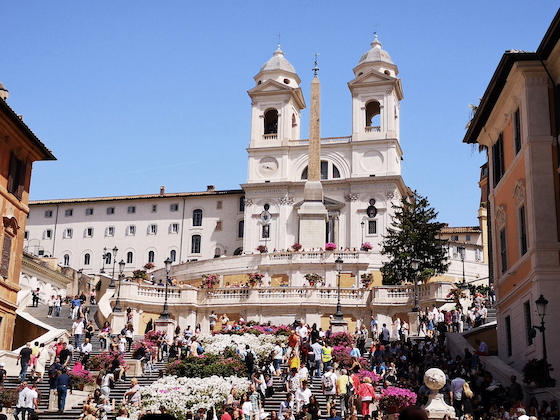
However, what to do with 5 days in Rome is my favorite request as I feel this time allows you to slow down a little, see Rome’s main sites , some hidden gems and take time to actually enjoy the city rather than rushing from one place to the next.
I believe it is easy to fill five days in Rome and make each of them count. I hope this Rome itinerary will persuade Rome is worth the time, even if it may look a long time for just one destination.
Please note: this post contains affiliate links and, should you make a purchase through them, we might make a small commission.
Table of Contents
Where to stay with 5 days in Rome
The best area to stay in Rome for sightseeing is the city center.
The area around the Pantheon and Piazza Navona is stunning, atmospheric and convenient and also has a wide range of hotels.
However, since you are staying a little longer, you may also want to look farther afield.
Staying away from Rome center is cheaper and, with 5 days in Rome, the time spent on public transport won’t interfere too much with your plans.
The areas I recommend looking into are:
- City Center- Navona: find my favorite hotels near Piazza Navona here
- City center- Pantheon: find my favorite hotels near the Pantheon here
- City center- Colosseum: find my recommended hotels near the Colosseum here
- Termini Station: find my recommended hotels in the Termini area here
- Trastevere, vibrant and perfect especially for nightlife (restaurants and bars, not disco and clubs)
- Vatican and Gianicolo, good for families and with good rental options
- Trieste area, lovely green area perfect for families especially
Transport options for 5 day in Rome
How much you will use public transport in Rome will depend on the location of your hotel and exact itinerary followed.
The two best options to consider are:
- BIT, single ticket (1.50 Euro, valid 100 minutes)
- CIS weekly tickets (24 Euro), possibly not worth for a 5 day stay but a good option if planning on using buses, trams and metro extensively.
If you prefer to travel by taxi, you can download the app ‘free now’. Please do check the estimated cost of the ride before committing as taxis can be very expensive in Rome, especially at night.

Rome 5 day itinerary: Day 1
This day will show you some of Rome most famous attractions: the Colosseum and the Roman Forum, Piazza Venezia and Campidoglio hill and Romes’ charming Jewish quarter
Morning: visit the Colosseum, the Roman Forum and the Palatine hill
I love to start my Rome itineraries with a visit to ancient Rome and in particular the Colosseum and the Roman forum.
Sitting beside each other, they are an incredible sight and a must see in Rome and not just if you love history.
The best way to visit the Colosseum is buying tickets in advance.
I like booking them from the Colosseum itself : their tours are of excellent quality, come with reserved entrance so you don’t have to queue for ages and they are a fraction of the price of those offered by external providers.
The tickets include a visit to the Roman Forum that you can take on the same day or the following one.
I recommend you visit both in the same morning as they complement each other beautifully.
In all seasons except the depth of winter, I recommend you also take the time to climb atop the Palatine hill (il Palatino). The hill itself, its stunning ruins and the view from it is unique and breathtaking.
Lunch near Piazza Venezia
After a dive into ancient Rome, have a lunch break near Piazza Venezia.
You have several options here and some of my favorite are Birreria Peroni (informal) and Trinity College: yes, this is an Irish pub but it has lovely salads and it is lovely for lunch albeit surely not very ‘Roman’!
Early afternoon: Piazza Venezia and Campidoglio
After lunch, make sure you take the time to visit Piazza Venezia and in particular two areas: the Vittoriano monument and the Campidoglio hill.
The Vittoriano has wonderful terraces from which you get stunning views over Rome (the first two are free, the third and highest has a 10 Euro admission).
The Campidoglio has a breathtaking piazza designed by Michelangelo and a wonderful view, from the back, over the forum
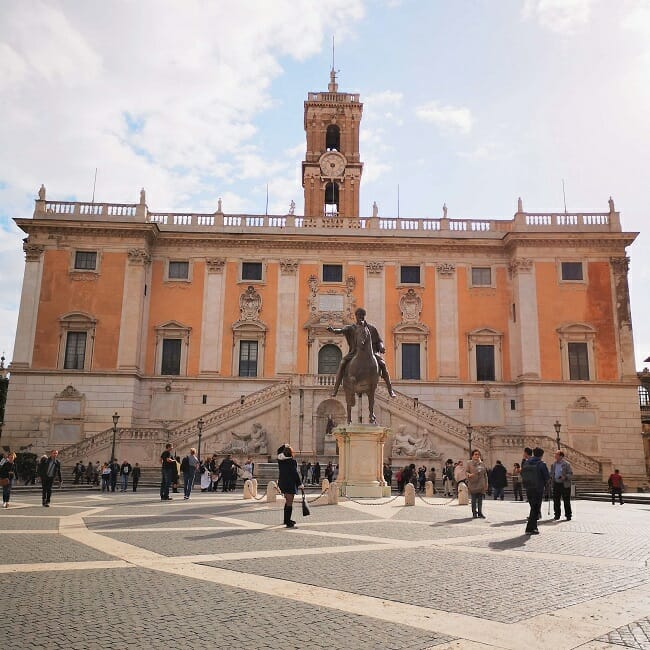
Afternoon: walk around Rome’s Jewish Ghetto
After ‘grand’ Rome, the Rome of the Colosseum and the empire, I suggest you tap into a very different side of the city, Rome’s ghetto.
Only a short walk downhill from the Campidoglio, this is an area of small streets, charming corners, important history and some of the best food in the whole of Rome.
Stay for dinner for the best experience.
Rome day 2: Pantheon, Piazza Navona, Trastevere
On your second day, you will explore Romes’ famous cobbled streets and piazzas.
Start your morning in the area of the Pantheon.
This is a gorgeous atmospheric area and the best way to visit is to allow yourself to get lost and take in the view.
Places to seek out here are Piazza del Pantheon itself, Piazza di Pietra (no one talks about it but it has stunning ruins and local feel), Piazza della Minerva and Piazza Sant’Eustachio, famous among other things for having one of the best cafes in Rome .
You can find all you need to know about visiting the Pantheon in my guide here .
Lunch near Piazza Navona
For lunch, head towards Piazza Pasquino and Via del Governo Vecchio.
Here you have lovely places for lunch (I love the one called Cul de sac – informal, delicious Roman food) and many cute shops too.
In this area you also love the wonderful ‘La Ciambella’, which is stylish wine bar with some of the best food in Rome.
The best way to get here from the Pantheon is to follow the backstreets between the two: make sure you enter the church of San Luigi dei Francesi on the way to see its incredible Caravaggio.
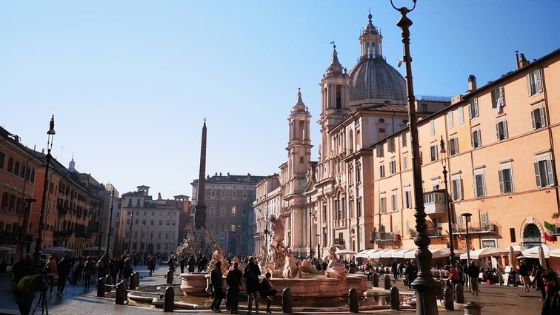
Early afternoon
After lunch, take in the glorious view of Piazza Navona . This is one of the most famous piazzas in the whole of Italy and has stunning art by Bernini and Borromini as well as some of Rome’s most beautiful fountains .
You can simply walk around it and enjoy the view or you can decide to use this opportunity to visit Palazzo Braschi, the museum of Rome that has, among other things, a stunning view over the piazza from its third floor windows!
Late afternoon / dinner
After Piazza Navona and surrounding are, cross Viale Vittorio Veneto and head to Campo de’ fiori, an interesting medieval square with the statue of Giordano Bruno and, nowadays, many cafes and aperitivo places.
You can take a rest here and relax people watching but then I recommend you go across the river to Trastevere to tap into Rome’s nightlife and some of the city’s best food
Rome day 3: Vatican city, shopping, the Spanish Steps and Fontana di Trevi
On day 3 I recommend you cross the river and spend the day around Vatican city .
Depending on what you want to see, this can be a reasonably short activity or one that takes up the best part of the morning.
The square and basilica are free and won’t take too long while the Vatican museum and Sistine chapel will occupy at least 3 hours if not more (for the visit, if you need to queue, much more).
The best way to visit the Vatican museums is booking tickets well in advance from the museum official website . They have timed entrance so you will skip the majority of the line.
The museums are stunning but very crowded. Should this be too much to take, I highly recommend you visit nearby castle Sant’Angelo instead which is wonderful and blissfully crowd- free.
Lunch in Borgo
For lunch I recommend you eat in Borgo, the area just around Vatican city. My favorite place here is the small pastificio, a tiny, informal place with lovely pasta dishes and great desserts.
After a morning at the Vatican, I recommend you go to Via del Corso. Here you can shop till you drop ( both high street and designer ) but also have good opportunities for sightseeing: Piazza del Popolo, Piazza di Spagna with the Spanish steps and the Trevi fountains are all here.
I recommend you finish your day with aperitivo at the top of the Rinascente (department store) before you go for dinner near Fontana di Trevi.
Day 4 in Rome: Borghese Gallery and Rome hidden neighborhoods
On the morning of day 4, I recommend you head to Villa Borghese , a large and beautiful garden famous for its beauty and home of the even more famous Borghese Gallery, hosted in its grounds.
The gallery is stunning and operates with a booking system that means you buy tickets in advance with times entrance.
With or without a gallery visit, Villa Borghese is worth a stop and can be a lovely place for coffee or lunch. Head to the small cafe near the pond for the most relaxing atmosphere.
From here, you can also head to the nearby GNAM, the National Gallery for Modern Art which has interesting exhibitions (and a nice restaurant)
In the afternoon, I recommend you head to a small hidden area of Rome not far from Villa Borghese, quartiere Coppede
This is a lovely, local area with incredible architecture.
A stroll here won’t take more than 30 minutes but will leave you with an unforgettable impression and the knowledge of a part of Rome many tourists still ignore.
This is also a lovely area for coffee (head to Piazza Caprera and enjoy the little terrace: unlike in the city center, you won’t break the bank here!)
Dinner in Monti
For dinner, I recommend you head to Rione Monti , back in the city center. This is a lovely, charming area with many restaurants, cafes and wine bars and it also has some incredible churches such as Santa Prassede , worth seeing for its stunning mosaics , among the best in Rome.
Rome day 5: Ostia Antica, Aventine hill, Testaccio
On day 5 I recommend you get away from Rome city center and head to Ostia antica , a wonderful archaeological site on the outskirts of the city.
Getting there takes about 30 minutes on the city train and once arrived you are a world away from the city’s bustling life. This is a wonderful morning out on a sunny day. If the weather is against you, I recommend a trip to Centrale Montemartini instead (museum)
Have lunch in the borgo of Ostia antica or in the Ostiense, near the museum (many options)
After lunch, I recommend you head to Piazzale Ostiense (handy both from Ostia Antica and the Centrale) and seek out the so-called protestant cemetery of Rome .
This is a fantastic charming corner of the city, it has the graves of many important artists and writers (Shelley the most famous) and it also has spectacular views over Rome’s oddest monument, Rome’s pyramid .
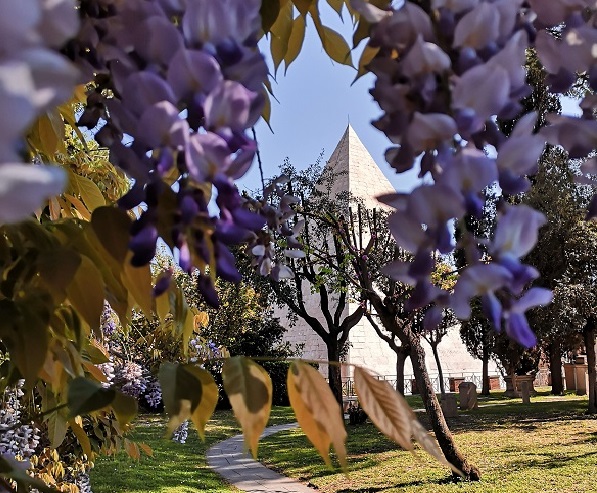
From here, climb up the Aventine hill .
This is one of the 7 hills Rome was originally built upon and is one of the most beautiful areas of Rome.
Make sure you enter into at least some of its many churches (Santa Sabina is stunning) and make sure you make a stop at Pizza dei Cavalieri di Malta.
Here, a large door hides a secret – if you peek thought its keyhole, you catch the most unbelievable view of St Peter (the peeking is legal and encouraged)
The most scenic part of the Aventine hill however is the so called Garden of Oranges, a green area with a beautiful terrace overlooking Rome.
The view is beautiful and romantic: this is one of the best belvedere in Rome as well as one of the most romantic places in Rome.
After this goodbye to Rome from above, head back down to Testaccio for the last meal in one of the most local and famous neighborhoods for Rome food.
Other things to do in Rome in 5 days
- Go on a food tour
- Cycle along ancient Via Appia and its stunning aqueducts and catacombs
- Get aperitivo on one of Rome’s rooftop terraces (spring and summer only)
- Visit the stunning baths of Caracalla
- Take a cooking class
- Go Church hopping: St Peter basilica, San Clemente, Santa Maria della Vittoria, Santa Maria in Trastevere but also many others: if you love visiting churches, Rome will be your playground for months!
What to pack for 5 days in Rome
As well as your essentials I recommend you pack:
- Excellent, broken-in walking shoes (find my recommended shoes for Rome here)
- Phone, camera and relevant chargers + spare battery pack
- Italian phrasebook and/or pocket dictionary
- Some cash + ATM card (suitable for international travels)
- Reusable water bottle
- Non-bulky crossbody bag
- Suitable attire for a visit to the Vatican
- You can find my full recommended packing list for Rome here .
I hope you enjoyed this 5 day Rome itinerary, it gave you a good overview of the abundance of things to see in Rome in 5 days good reasons to add it to your trip to Italy. Safe travels!
My name is Marta, I am a travel-loving mama born and bred in that messy, wonderful, infuriating, awe-inspiring unbelievably beautiful city that is Rome. A classics graduate and professional travel blogger, on this site I share my insider tips to help you plan your dream trip to Rome, Italy.
The best time to visit Rome: month by month guide
Visiting castel sant’angelo, rome: all you need to know about hadrian’s mausoleum, you may also like, fun and interesting facts about the colosseum for..., christmas markets in rome you will love this..., how to see the best of rome in..., free things to do in rome you’ll love..., how to buy tickets for the pantheon +..., how to visit the spanish steps in rome:..., largo di torre argentina: all you need to..., 40+ rome hidden gems you’ll love, outdoor swimming pools in rome you’ll love this..., 22 fantastic things to do in rome when..., privacy overview.

VIDEO
COMMENTS
Stroll to the Spanish Steps. 21-minute walk from Galleria Borghese. After a stop off at the Galleria Borghese and possibly the Capuchin Crypt, most of the second day of this 4 day Rome itinerary focuses on iconic Roman sights and popular tourist highlights, starting with the famed Spanish Steps. READ NEXT.
Our first suggestion would be this Rome tour from Take Walks. This full day tour includes everywhere in our itinerary, including the Colosseum, a view of the Roman Forum, a tour of the historic center of Rome and the Vatican City attractions, including the Vatican Museum, Sistine Chapel, and St. Peter's Basilica.
Day 4. Side-trip to Ostia Antica (closed Mon). On the way there or back, stop for sightseeing in Testaccio (great market scene in the morning and for lunch; excellent restaurants for dinner). In the evening, you could repeat my guidebooks' "Heart of Rome" walk from Campo de' Fiori to the Spanish Steps to enjoy the after-dark scene.
So what are you waiting for, let's dive in and start planning the perfect Rome 1-day itinerary! Contents [ hide] 1 One thing you MUST do before your day in Rome. 2 Rome 1-day itinerary map. 3 Rome 1-day itinerary. 3.1 Start at the Colosseum & Roman Forum. 3.2 Pantheon.
Spanish Steps in Rome. Good to know: Our recommended 1-day Rome itinerary includes a visit to the Vatican and the Colosseum. The Vatican Museums are closed on Sundays and on some religious holidays. If that's the case on the day of your visit, normally, you can still visit St. Peter's Basilica.
1. Piazza Navona. Suggested visit time: 8:30 am / Visit duration: 30 mins - 1 hour. Start your 3-day Rome itinerary with a stroll in Piazza Navona, one of the most magical squares in the historic center. The majestic sculptures, artsy fountains, and vibrant atmosphere of this square are a great introduction to Rome.
48-hour ticket (€12.50/$15) - Two days of unlimited travel on any public transportation from the moment of validation. 72-hour ticket (€18/$21.50) - Three days of unlimited travel on any public transportation in Rome from the moment of validation.
Day 3: Rome Itinerary Appian Way and The Catacombs. ... We are planning for a 2.5 day trip to Rome in July. I had few questions. 1. Since we land in Rome at 9am, we plan to start our sight seeing at 1PM after we check-in and take some rest. Given just half day, which of day of your 3 day itinerary do you suggest to do on our first day given we ...
Here's what you'll see with 5 days in Rome. Day 1: Imperial Rome, Monti, Capitoline Hill. Day 2: Centro Historico, Borghese Gallery. Day 3: Vatican City, Trastevere. Day 4: Rome Hidden Gems. Day 5: Day Trip to Tivoli or Orvieto. You may be tempted to rush through Rome in fewer than 5 days. I have myself.
The trip with Leonardo Express lasts 32 minutes and departs Fiumicino Airport every 30 minutes (or every 15 minutes during peak times). Tickets costs €14 per trip and the first train leaves the airport at 6.38 am, the last leaves at 11.38 pm. Once in Termini Station, take a taxi to get to your accommodation or the metro.
Overview: how to see Rome in 5 days. Day 1: Colosseum, Altare Alla Patria & Trevi Fountain. Day 2: Vatican Museums, Chapel Sistine & St Peter's Basilica. Day 3: Roman Forum, Pantheon & Piazza Navona. Day 4: Trastevere, Piazza Santa Maria & Janiculum Hill. Day 5: Piazza di Spagna, Piazza del Popolo & Villa Borghese.
TIP: If you need airport transfers to/from the city center, you can find all the best options here (by train, bus, or pre-booked taxi). ROME 4 DAYS ITINERARY & TIPS: DAY 1: Historic Center, Colosseum, several hidden gems, Trastevere. DAY 2: The Vatican, Food Tour & Jewish Quarter.
4 day itinerary for Rome - Day 3 - Ancient Rome, Piazza Venezia & the Capitoline Hill. Day three of this Rome 4 day trip itinerary will keep you in a relatively compact area, but will plunge you deep into the world of Ancient Rome, including visits to the Colosseum and the Roman Forum.
2 Days in Rome: An Itinerary. Day 1 in Rome. Our first day in Rome has you exploring some of Rome's most famous sights, from stunning 2,000 year old gladiatorial arenas to Renaissance artwork. Colosseum. First on the itinerary for your time in Rome is a visit to the mighty Colosseum. For over two thousand years this has been a landmark ...
Start the third day of the itinerary 4 days in Rome with some pastry and coffee at Bar Pasticceria Gelateria Parenti Silvano. St. Peter's Basilica and St. Peter's Square. 09:00 AM - 11:30 AM Located in Vatican City, St. Peter's Basilica is one of the largest churches in the world. It is also one of the four major basilicas in the ...
Table of Contents. Rome in 4 days: itinerary for first time visitors. Rome Itinerary Day 1 - ancient Rome, Capitoline Hill, Trevi. Rome itinerary day 2 - The Pantheon, Piazza Navona and Trastevere. Rome itinerary day 3 - The Vatican. Rome day 4 - Borghese Gallery, Spanish Steps, Aventine and Testaccio.
Rome Itinerary, Day 1: Evening at Aventine Hill. We'll be winding down the first of your 3 days in Rome taking in the sunset from Aventine Hill. If you remember from earlier, Rome was founded on seven hills, and Aventine is the southernmost of them.
Transport options for 5 day in Rome. Rome 5 day itinerary: Day 1. Rome day 2: Pantheon, Piazza Navona, Trastevere. Rome day 3: Vatican city, shopping, the Spanish Steps and Fontana di Trevi. Day 4 in Rome: Borghese Gallery and Rome hidden neighborhoods. Rome day 5: Ostia Antica, Aventine hill, Testaccio. Other things to do in Rome in 5 days.
Rome, Italy, known as the Eternal City, truly lives up to its name with an endless array of activities, sights, and culinary delights that could keep you busy for an eternity. However, if you only ...
save this for your next trip to rome 🏼🇮🇹 3 day Rome itinerary: Day 1: Morning: Colosseum & Roman Forum Afternoon: Piazza Navona, Pantheon, & Chiesa di Sant'Ignazio di Loyola Evening: Return to the Colosseum to see the sunset Day 2: Early morning: St. Peter's Basilica (opens at 7am) then timed entry to the Vatican Museum.
Searching for information and tickets regarding European Athletics Championships | European Athletics Championships 2024 Day 6 (Rome) | Stadio Olimpico taking place in Rome on Jun 12, 2024 (UTC+1)? Trip.com has you covered. Check the dates, itineraries, and other information about European Athletics Championships | European Athletics Championships 2024 Day 6 (Rome) | Stadio Olimpico now! Trip ...
The European Athletics Championships 2024 Day 4 is set to take place in the historic city of Rome on June 10, 2024, at the iconic Stadio Olimpico. Athletes from across Europe will gather at this prestigious venue, located at Viale dei Gladiatori, 00135 Roma RM, Italy, to showcase their skills and compete for glory.